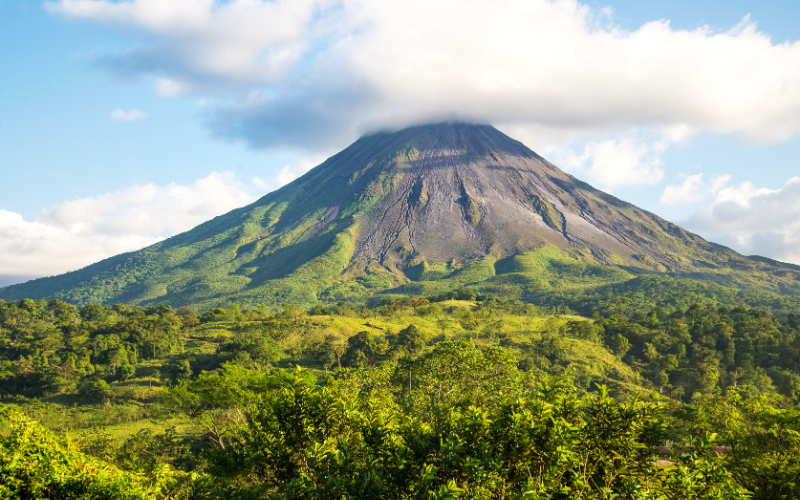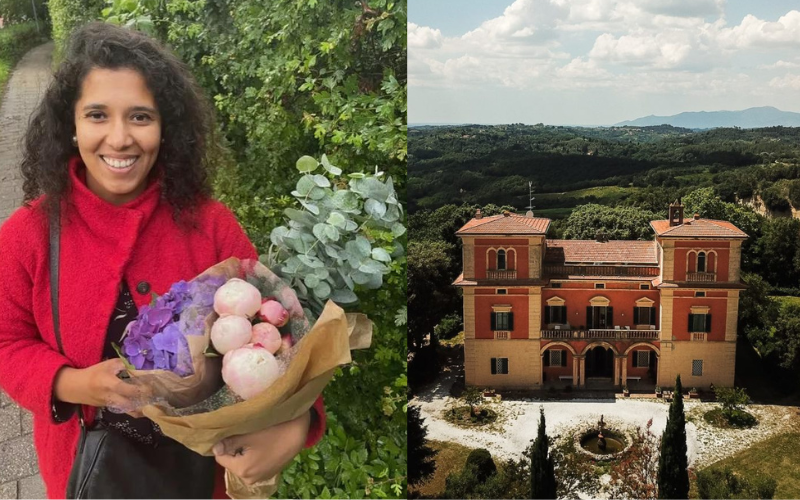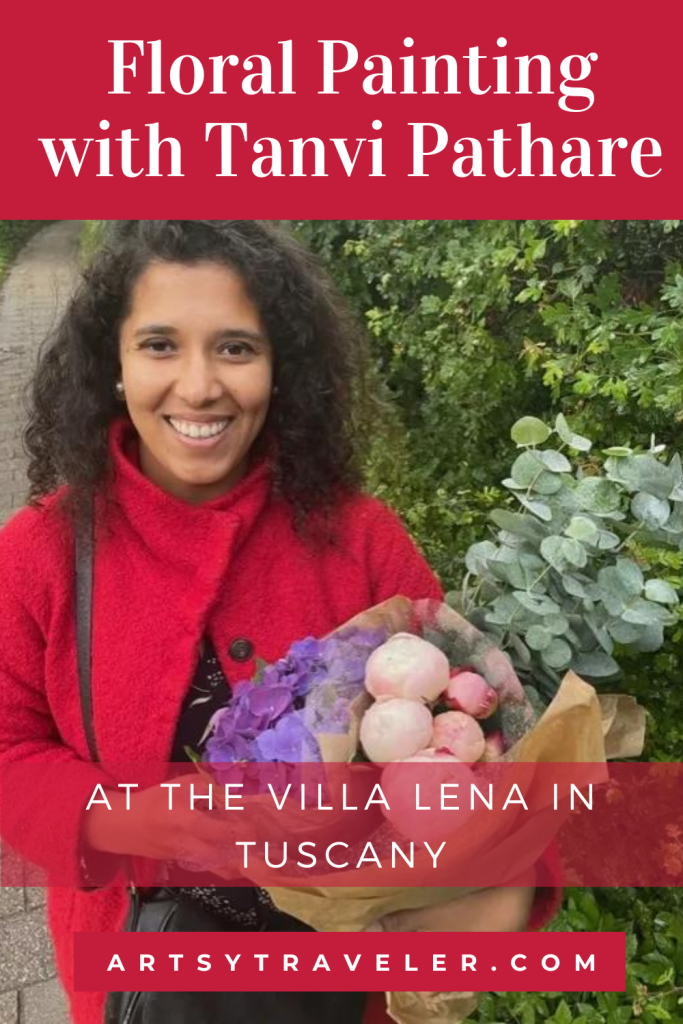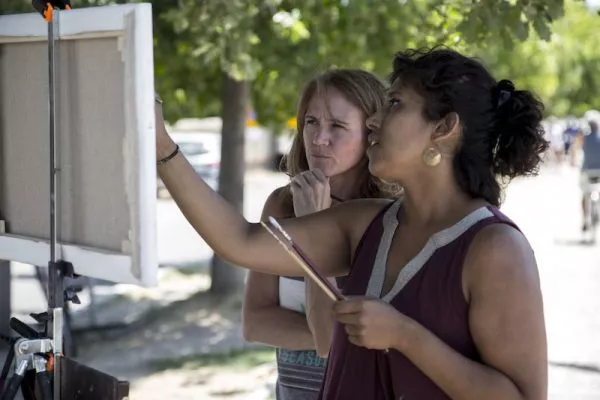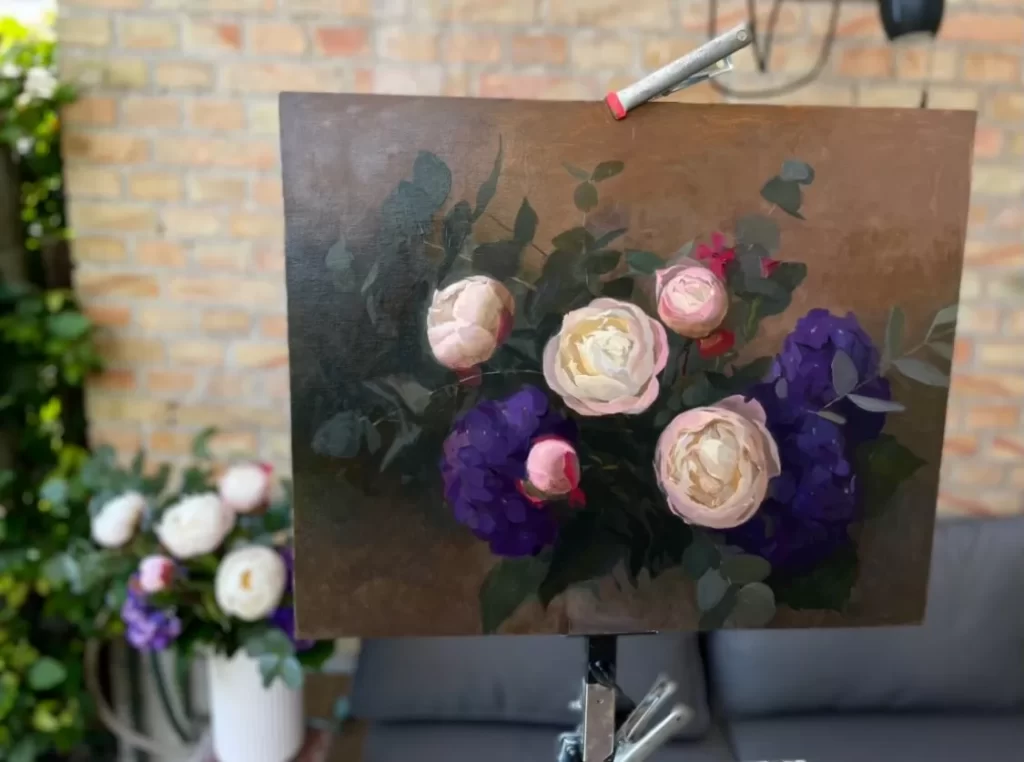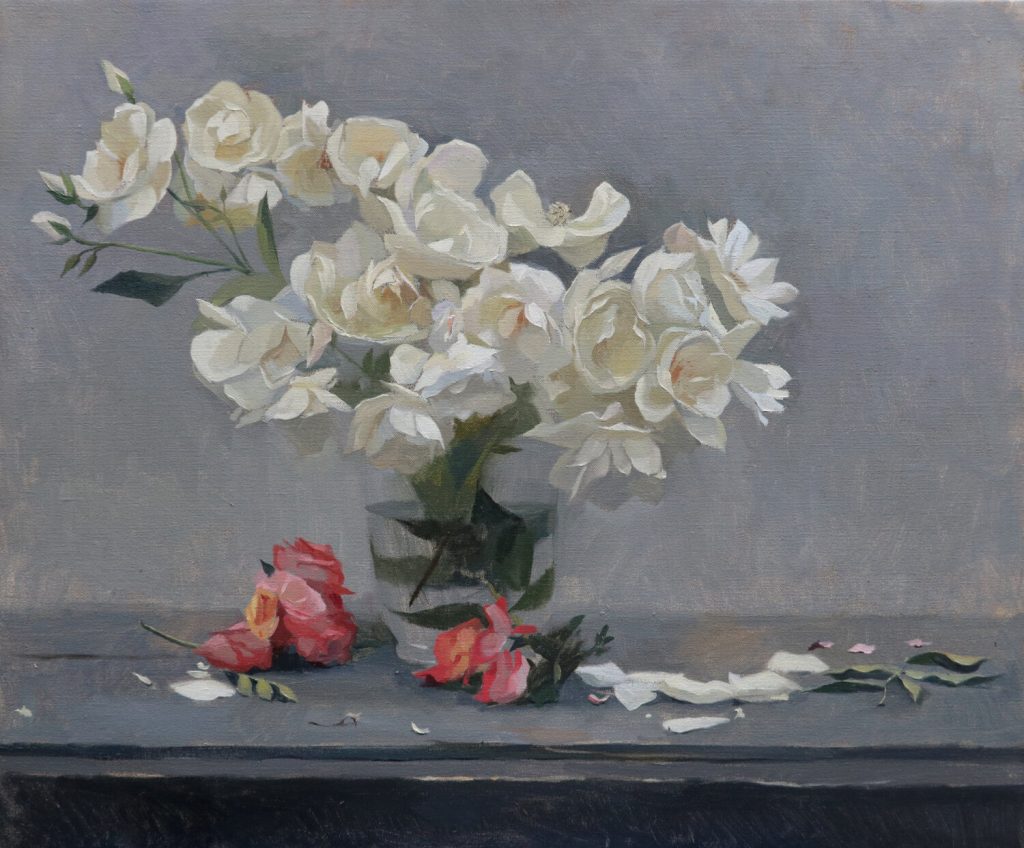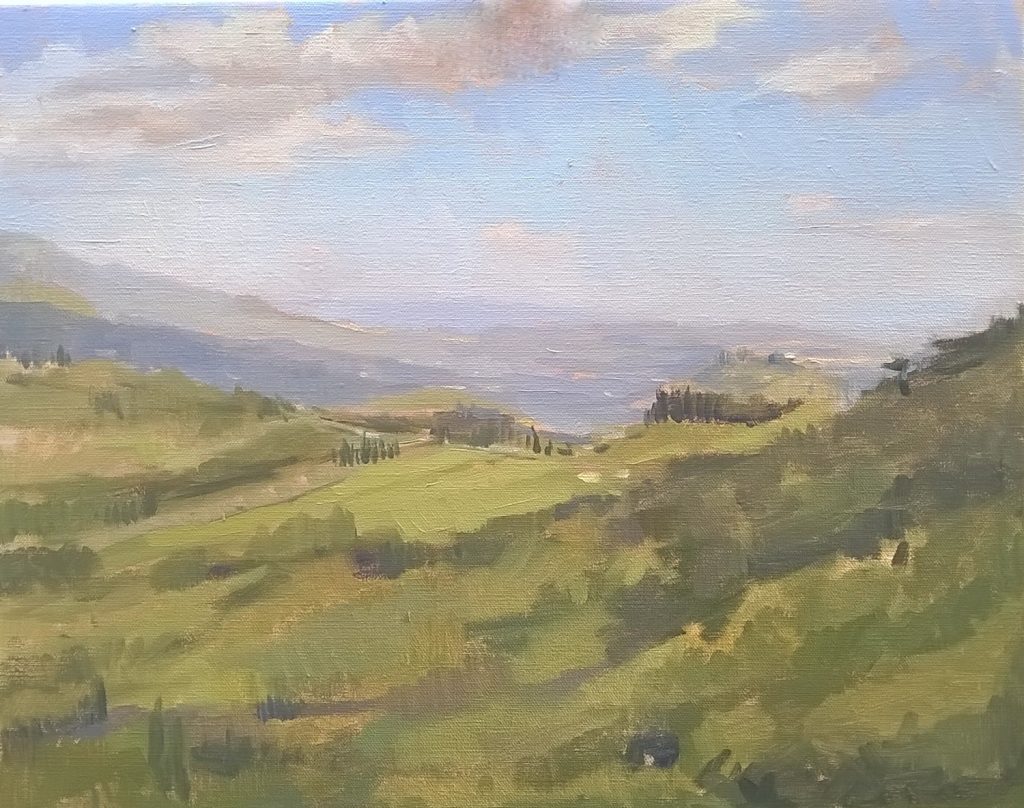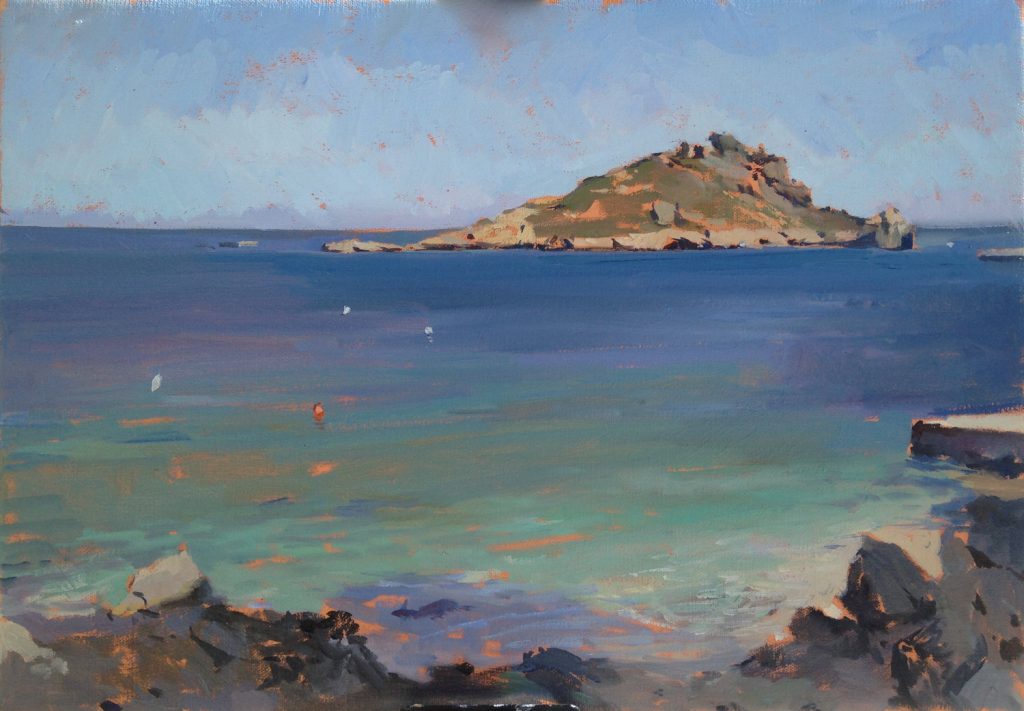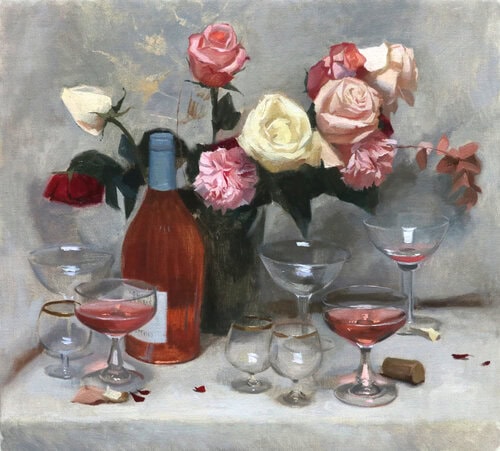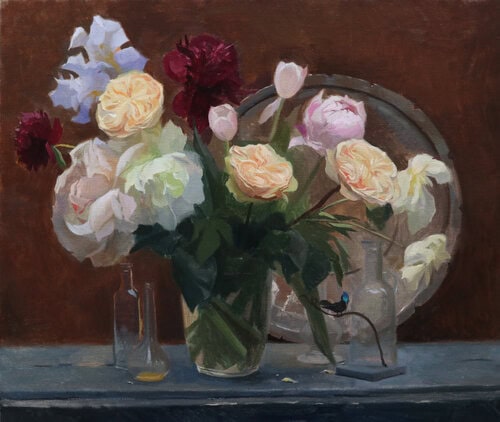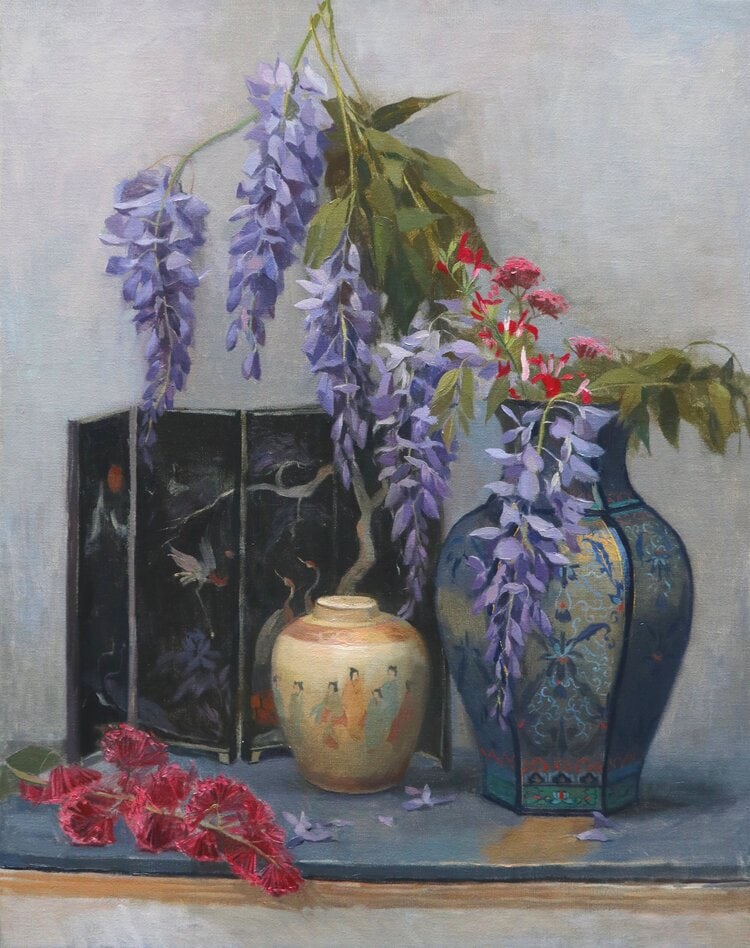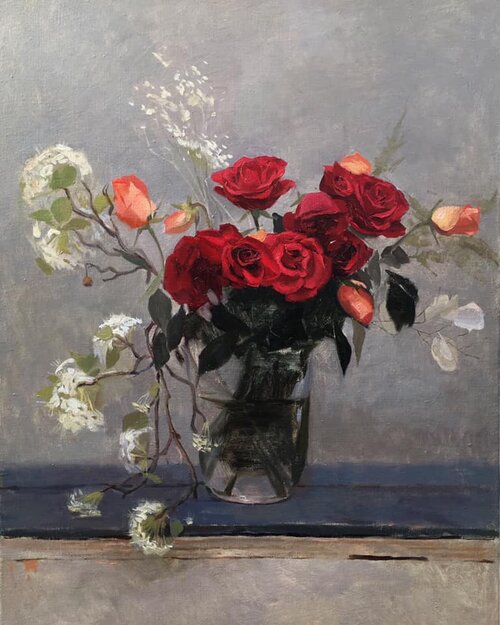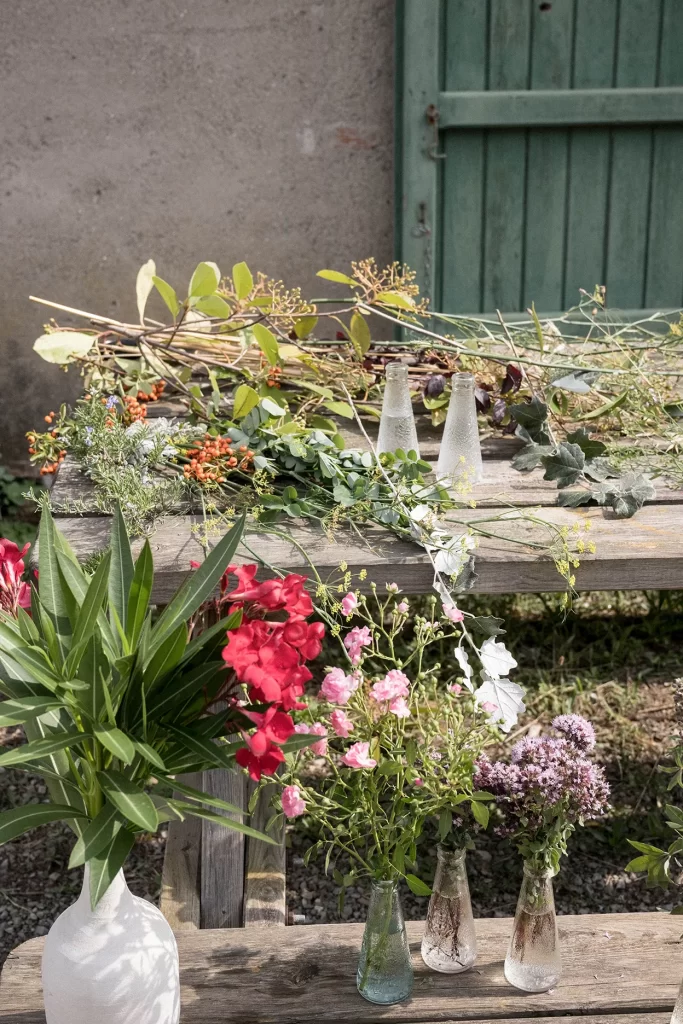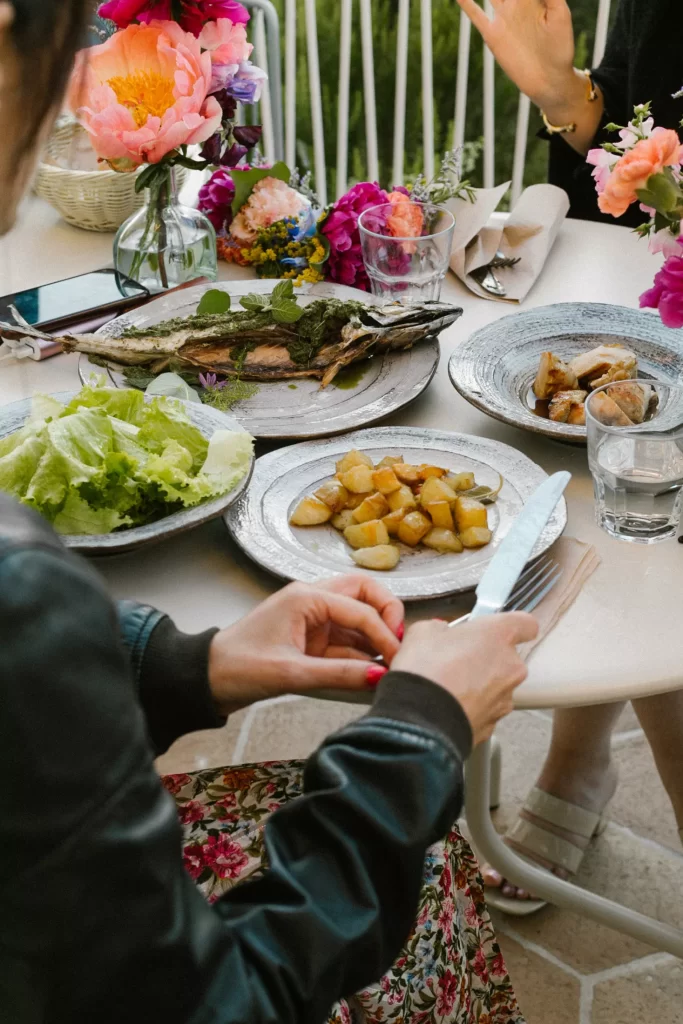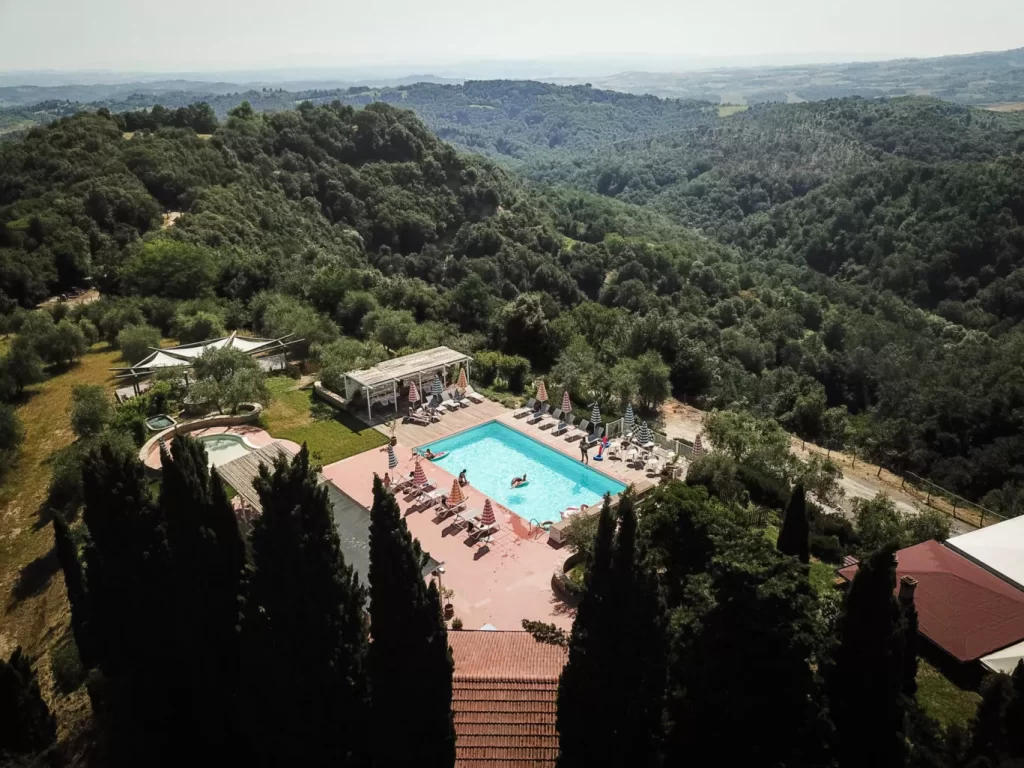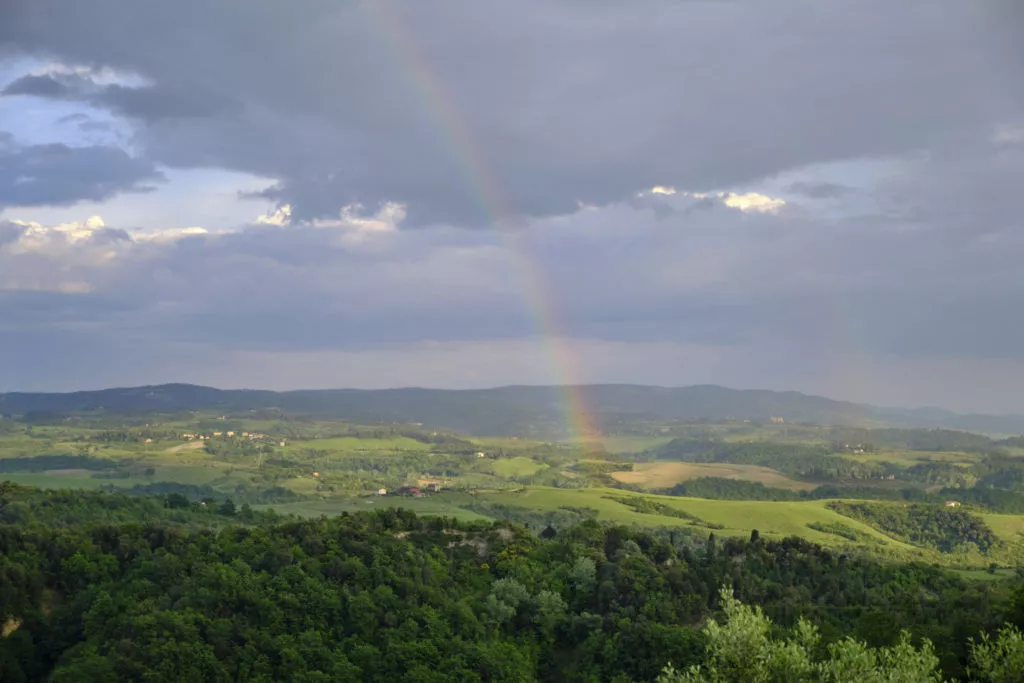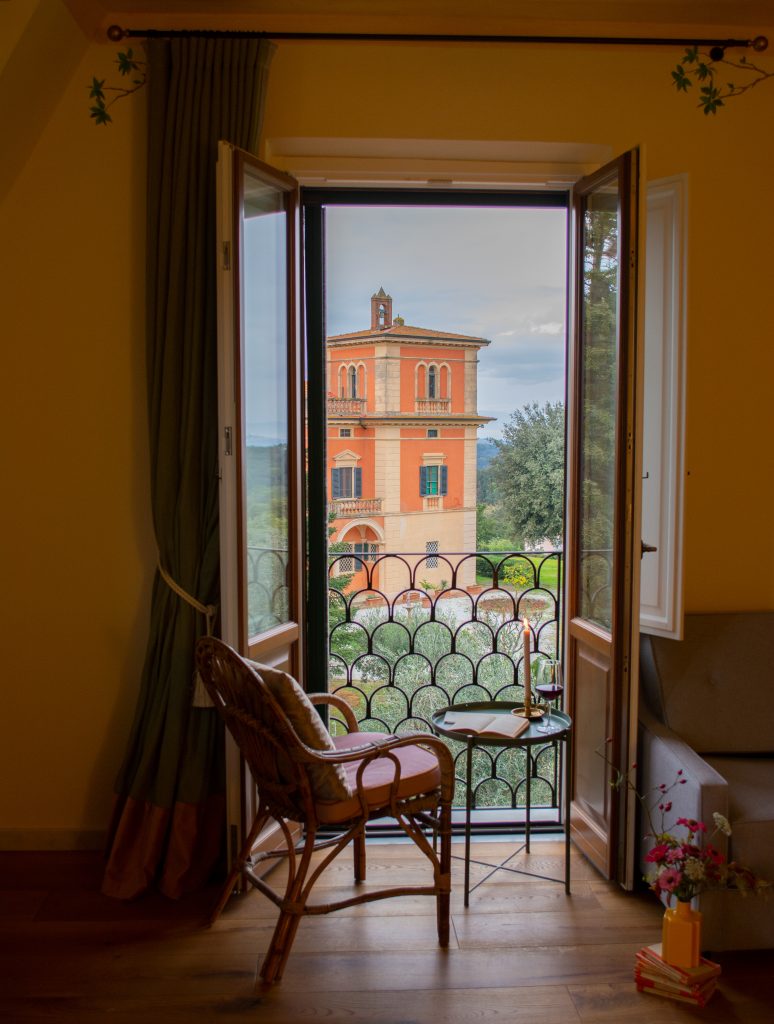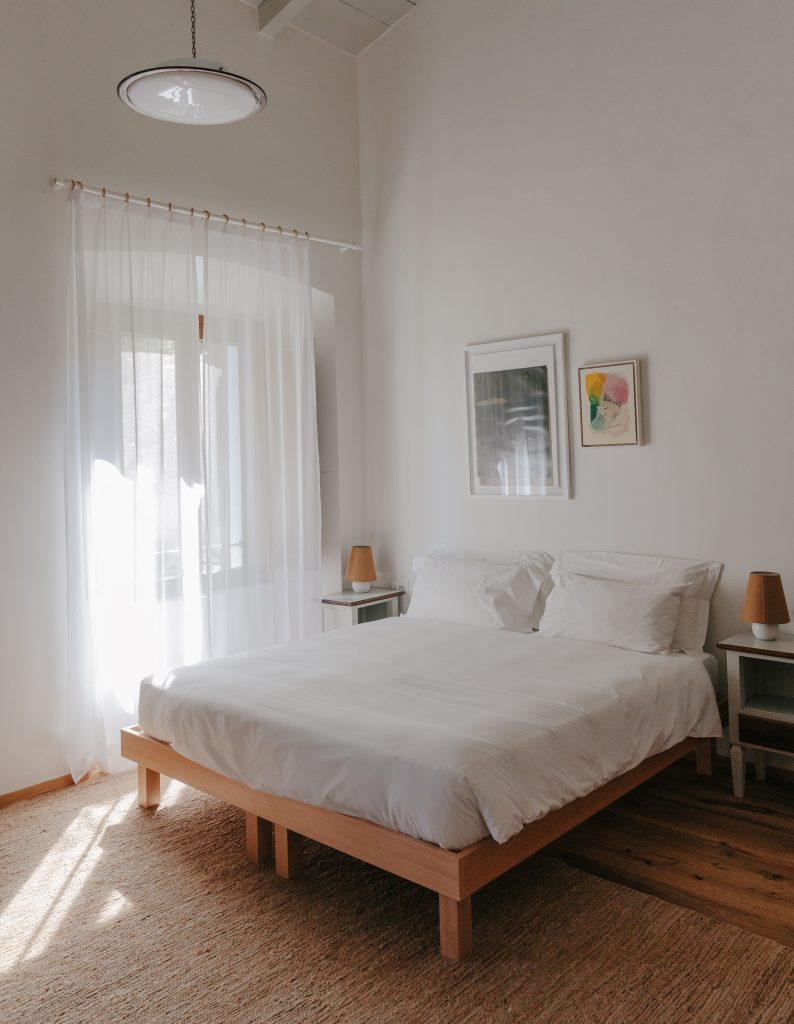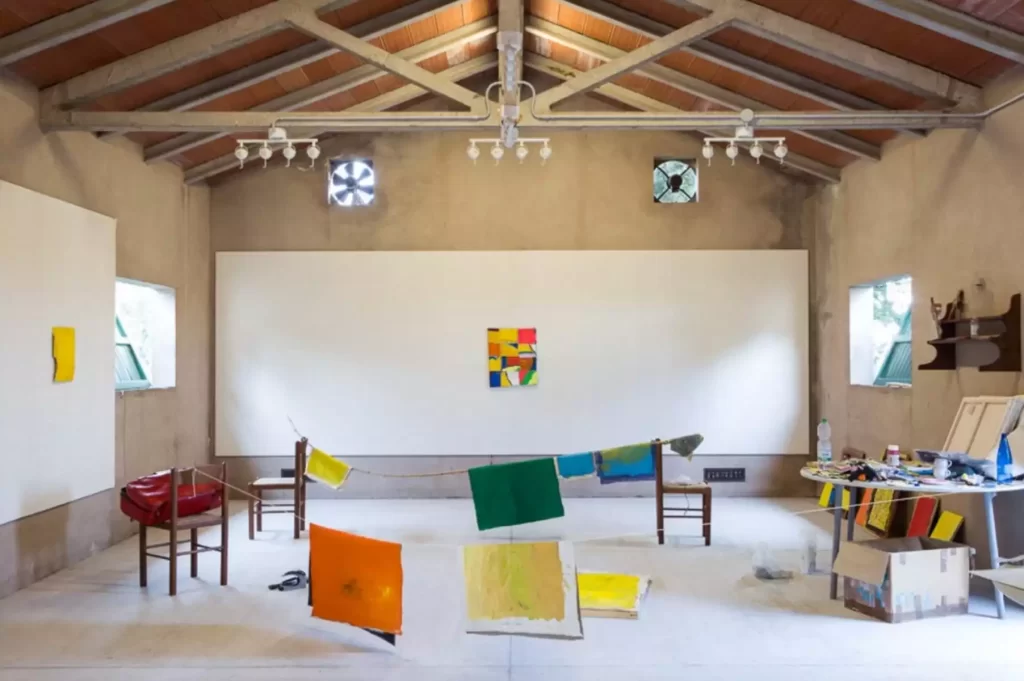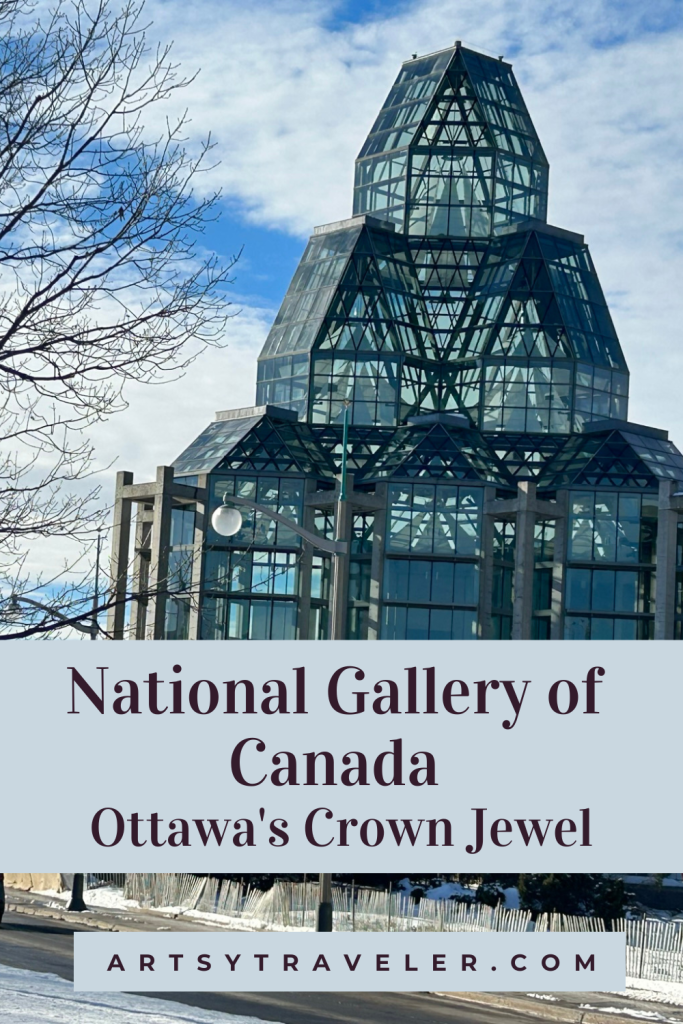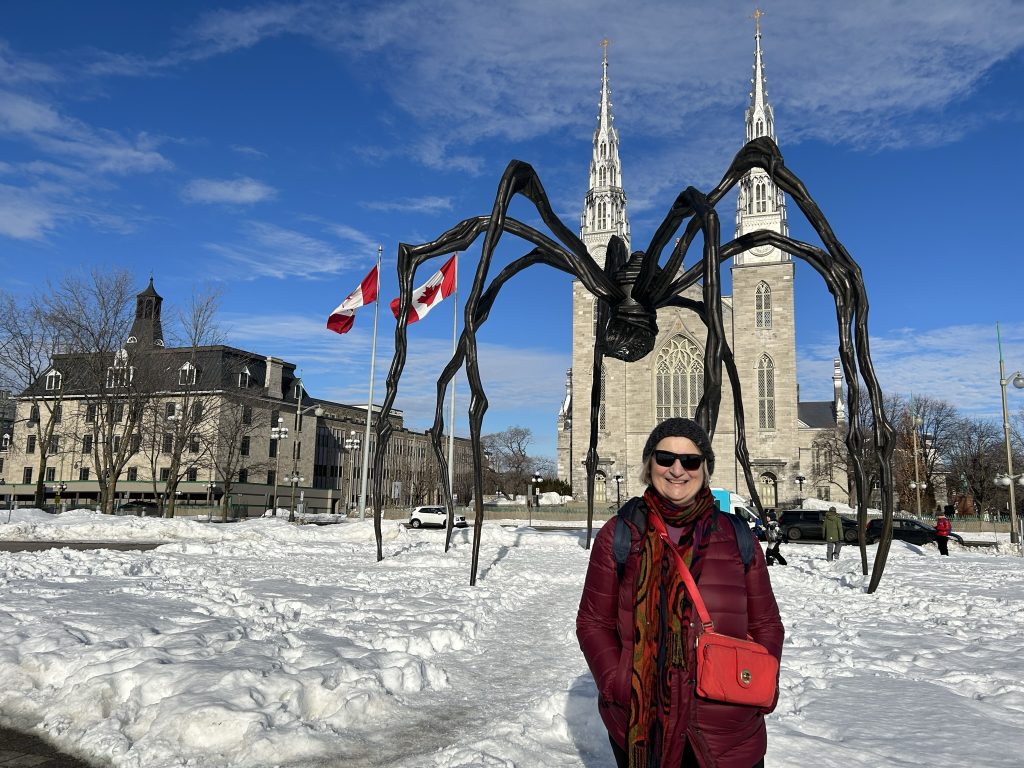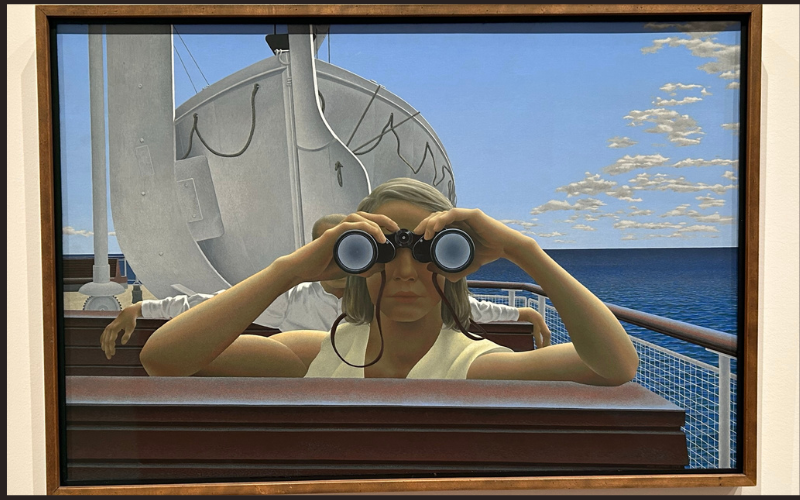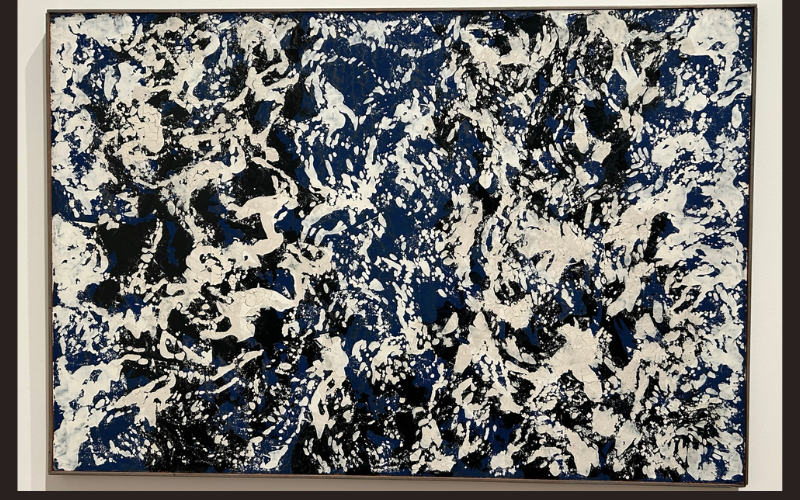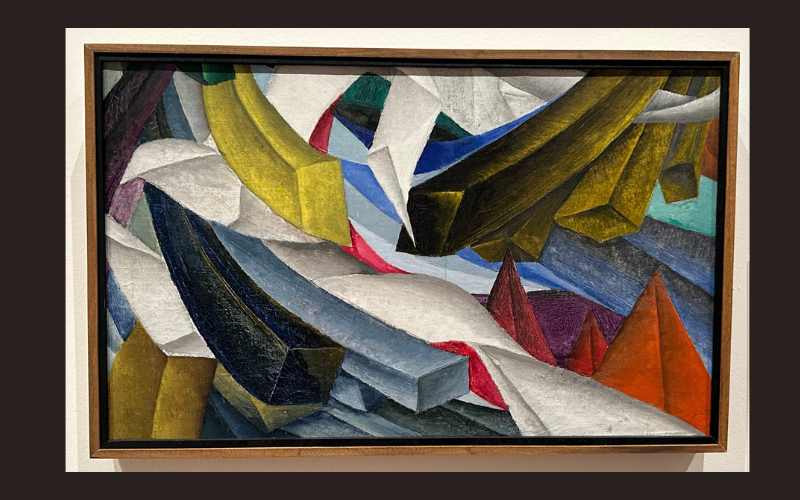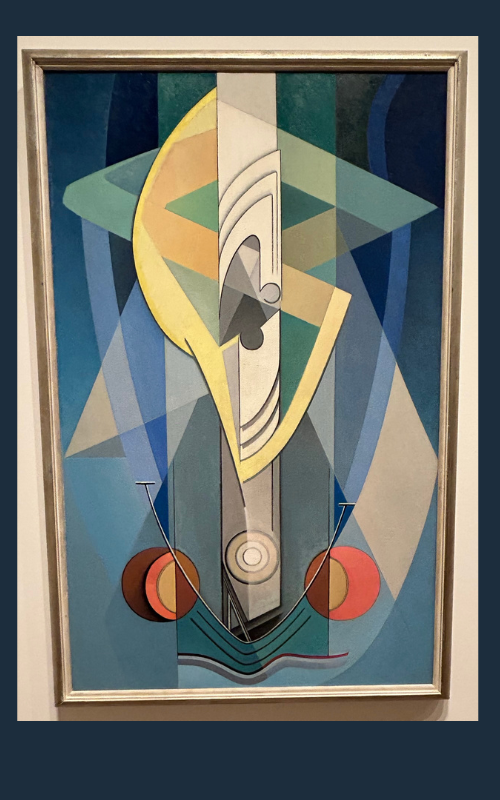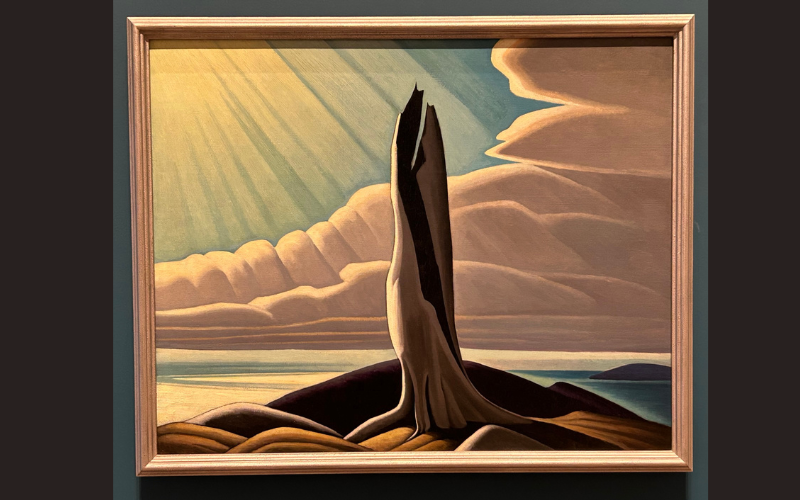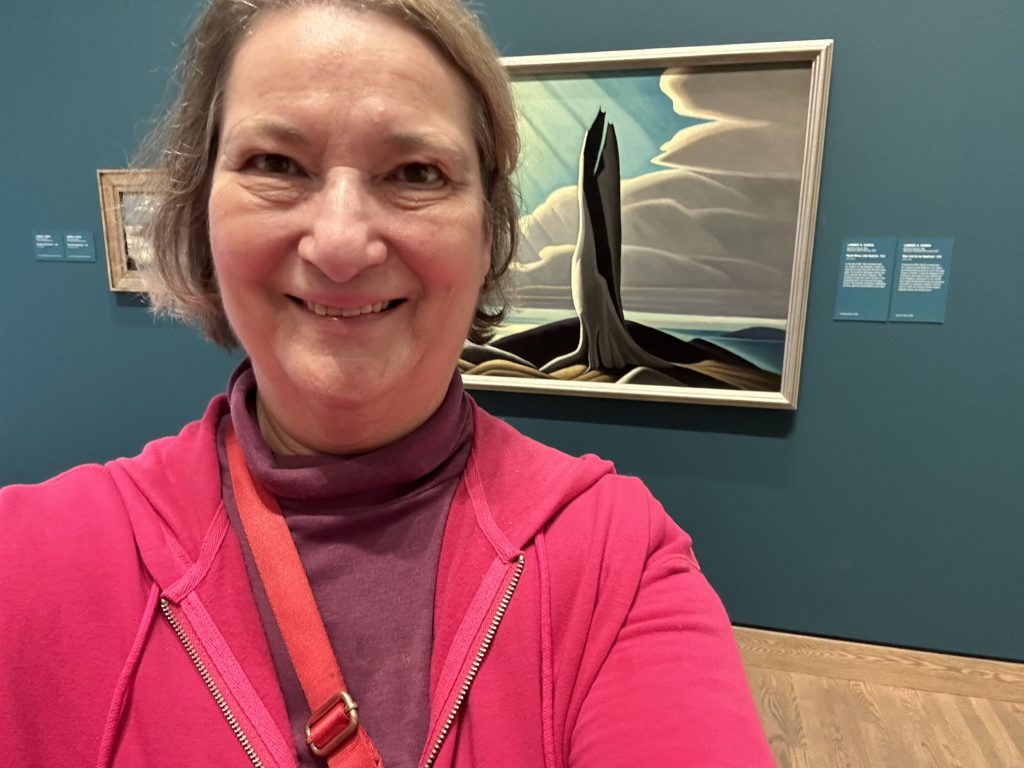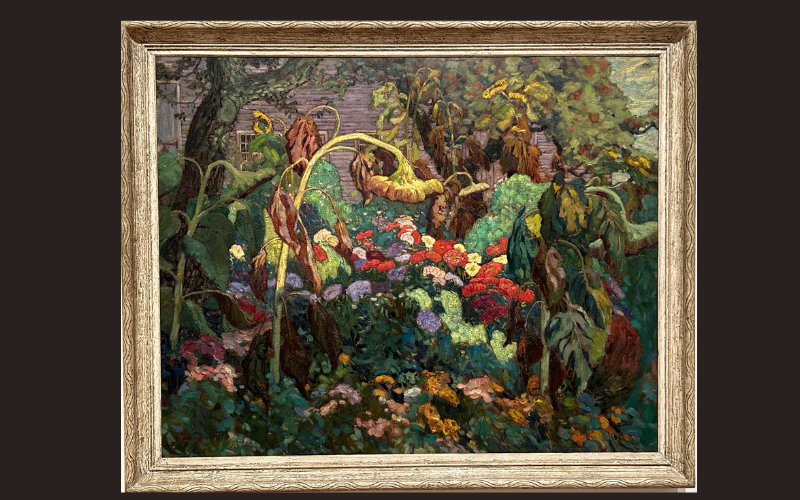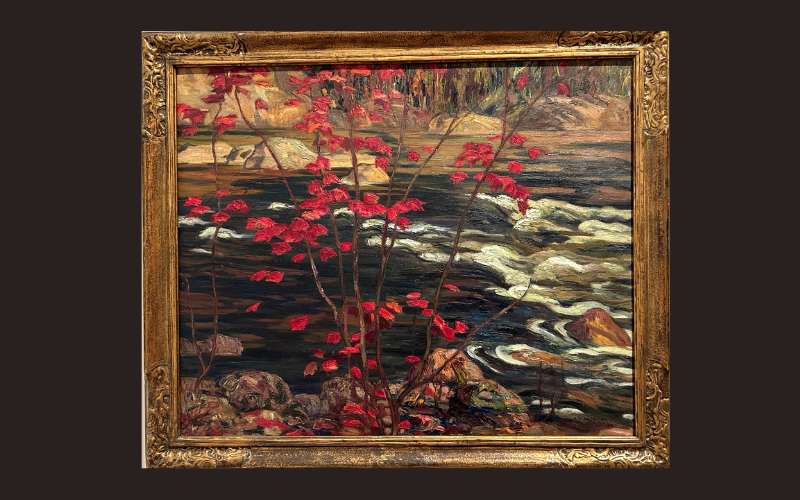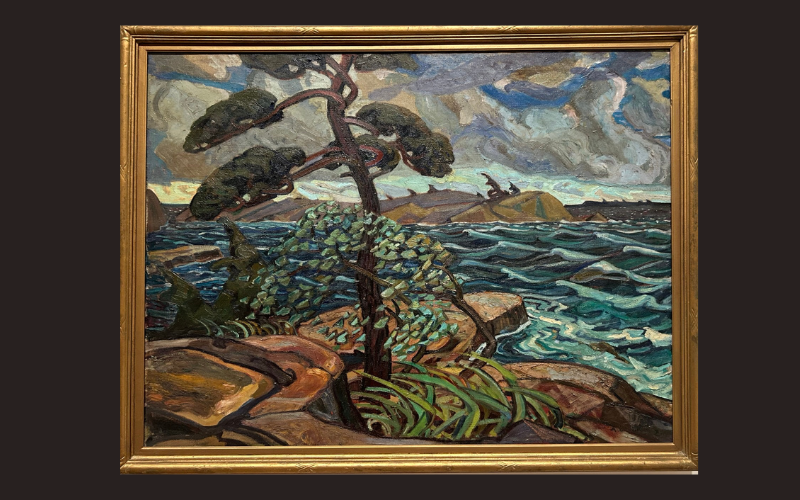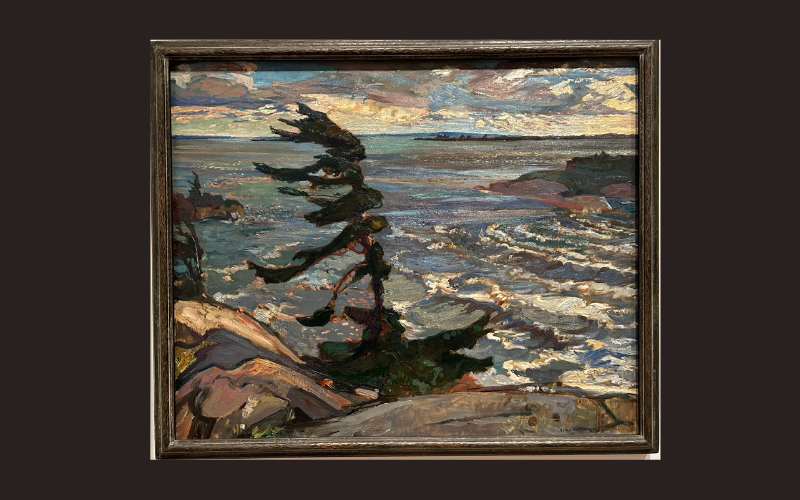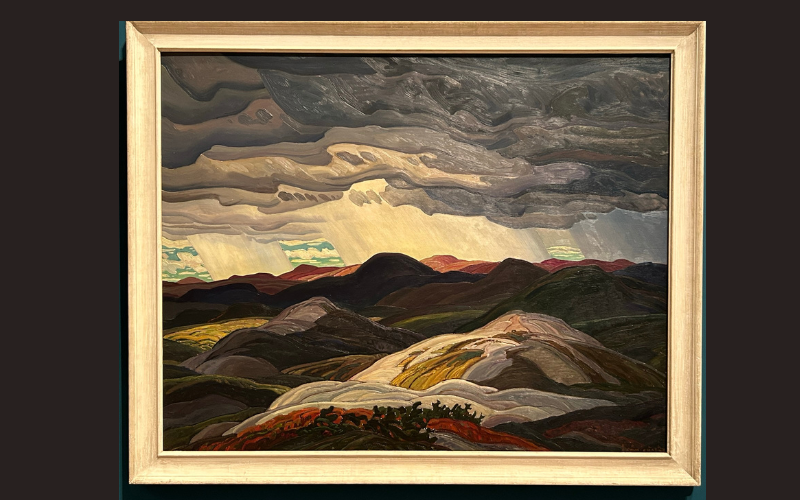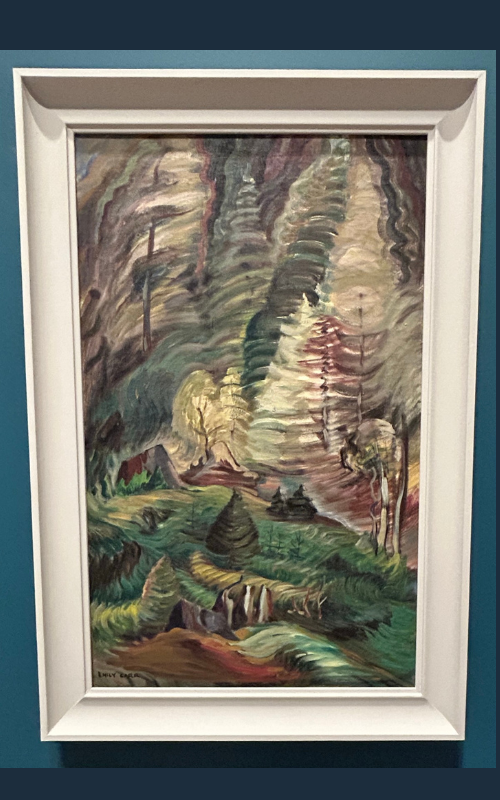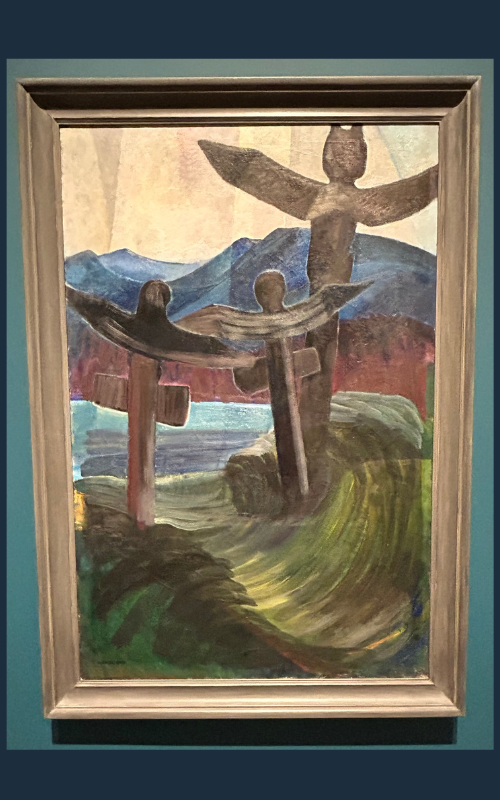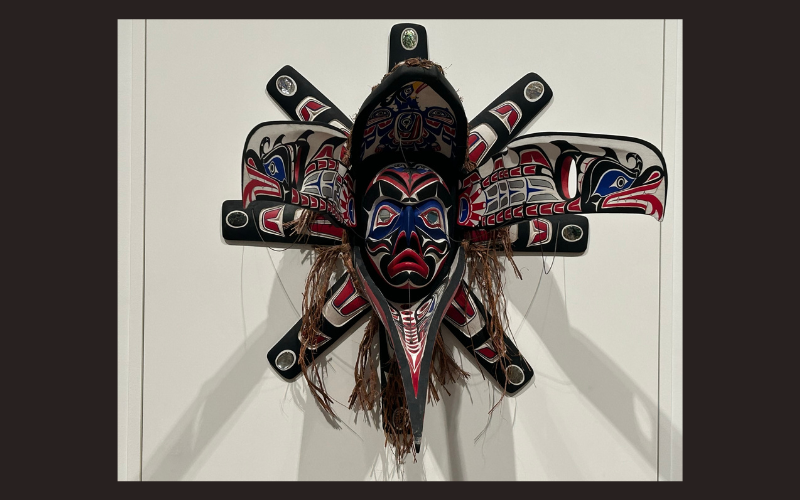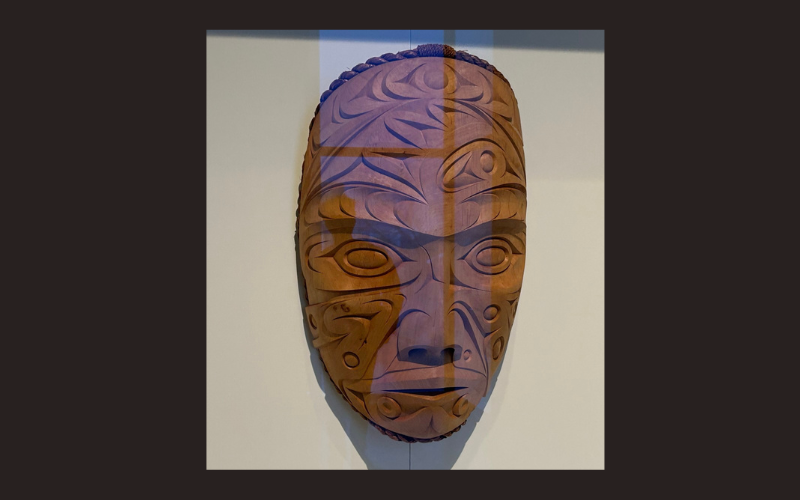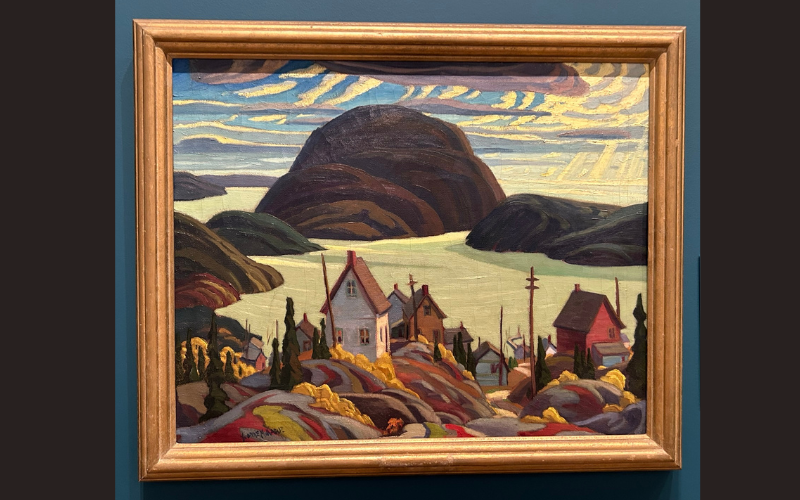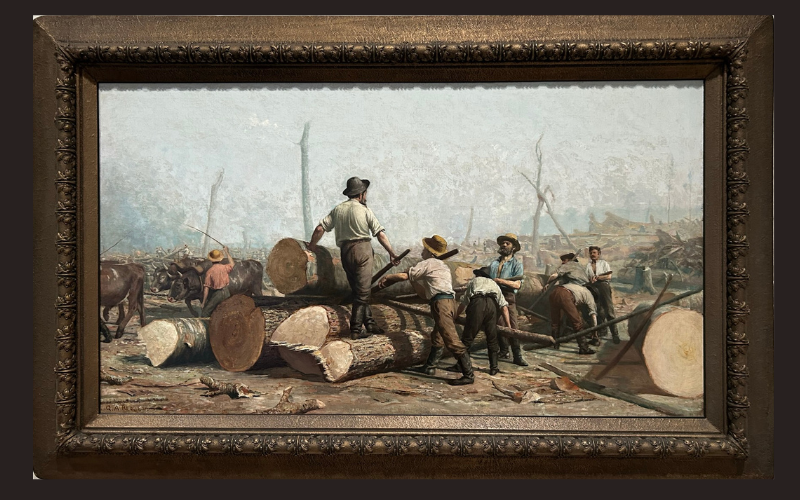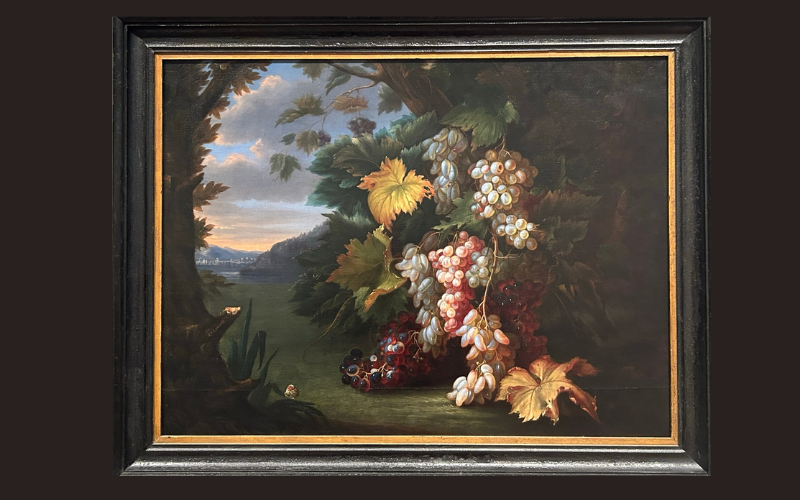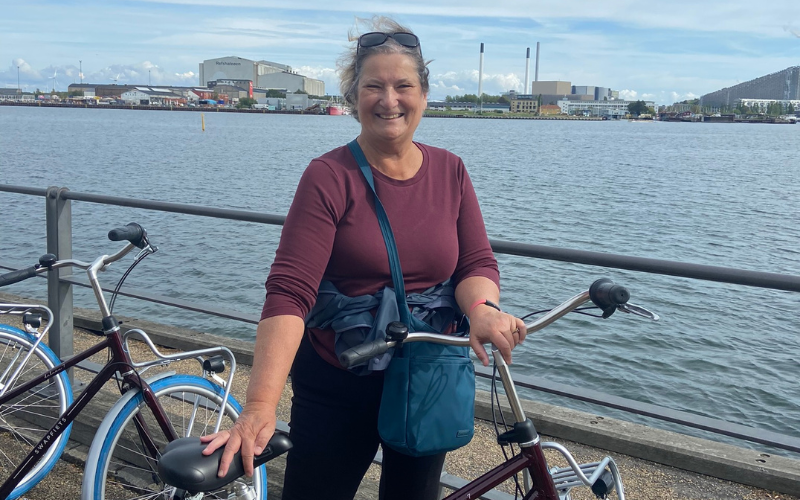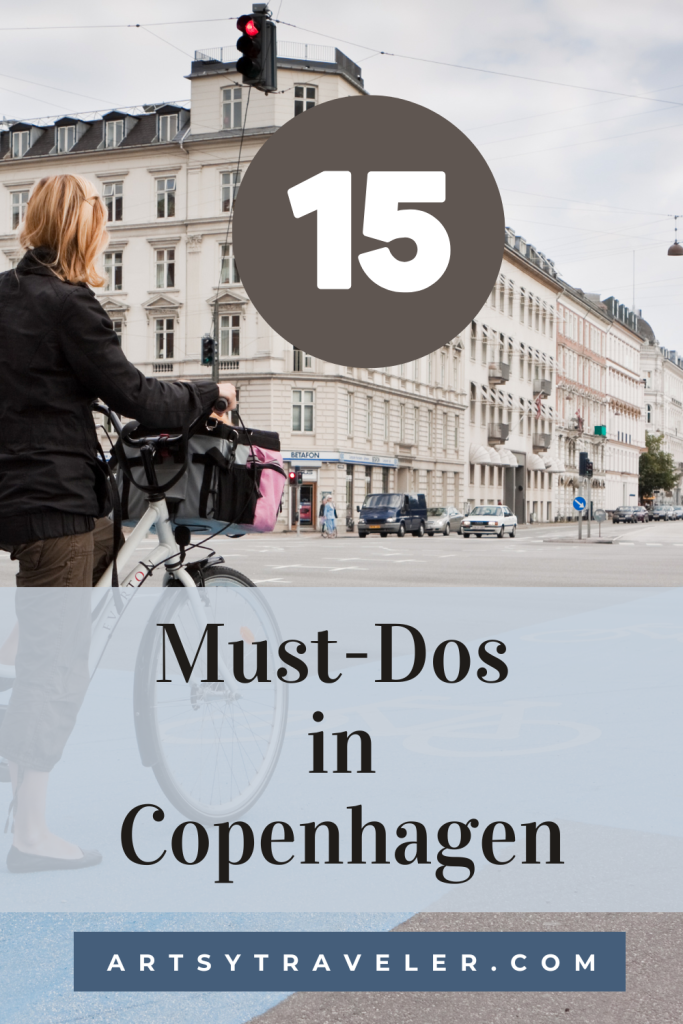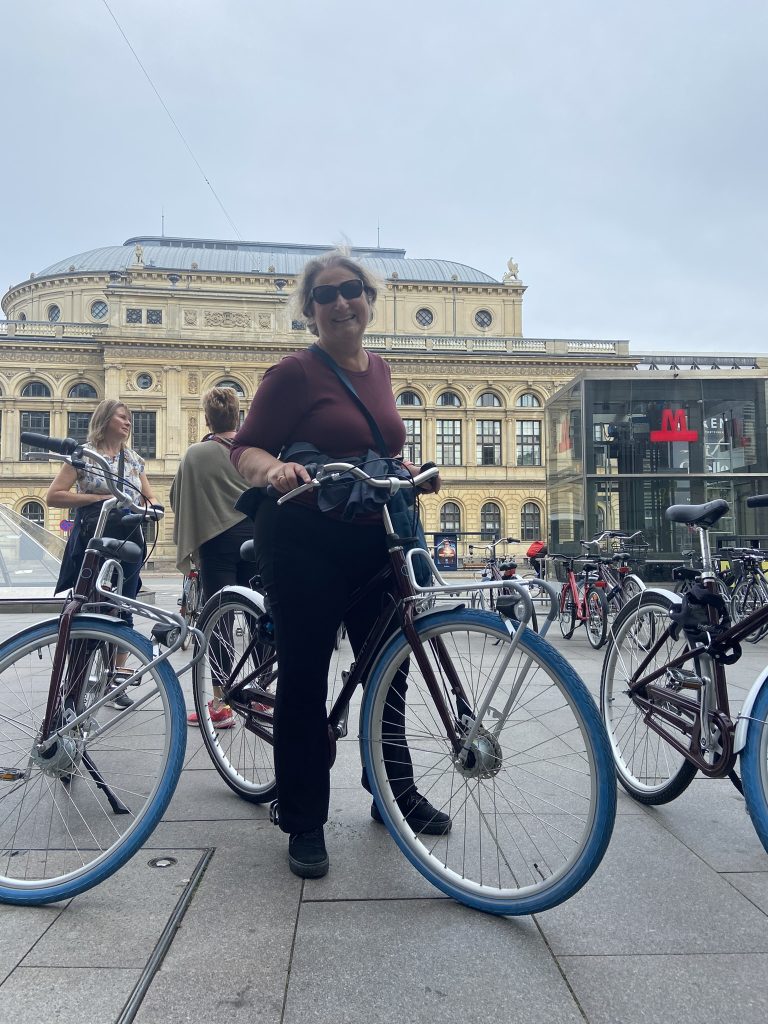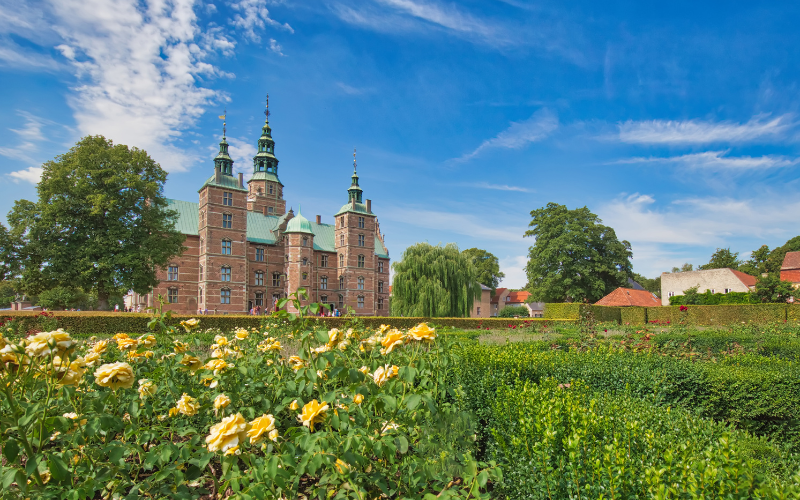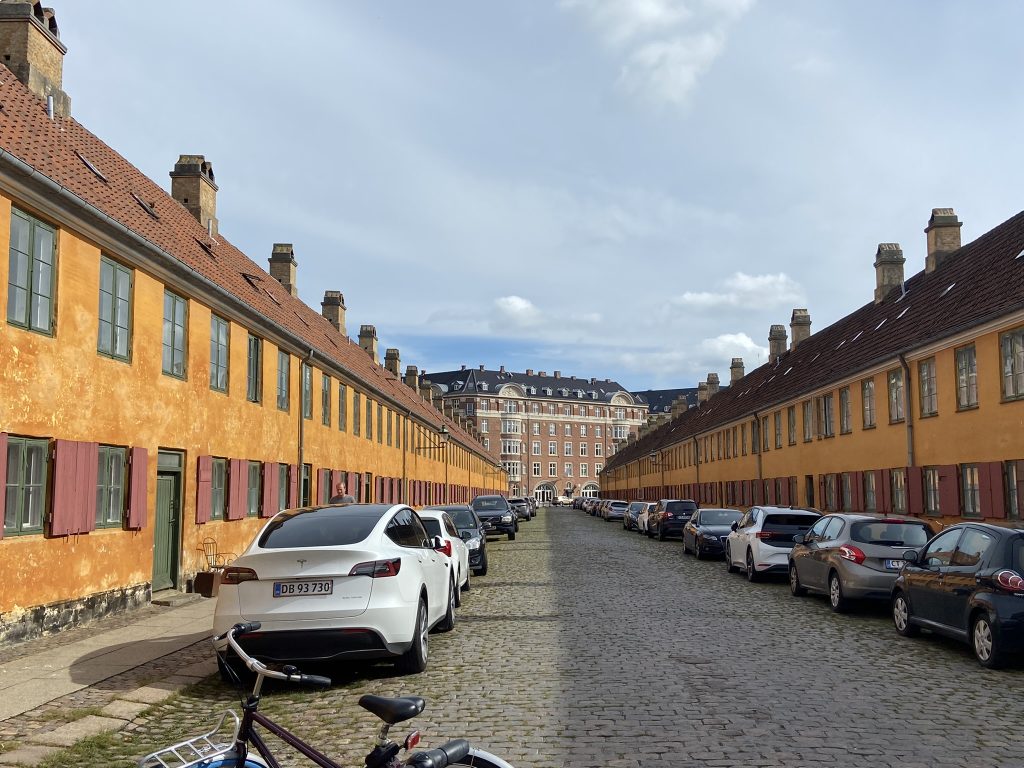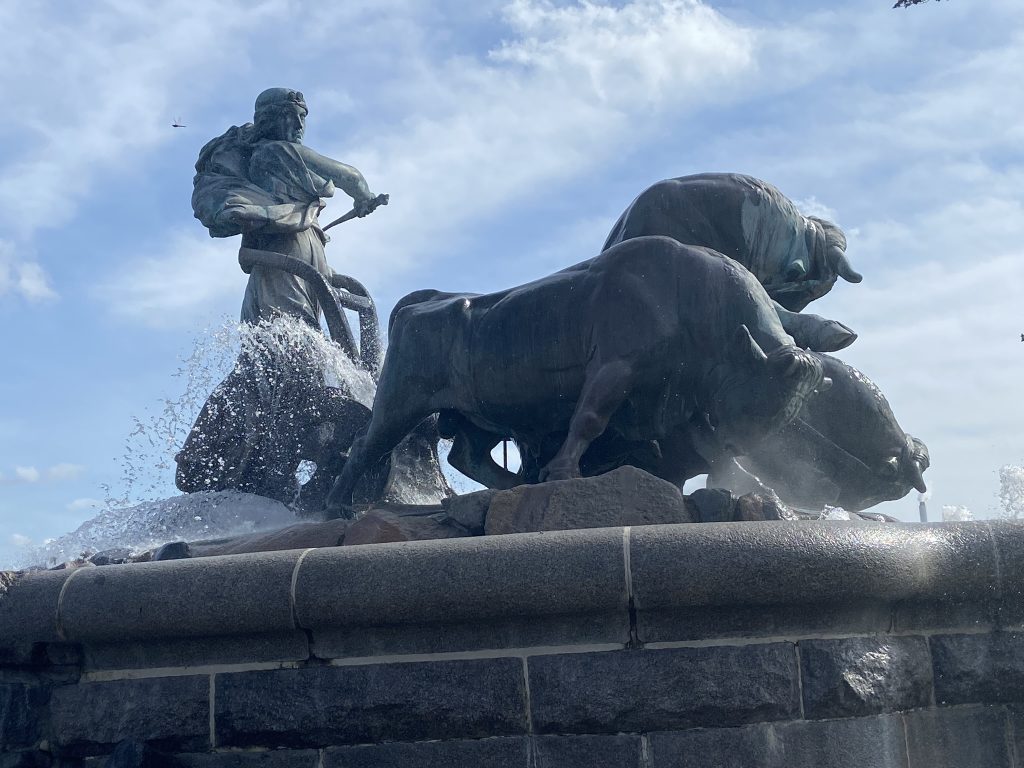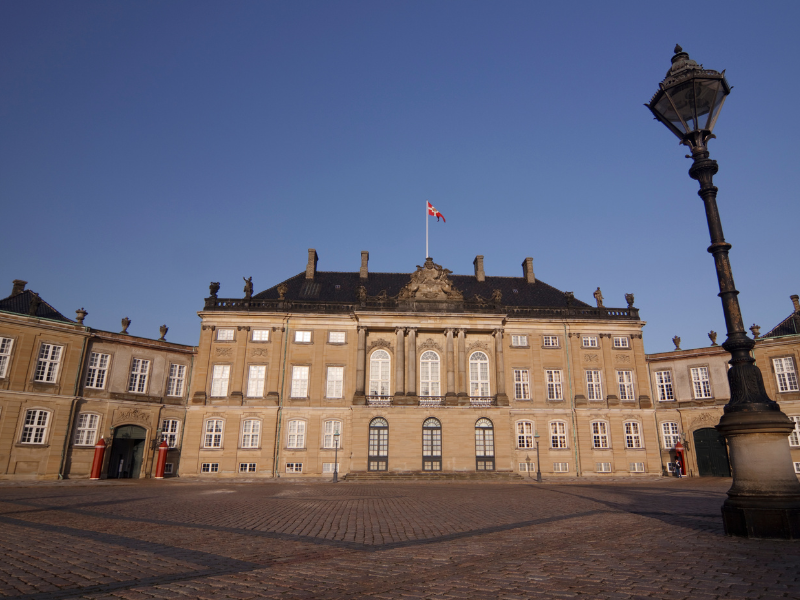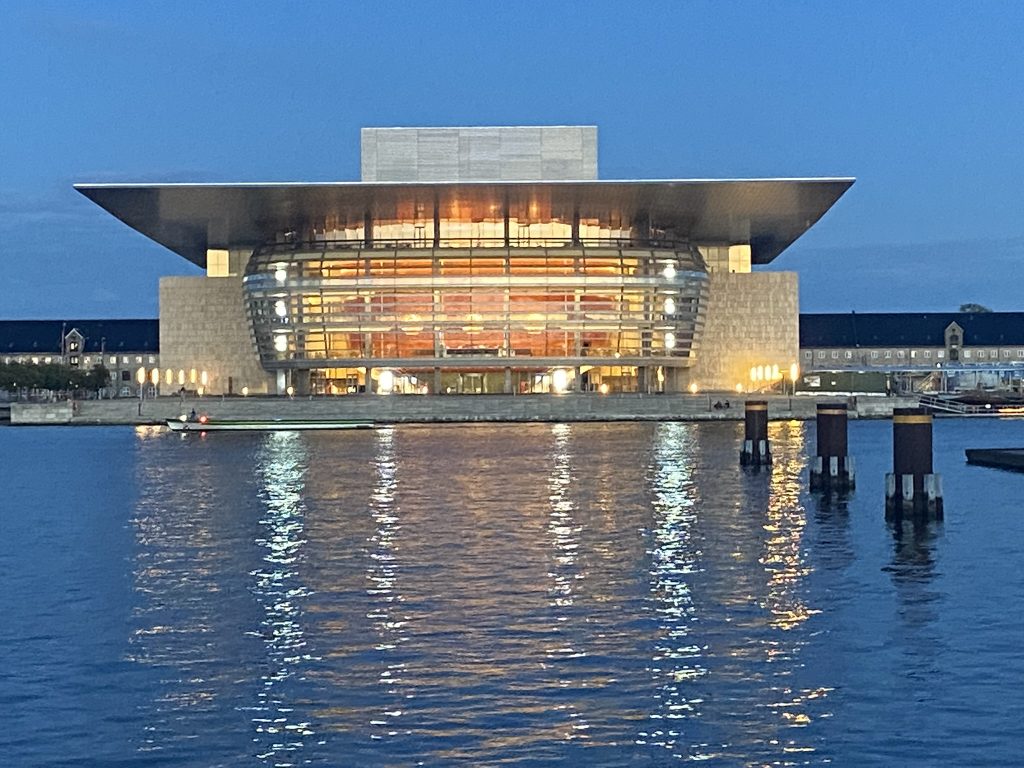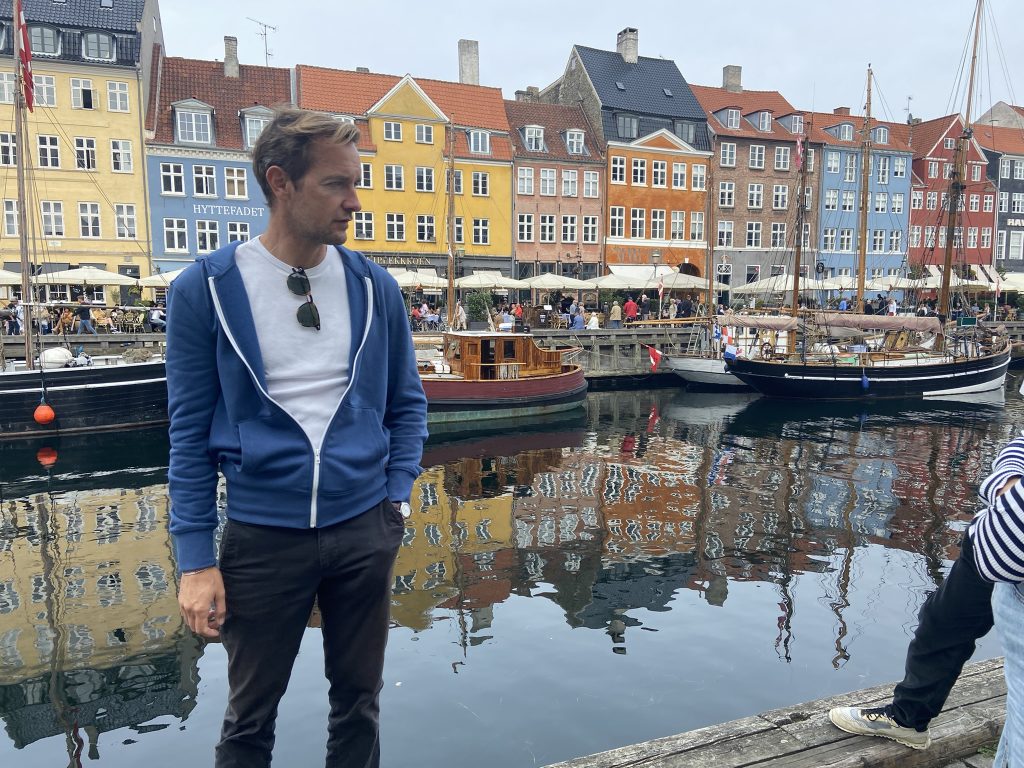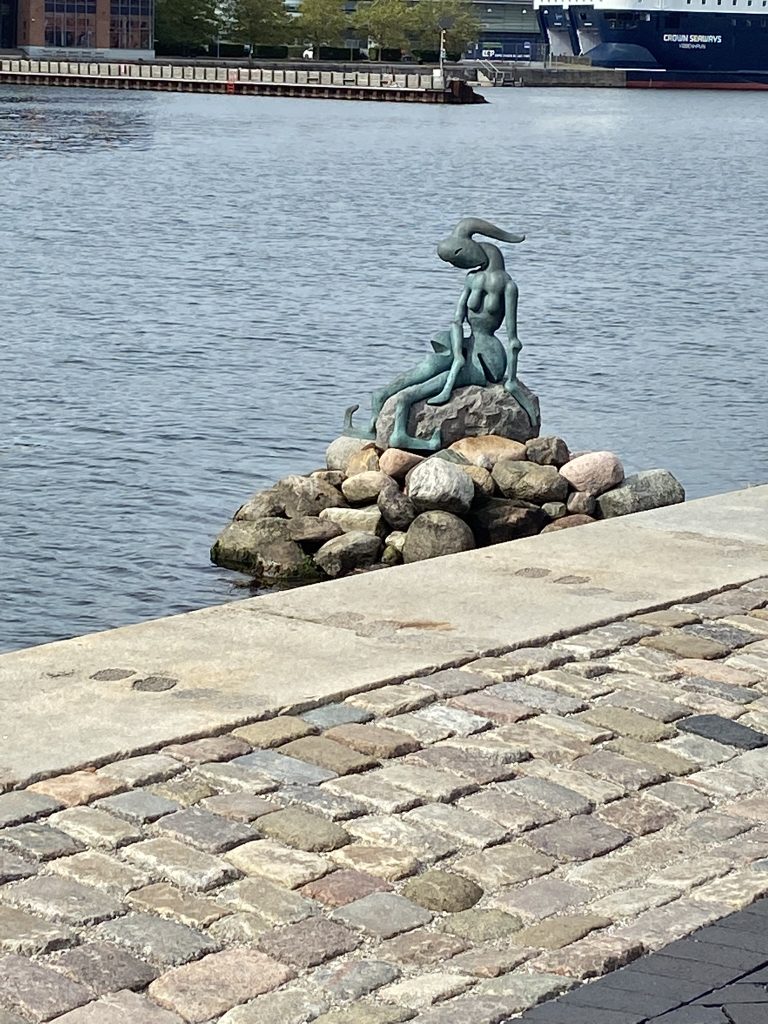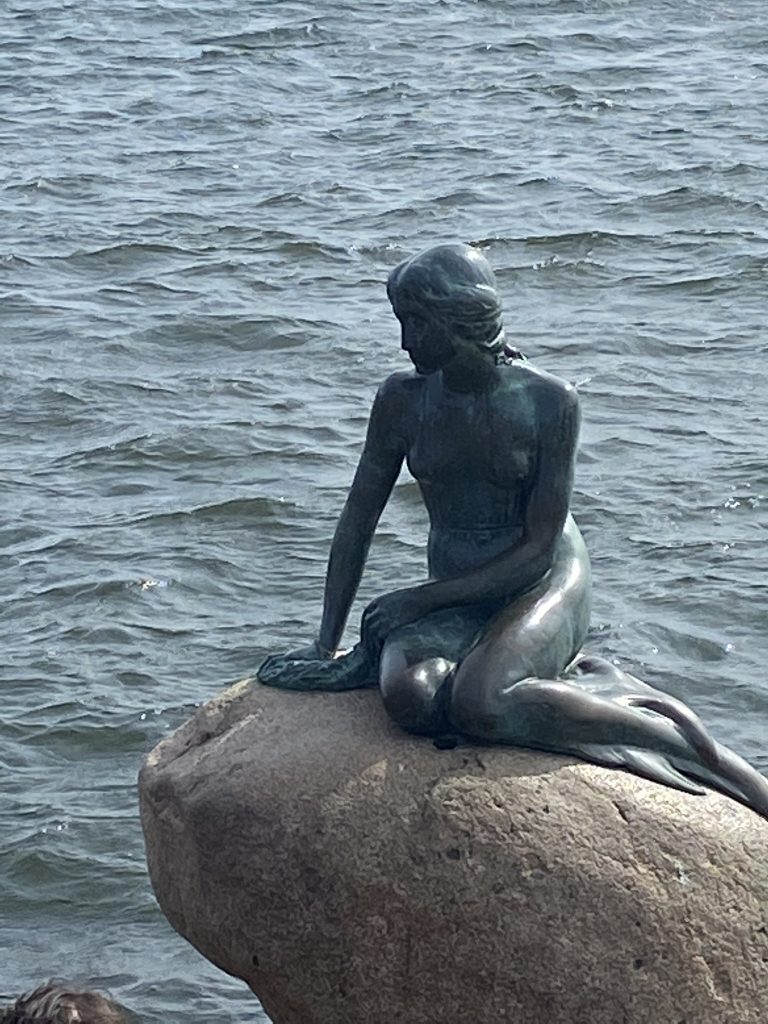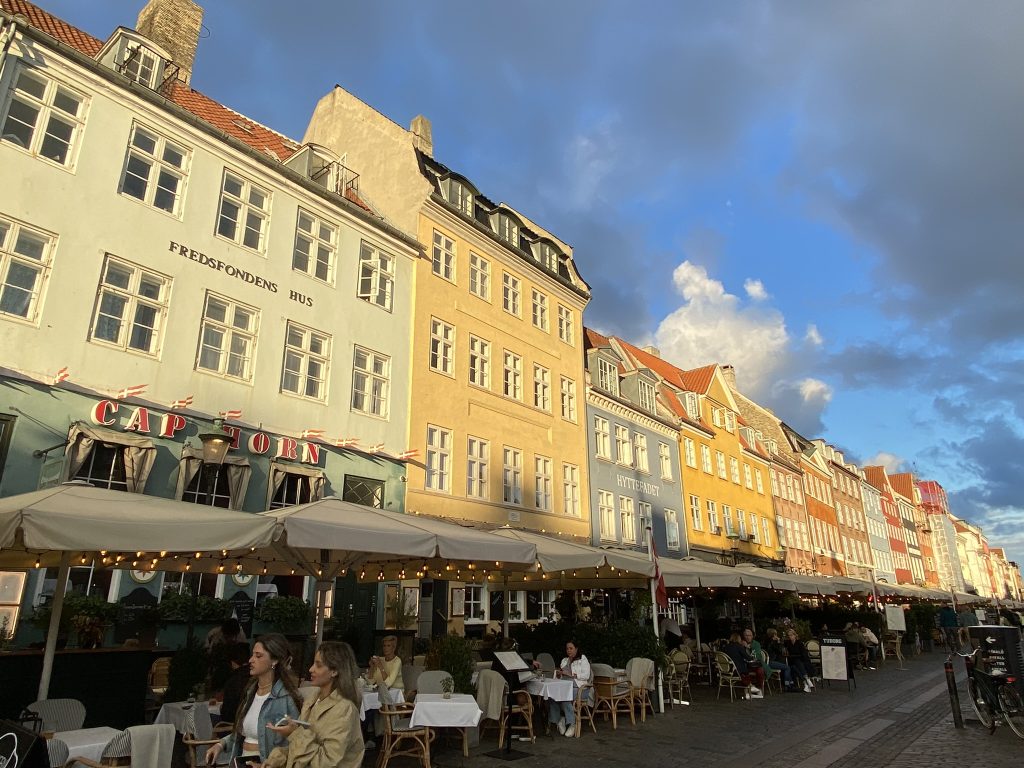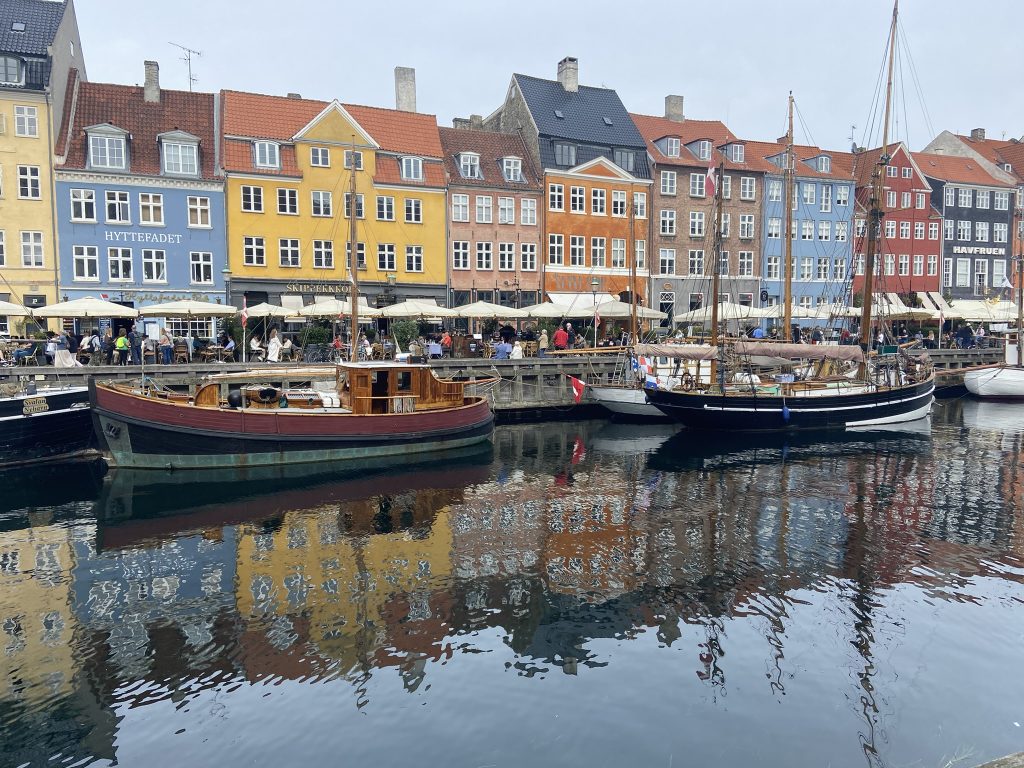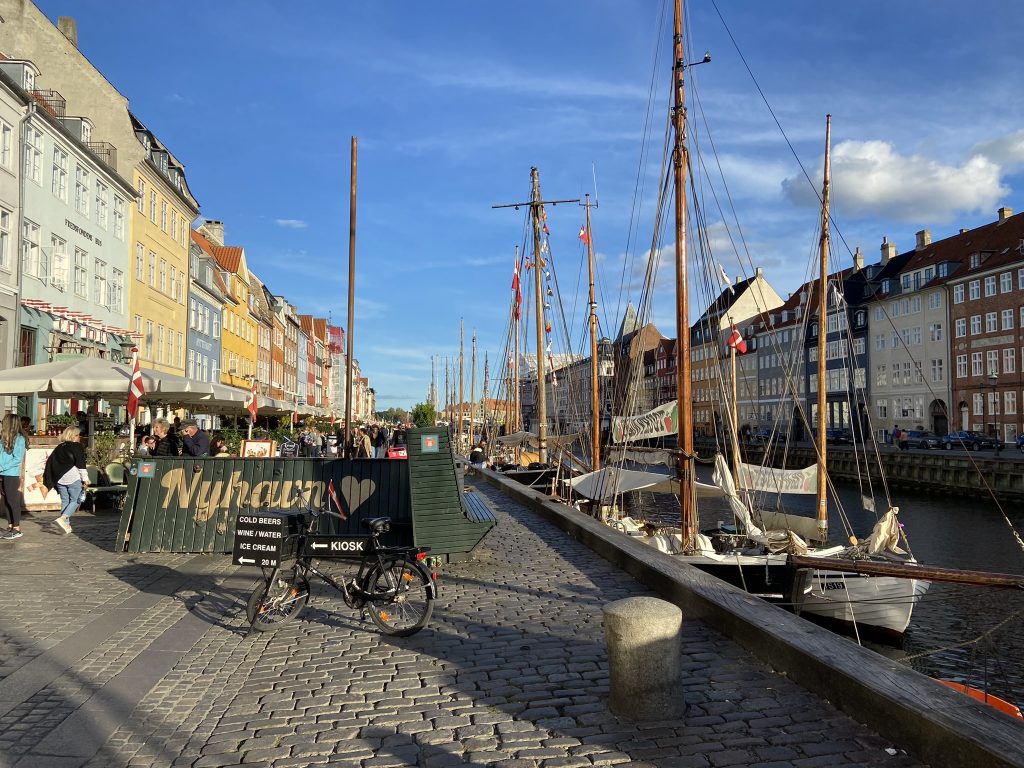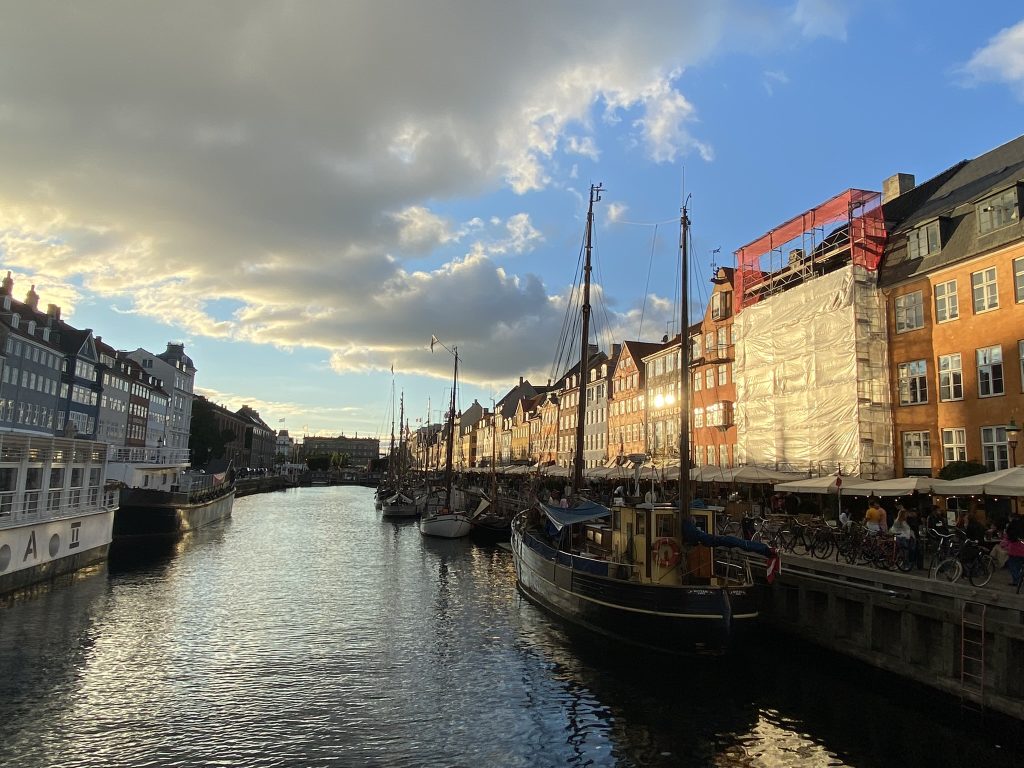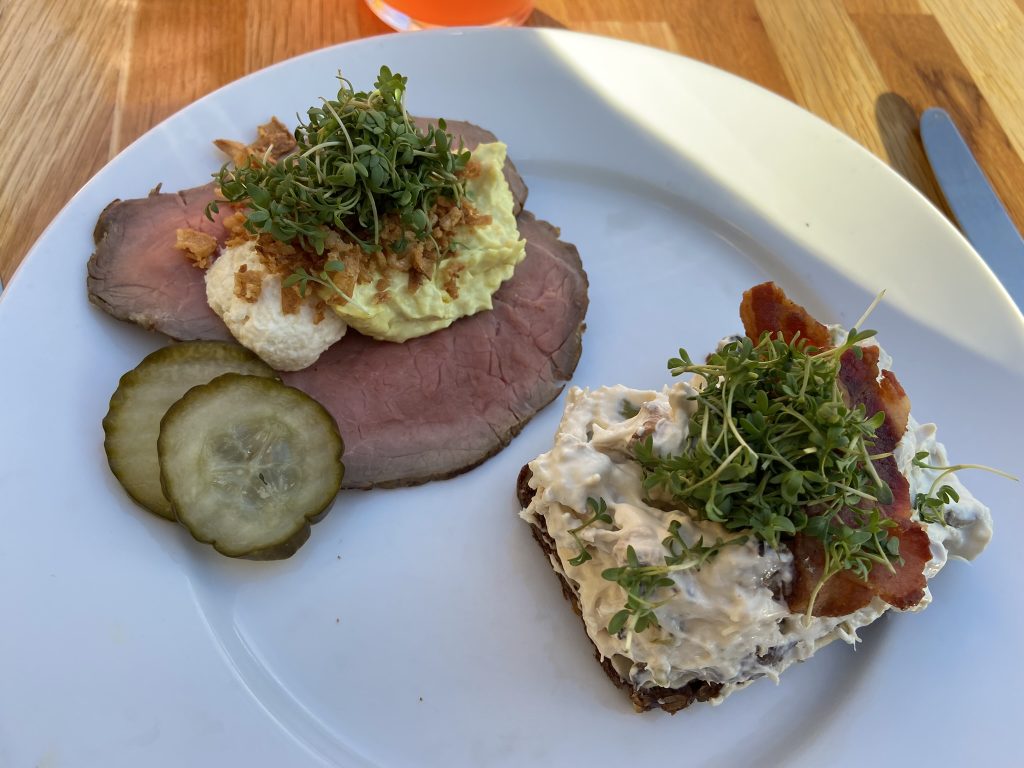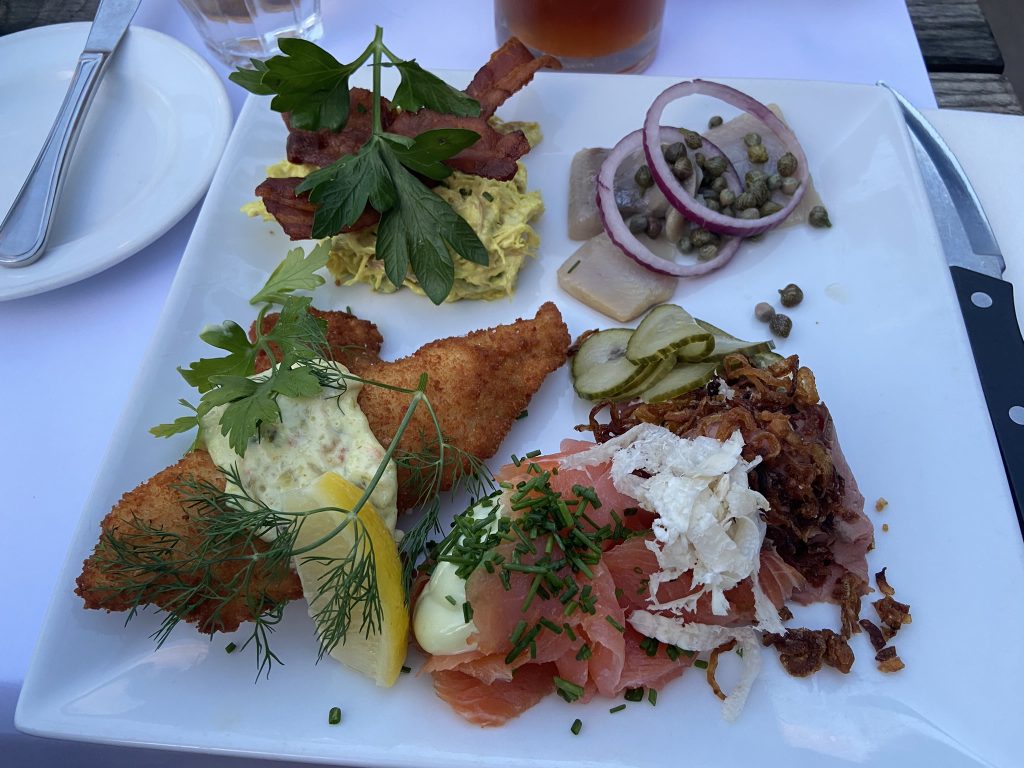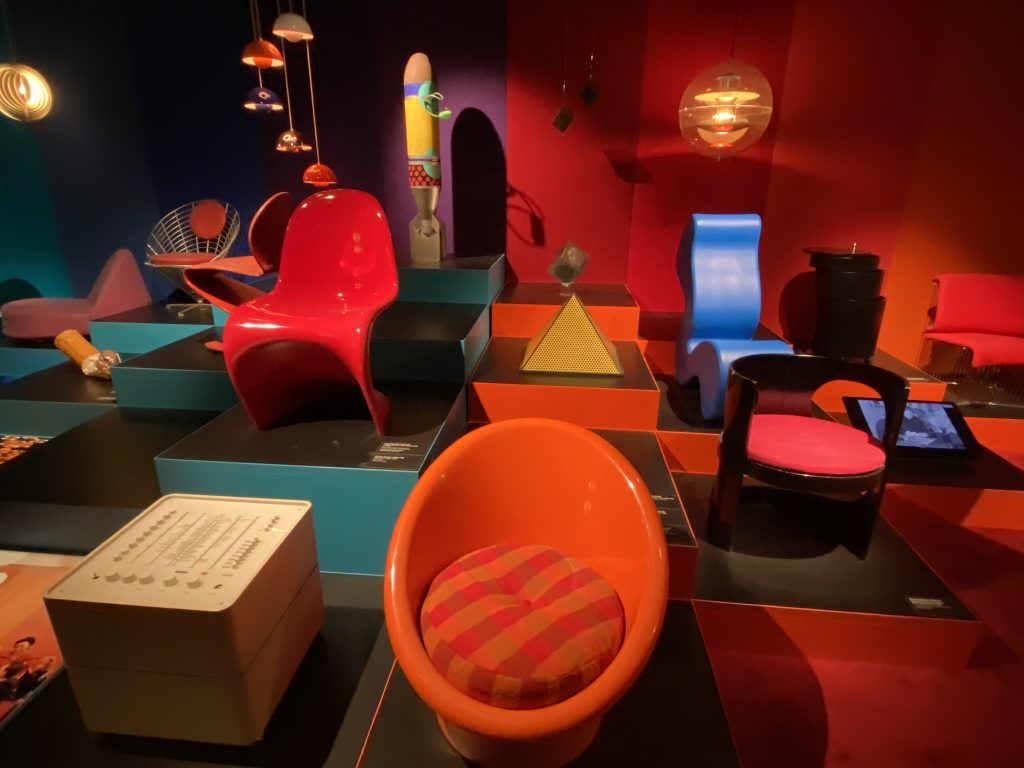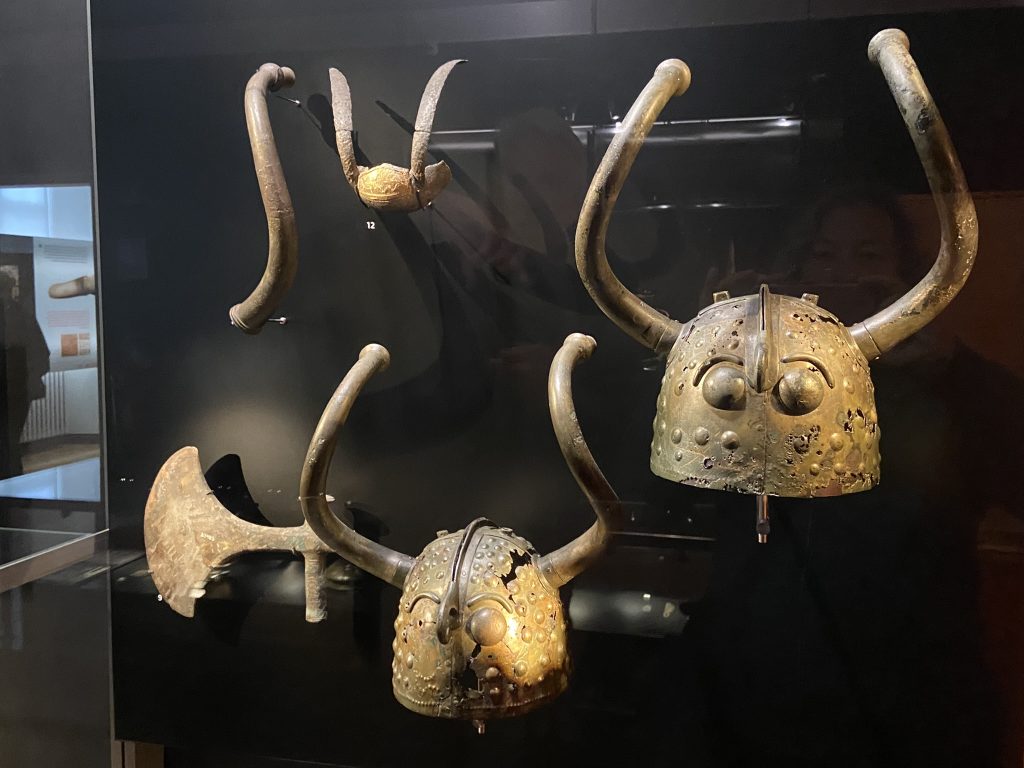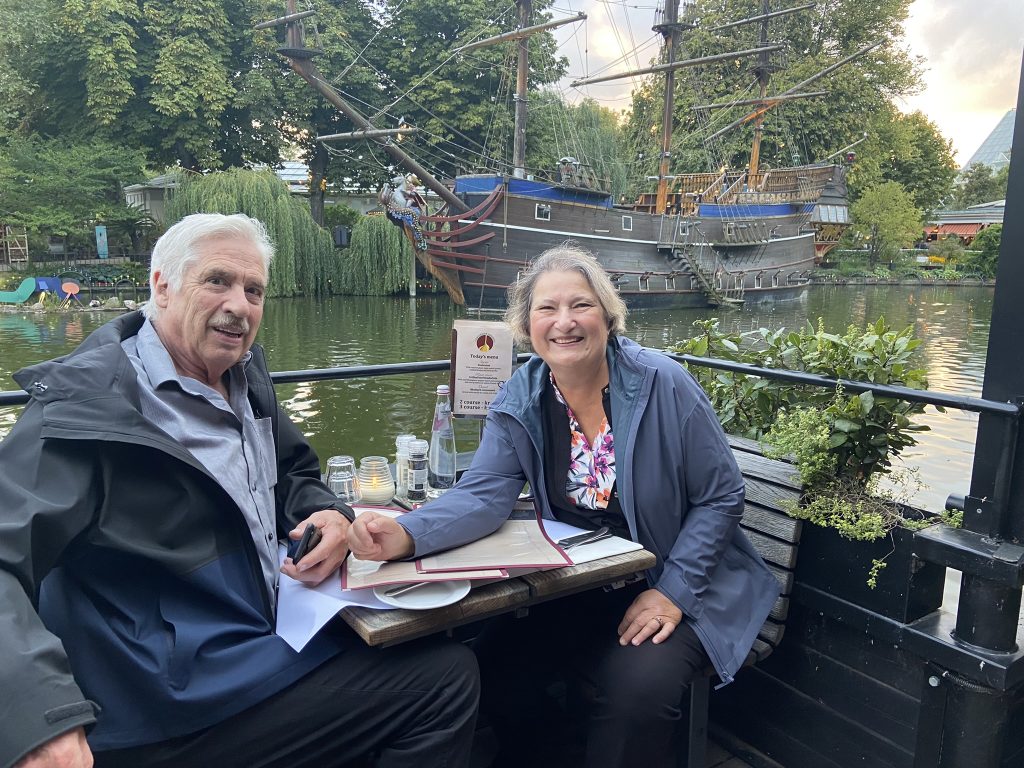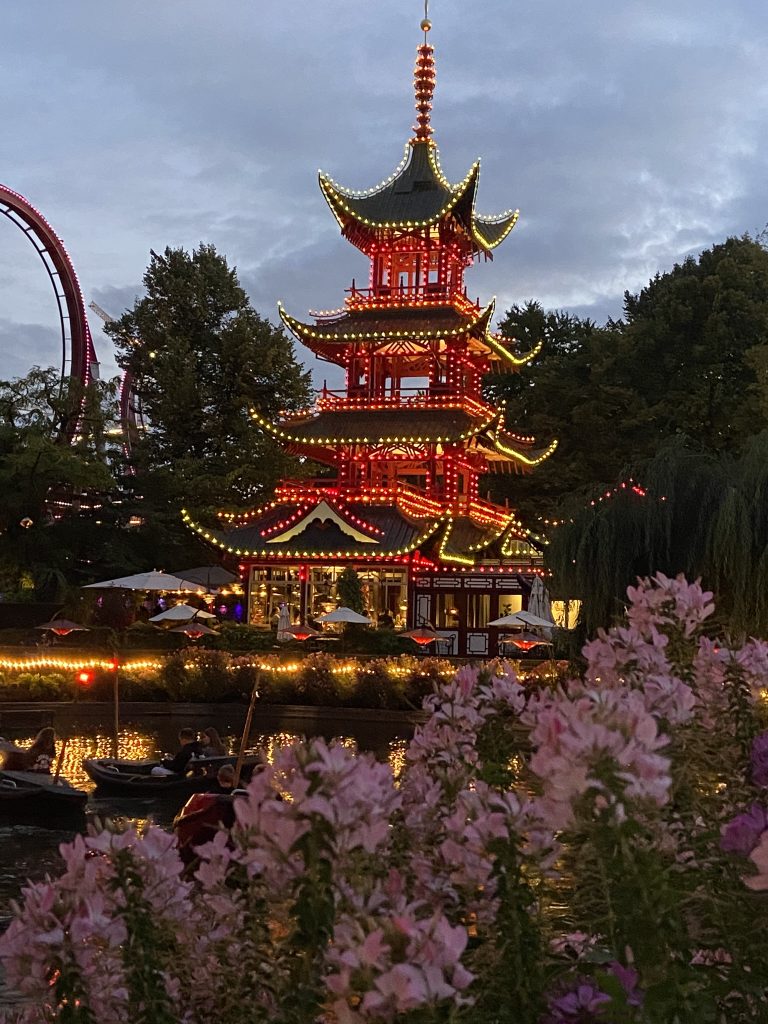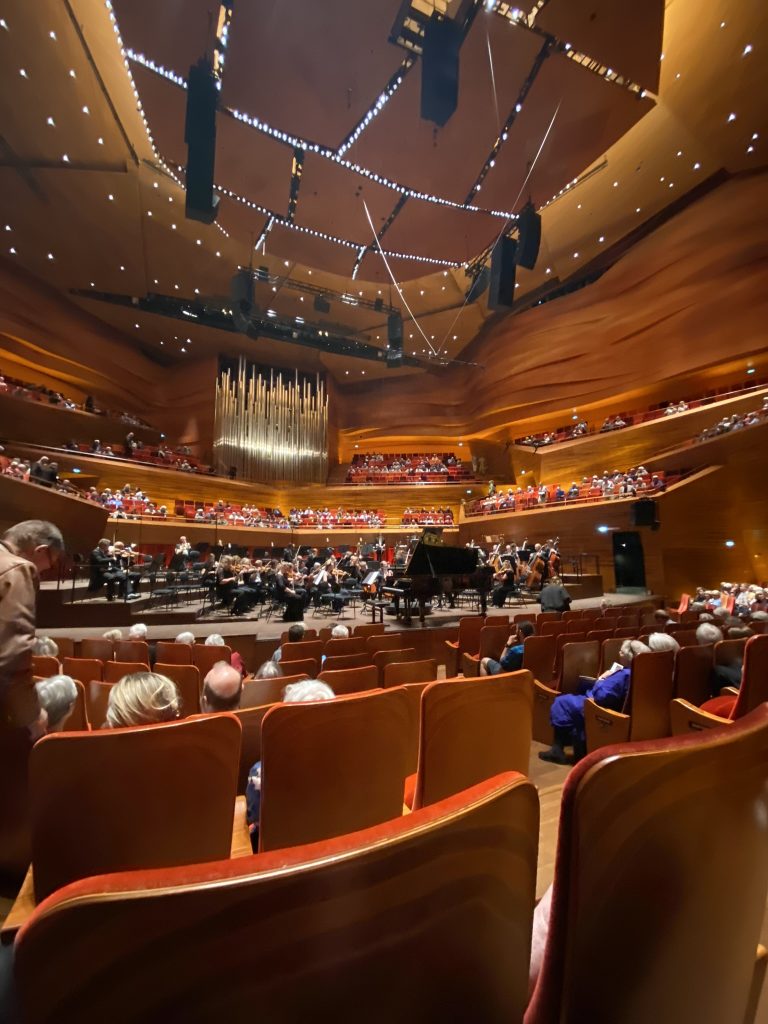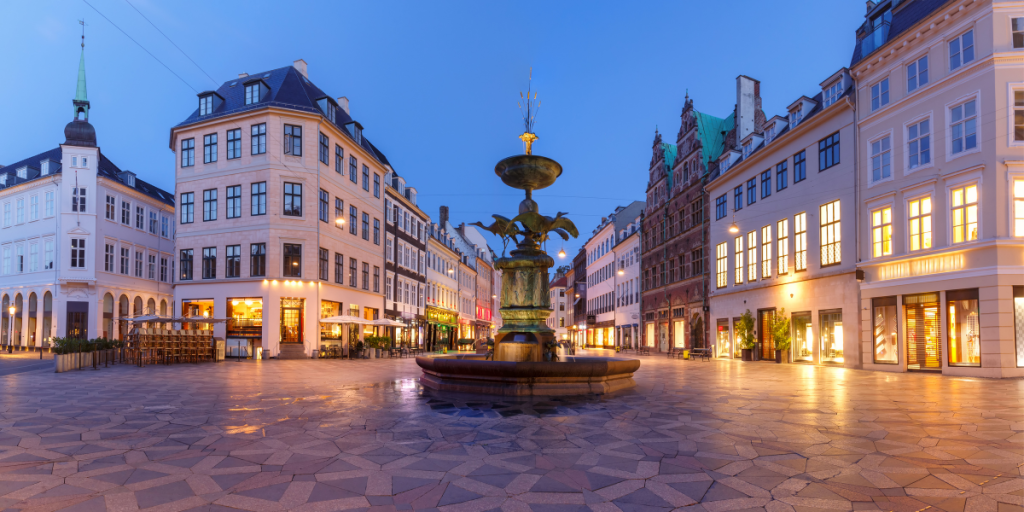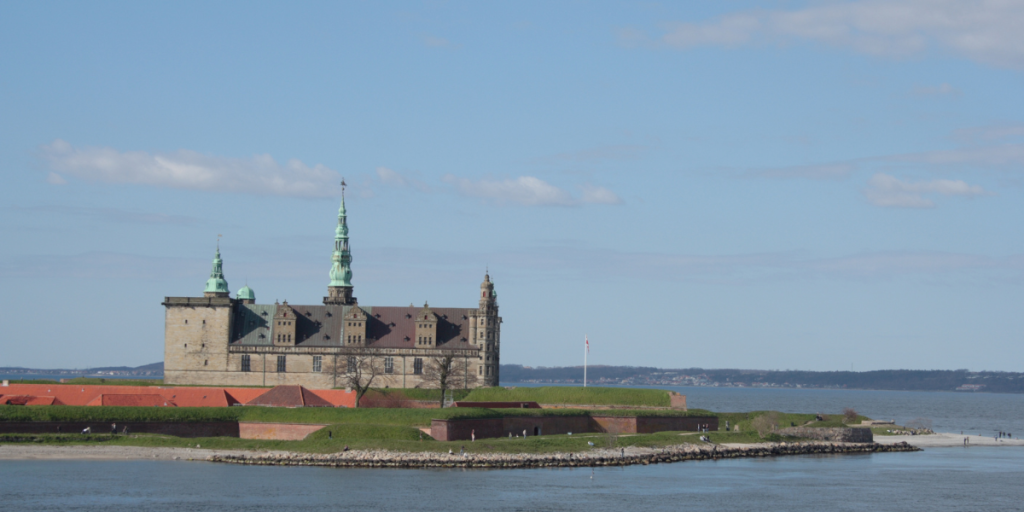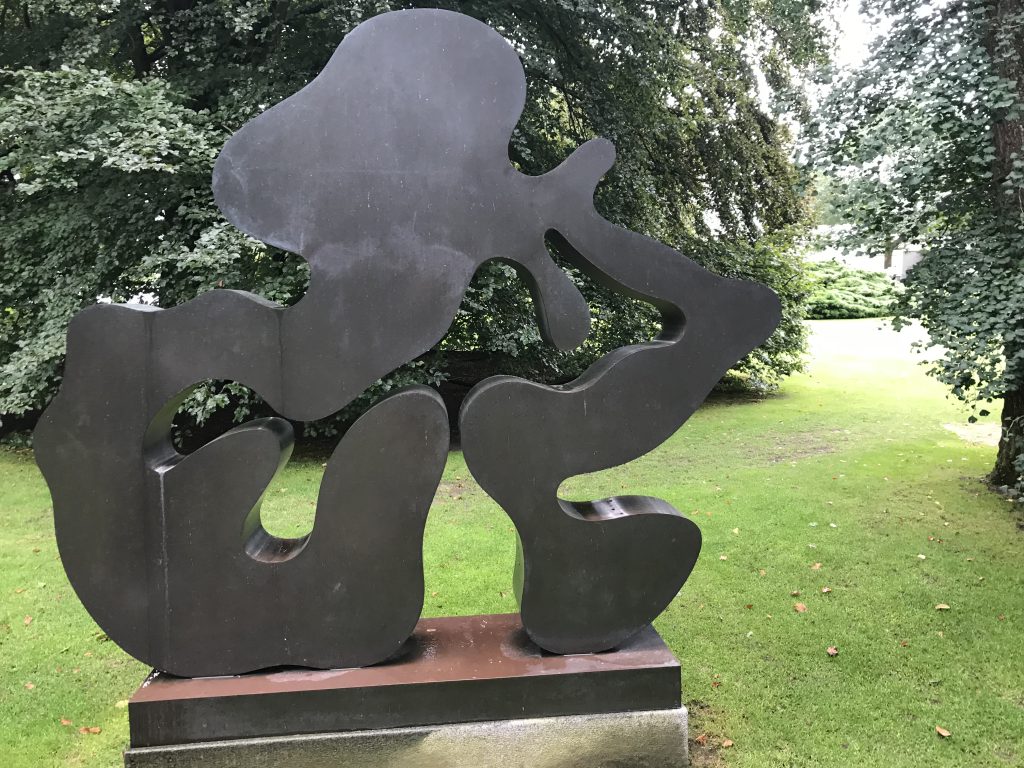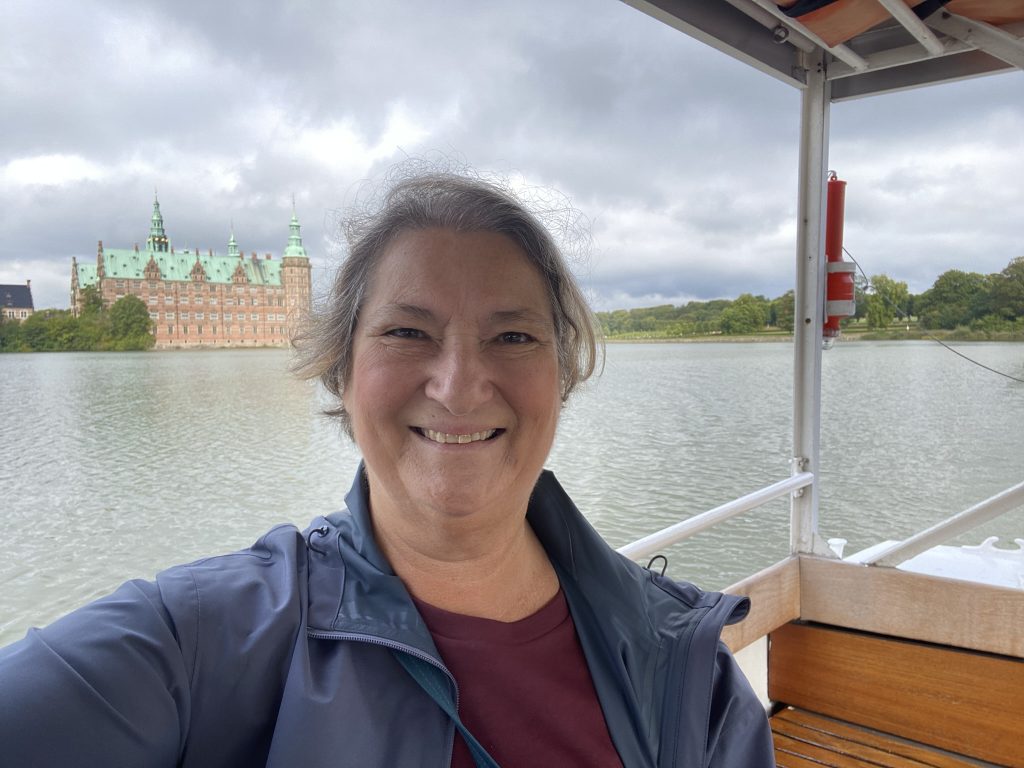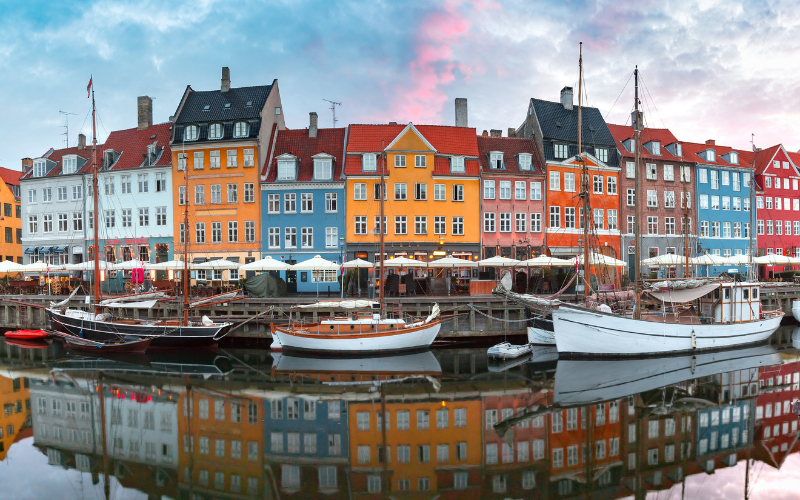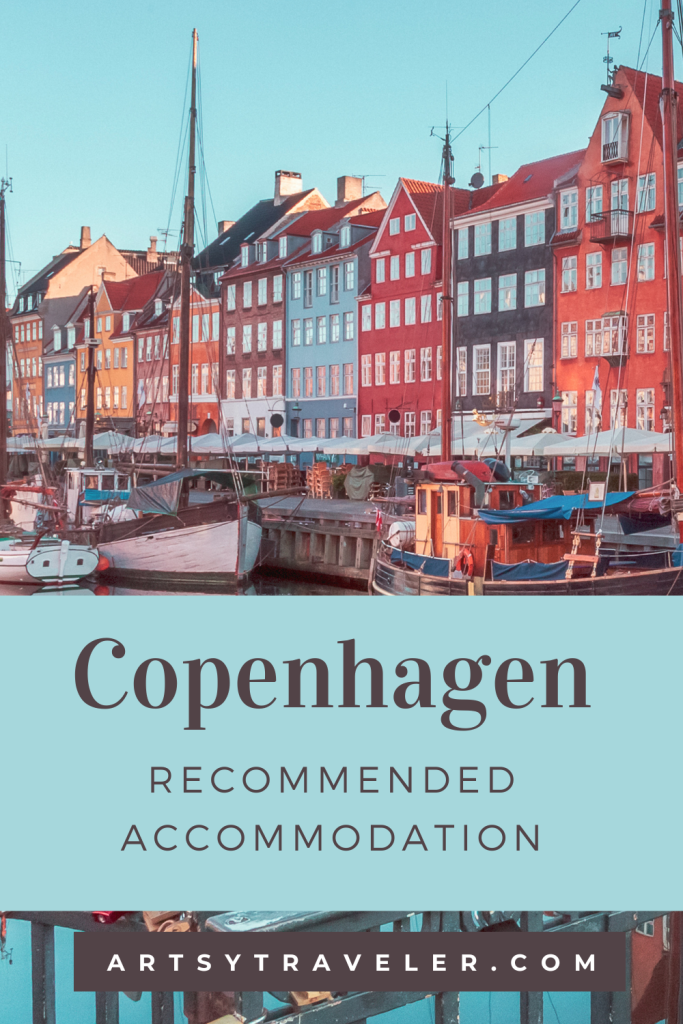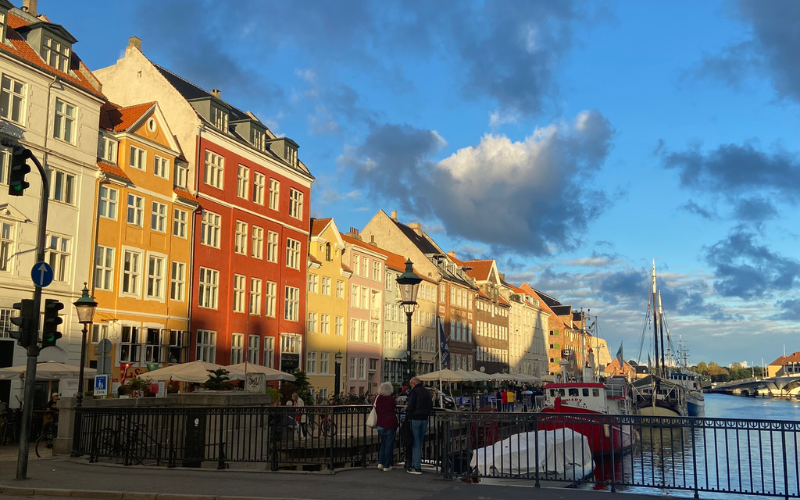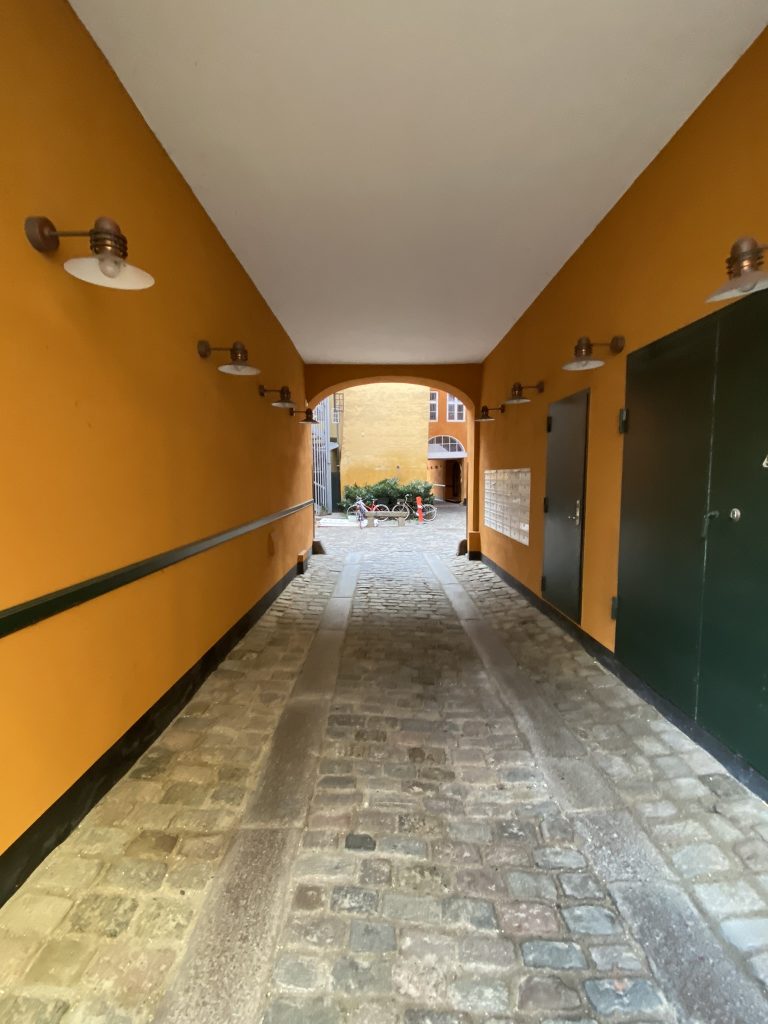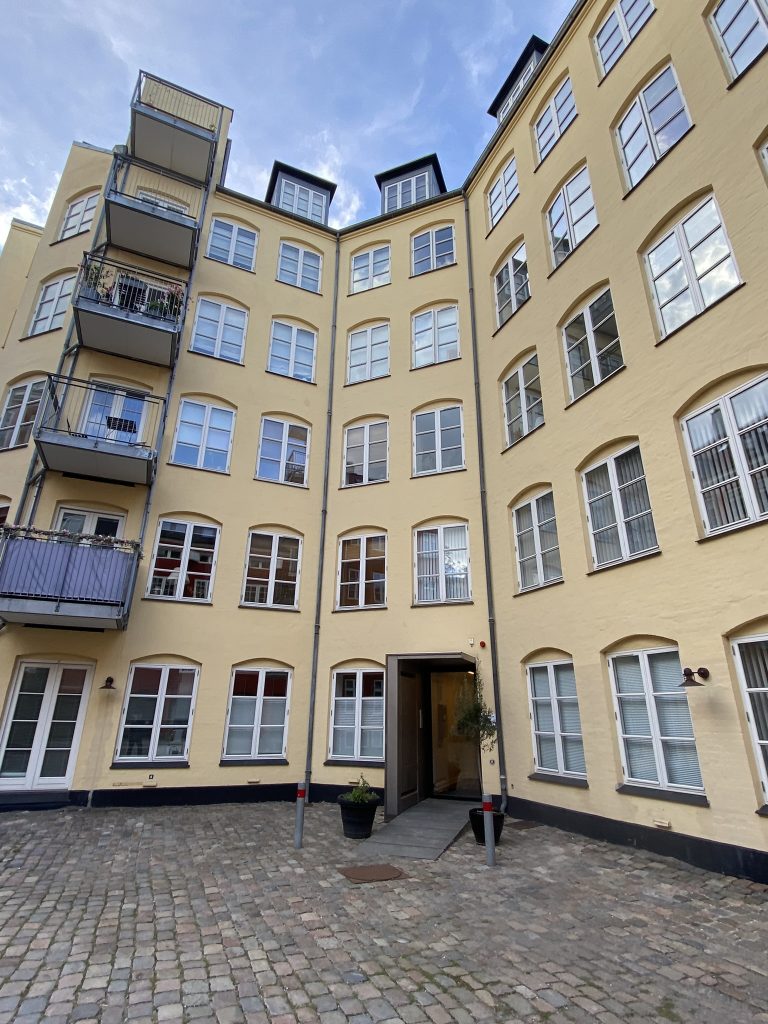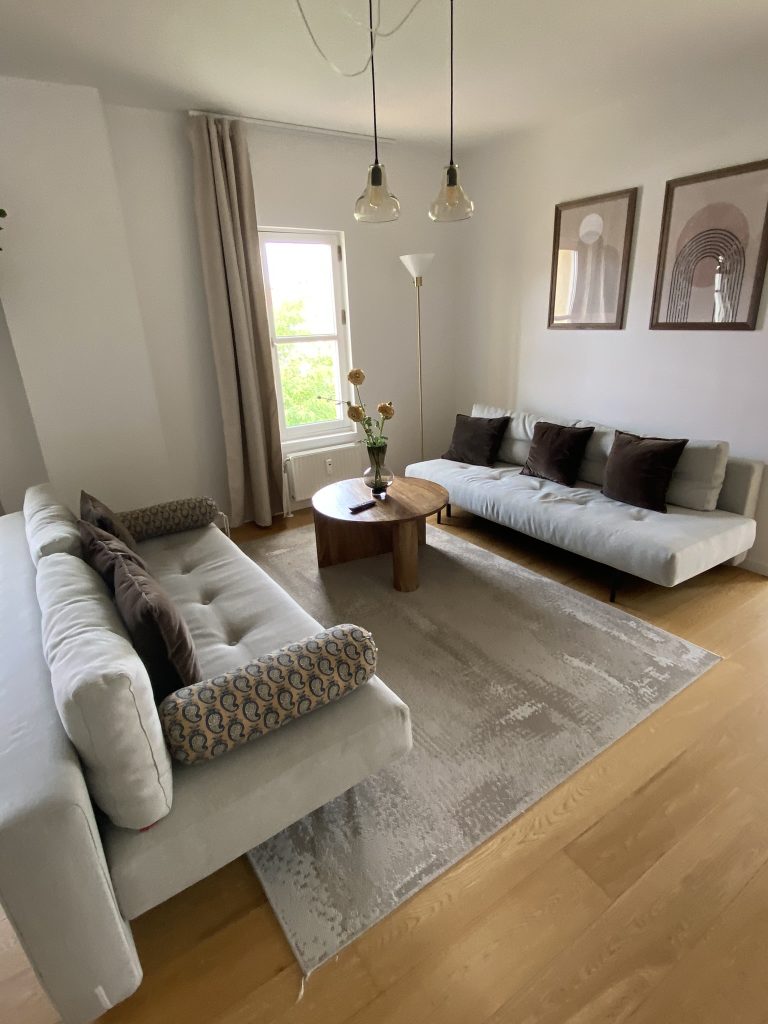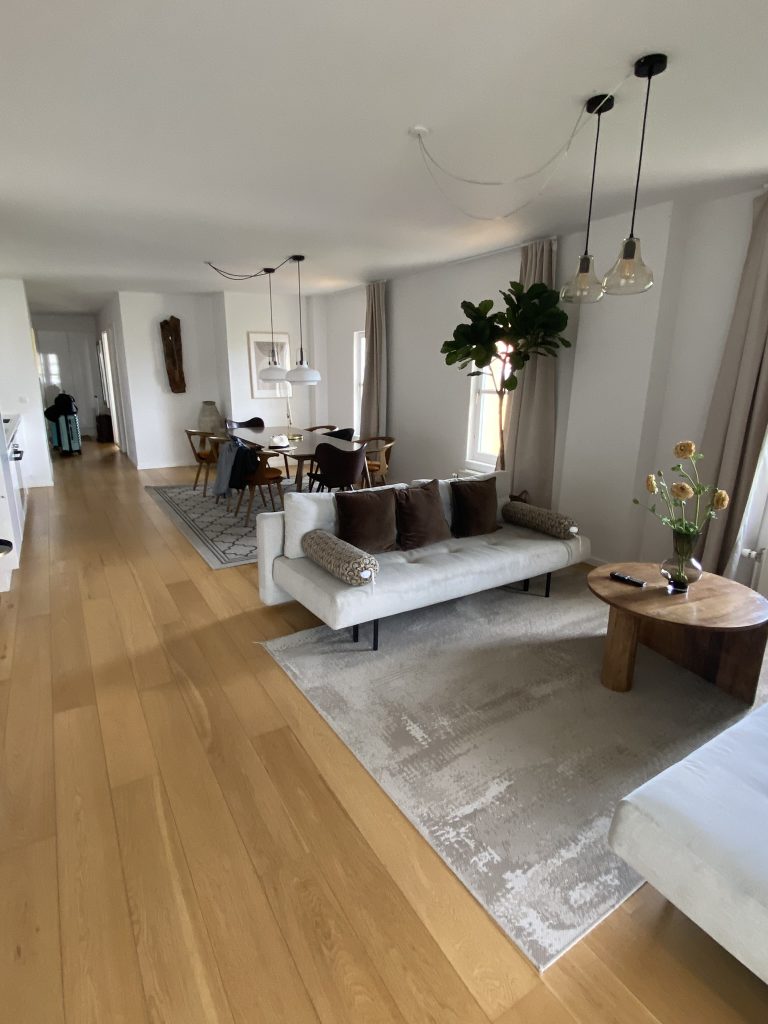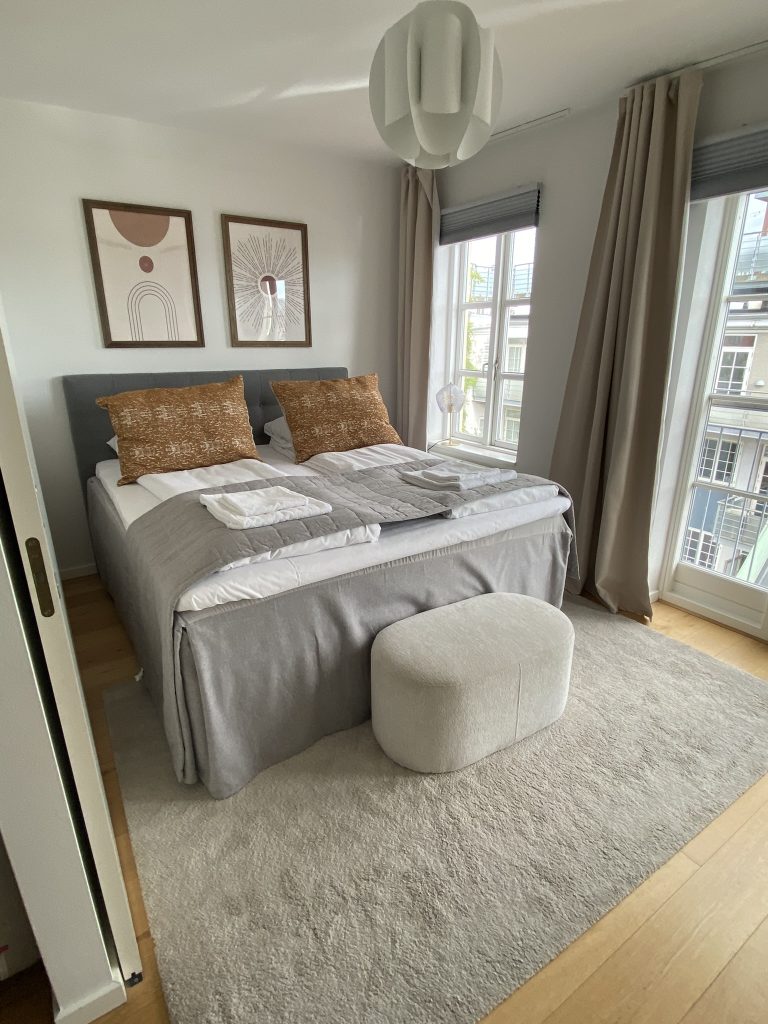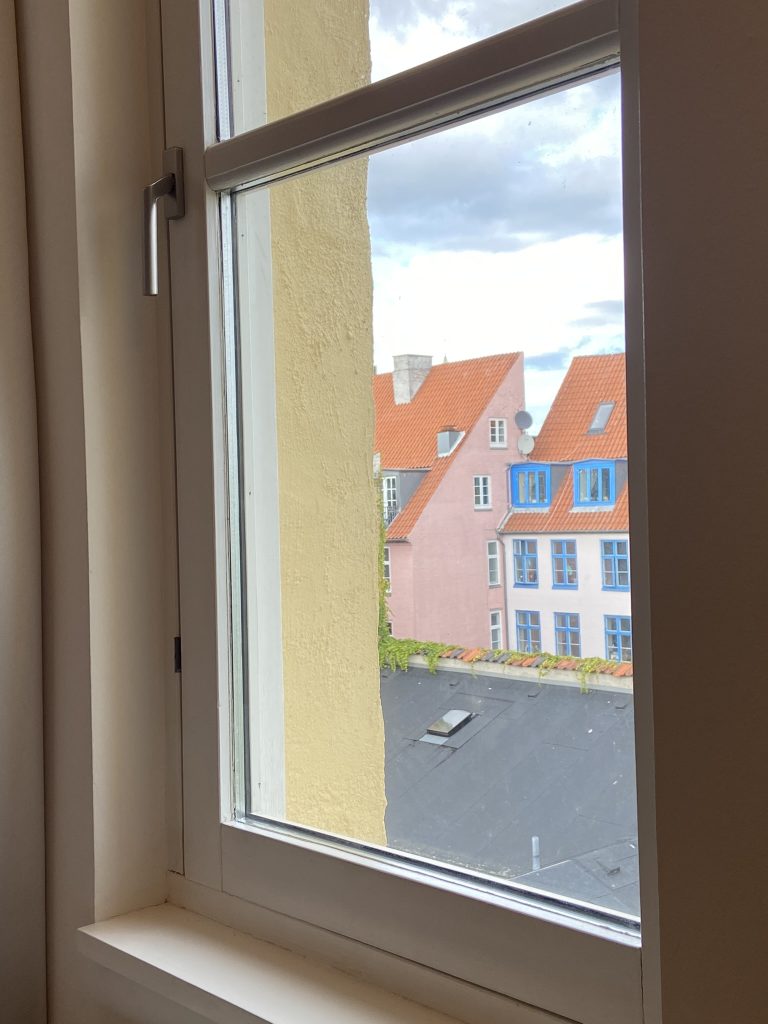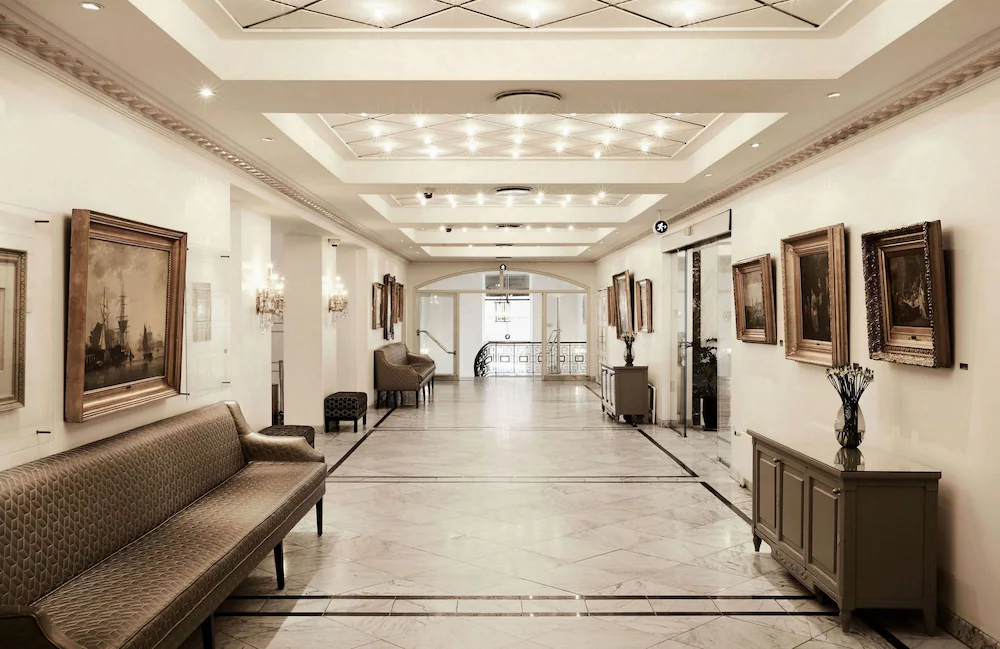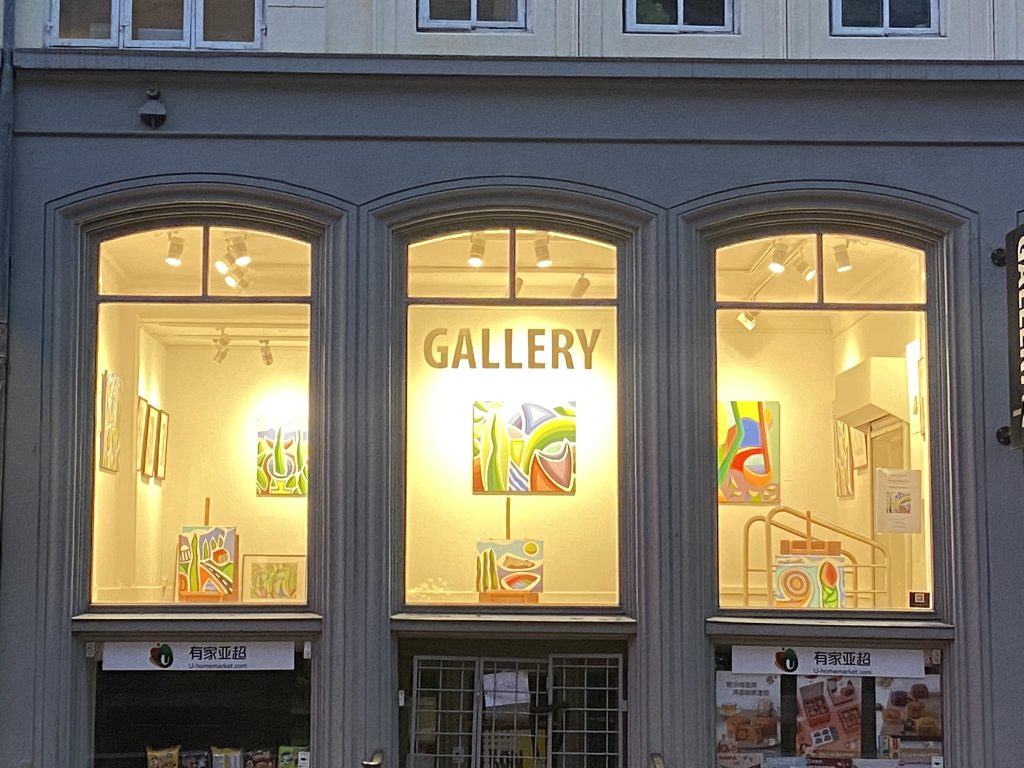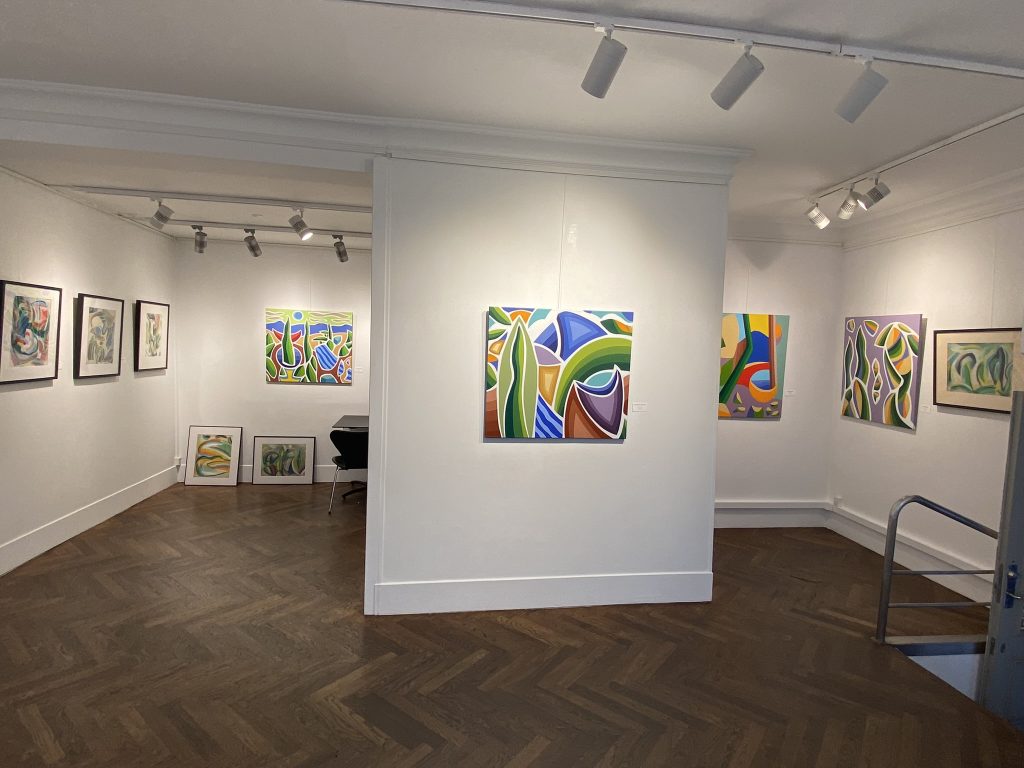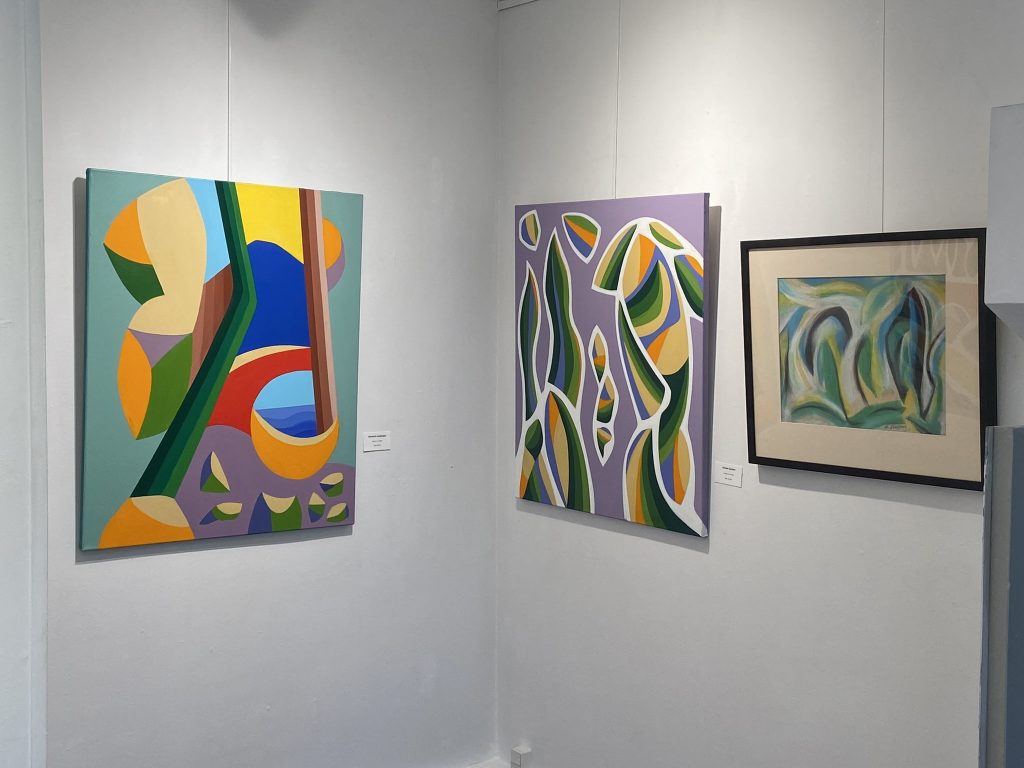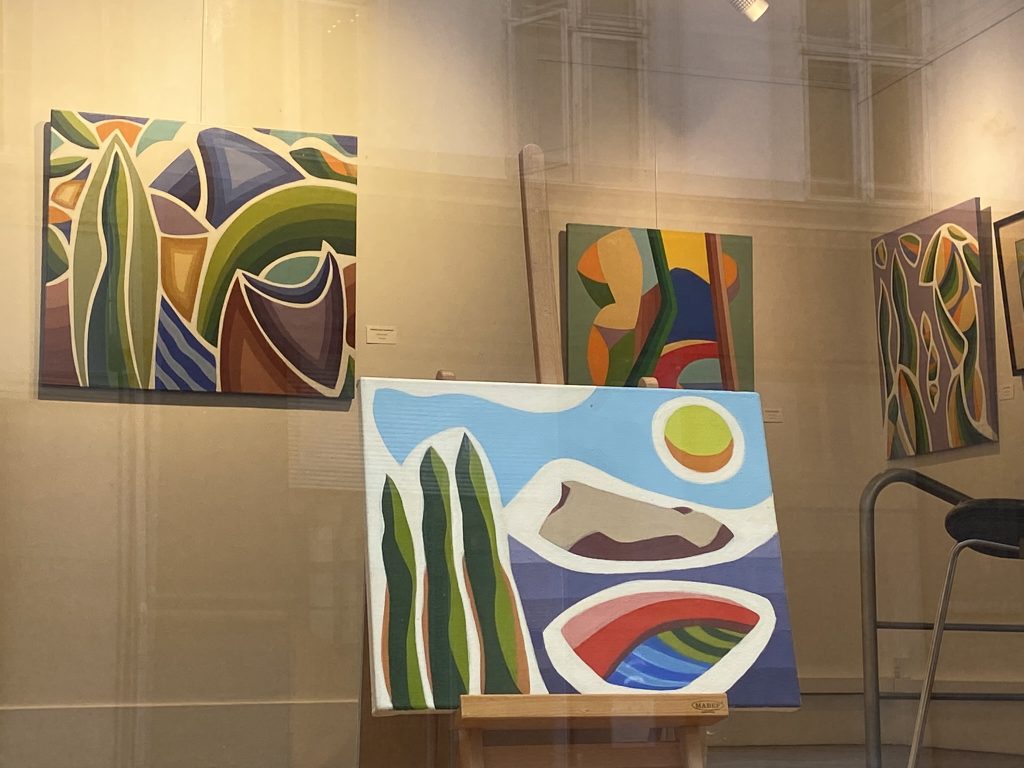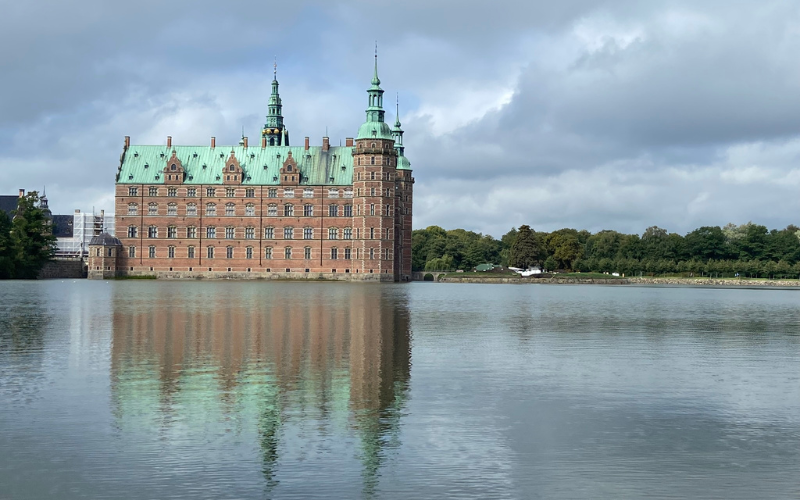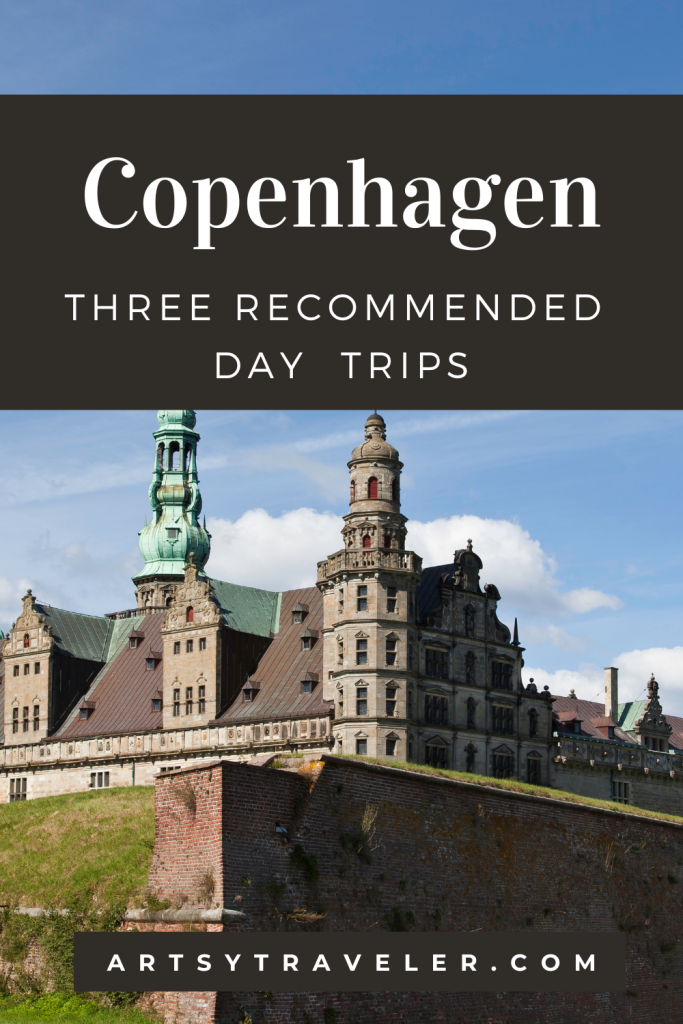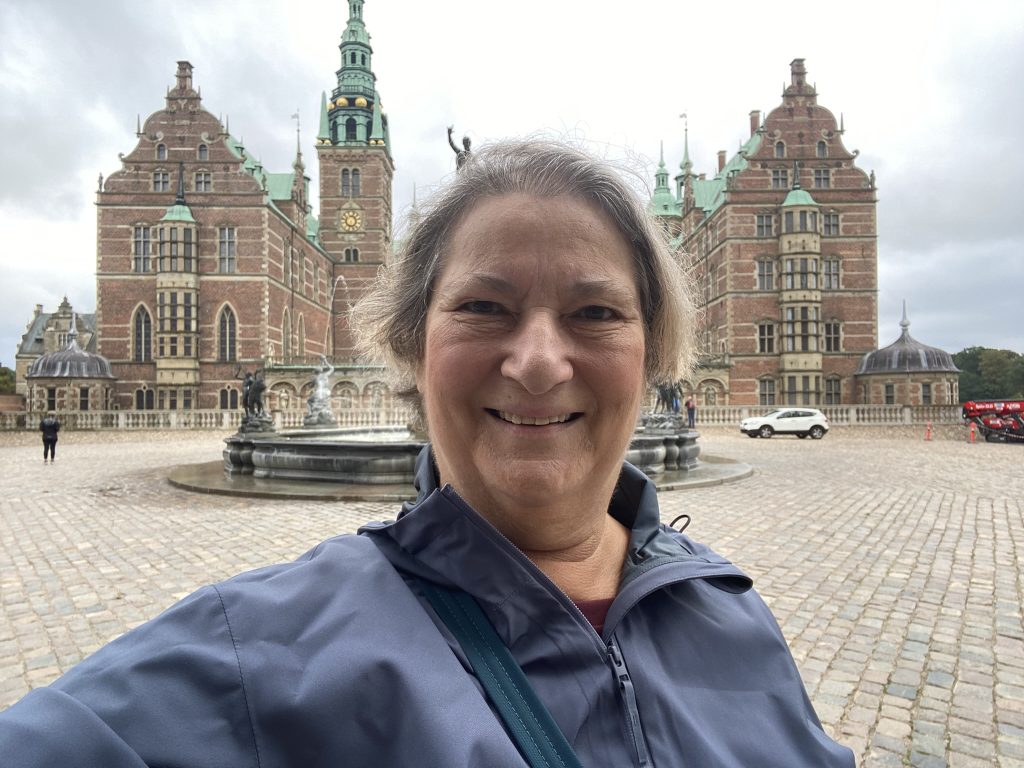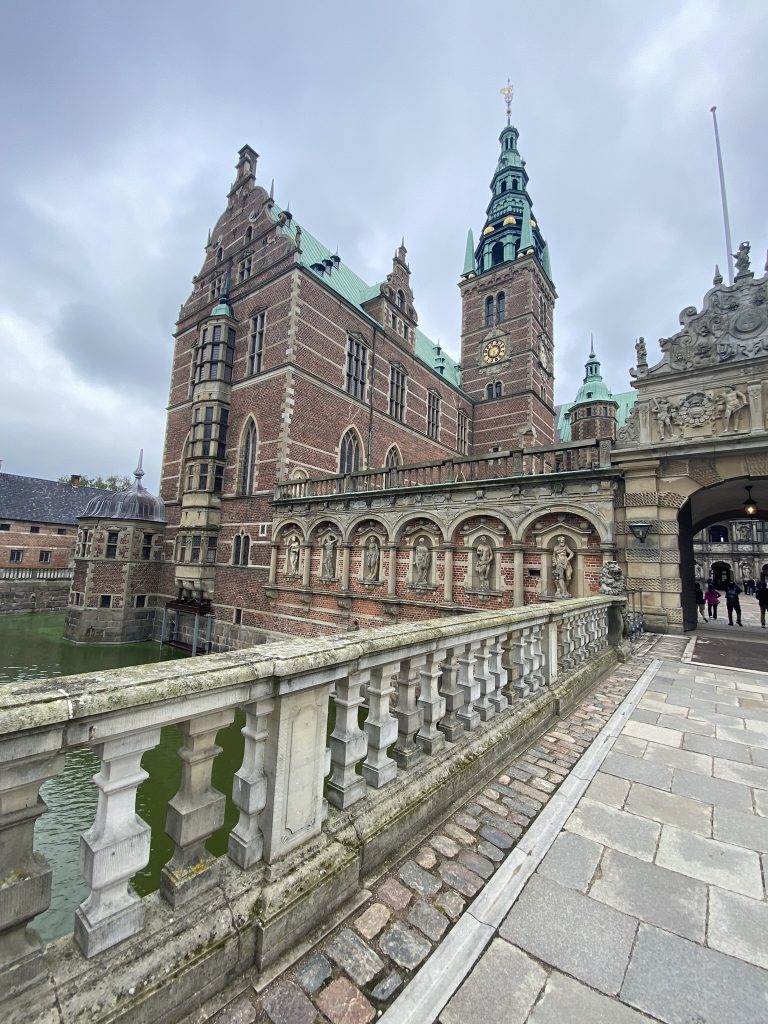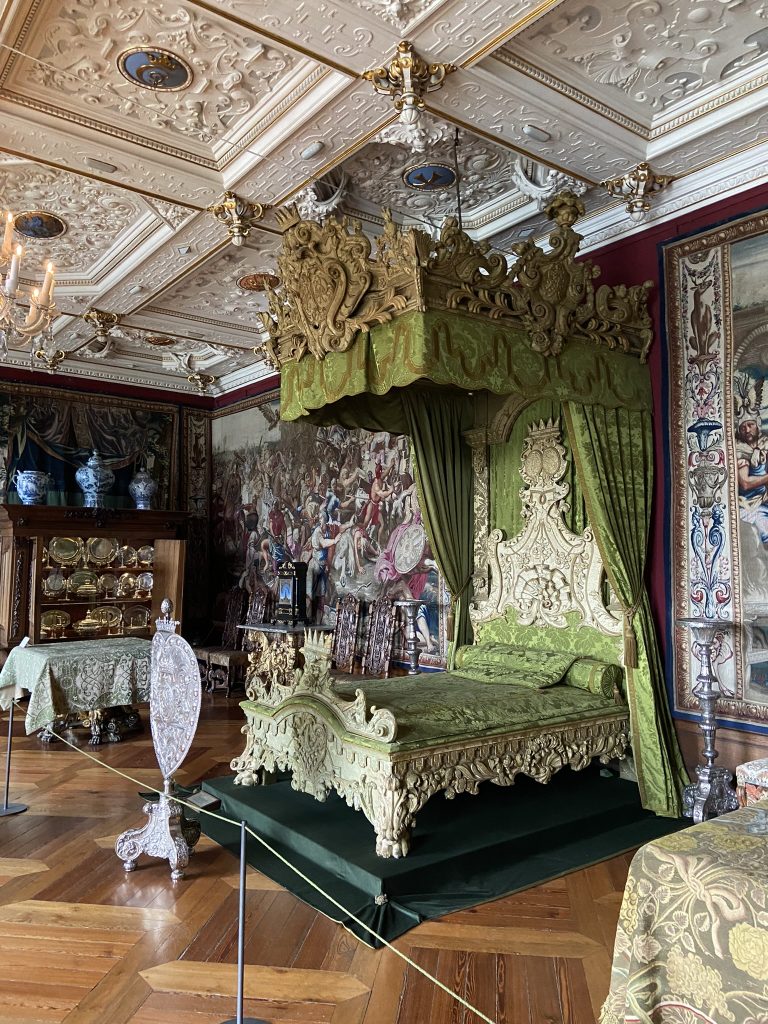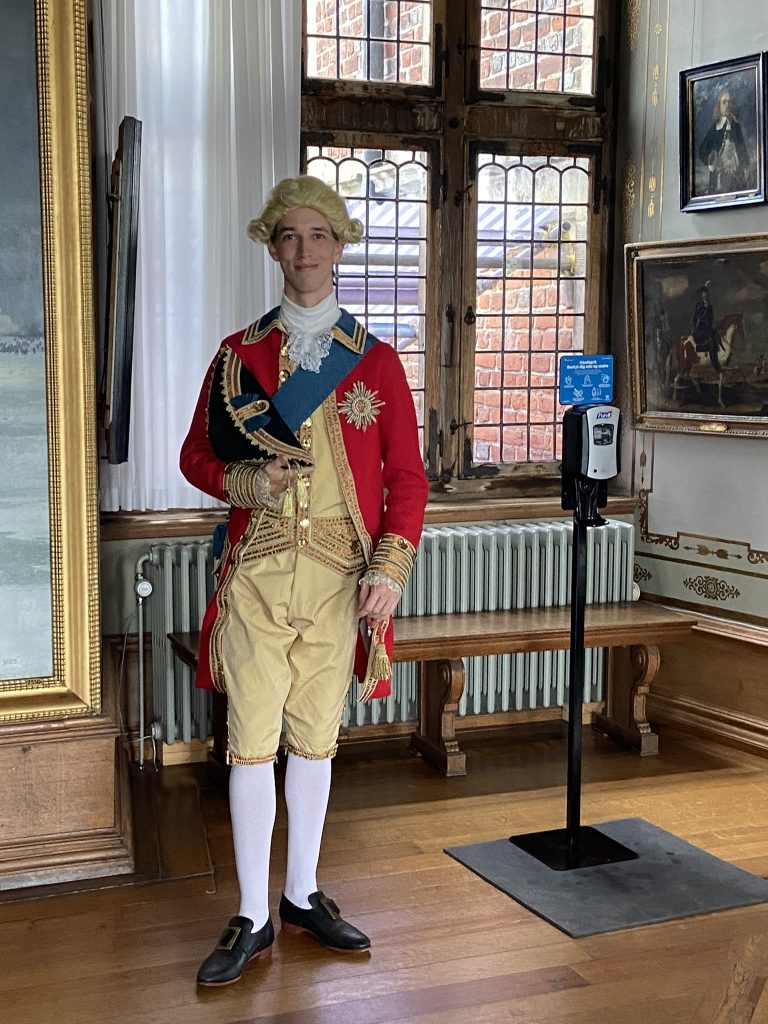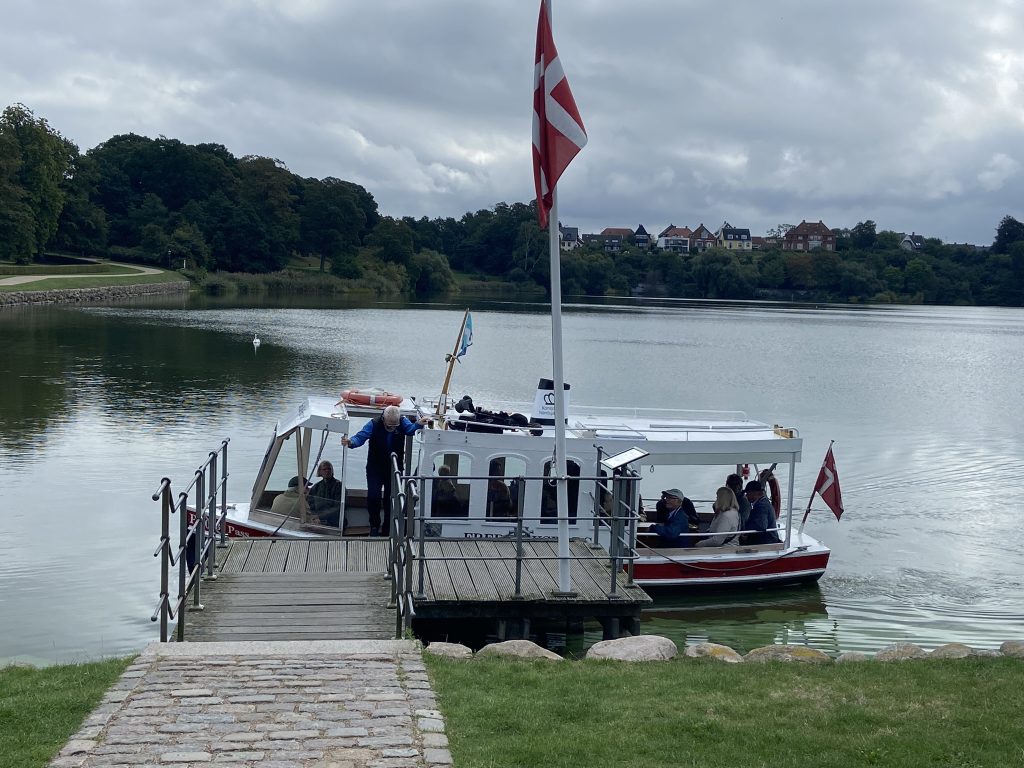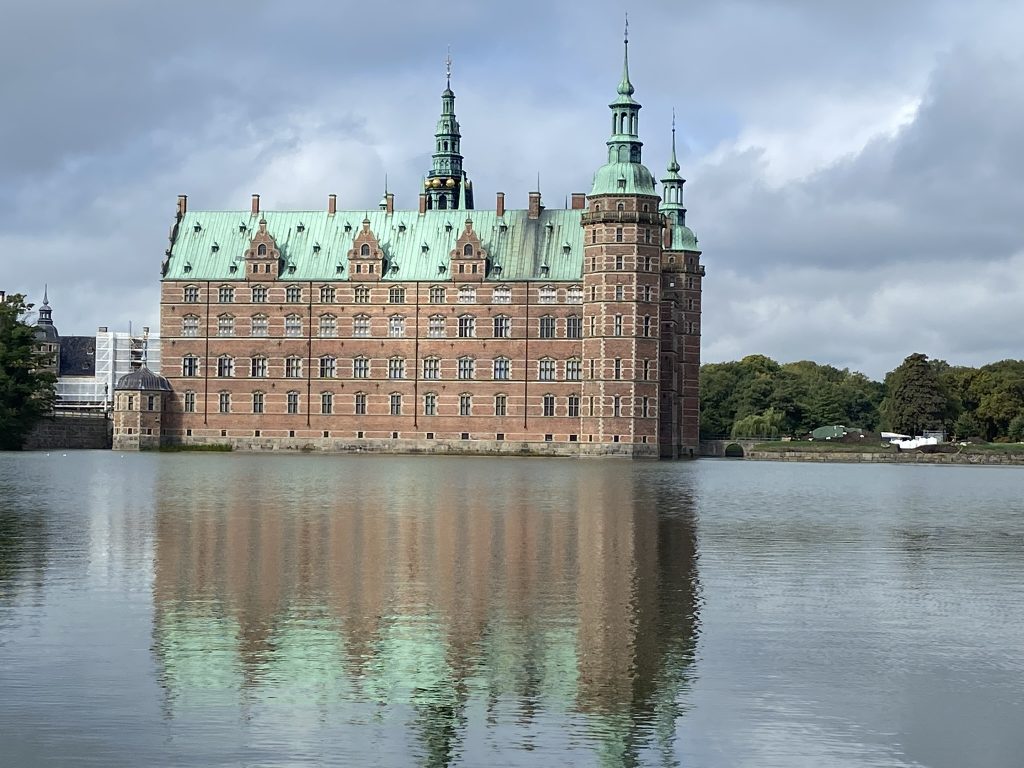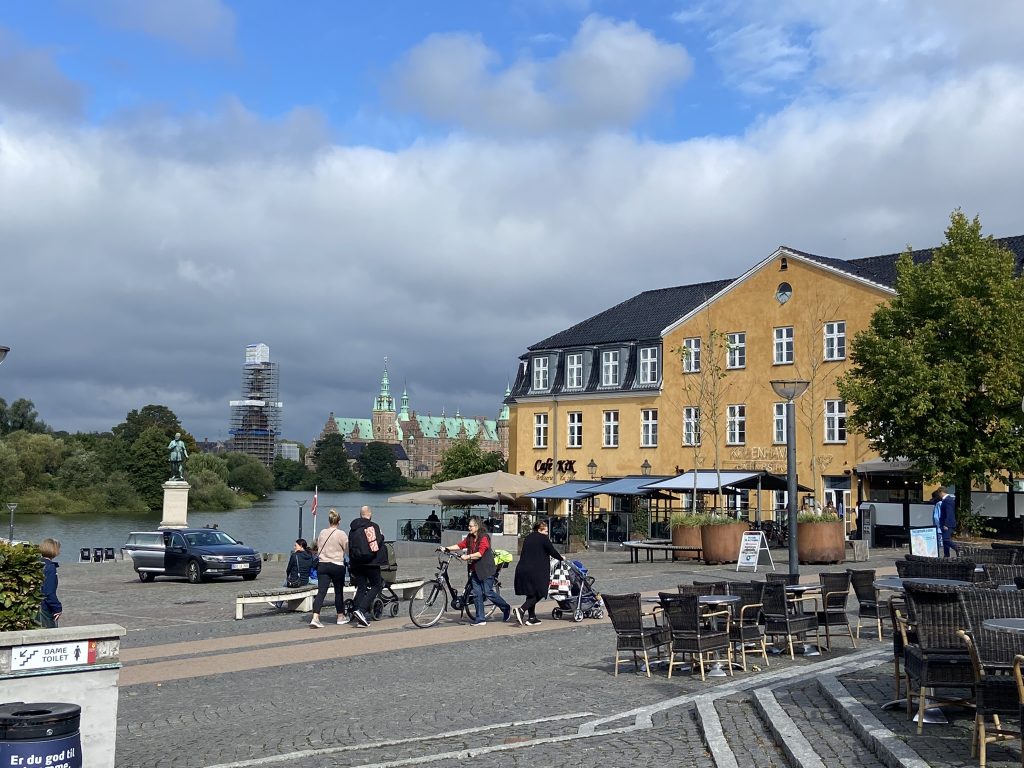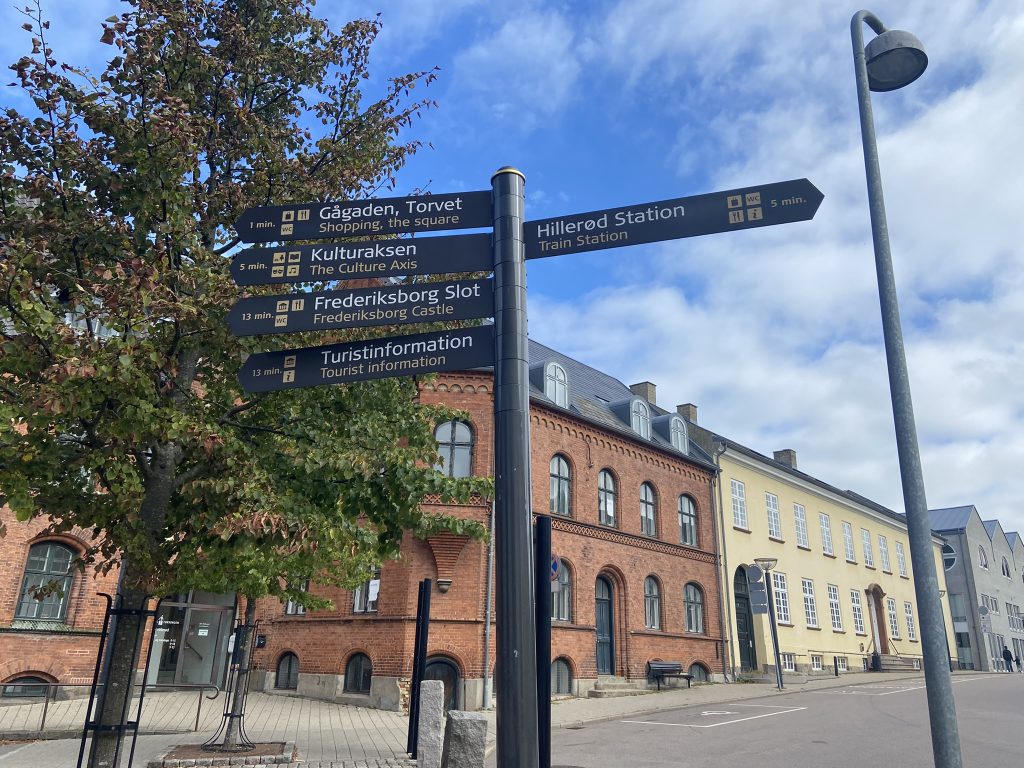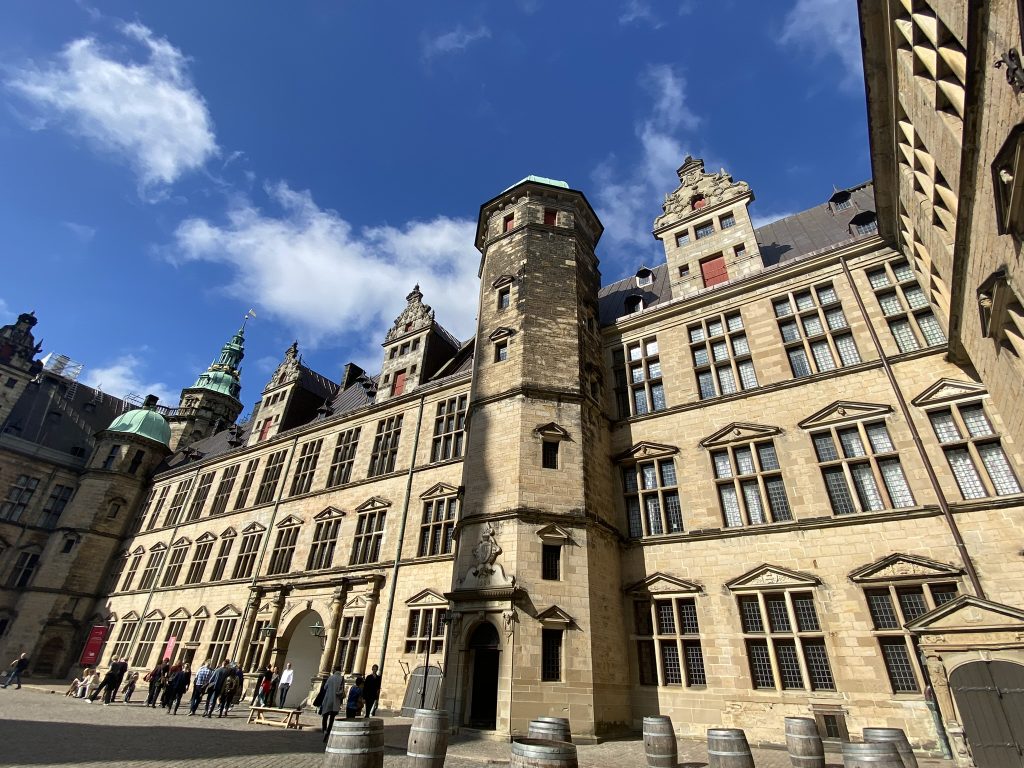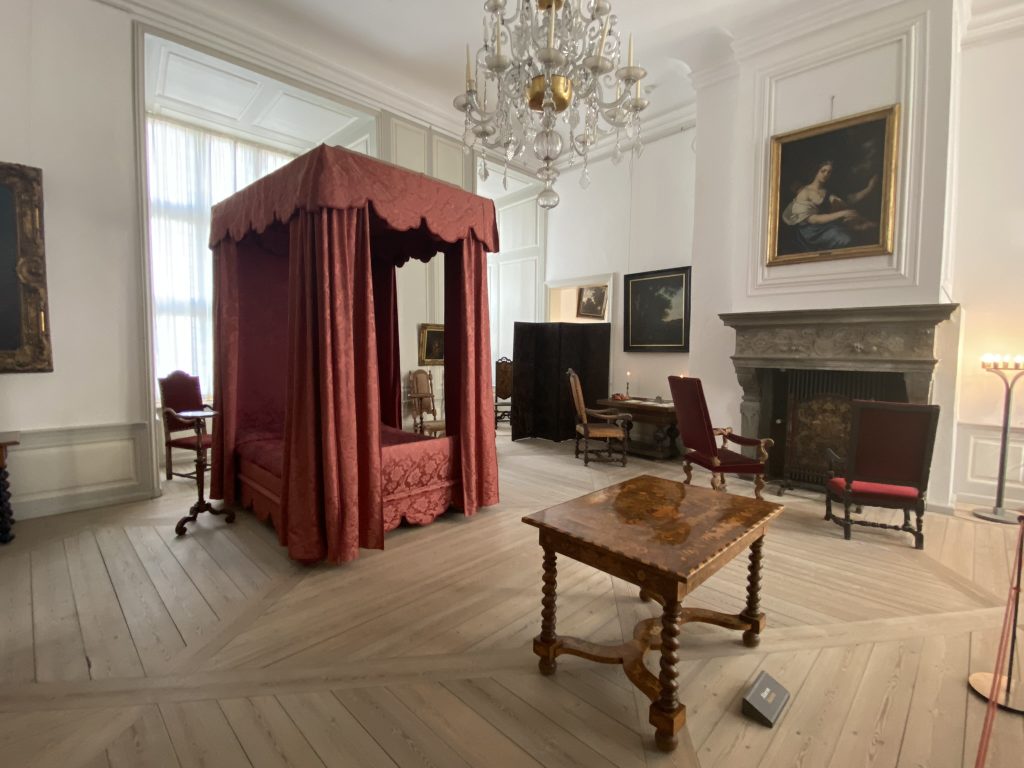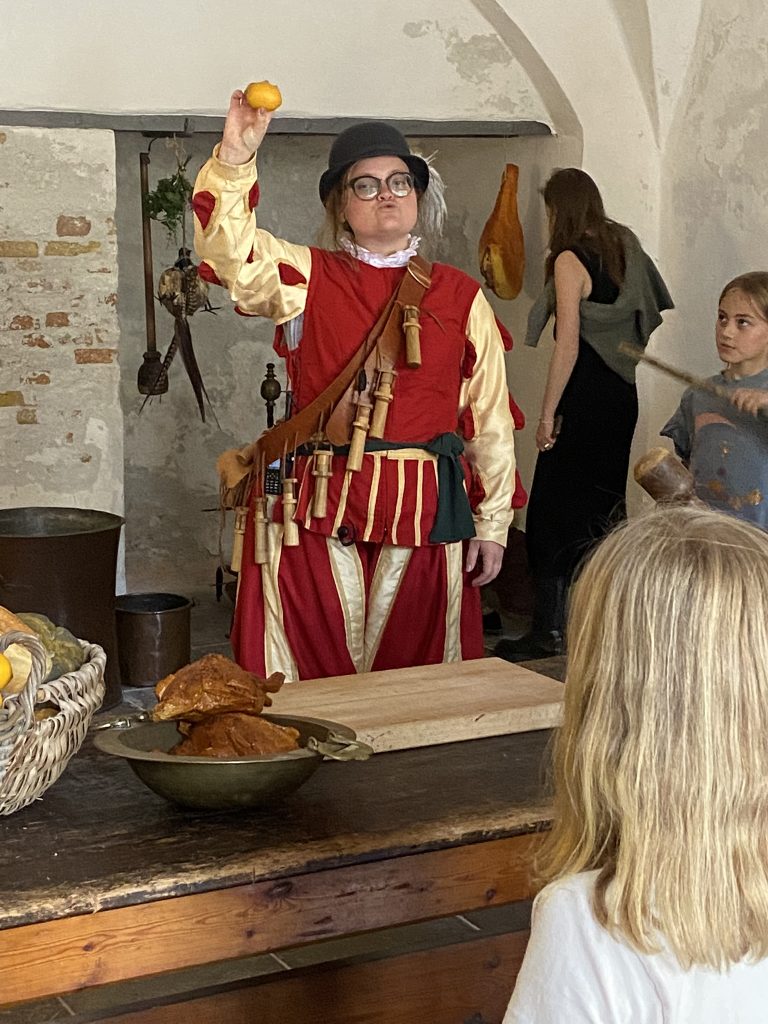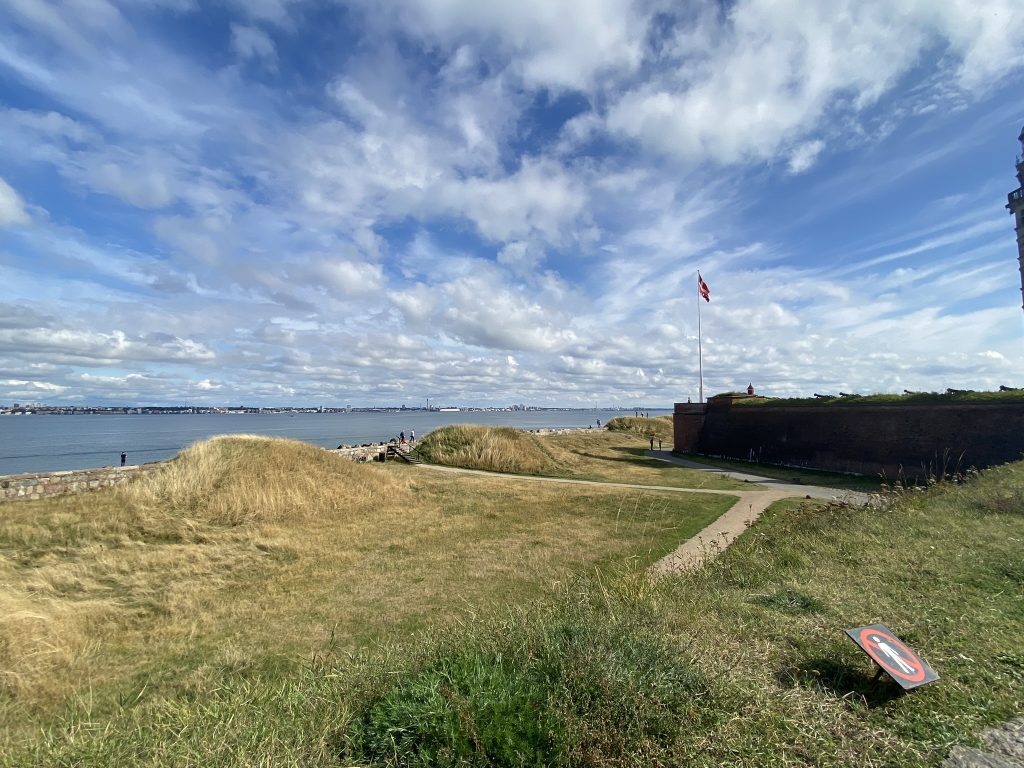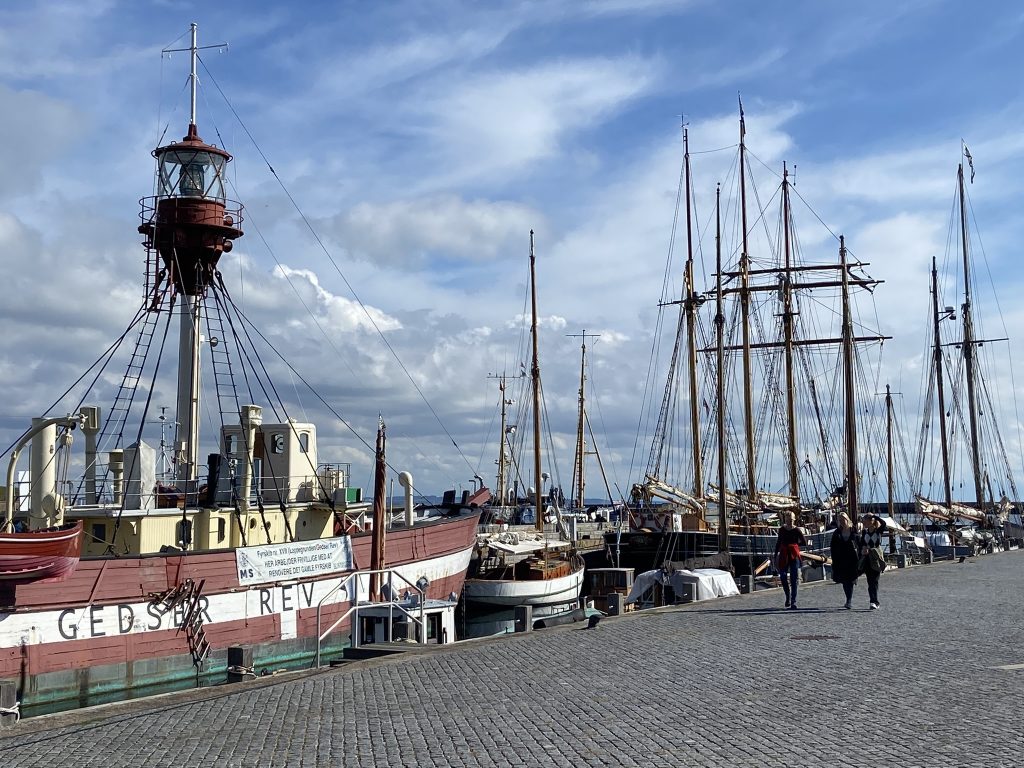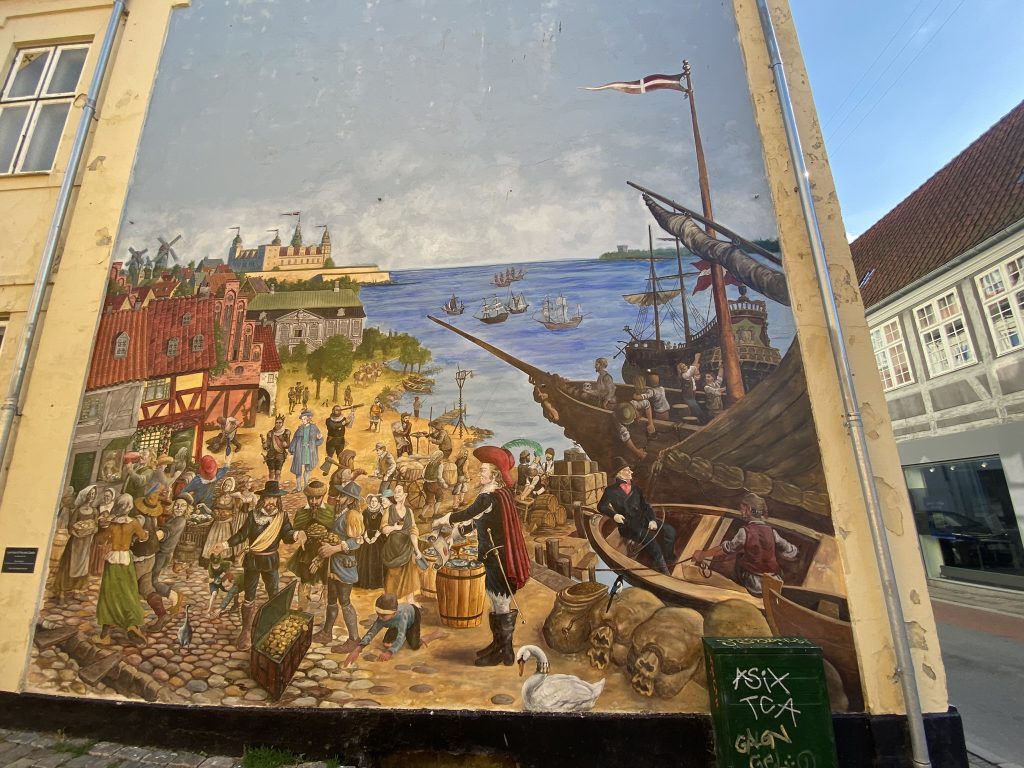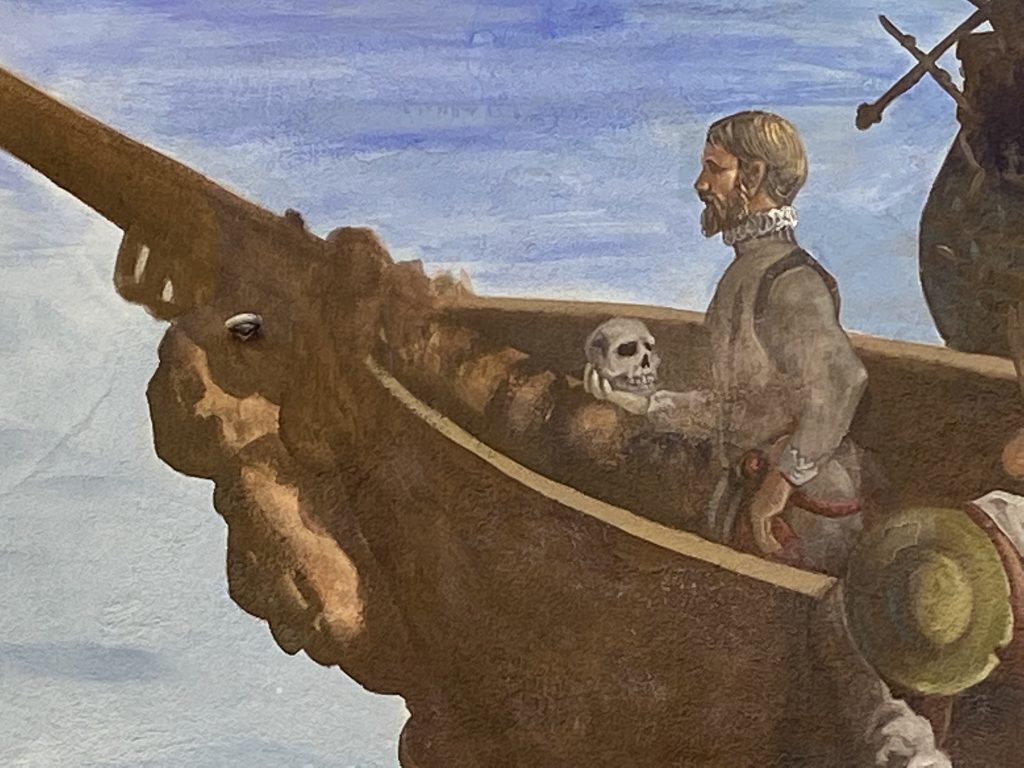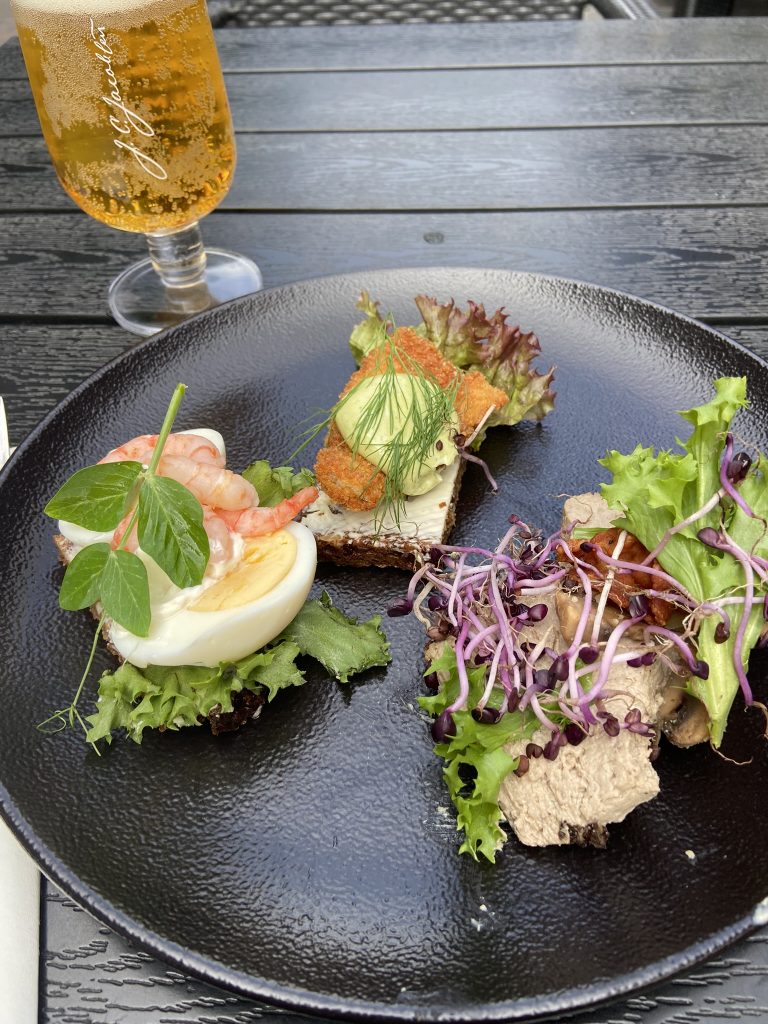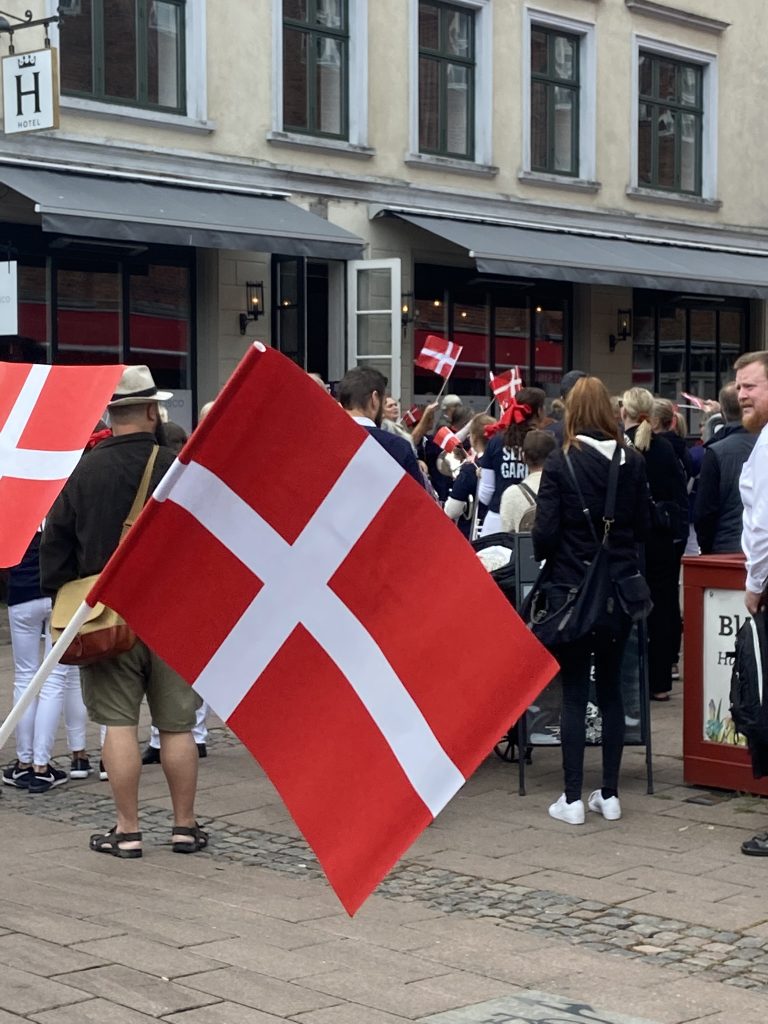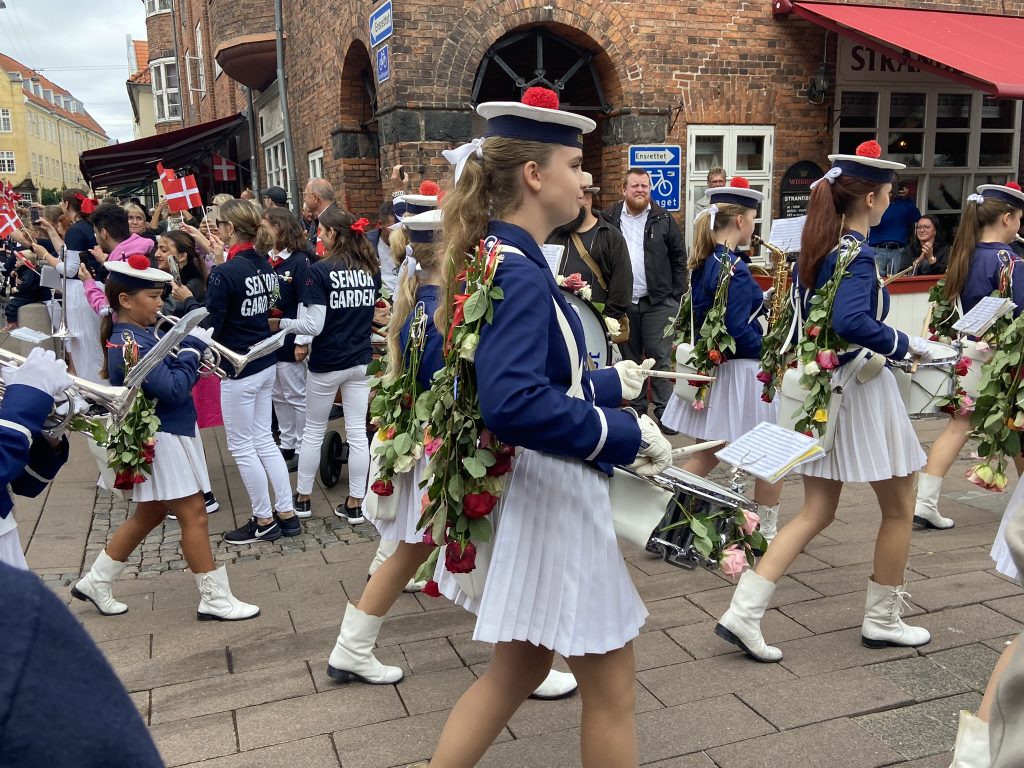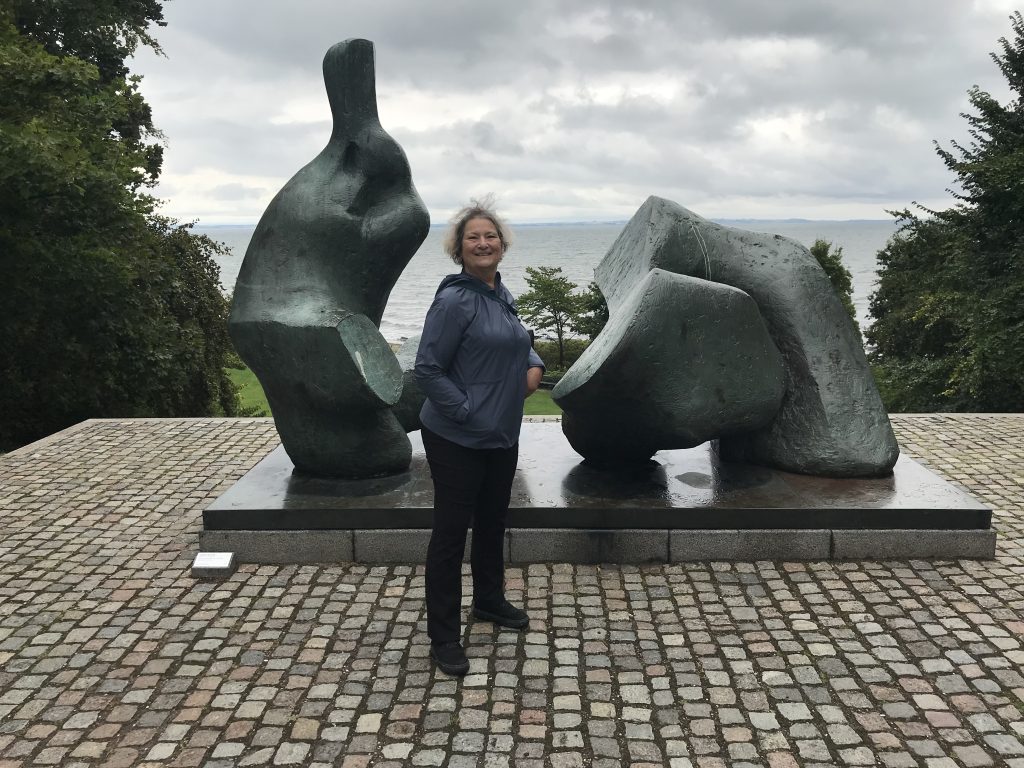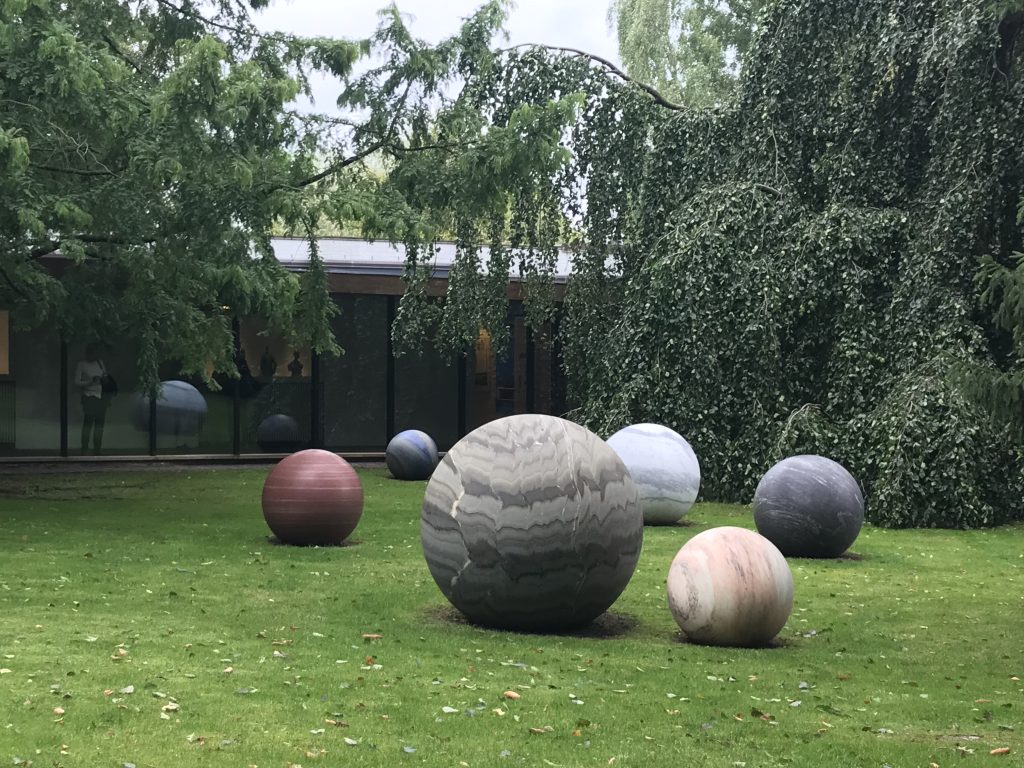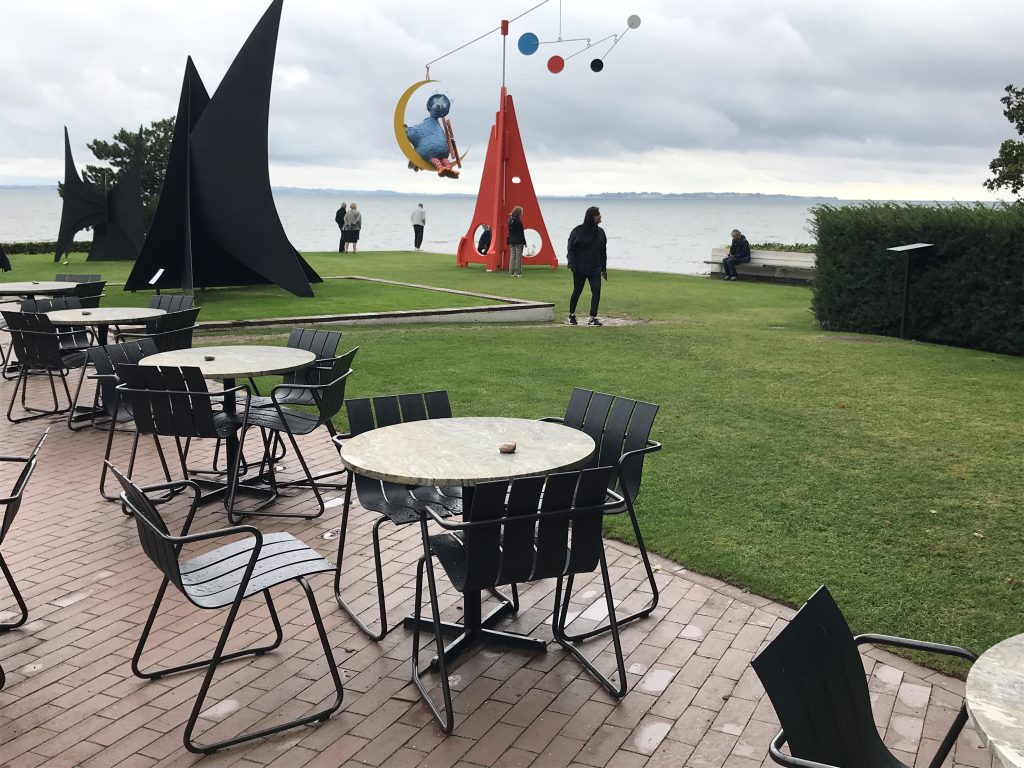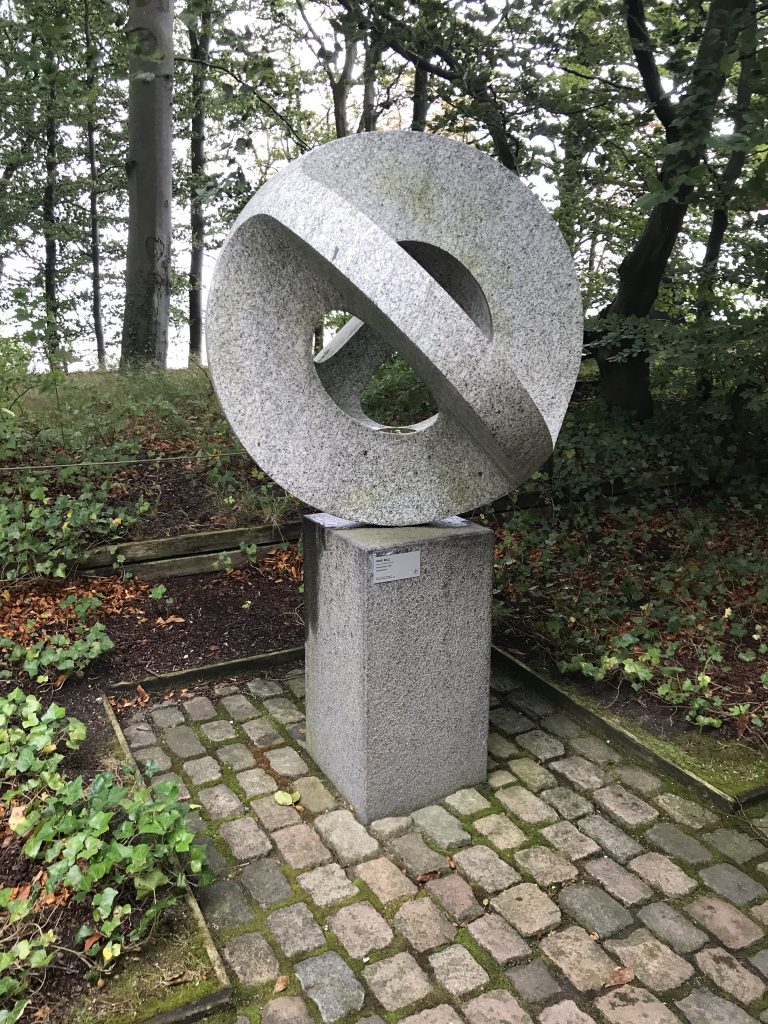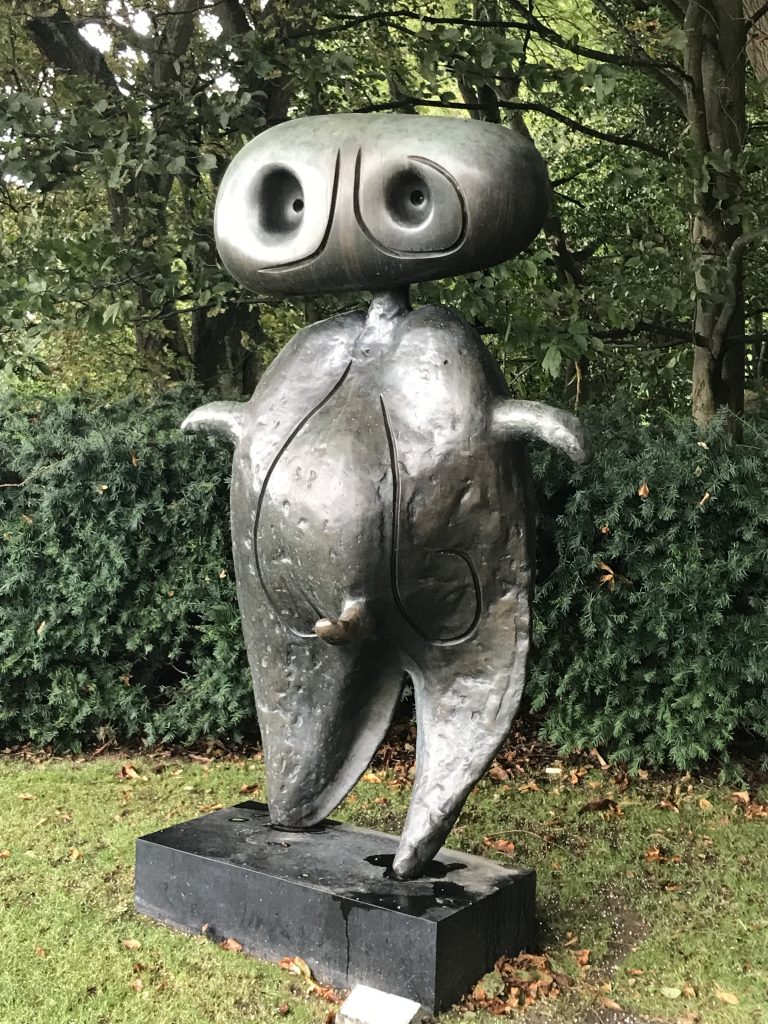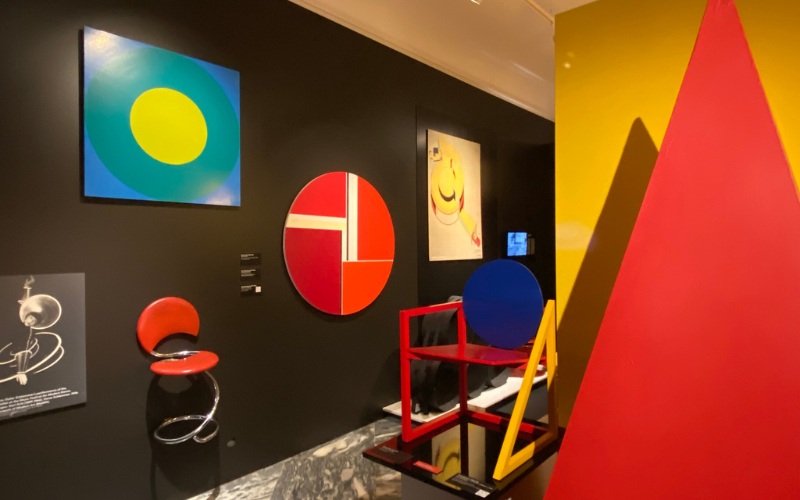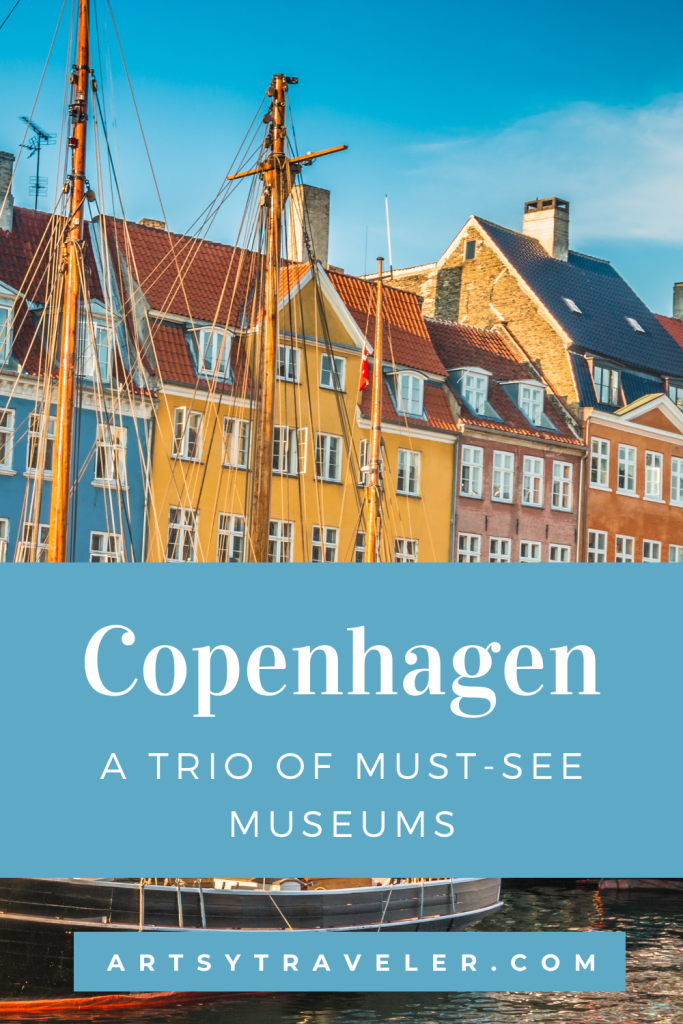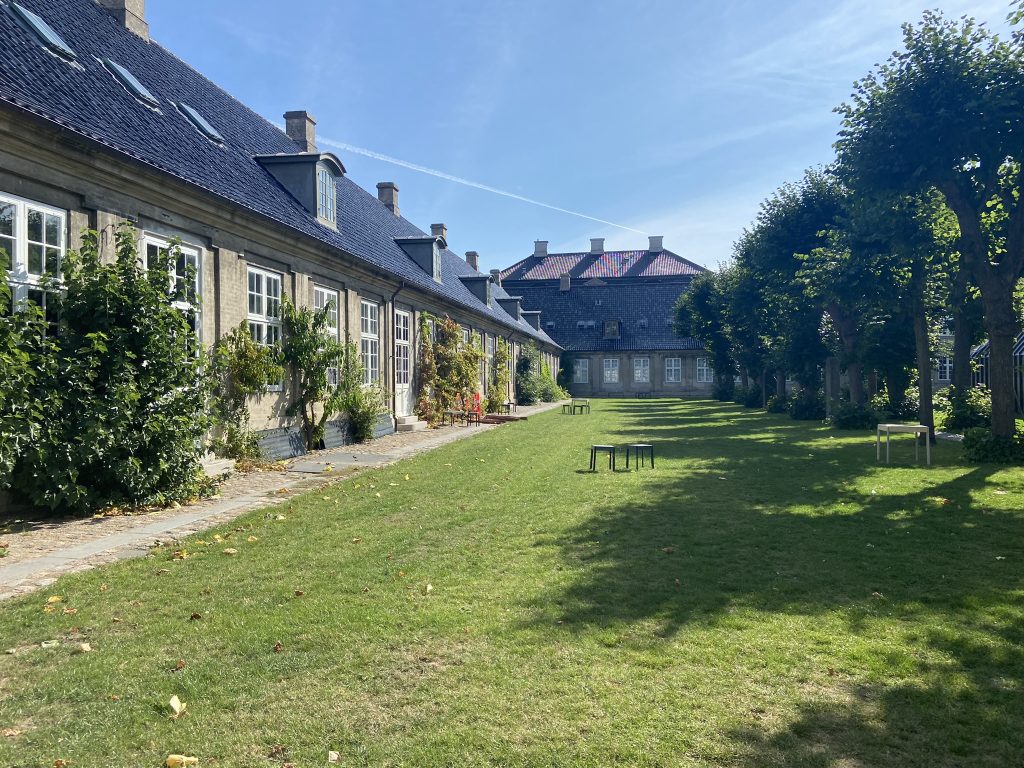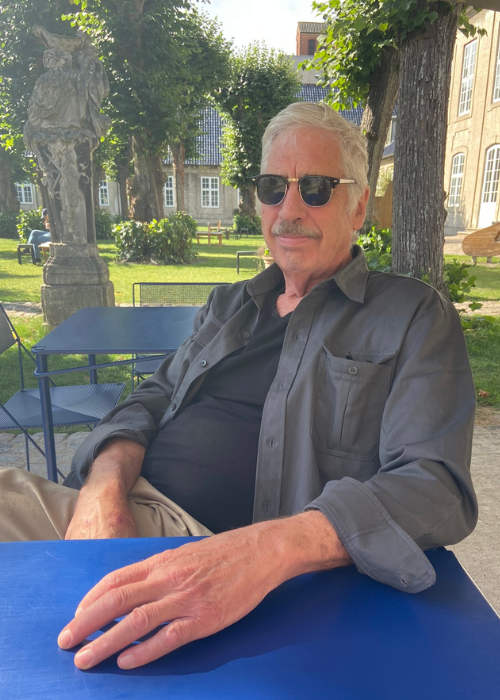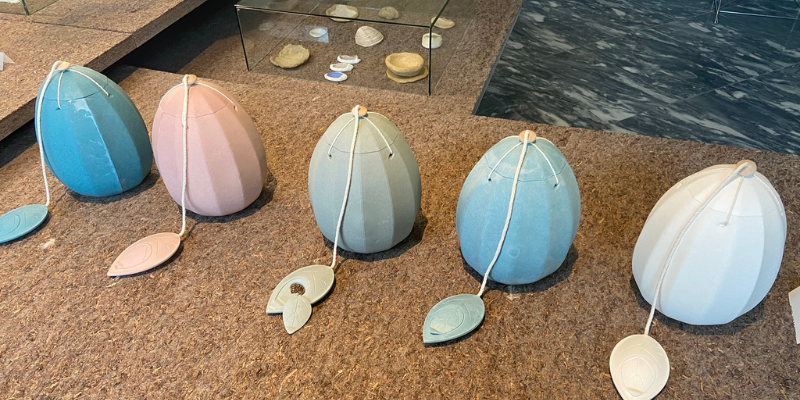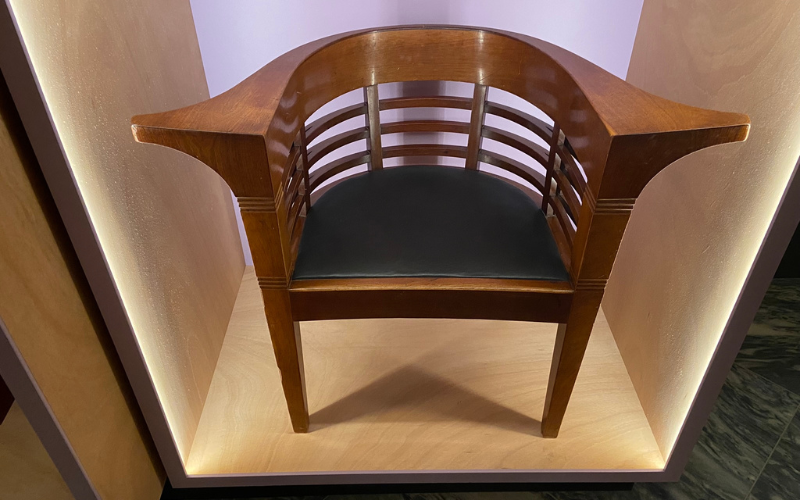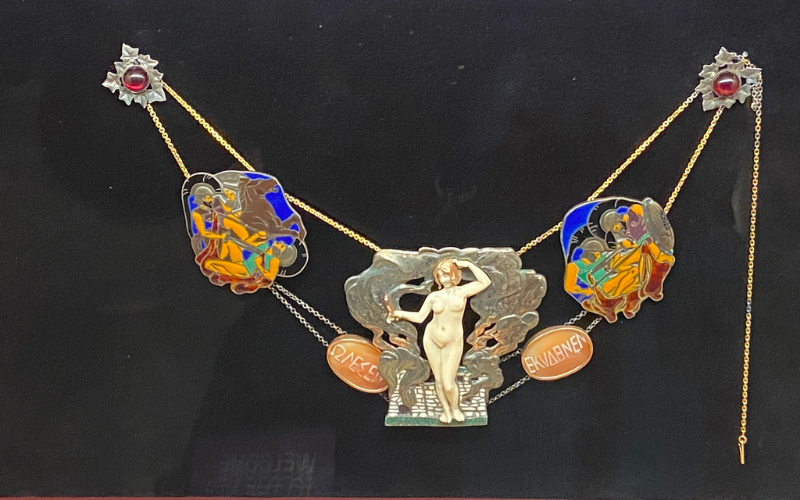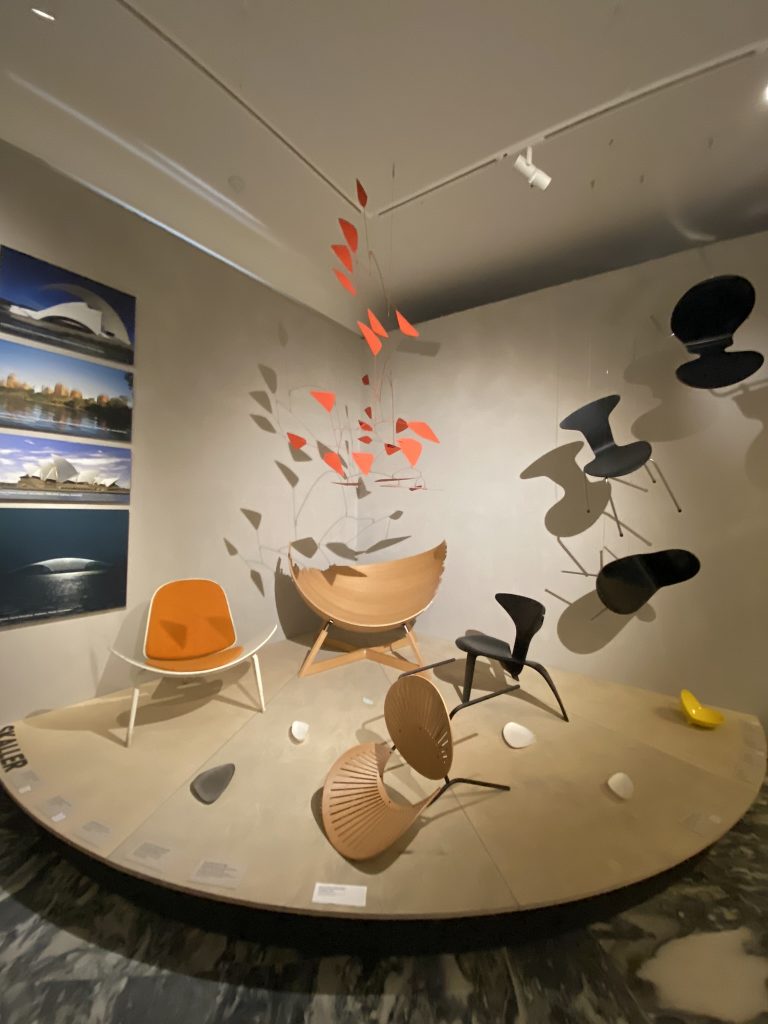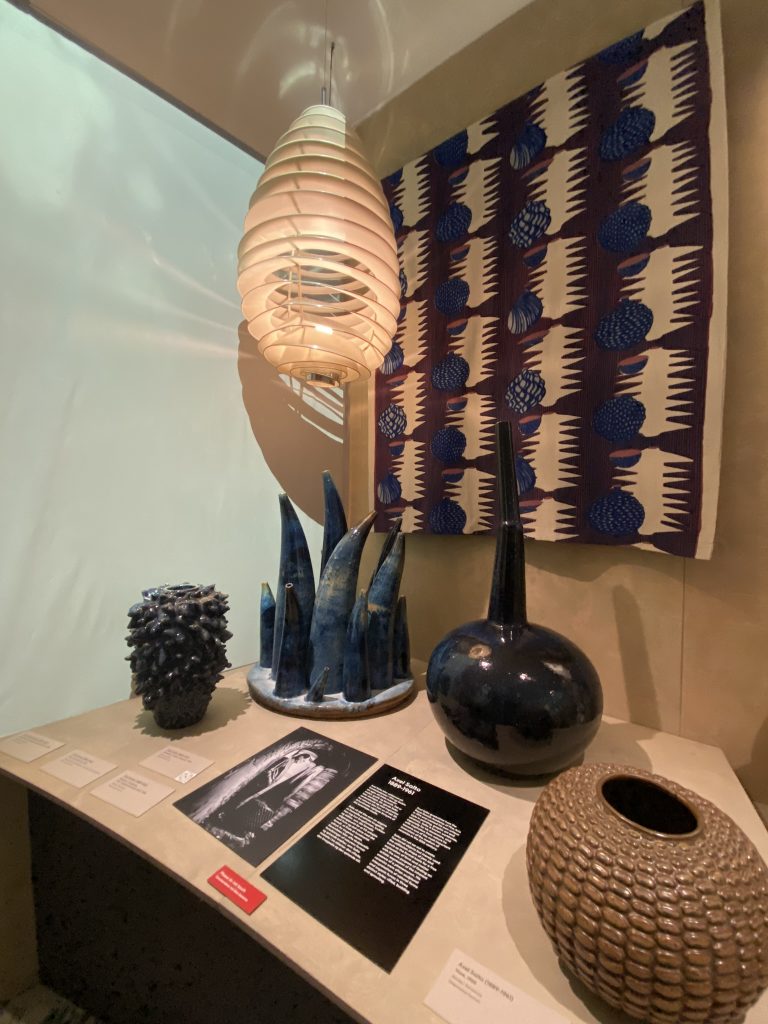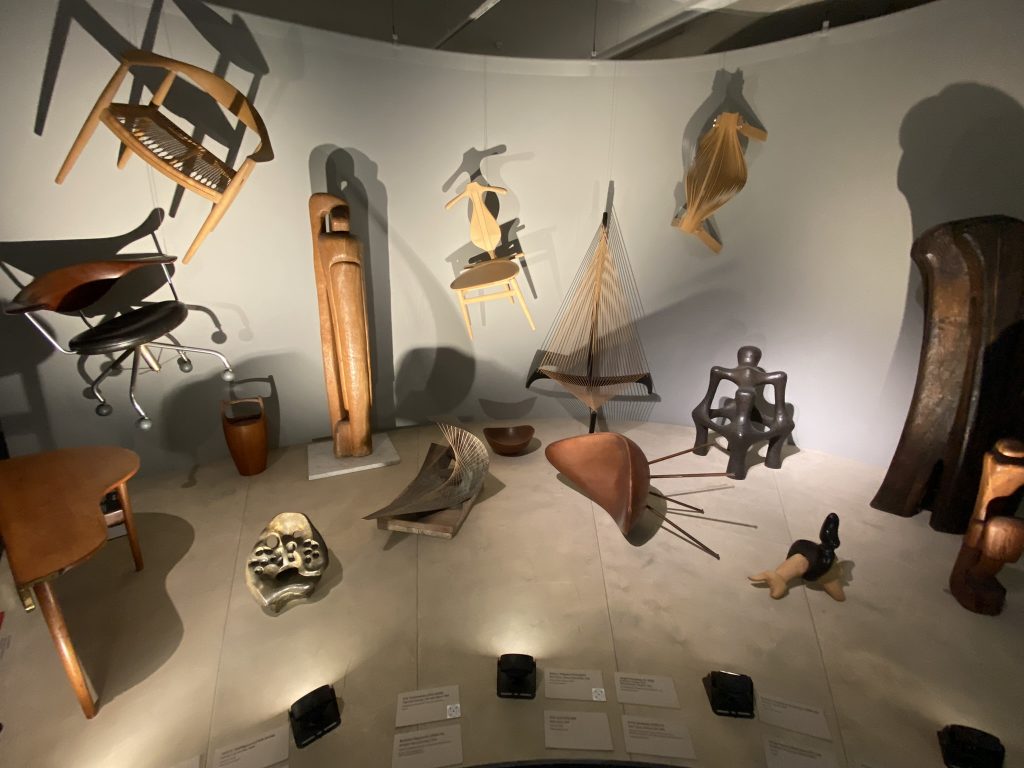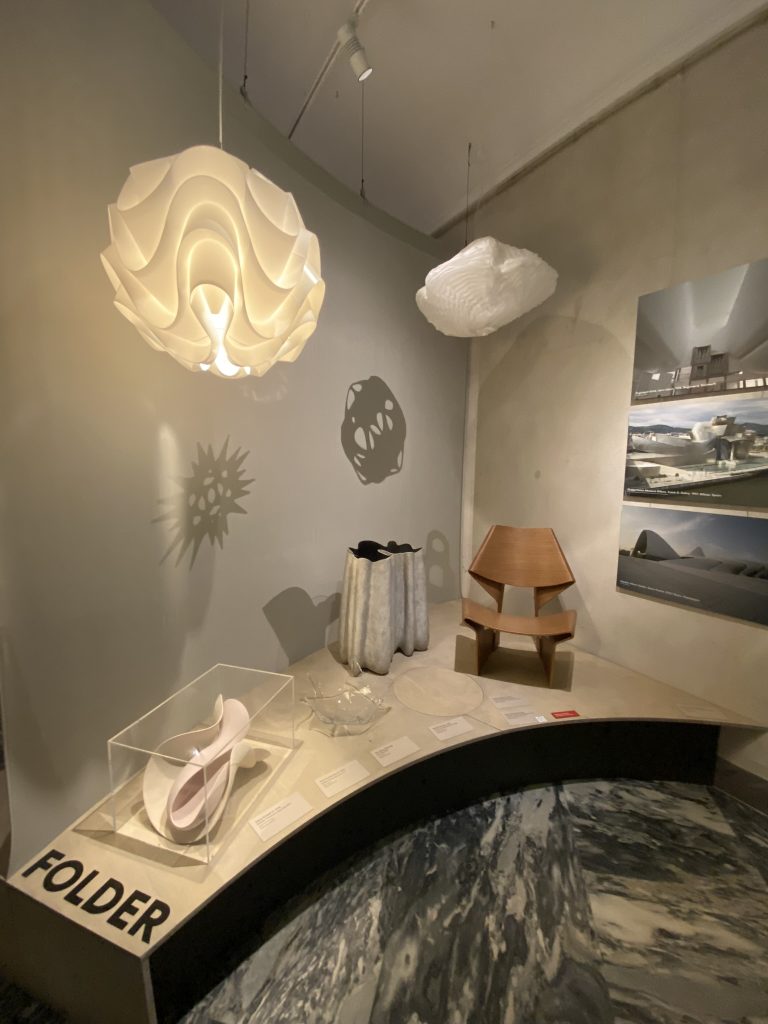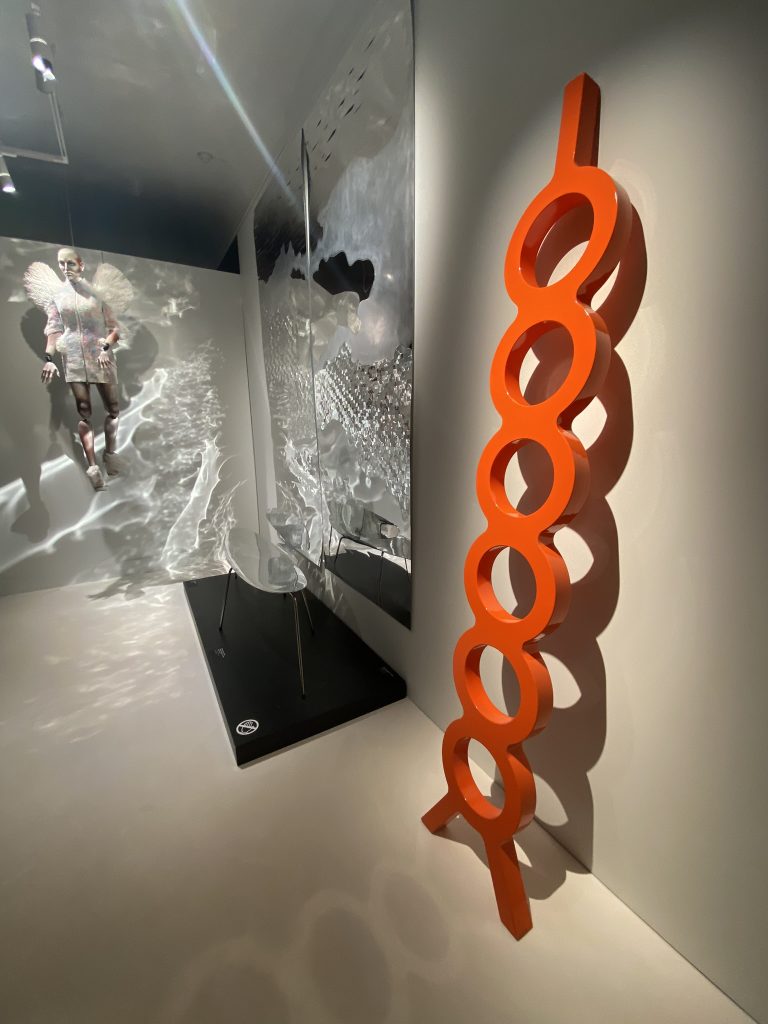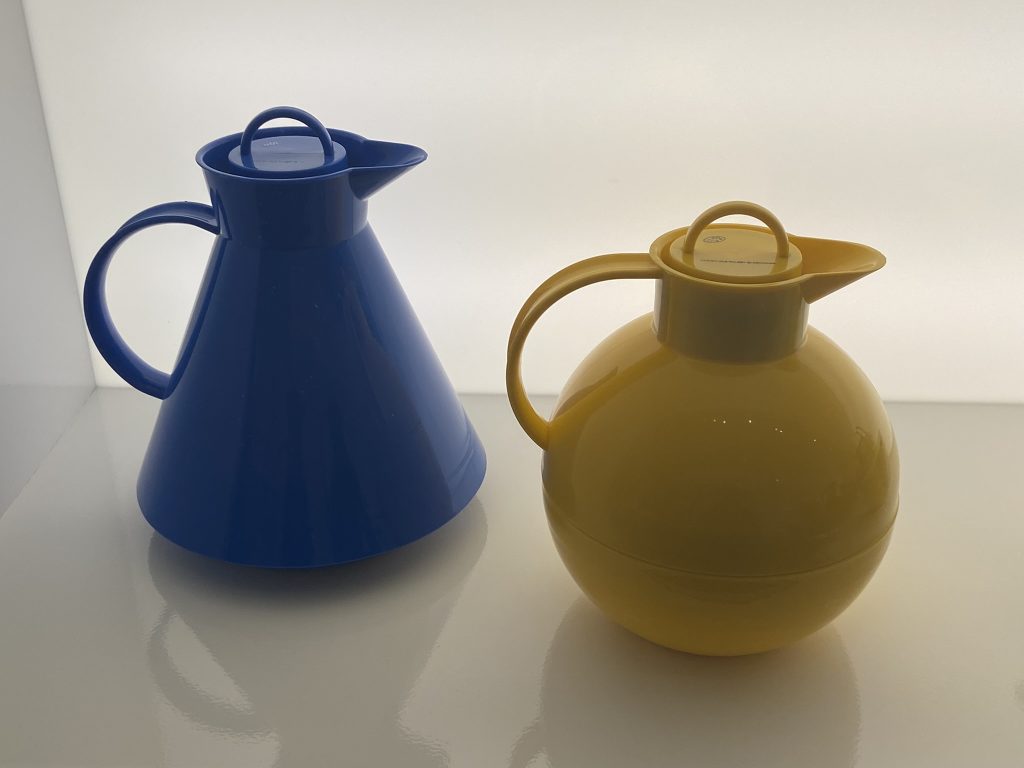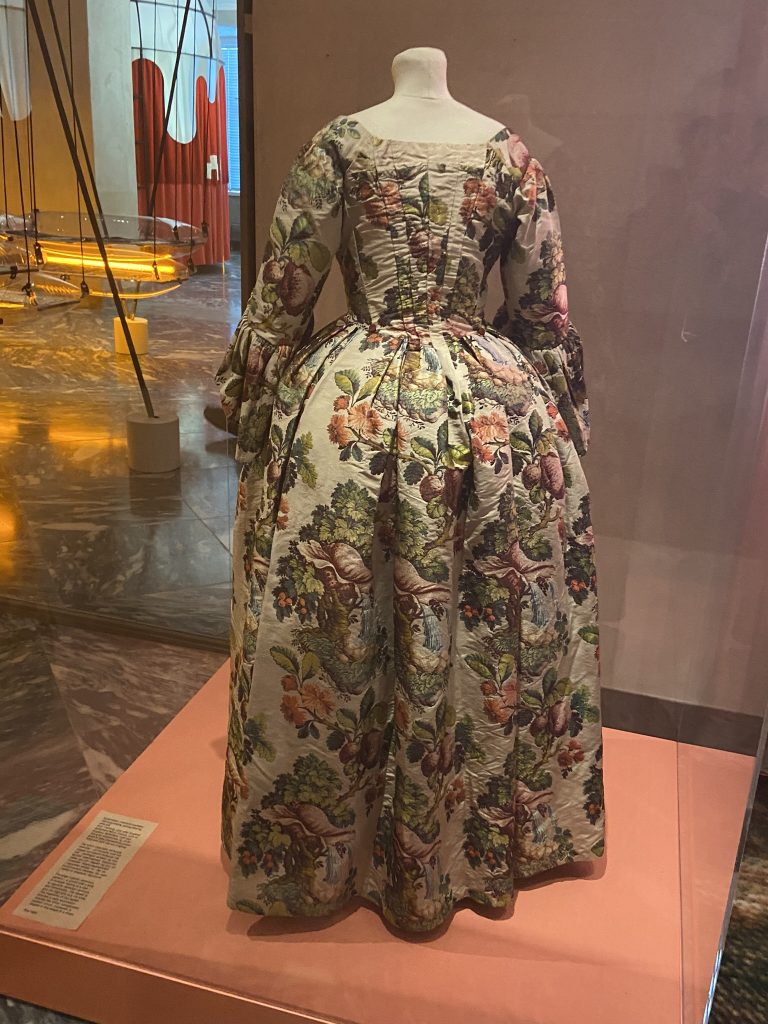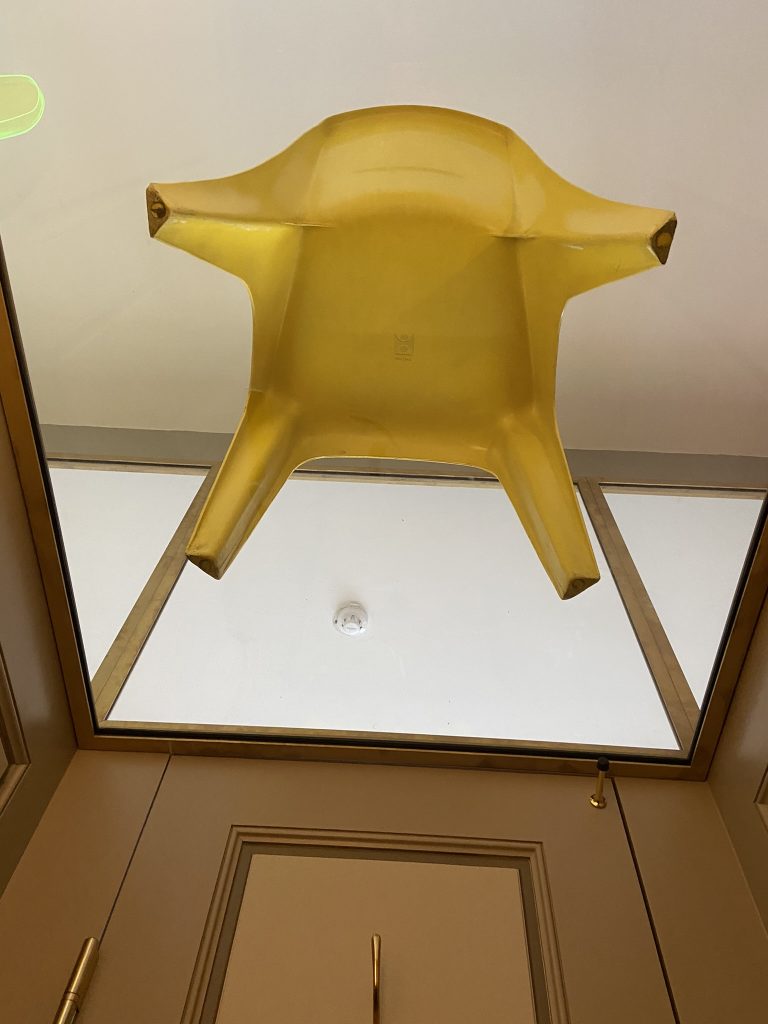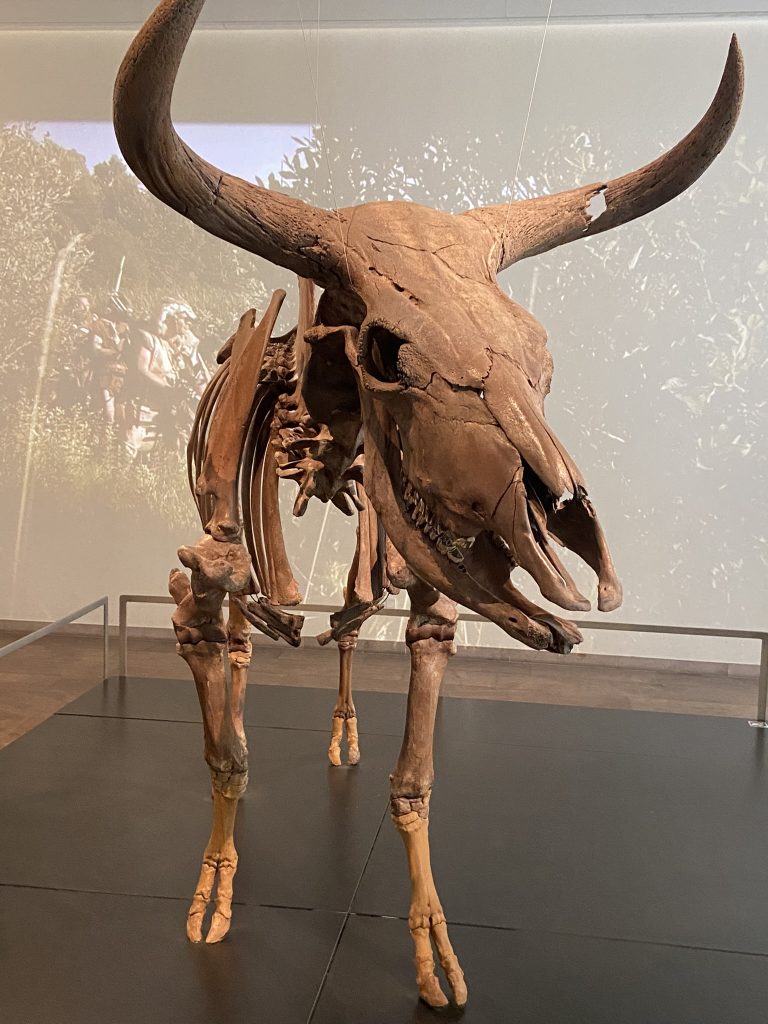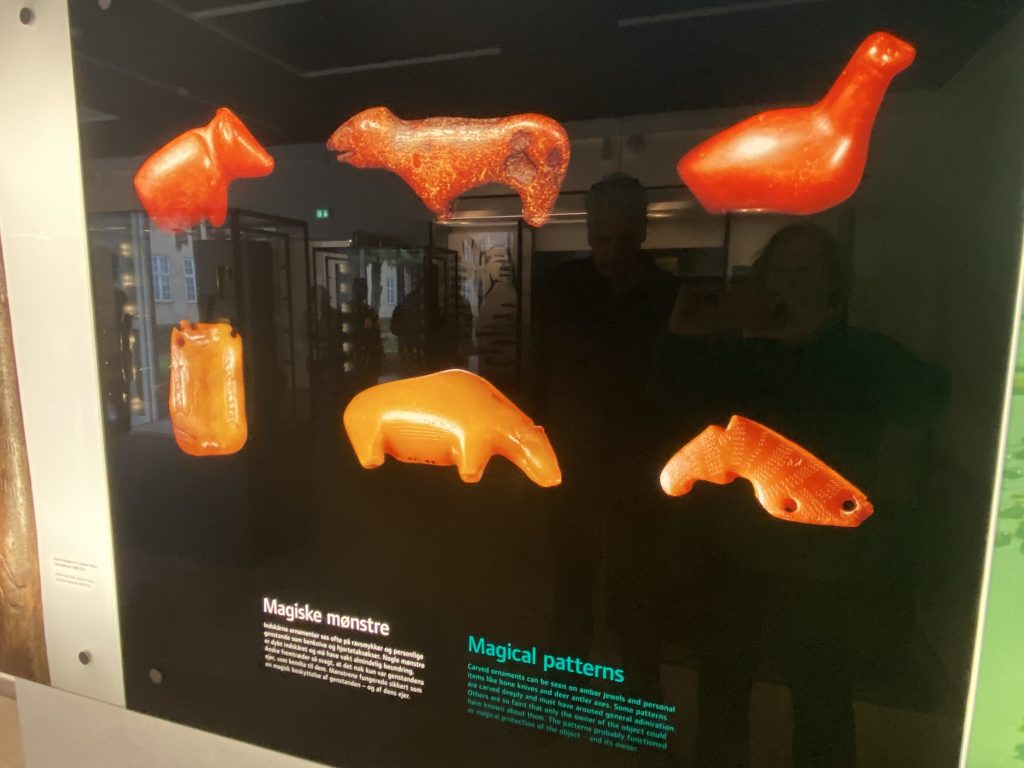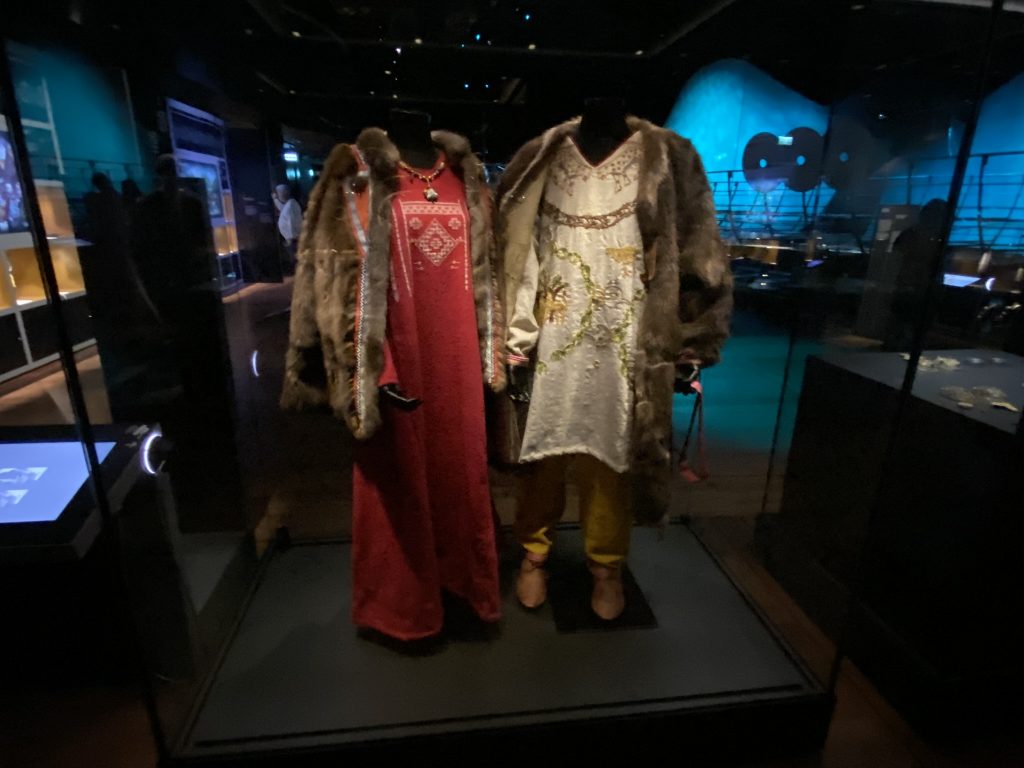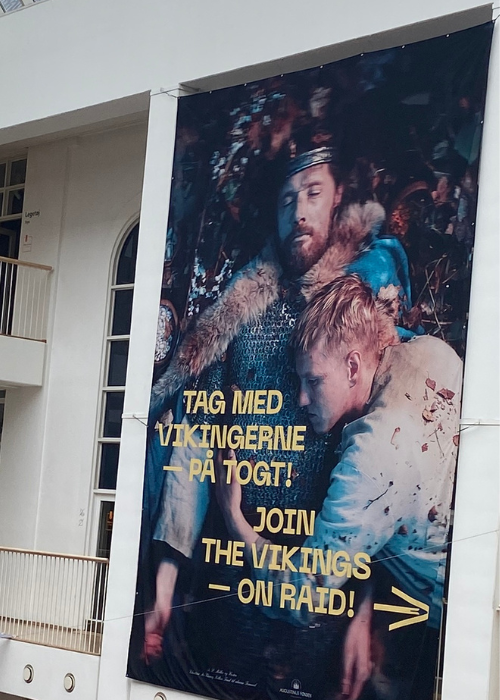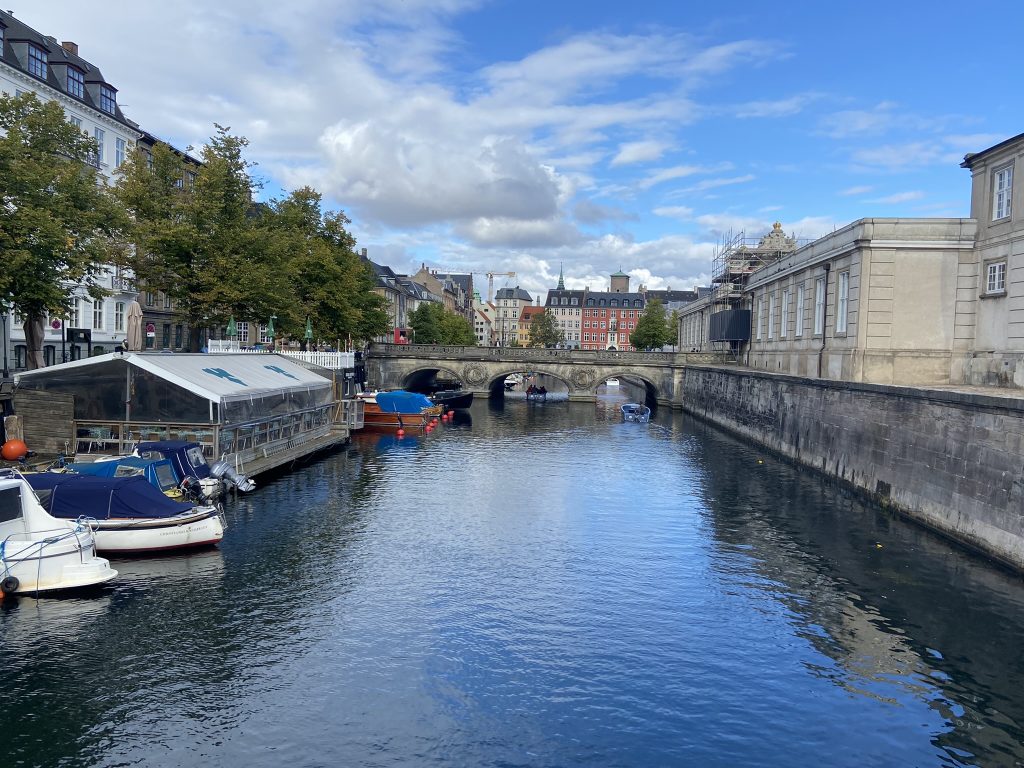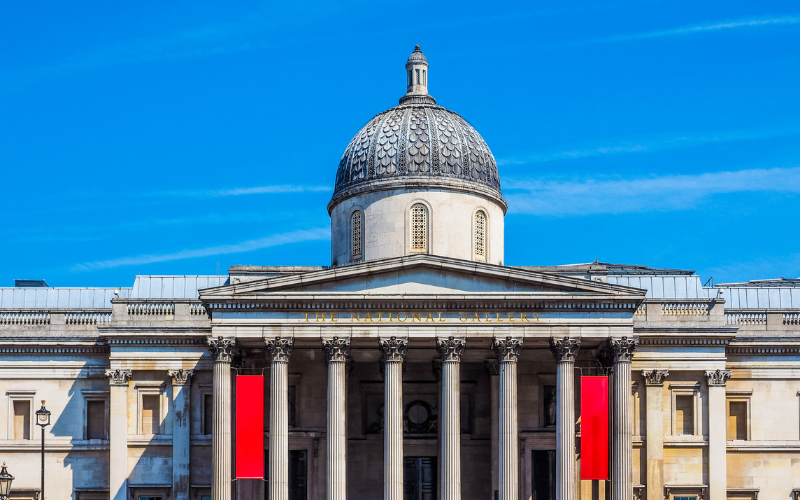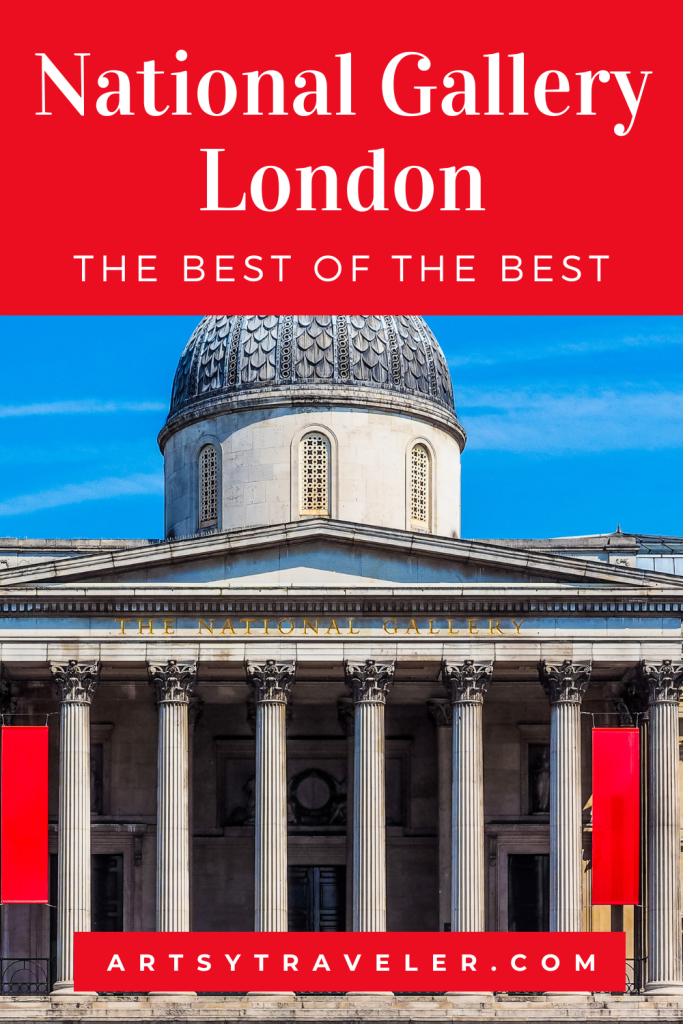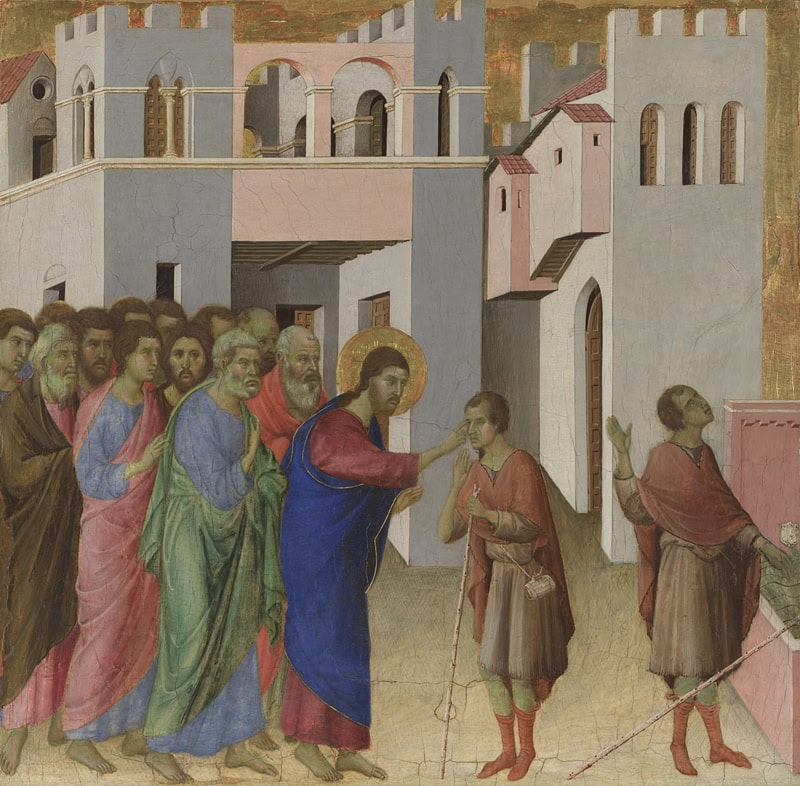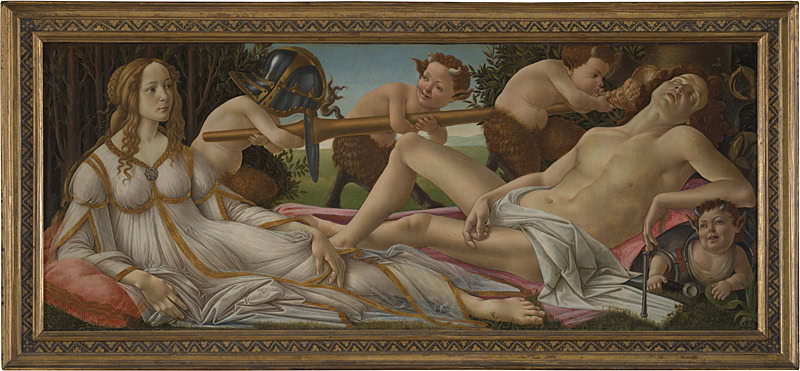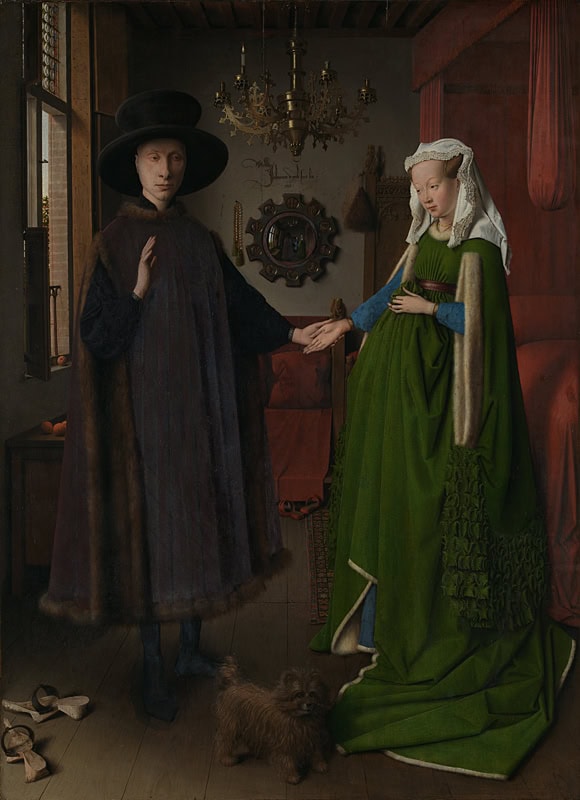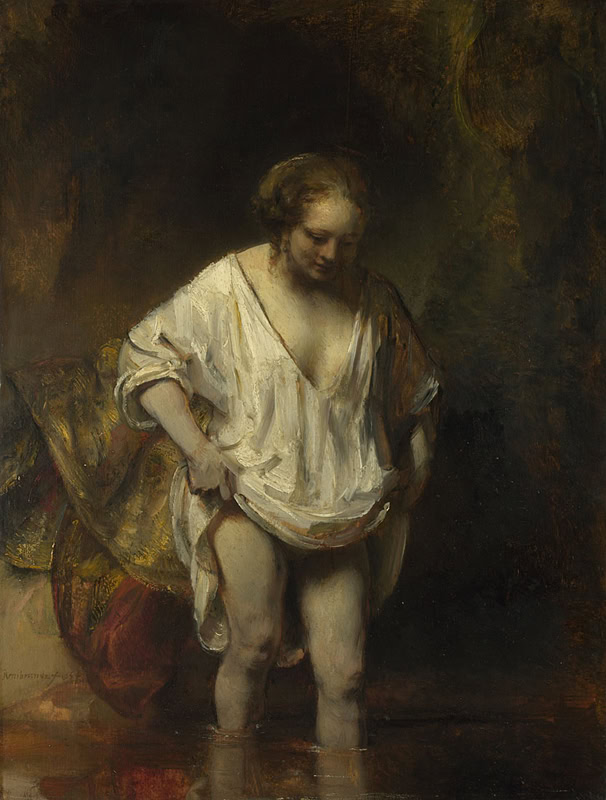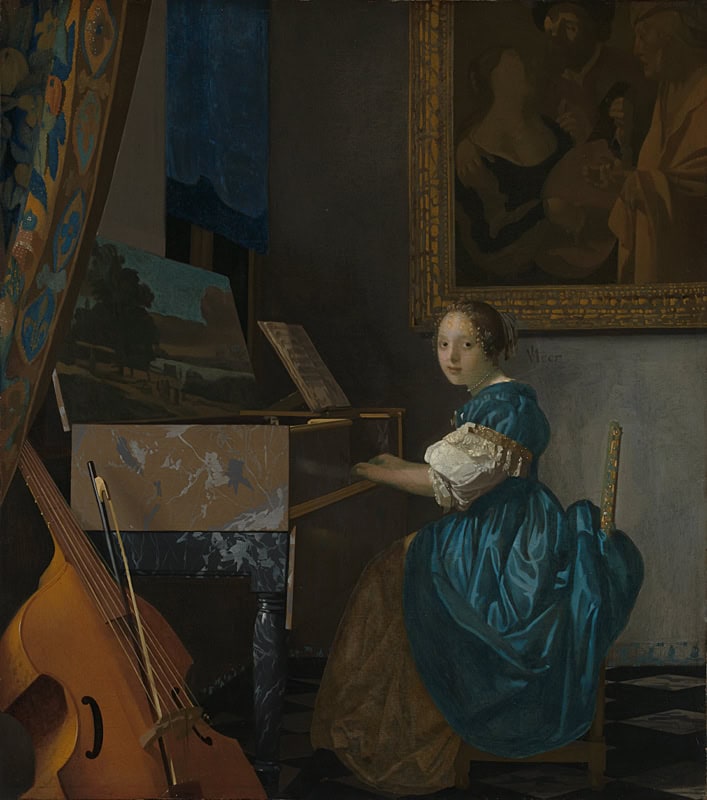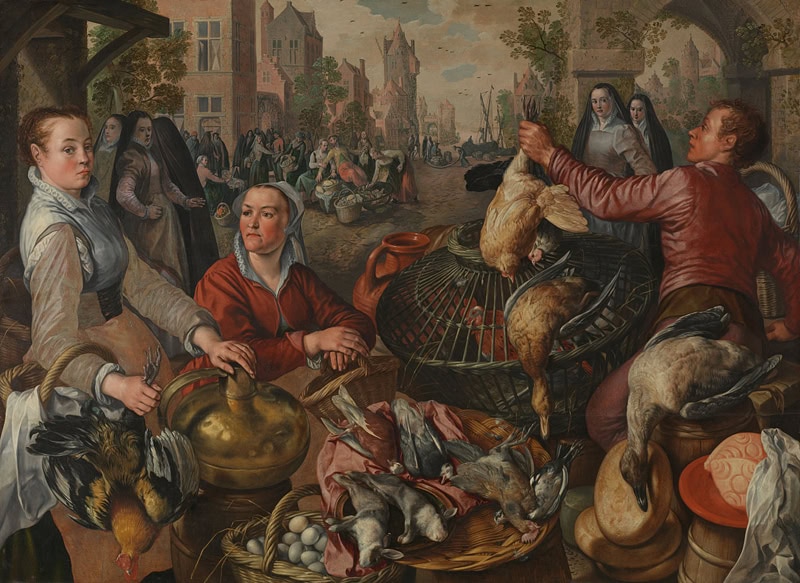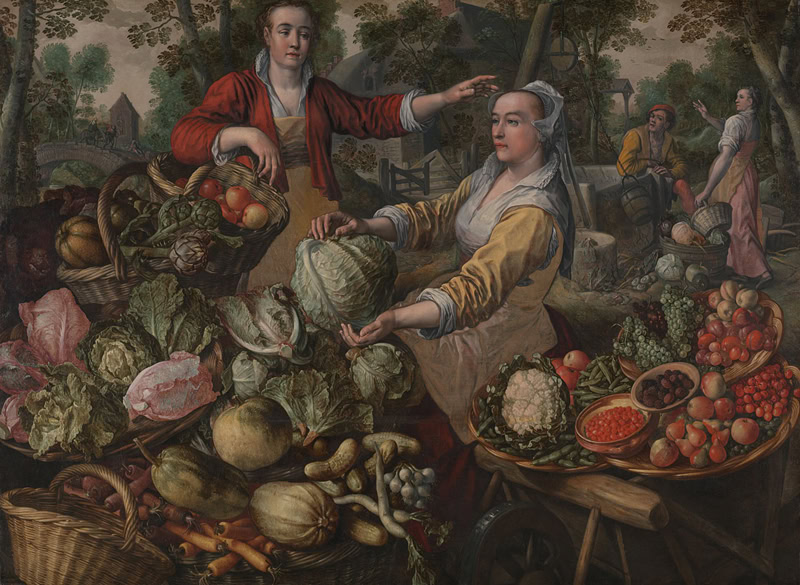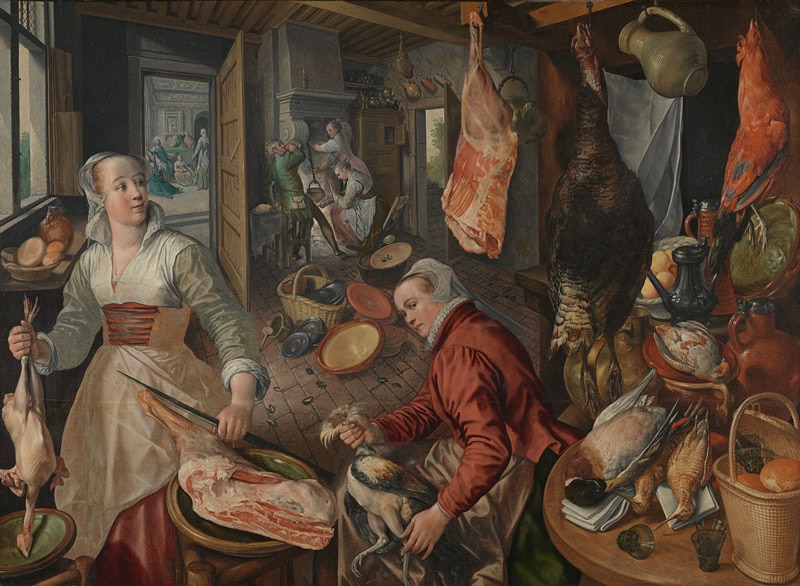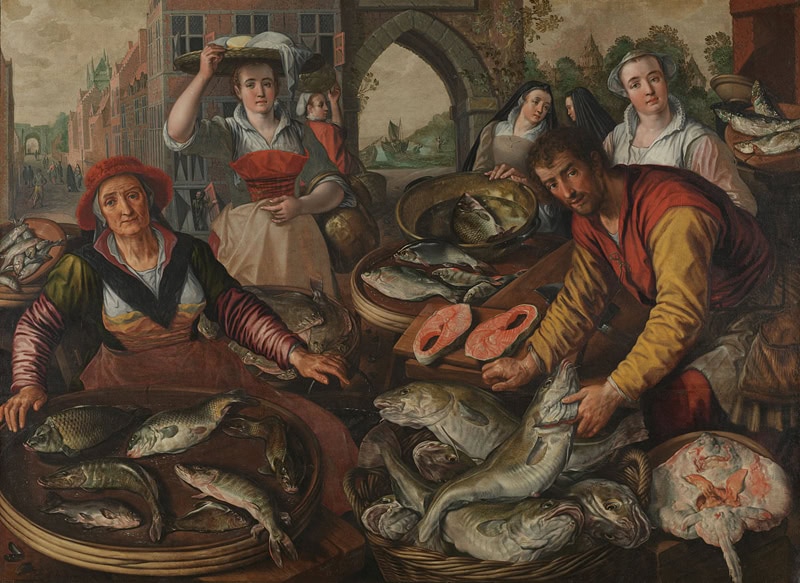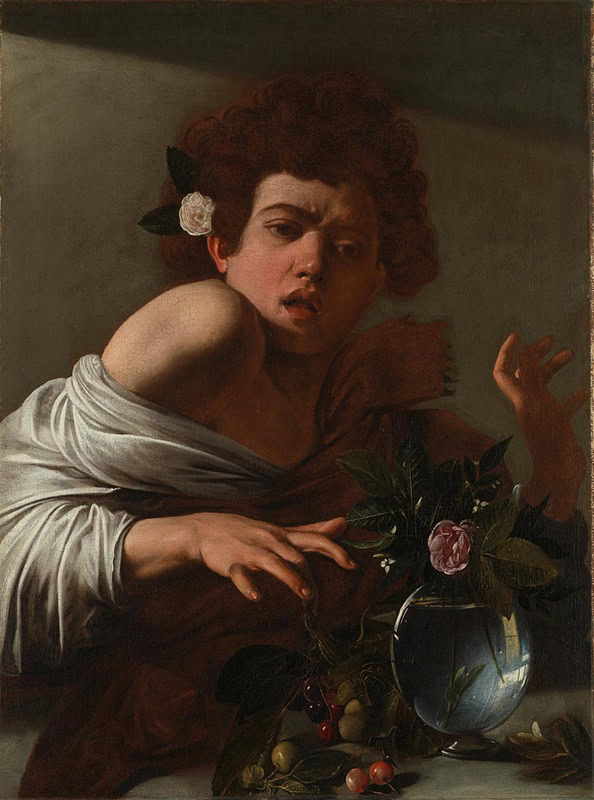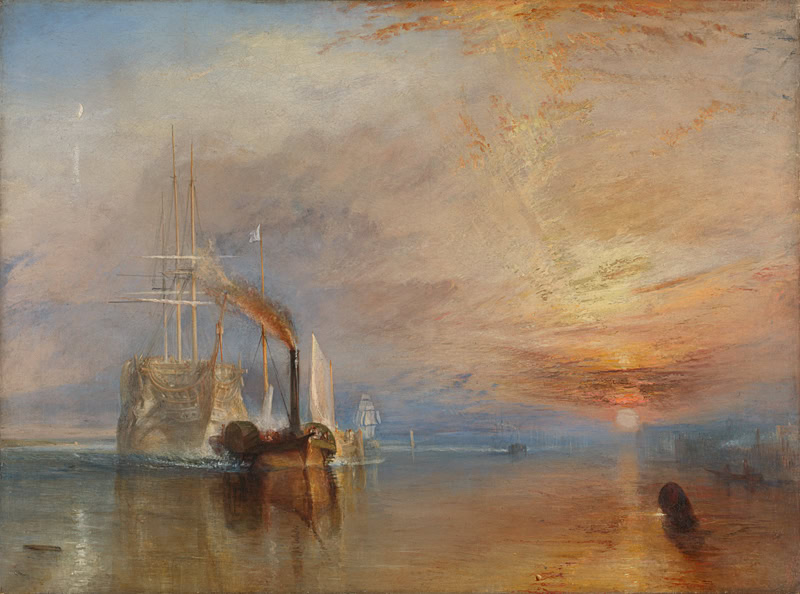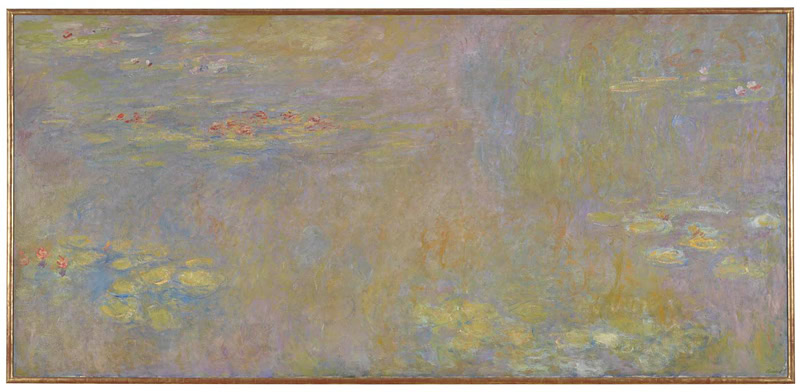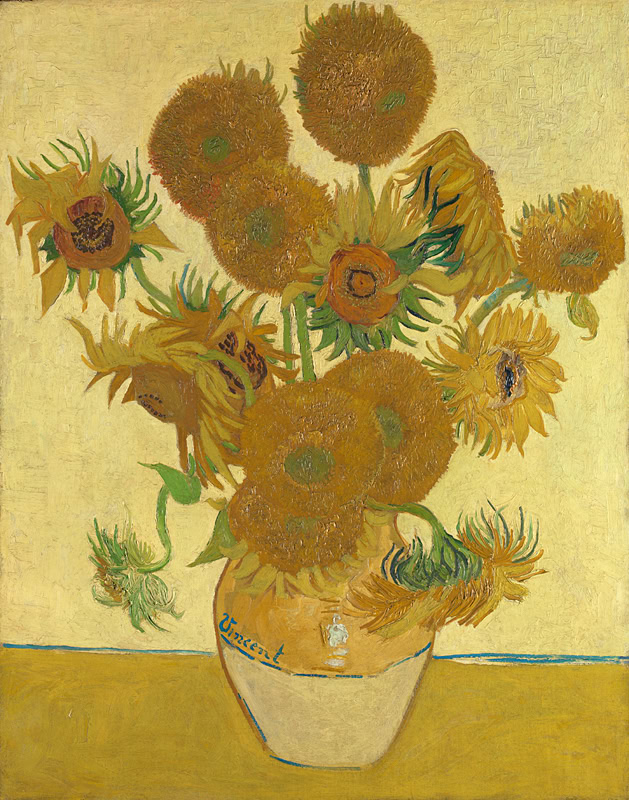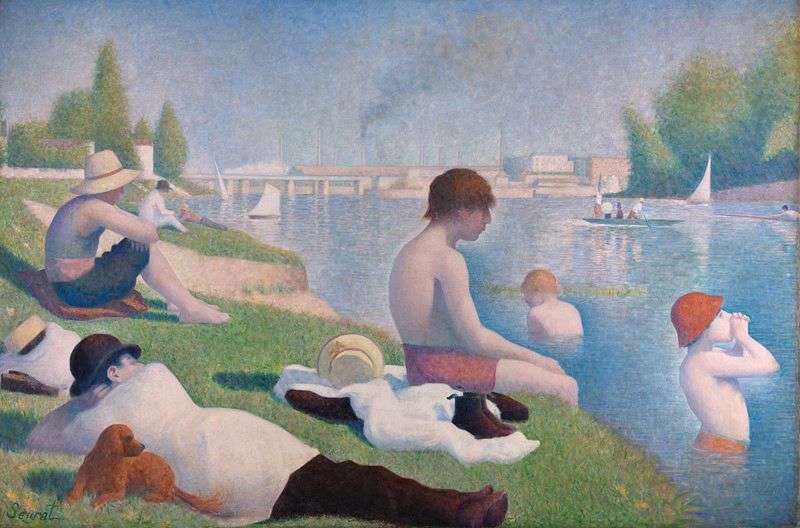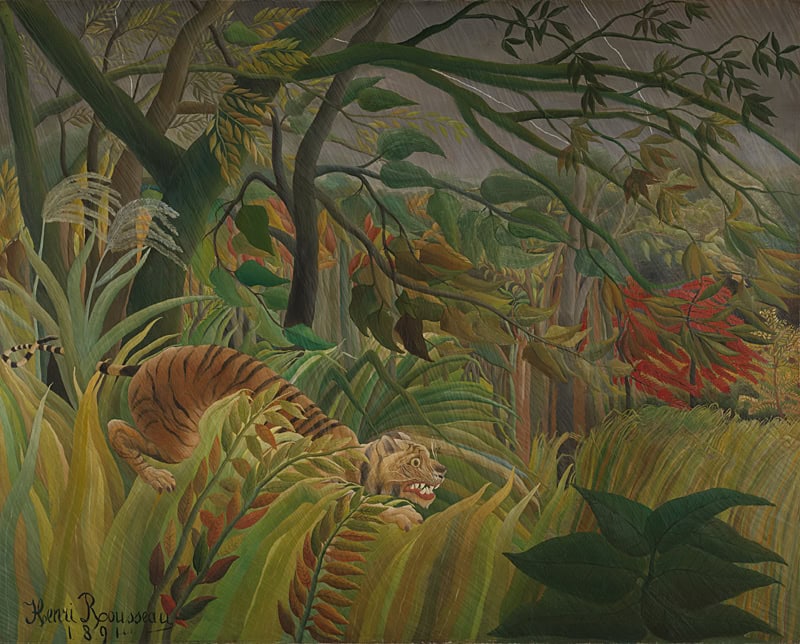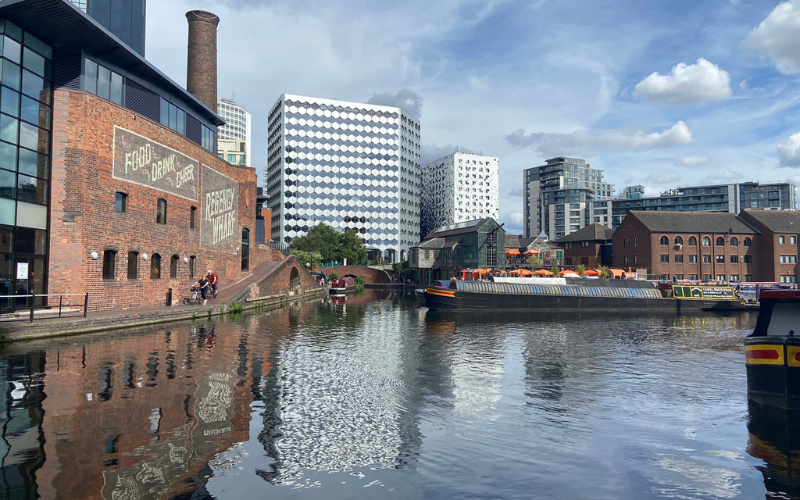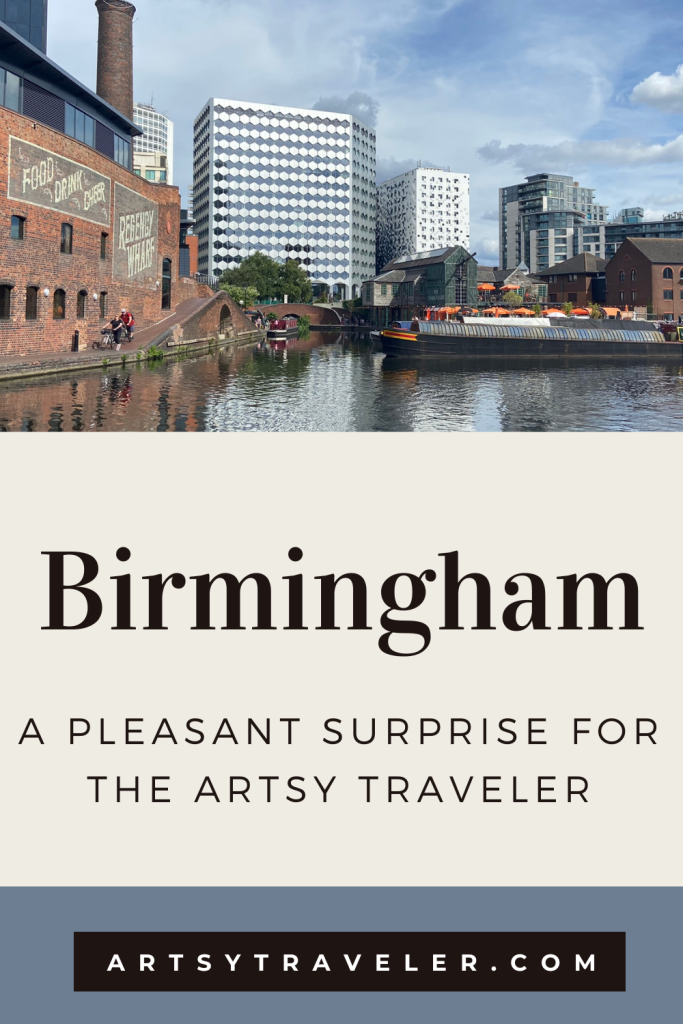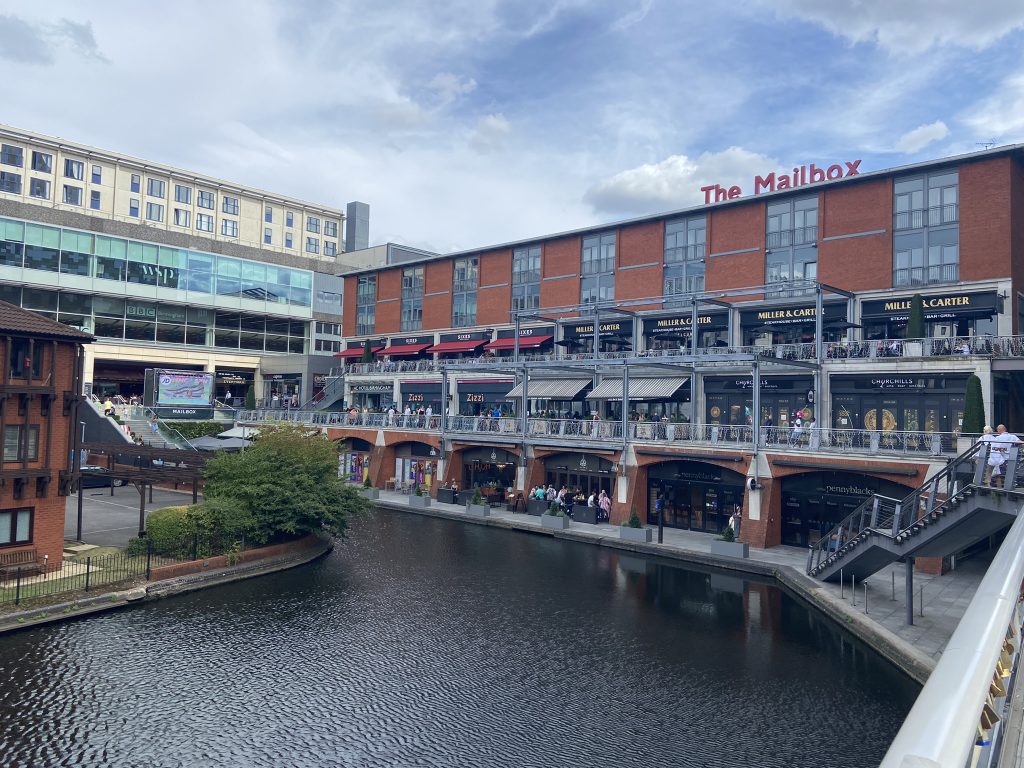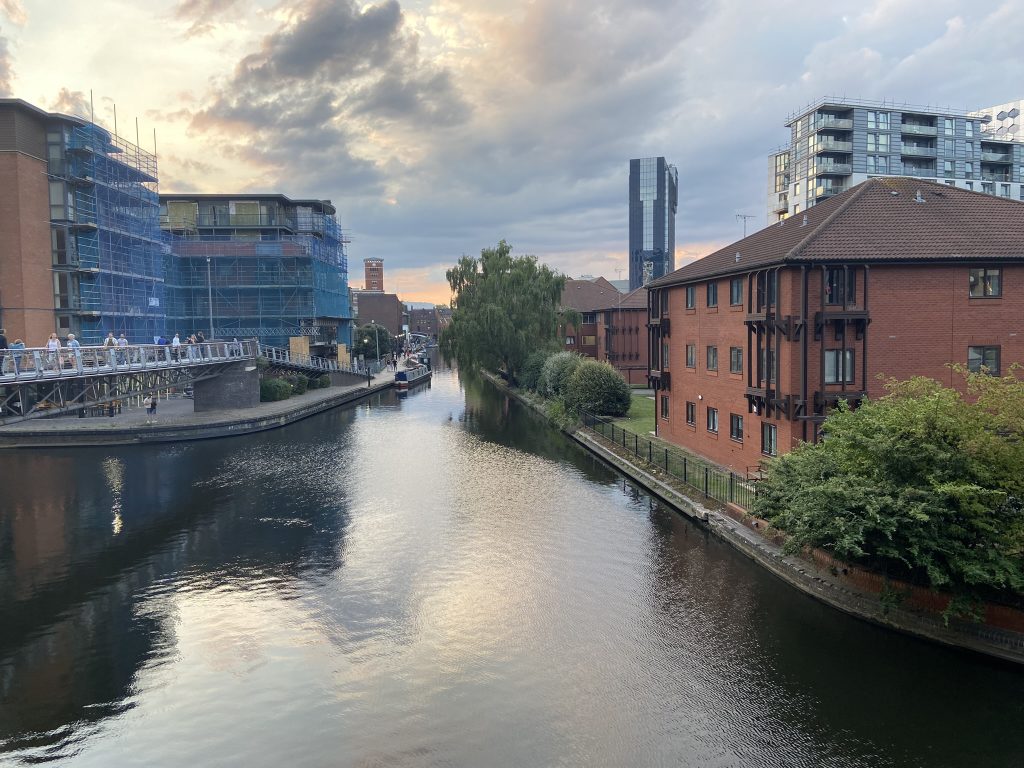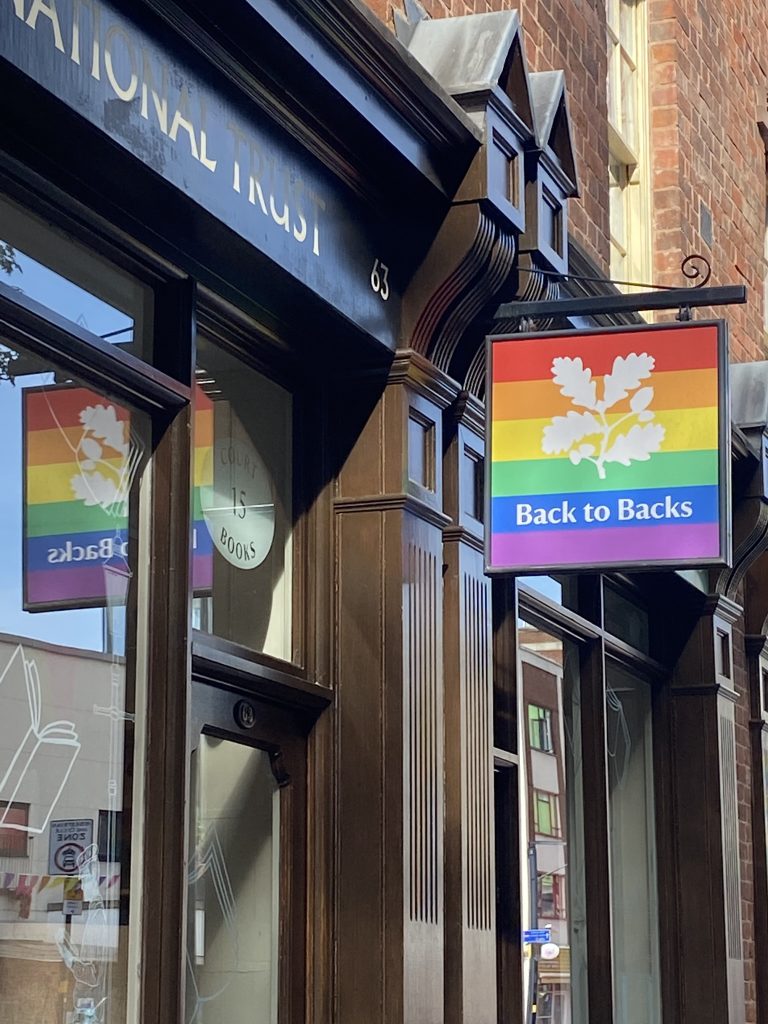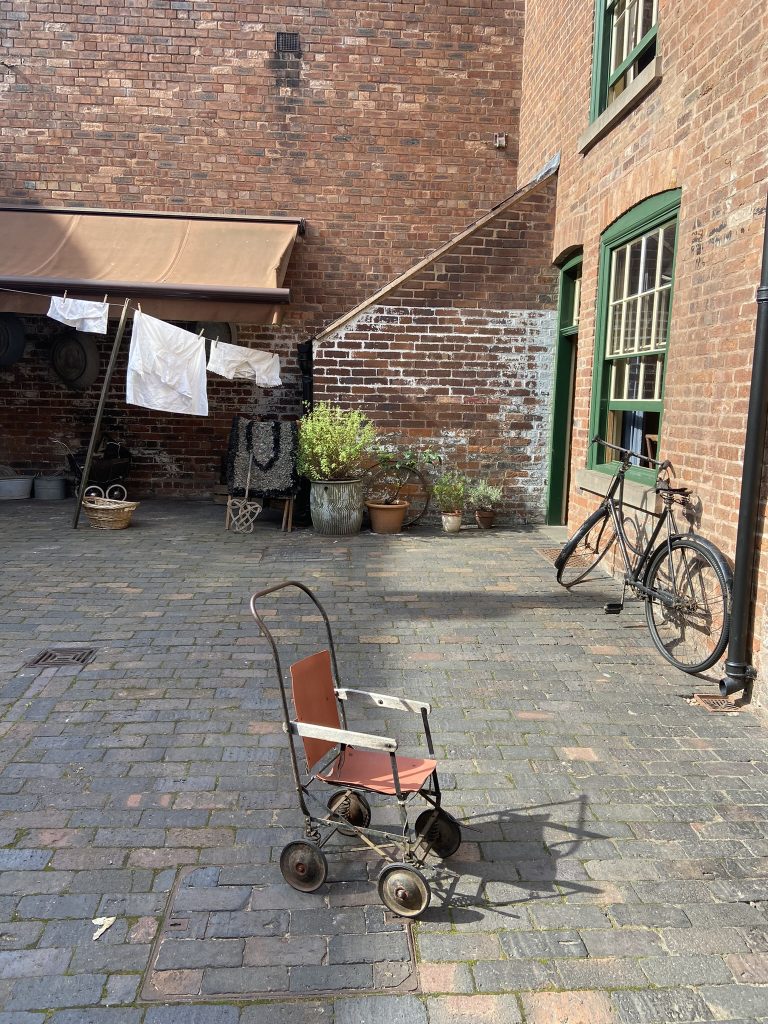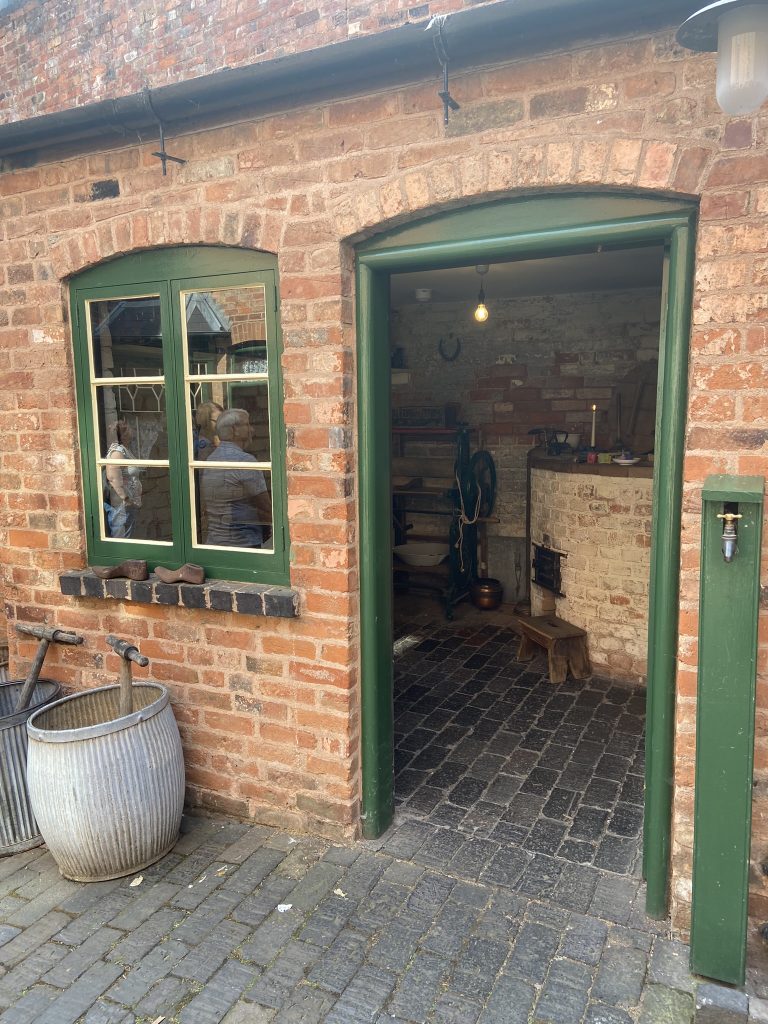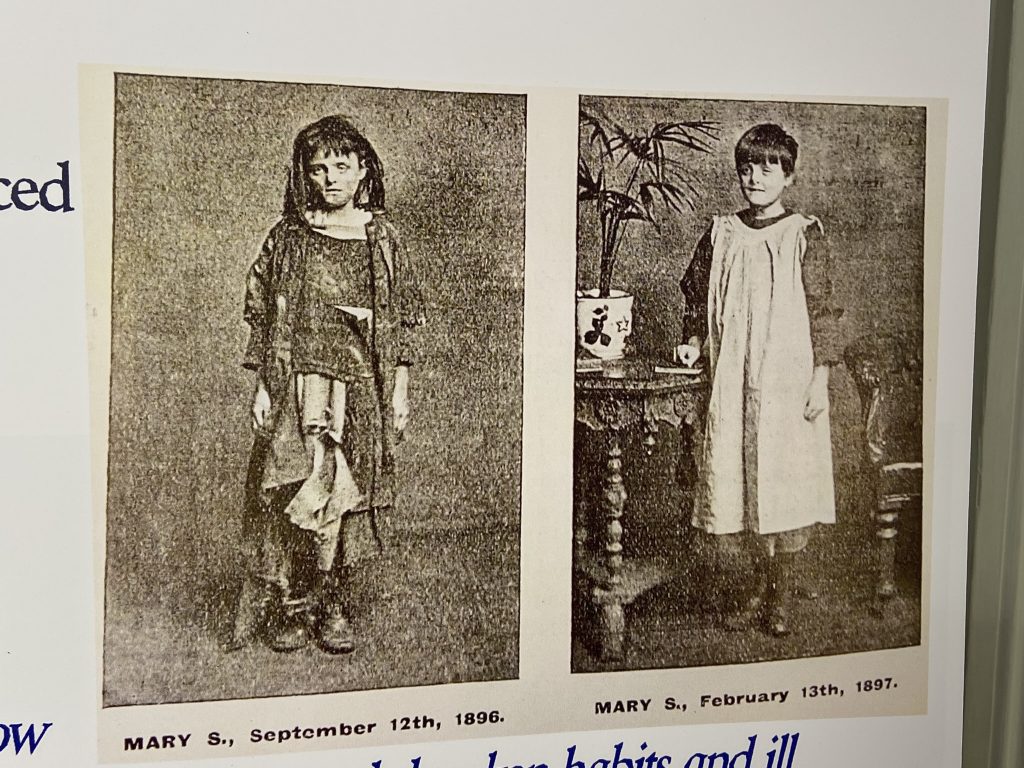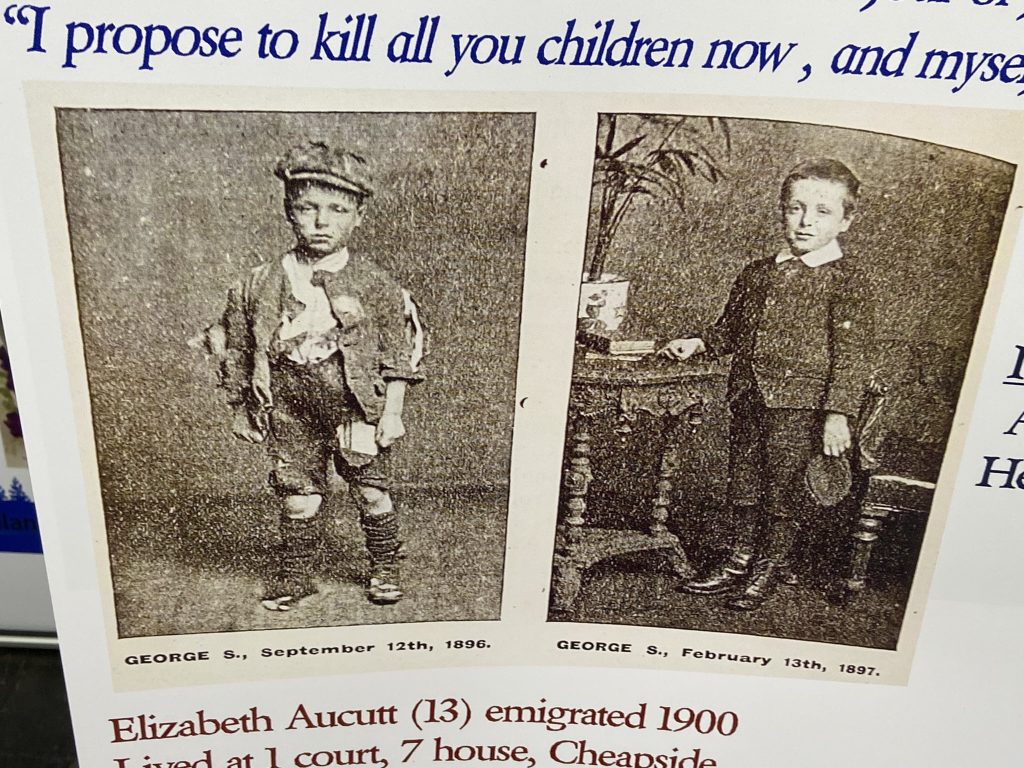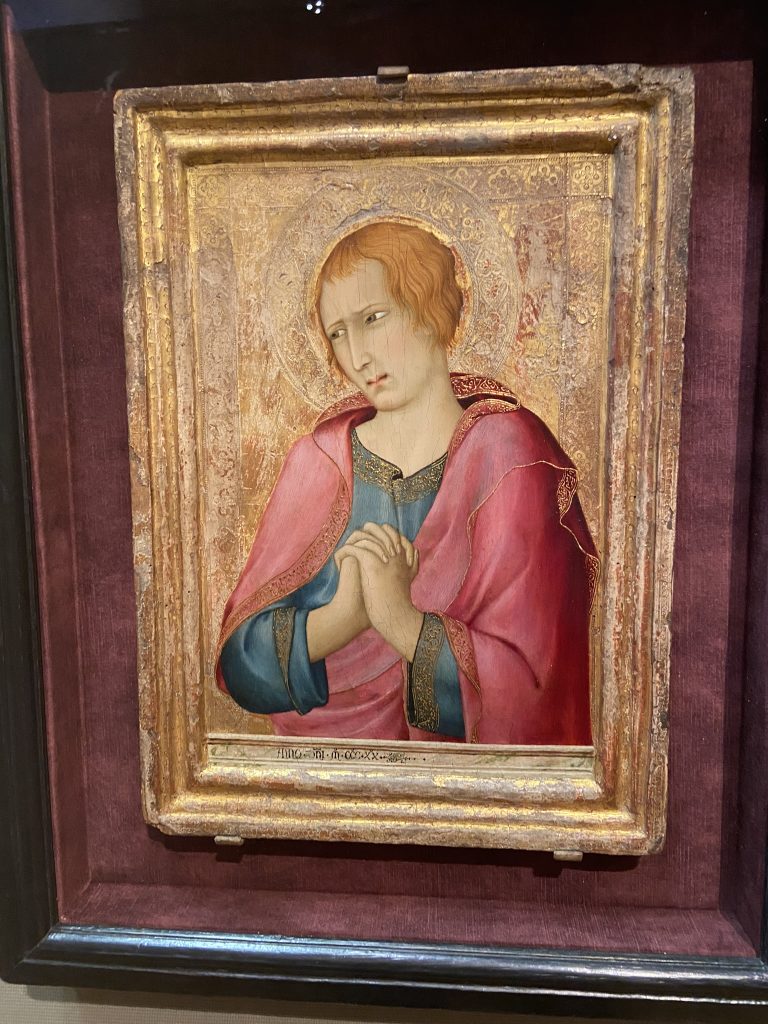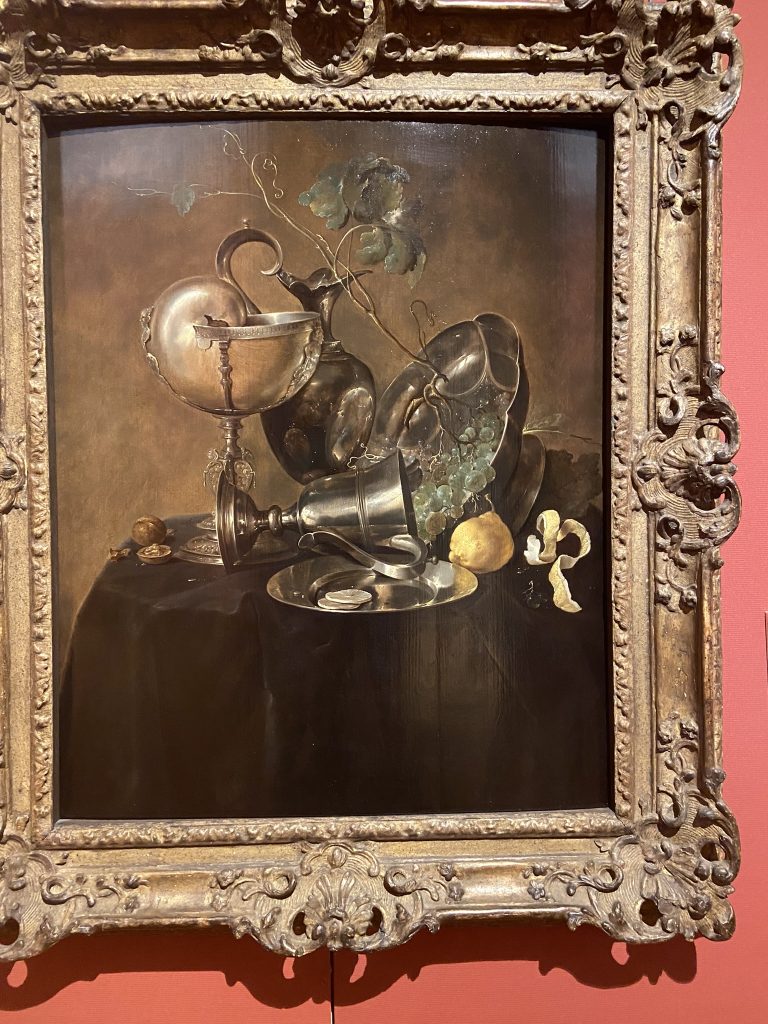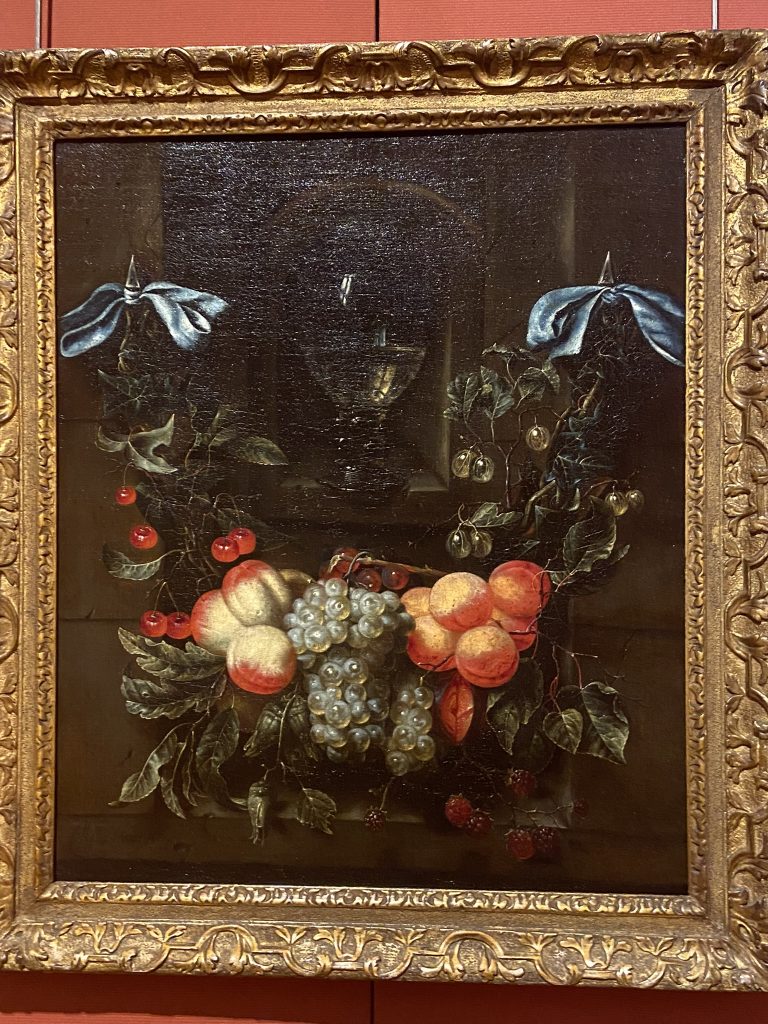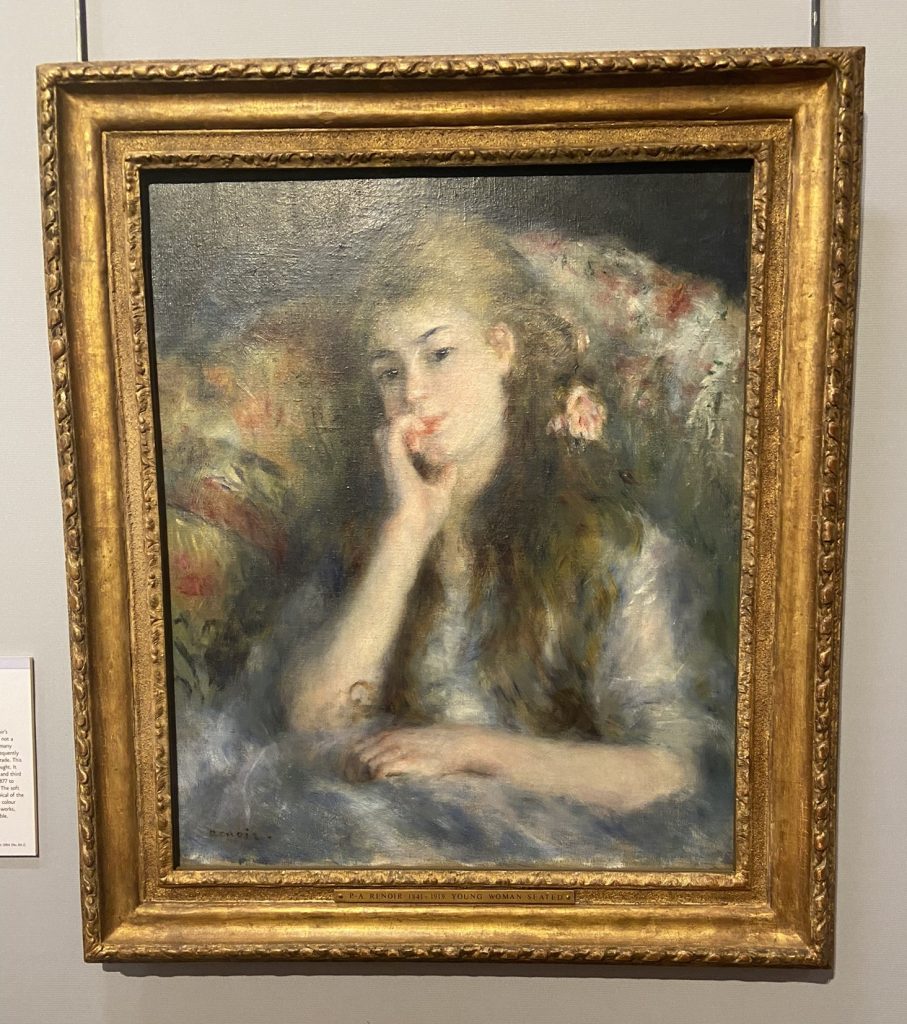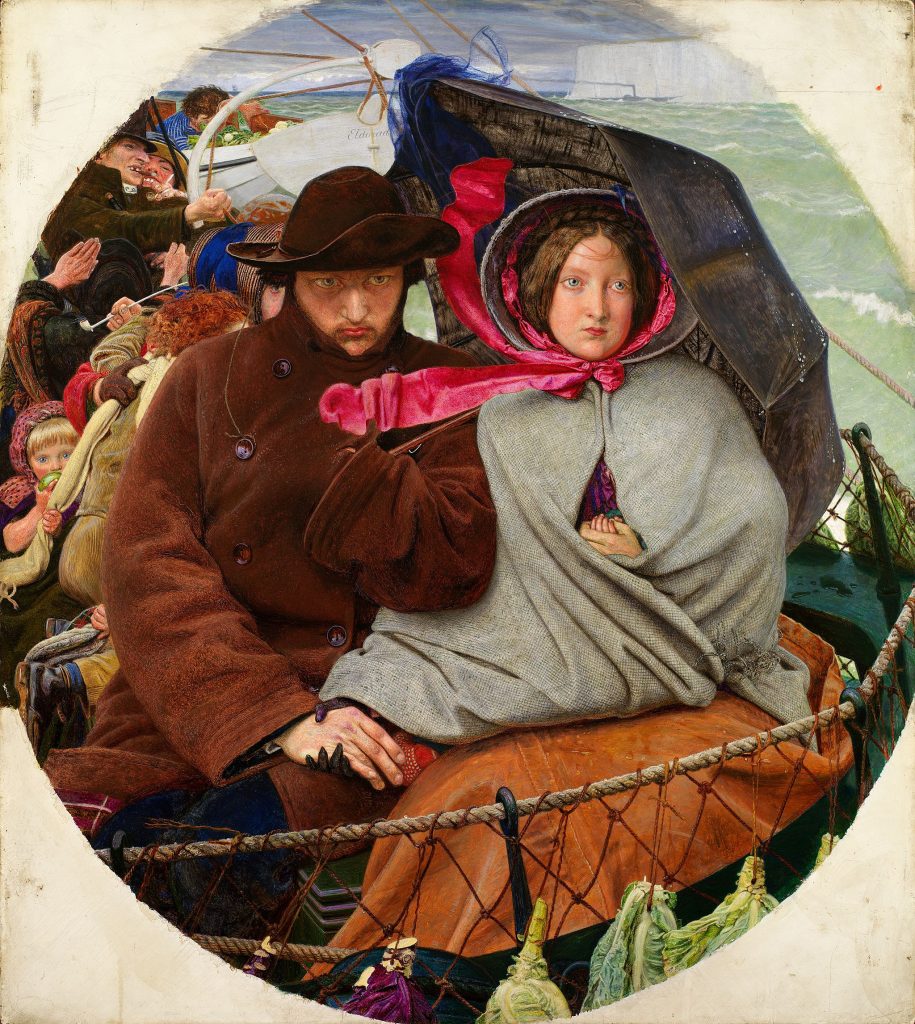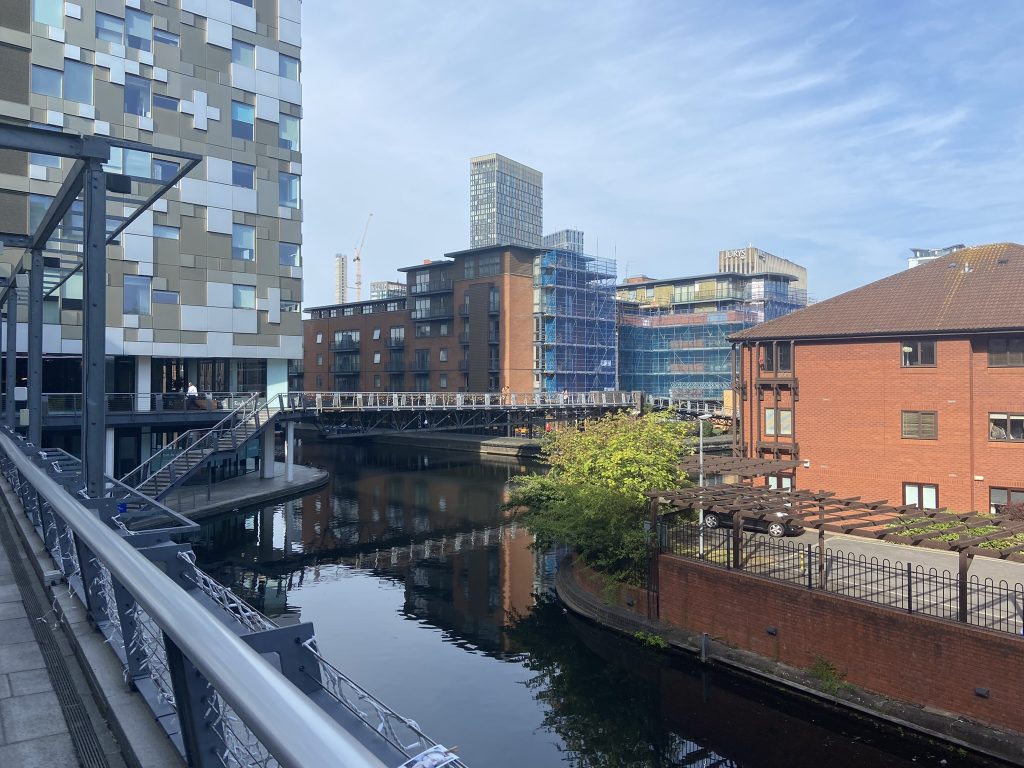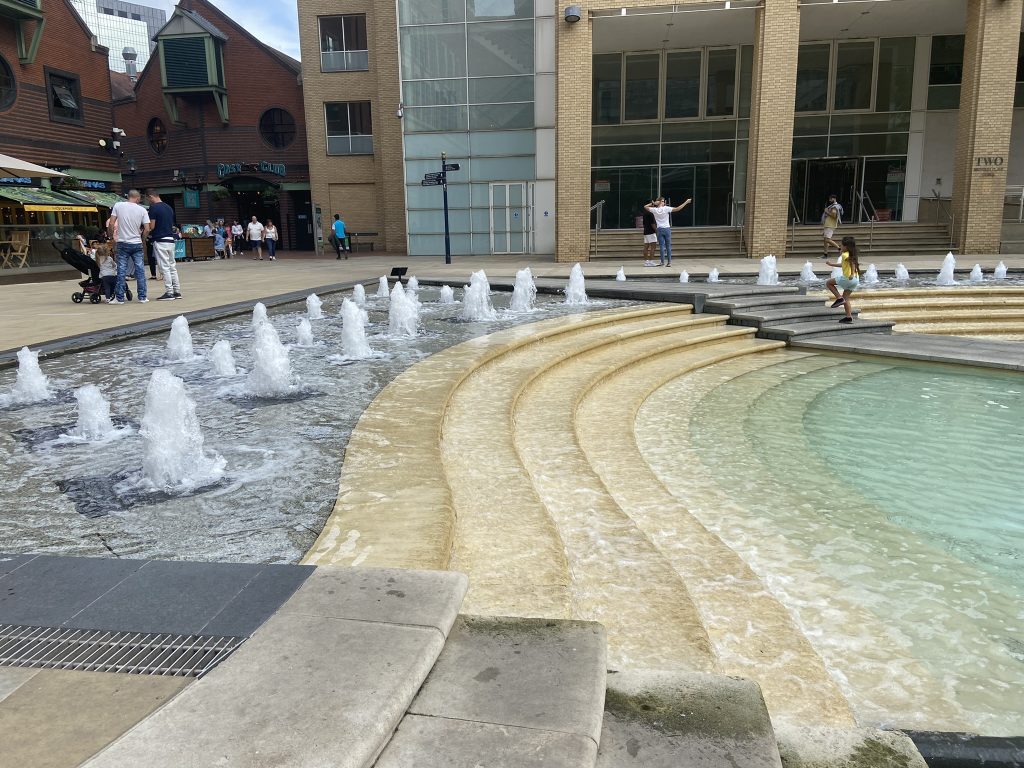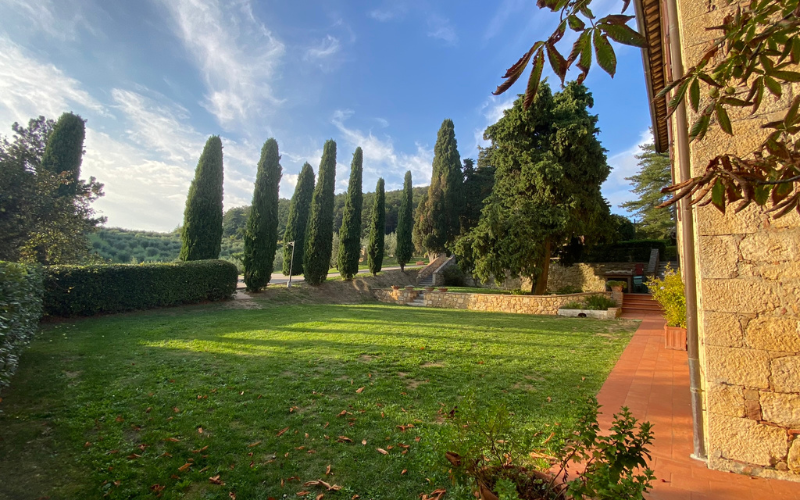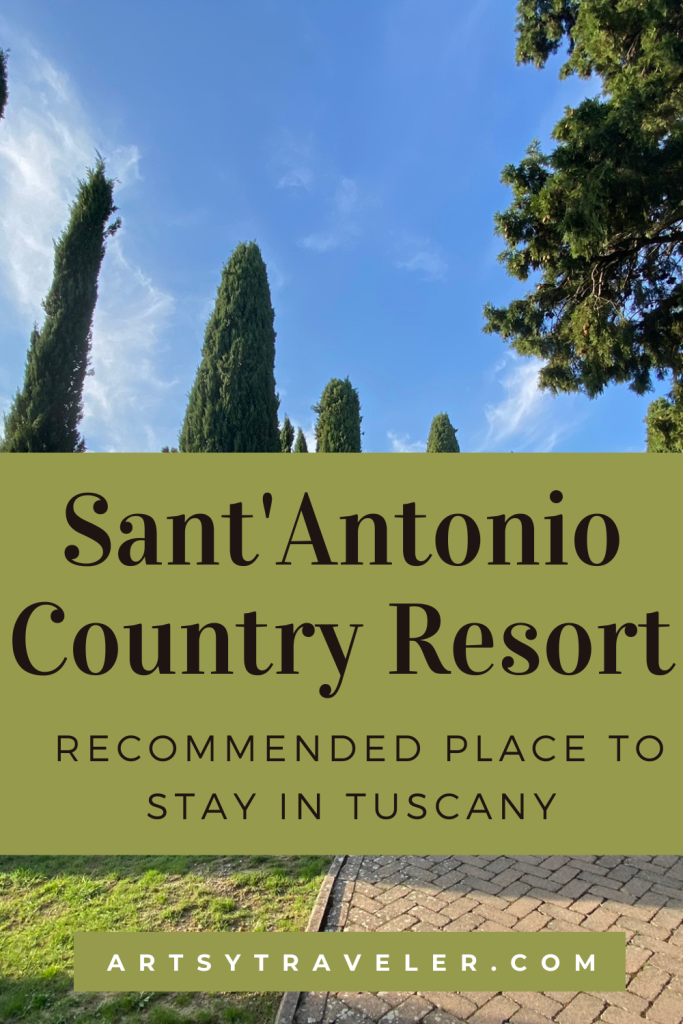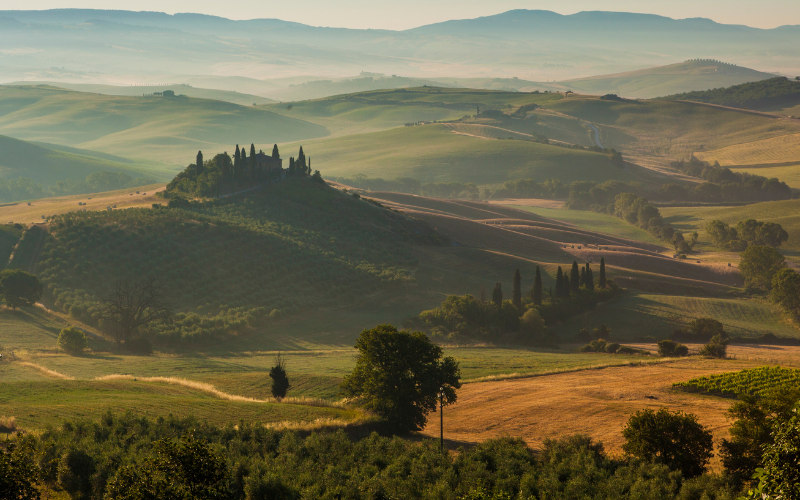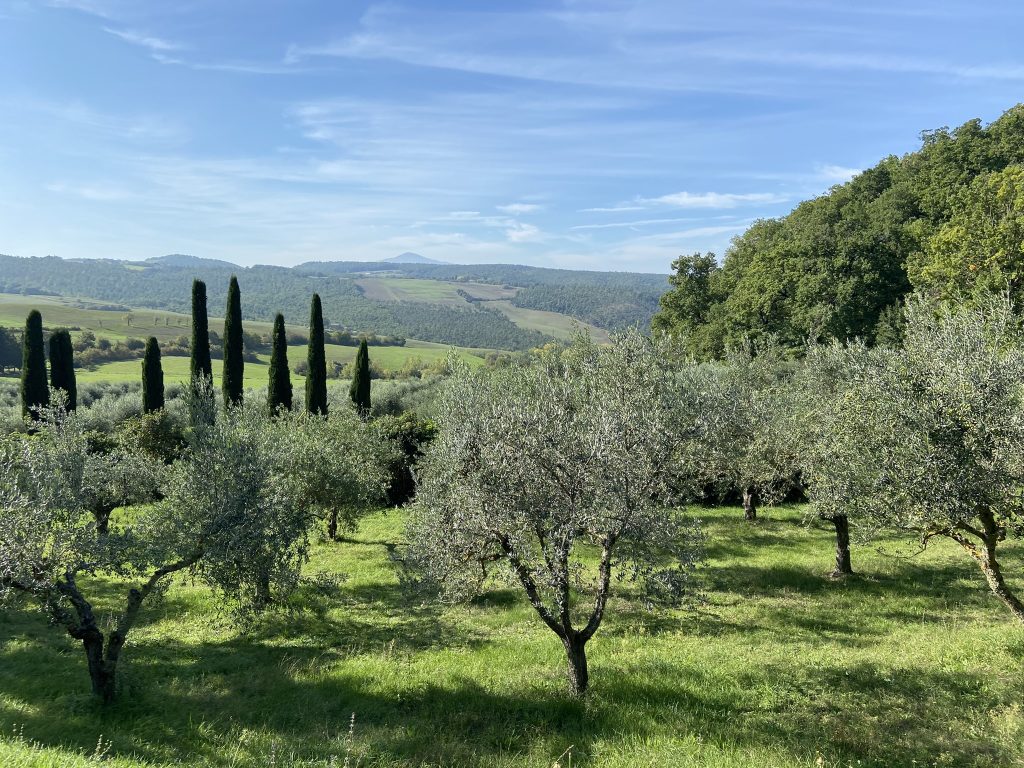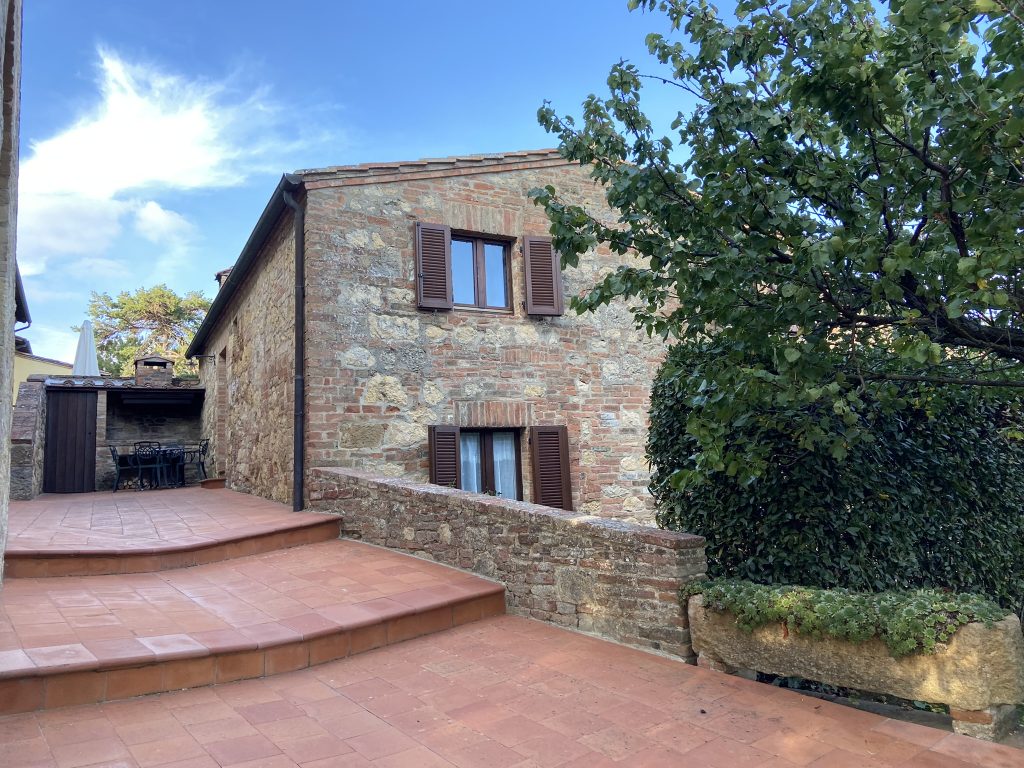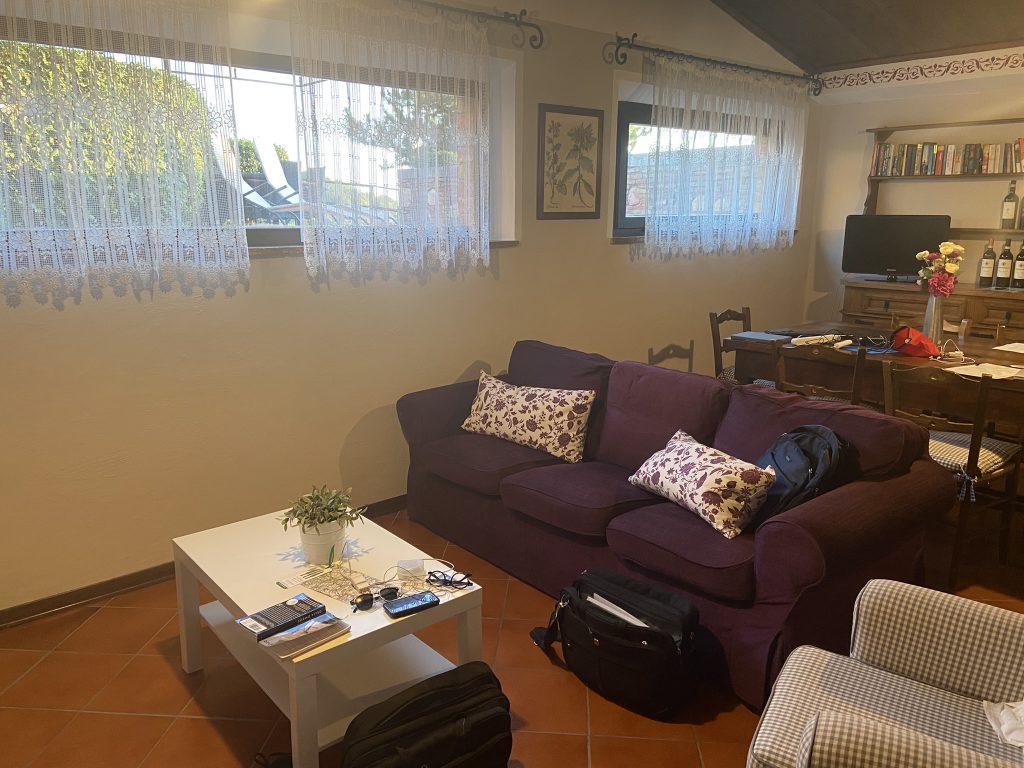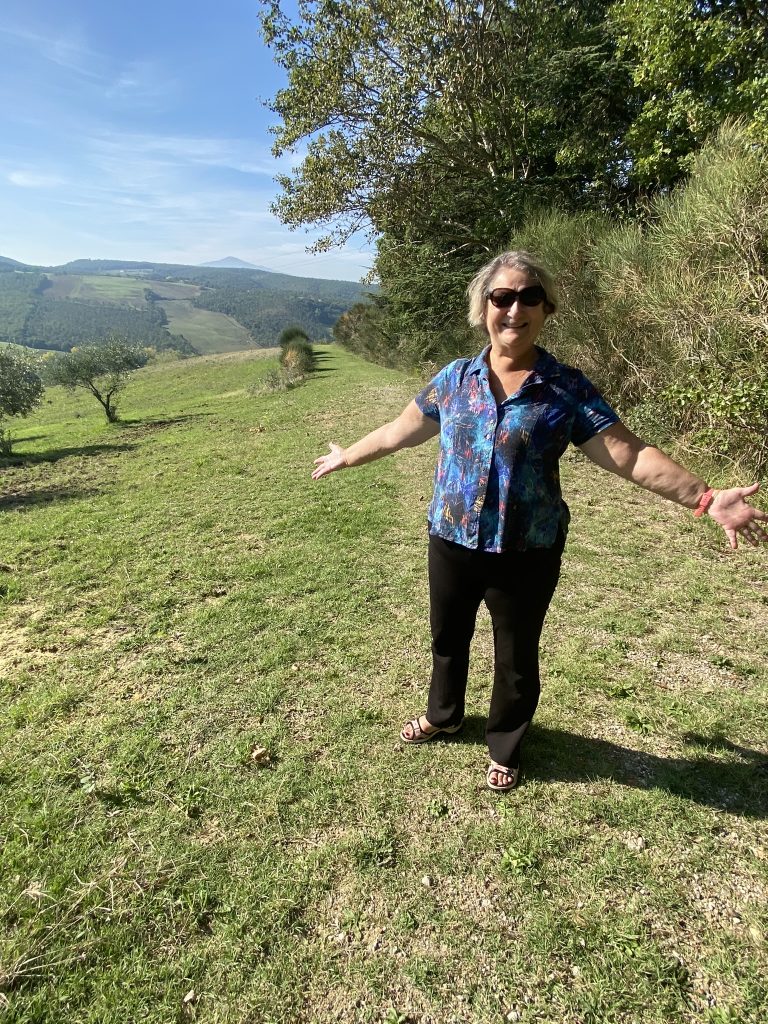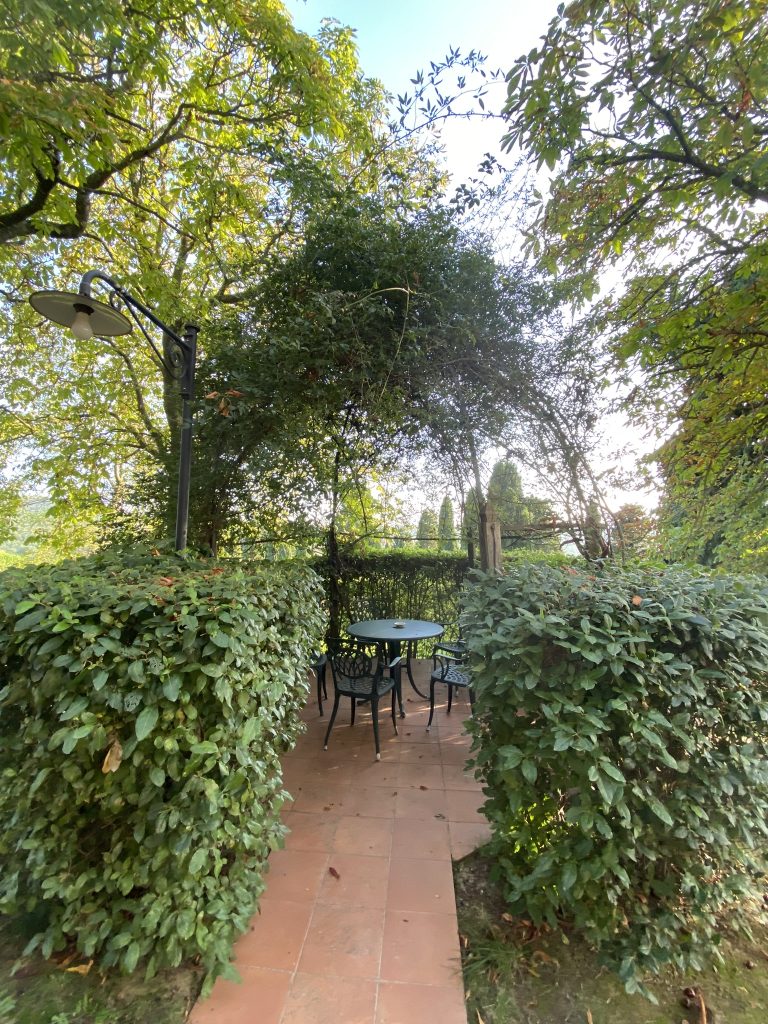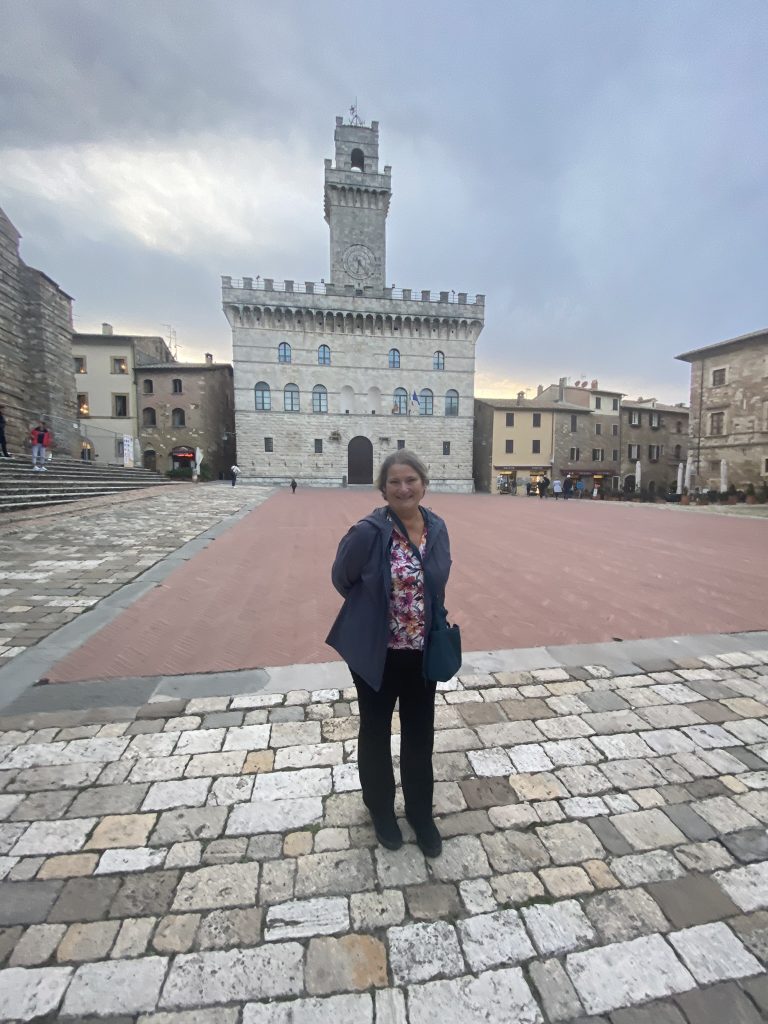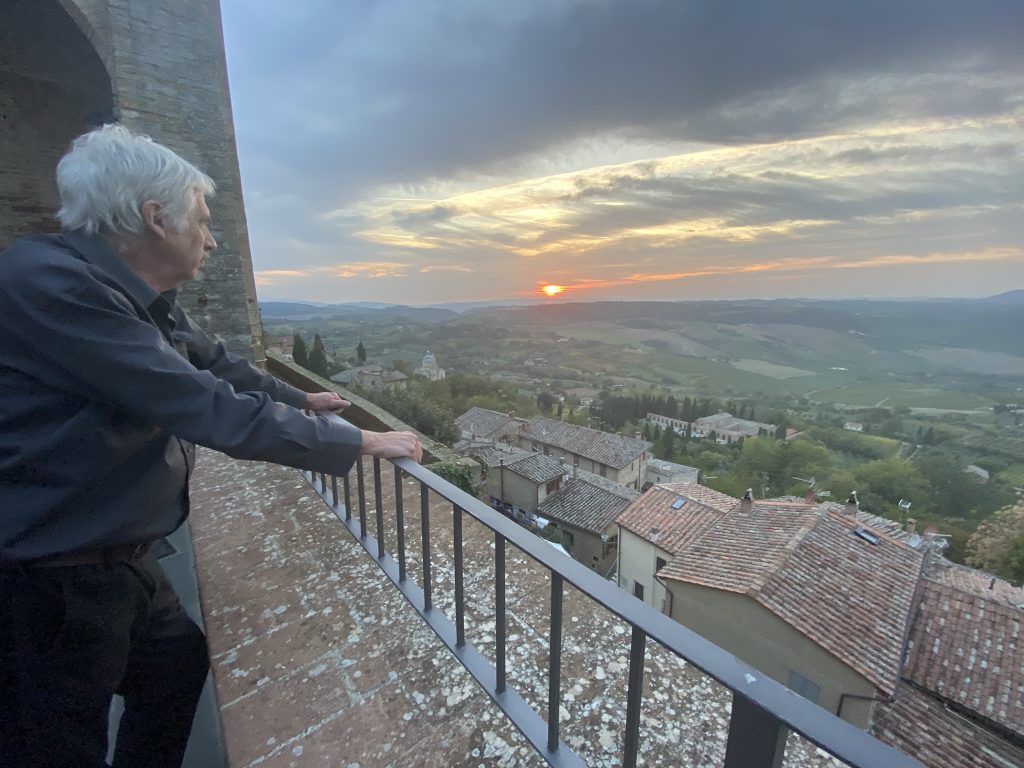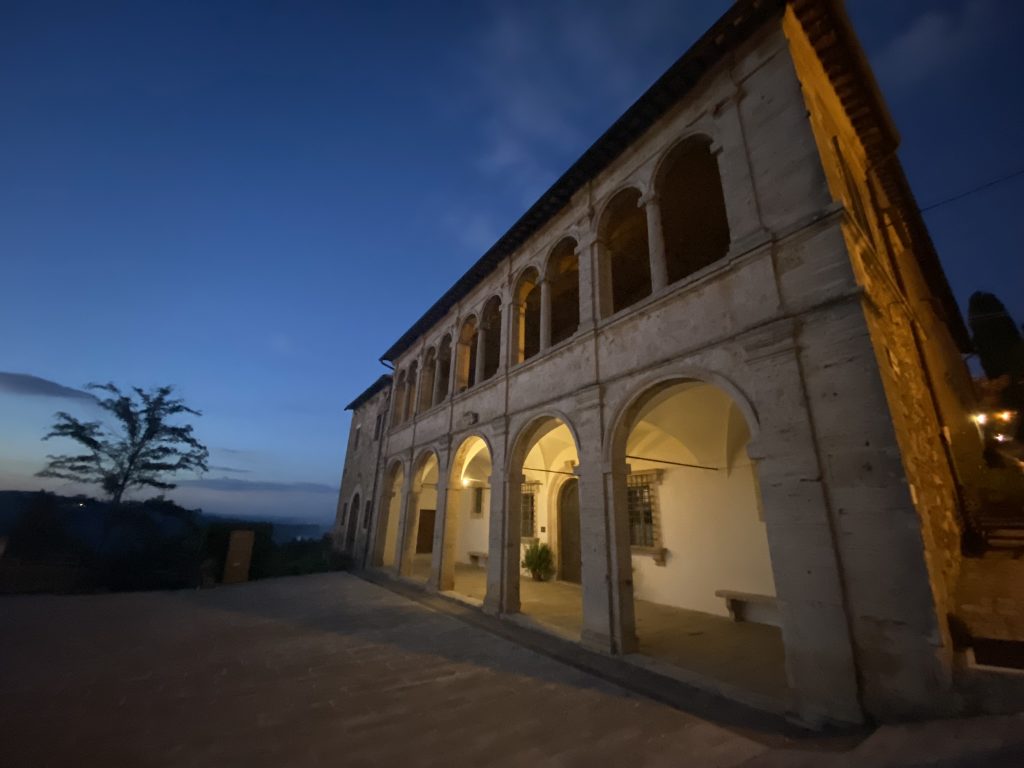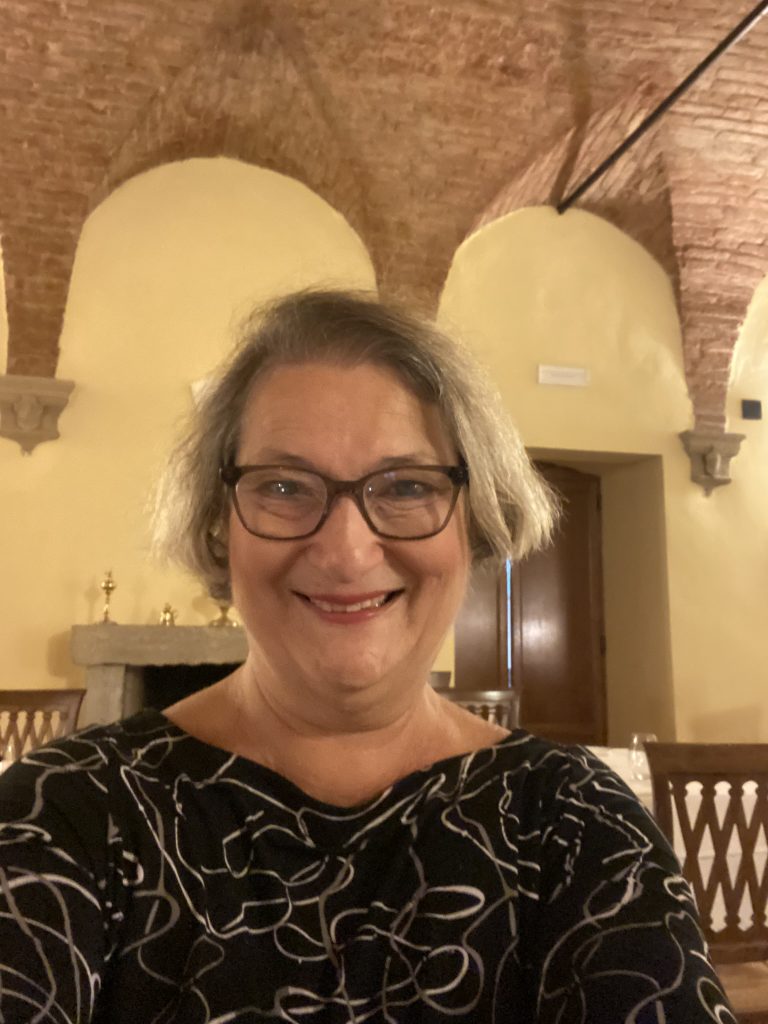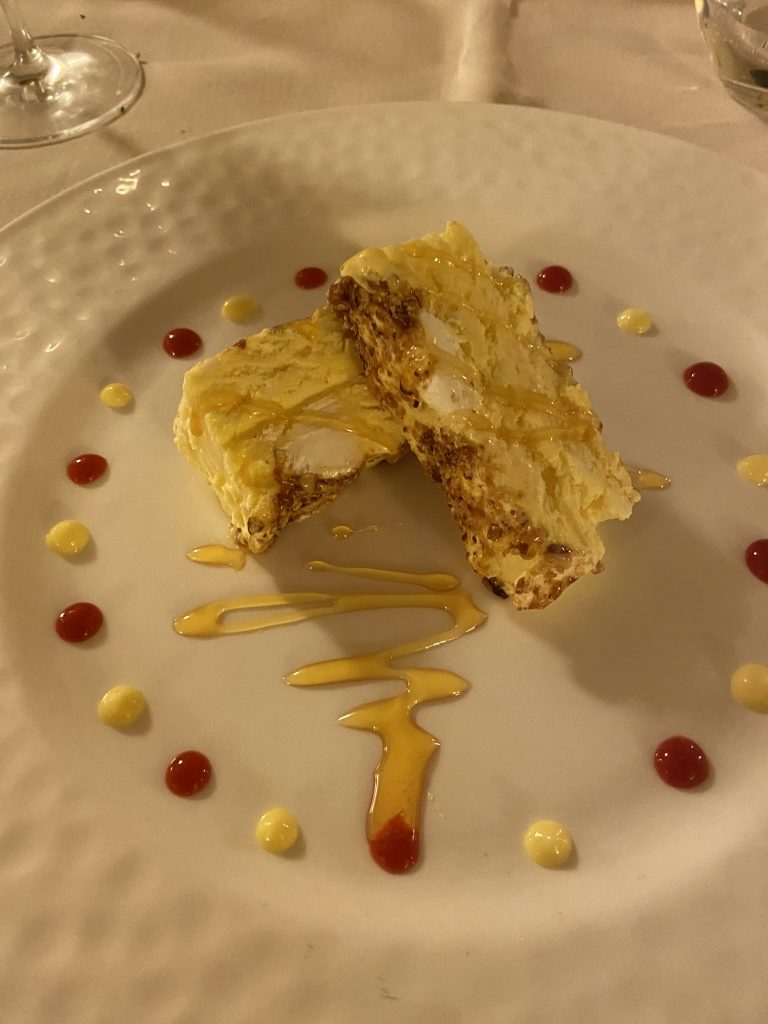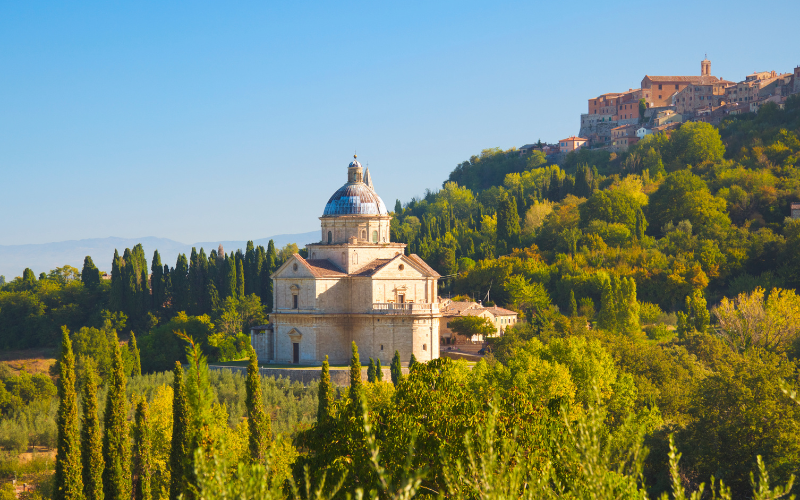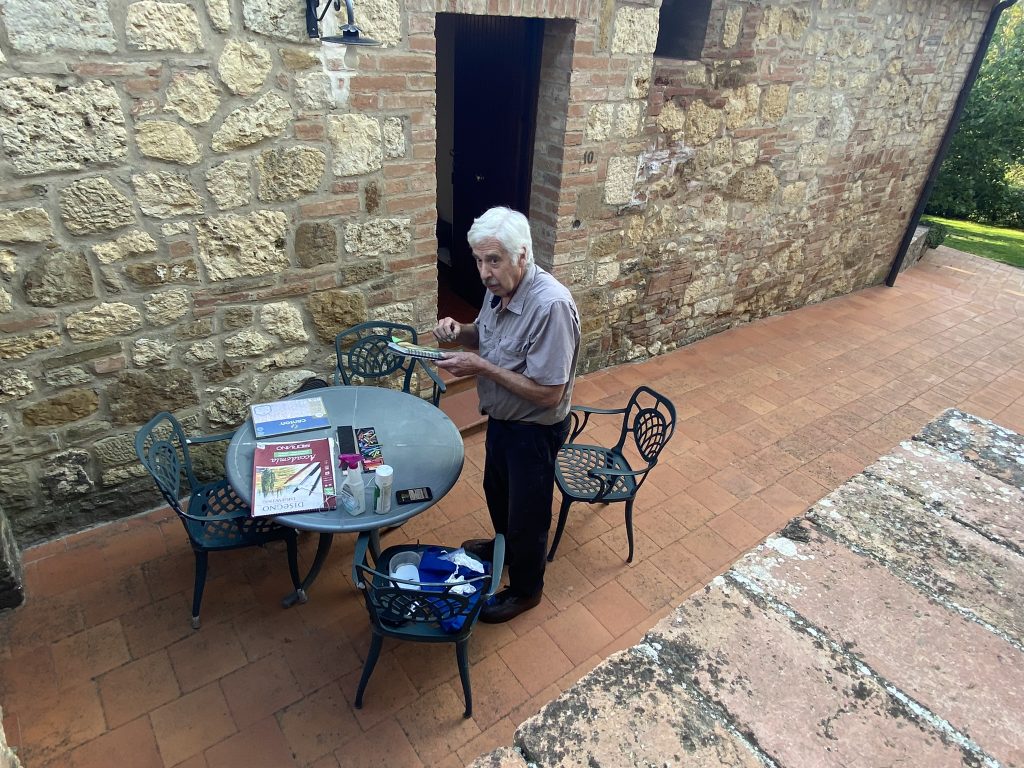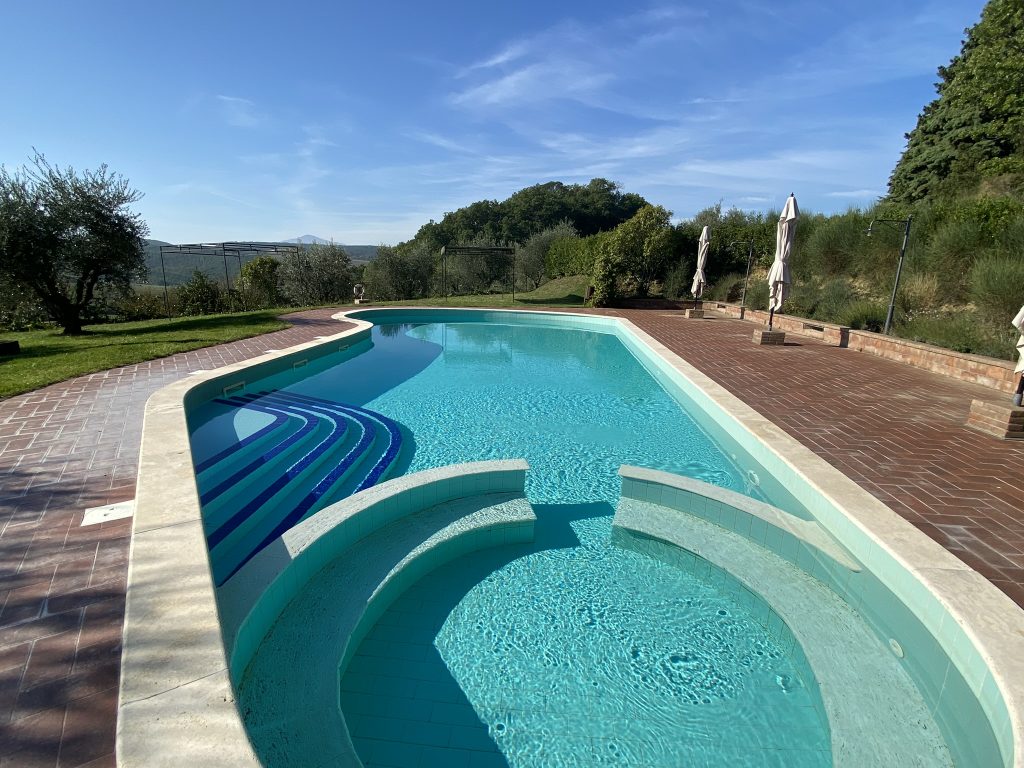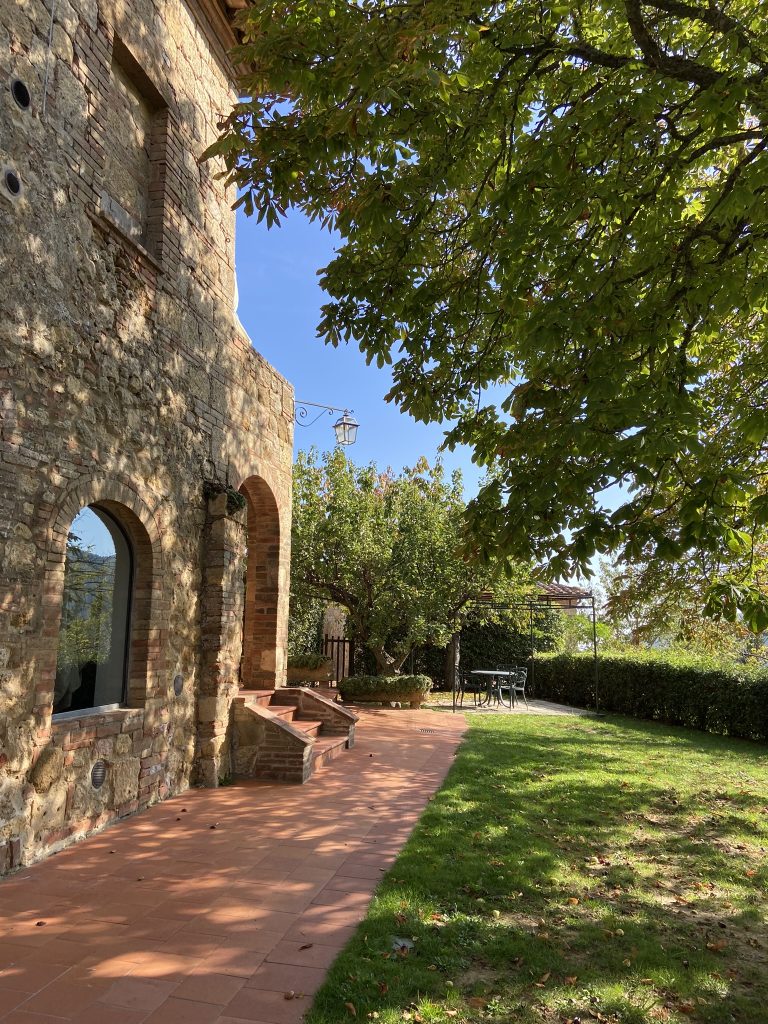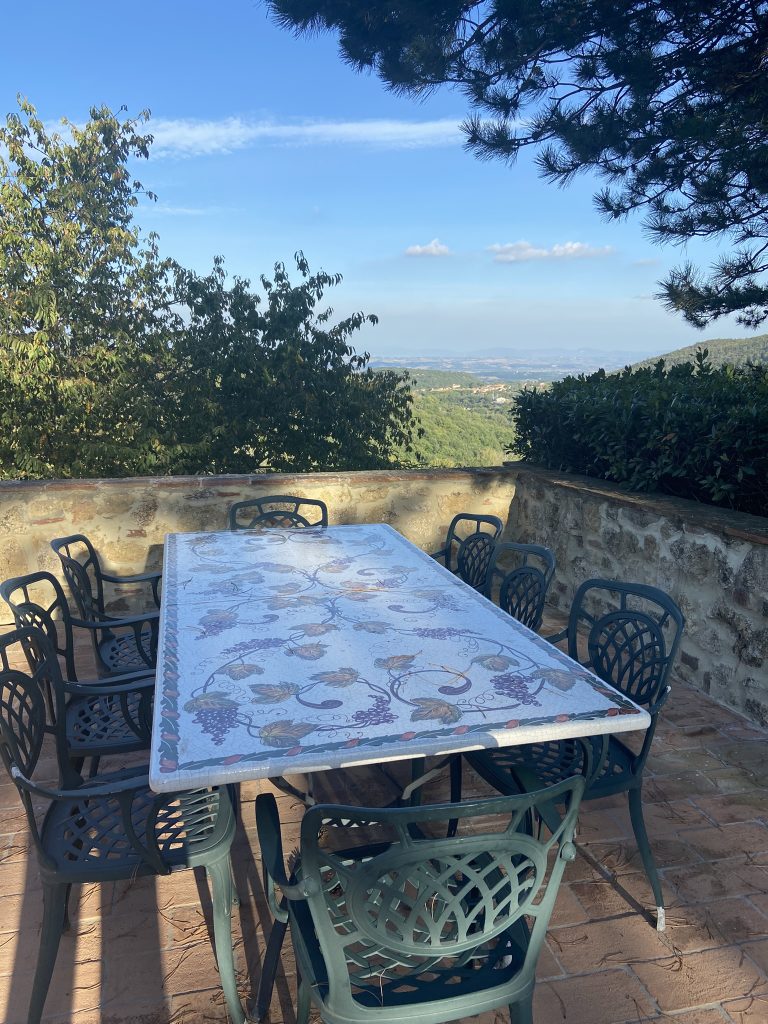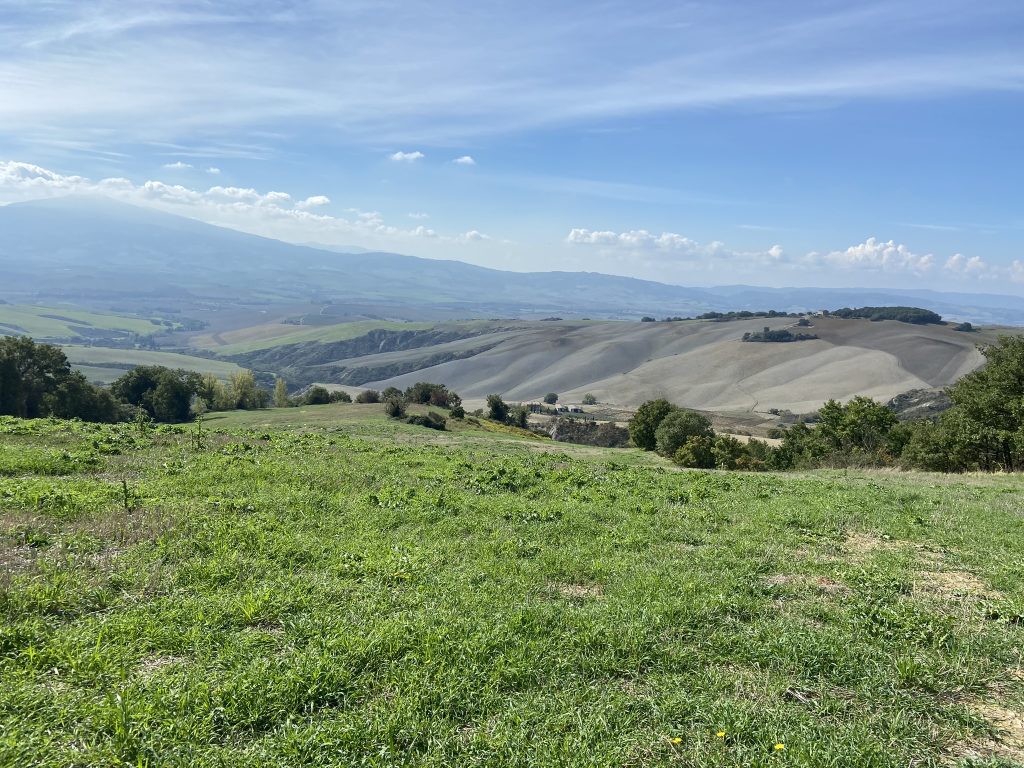See Costa Rica in Two Packed and Perfect Weeks
Costa Rica has become super-popular in recent years. Following its 11-month shutdown during the pandemic, it appears to be back on everyone’s radar. A surprising number of people I spoke with while planning my trip had either been to Costa Rica or wanted to go there.
Every single person LOVED Costa Rica. Not just enjoyed it or had a nice time there or was happy-they’d- been-but-once-was-enough but LOVED it and wanted to go back. Preferably tomorrow.
In this long post, I share my daily journal of our 14-day trip. Our itinerary includes four major locations: Arenal, Monteverde, Manuel Antonio, and the Osa Peninsula.
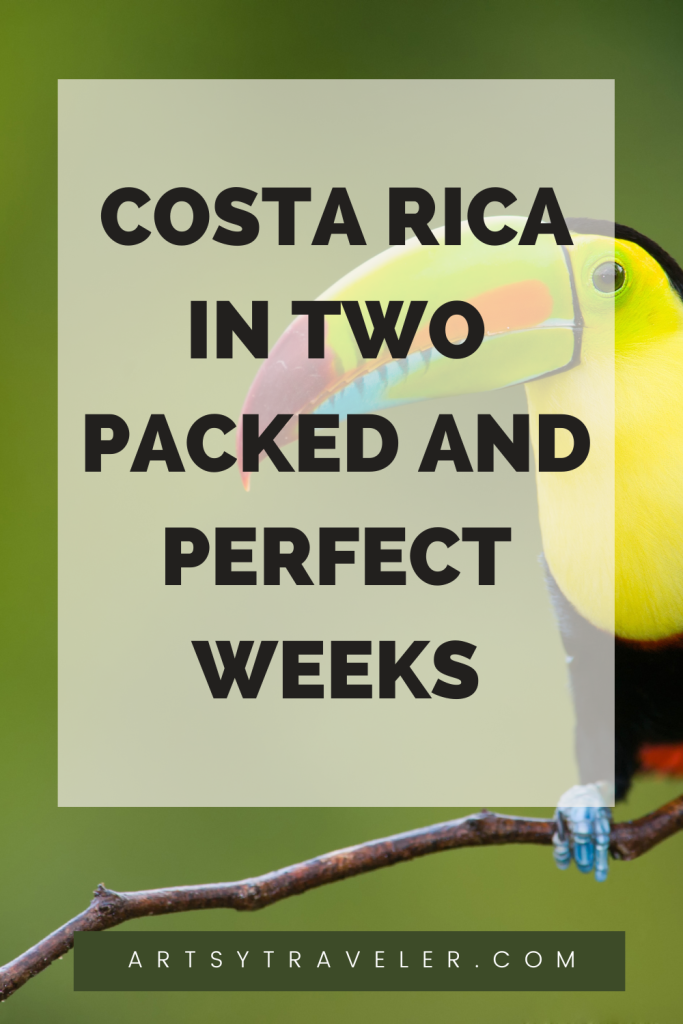
Why We Chose Costa Rica
About a year ago, my daughter Julia and I were talking about taking a Caribbean vacation in February of 2023. The pandemic was winding down, and Julia wanted to experience visiting a warm country during a West Coast winter. Always up for a trip, I needed no convincing.
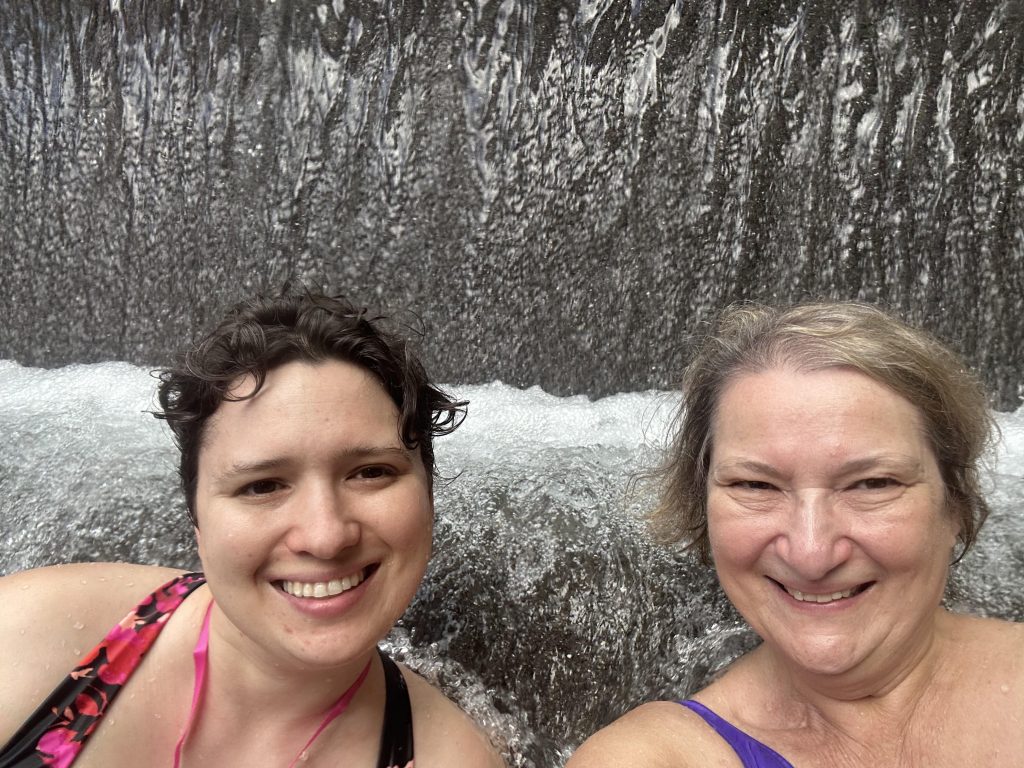
As we bandied about island ideas, we realized that the main reason we wanted to visit tropical climes was to see lots of tropical wildlife. Here on the west coast of Canada, parrots, monkeys and sloths are a bit thin on the ground.
Once wildlife entered the picture, we considered wildlife-intensive destinations within striking distance of Vancouver. A nanosecond later we had our answer—Costa Rica! National parks preserve over one-third of the country. In fact, the Osa Peninsula in the south contains 2.5% of all the species on Earth, and the country has a well-established tourist infrastructure.
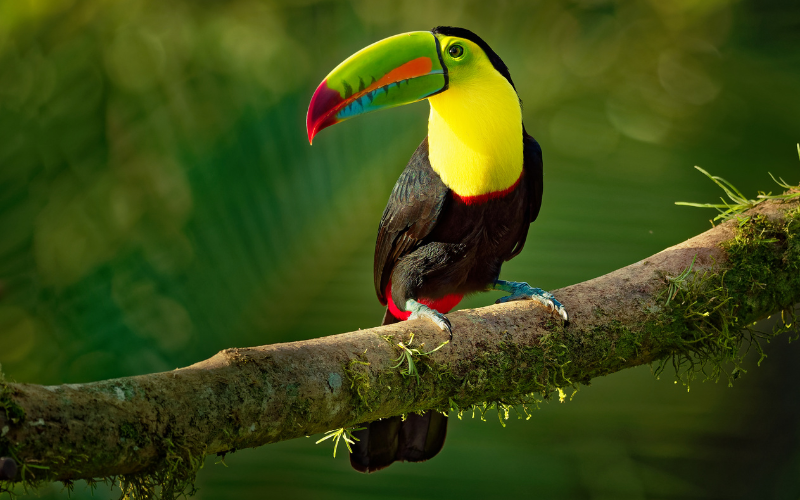
Costa Rica is a stable democracy with excellent social services. On the World Happiness Index for 2023, Costa Rica ranks #16, just after Canada (at #14) and ahead of the UK (#17) and the United States (#19). Certainly, one of the top reasons for visiting Costa Rica is because of its friendly and welcoming people.
Where to Go in Costa Rica
Once we decided on Costa Rica, we turned to planning our itinerary. My daughter works in the travel industry (for Rocky Mountaineer) and suggested we find a company that would arrange all the accommodations, transfers and tours, and would be available 24/7 in Costa Rica should we have any problems.
I’d never worked with a travel planner before, but for Costa Rica, I’m VERY glad we chose Pacific Trade Winds.
Pacific Trade Winds
Big shout-out to this company. They did an incredible job helping us plan the perfect two-week trip to Costa Rica (and it was just about perfect!). I filled out a form on their website stating our interests (seeing wildlife, mostly) and within a day I received the first suggested itinerary.
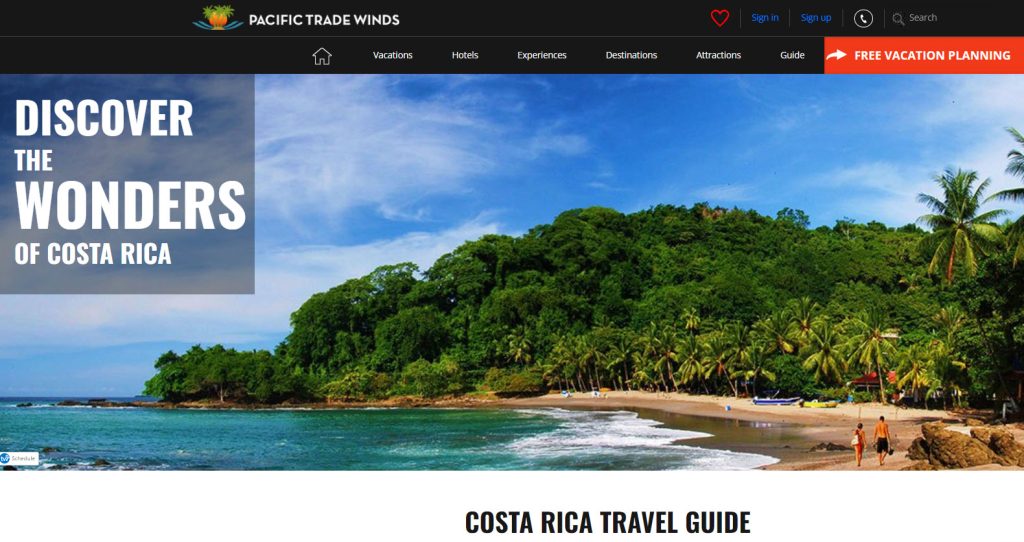
Over the next several weeks, Julia and I refined the itinerary by selecting accommodations and tours. At every step of the way, the Pacific Trade Winds itinerary interface was easy to navigate, and our queries responded to in lightning-quick time.
Our Itinerary
Following the advice of Pacific Trade Winds, we settled on this itinerary:
- Day 1: Fly from Ottawa to San José, arriving late and stay one night at the Hilton Cariari DoubleTree near the airport
- Days 2, 3, 4: San José to Arenal and La Fortuna and stay at the Tabacón Grand Spa Thermal Resort
- Days 5, 6: La Fortuna to Santa Elena in the Monteverde Cloud Forest and stay at the Monteverde Lodge & Gardens by Böëna
- Days 7, 8, 9: Santa Elena to Manuel Antonio on the Pacific coast and stay at Si Como No Resort & Wildlife Refuge
- Days 10, 11, 12, 13: Manuel Antonio to Sierpe and then by boat to the Osa Peninsula and stay at the Copa de Arbol Resort.
- Day 14: Drake Bay on the Osa Peninsula by air to San José and stay one night at the Gran Hotel Costa Rica, Curio Collection By Hilton
We booked private transfers for every leg of the trip. You can definitely drive in Costa Rica, but I don’t recommend it for our itinerary. Too many of the roads are quite rough. In my opinion, a rental car only makes sense if you’re planning to drive from the airport to the beach resorts on the Pacific coast.
Map of Our Itinerary
Here’s a map of the four main places we visited in Costa Rica plus San José where we stayed for one night at the end of our trip.
Are you ready to check out my post about our two-week trip around Costa Rica?
Pura Vida!
Wait? What? Before diving into Costa Rica, take a step back to learn two essential words: Pura Vida. You’ll hear it a lot in Costa Rica, mostly from locals. It means “pure life” and Ticos (people from Costa Rica) use it as a please, a thank you, an acknowledgement, and just for the heck of it. The phrase celebrates the life we’re all living together here on this planet and reminds us to live “pure life.” Embrace it, enjoy it, welcome it, and be grateful.
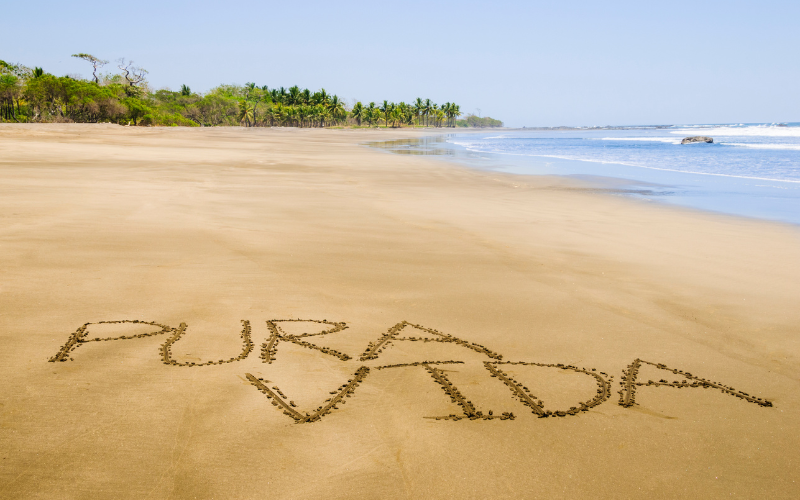
The phrase has become synonymous with Costa Rica and is emblazoned on everything from mugs to stuffed toucans to beach towels. Yes, it’s become a marketing brand, but so what, it’s a good one! I heard locals using it with each other as well as with tourists. It symbolises a way of being in the world that reminds us to slow down, smell the hibiscus, and enjoy.
Okay, now we can go!
Day 1: Ottawa to San José
We start our journey to Costa Rica with a three-day stopover in Ottawa to visit family. No airline flies direct from Vancouver to San José in Costa Rica. The only cities in Canada with direct flights to Costa Rica are Toronto and Montreal. Adding Ottawa onto our trip costs almost nothing extra, and we get to experience some good old-fashioned eastern Canadian winter weather before shedding our parkas and pulling on our sandals.

While in Ottawa, we tour the National Gallery—one of my happy places! Read National Gallery of Canada: Best Bets for the Artsy Traveler for an overview of twenty of my favorite pieces in the Canadian collection.
Upgrading to First Class
We check in 24 hours before our flight and discover we can upgrade to first class for an extra $250 each. That is reasonable for first class and so we decide to splurge. Ah, the joys of turning left upon entering the plane rather than right! We each have our own pod to stretch out in and food that is edible. Luxury!




The five-hour flight to Costa Rica flies by (ha, ha) and soon we touch down and enter the huge and blessedly empty San José International Airport. Since it’s 9:30 pm and we are among the first to deplane, we sail through passport control without delay.
Getting Picked Up
Pacific Trade Winds has organized private transfers for us throughout our trip. Allegedly, we just need to show up at the appointed place at the appointed time and someone will be there to whisk us into a van and take us where we want to go. I have my doubts, but Julia—who as mentioned is in the travel biz—has no such worries.
“They’ll be there, Mom. It’s fine.”
Of course, she is right. We walk into the arrivals hall and the first thing I see is a man holding a sign with my name on it. Score!
He leads us outside and we inhale our first breath of tropical air. Ahhhh! As anyone who’s traveled from the north to the tropics during the winter knows, there’s nothing like that first contact with moist and balmy air. The warmth seeps into tight muscles, coaxing them to soften and relax. For two whole weeks, we box our memories of snow, ice, and freezing rain and shove them into a mental closet labeled home.
First Night: Near San José
Fifteen minutes after leaving the airport, we arrive at the Hilton Doubletree Cariari Resort. With Doubletree’s complimentary warm chocolate cookies in hand, we glimpse a floodlit pool as we make our way along cool, stone-tiled corridors past Costa Rican artwork and murals to our room. At 10:30 pm, there isn’t much to do except get ready for bed, although we do check out our little terrace overlooking the pool.
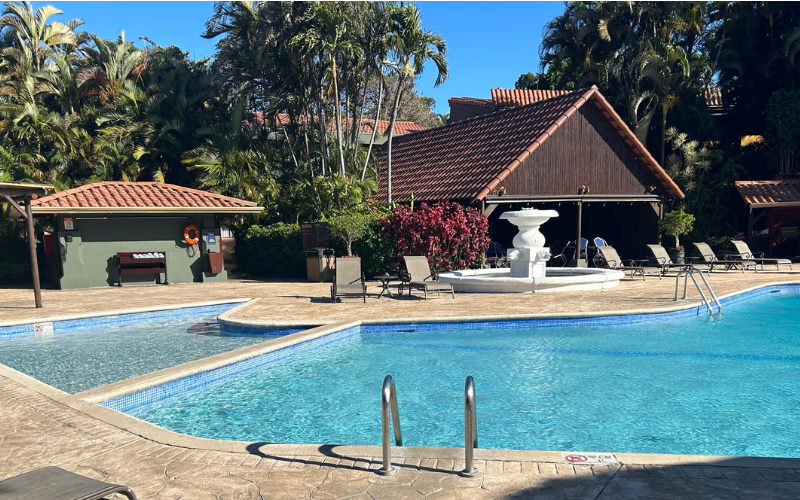

Unfortunately, the air conditioning unit runs at a decibel level high and shrill enough to waken the dead, so we spend a restless night alternating between being hot and quiet and being cool and noisy. The hotel is fine for a quick stopover, but we’re glad to be leaving in the morning.
Day 2: San José to La Fortuna
The next morning, I make my way to the restaurant for my first Costa Rican breakfast. As expected, the coffee is good—my first cup of many, many cups I’ll enjoy in the two weeks to come. Our transfer isn’t arriving until 10 am so I spend a few hours lounging beside the pool. The air is surprisingly fresh—not exactly cool but not quite inspiring me to want to get wet. Our destination for the day is the world-famous Tabacón Thermal Resort & Spa just outside La Fortuna. I will have plenty of time during our three nights there to immerse myself.
Our driver arrives early (a trend throughout the trip: shout-out to Ride Costa Rica for fabulous service!) and we are soon on the highway heading north.
En Route to La Fortuna
The first part of the trip on a busy highway is uneventful. I begin to wonder if I should have rented a car. We’d debated doing so and then opted for private transfers. The cost difference wasn’t significant and since Julia doesn’t drive, I wasn’t keen on being the sole driver.
Once we leave the busy highway to cross the mountains, I change my mind about driving vs. transfers. The road quickly deteriorates (and this is a main road!) until at times we crawl and bump over potholes. At one point, we see a truck that missed a narrow turn pushed over at a 90-degree angle in the ditch.
For the next 90 minutes of our 2.5-hour trip, I say every three minutes or so “Thank goodness I didn’t rent a car!”
Our driver, Geraldo, good-humoredly agrees that the road is pretty terrible. He lives in San José and will be driving back after he drops us off. I commiserate. As we drive up into and over the mountains on our way to La Fortuna, we are captivated by the lush countryside and sweeping vistas. We are in a tropical country, and it is stunning!
Arrival at Tabacón Thermal Resort & Spa
Tabacón Thermal Resort & Spa is not the poshest resort in the La Fortuna Area (Nayara Springs has that honor), but it is right up there in the top ten. It’s also the location of a complex of hot springs pools and waterfalls so extensive that they sell day passes to the general public.
When planning our trip, we hummed and hawed about whether to stay at Tabacón so we could enjoy the hot springs complex any time we wanted. Finally, we decided to stay there, and we’re glad we did, although the next time I visit the area, I’ll select accommodations closer to La Fortuna. Tabacón is great if you have your own wheels, but it’s a bit more remote than some of the other places that also have access to hot springs, and the food is expensive. That said, we had an awesome time there!
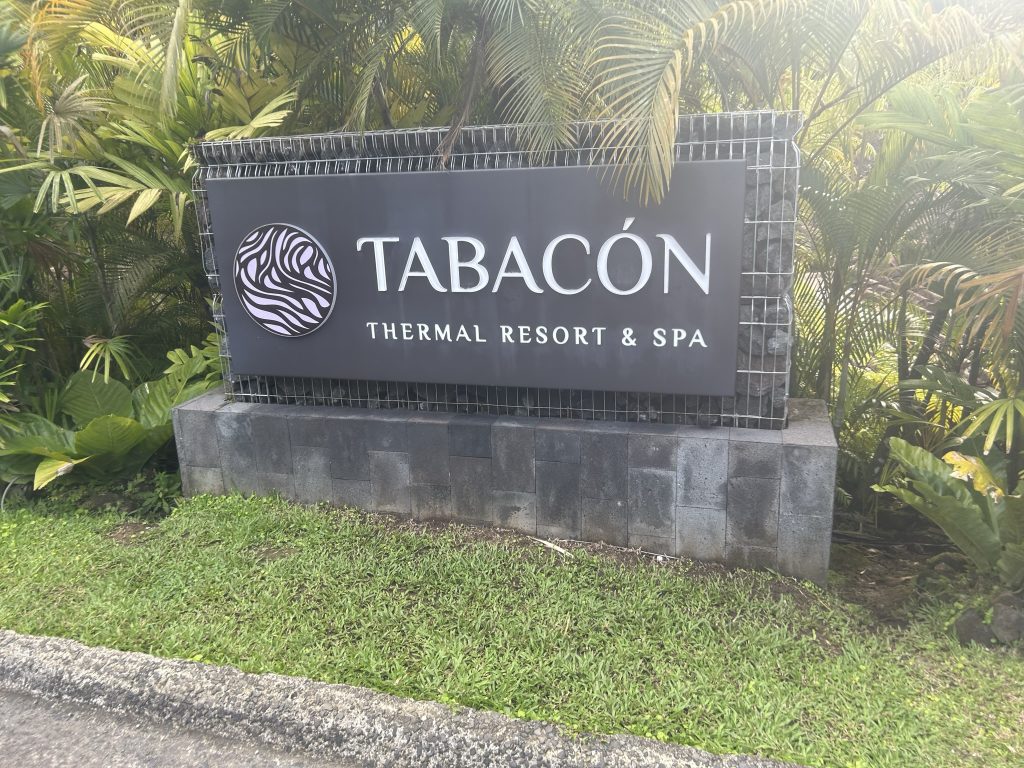

Exploring Tabacón Thermal Resort & Spa
Geraldo drops us off in front of Tabacón where staff greet us with hot towels and a refreshing cucumber-lime drink to sip while we check in. I am fretting a bit because I don’t have any cash to tip Geraldo (and I still feel guilty). While tipping isn’t as endemic in Costa Rica as it is in the United States and Canada, I want to tip the transfer drivers, especially those like Geraldo who have driven for almost three hours across rough roads and will go back the way he came without a return fare.
Tip: Make sure you bring some Costa Rica colons before you arrive in the country so you can tip drivers and tour guides.
After checking into the Tabacón, we are loaded into a golf cart with our luggage and taken to our room which is on the second floor of one of several buildings located on the gorgeously landscaped grounds. Our room overlooks Arenal volcano and on our first afternoon, we have our one and only glimpse of it. I’m glad I snapped this picture when I had the chance! For the next three days, we never see more than the bottom half of the volcano, and most of the time, we see nothing at all.
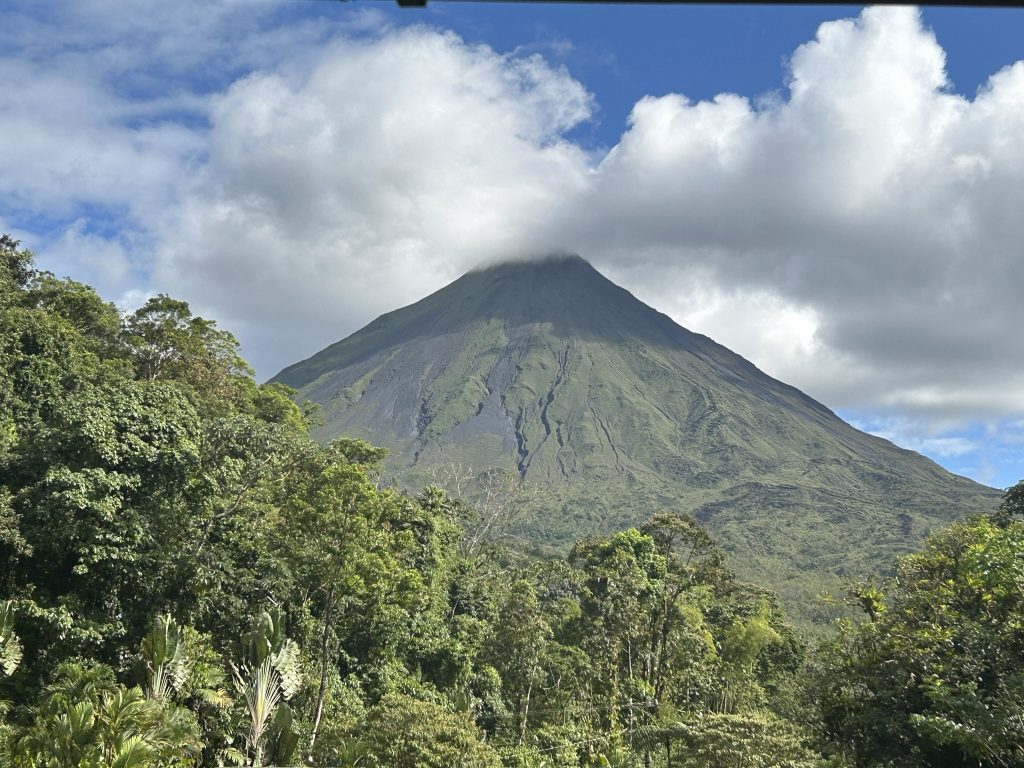

La Fortuna is in the rainforest which means it rains a lot. But wow – is it green!
Dipping Into Tabacón Hot Springs
After getting settled into our large, two-bed room, we pull on our bathing suits and set off in search of the world-famous Tabacón Hot Springs located about a ten-minute walk or two-minute van ride from the resort. The van that trundles back and forth from the resort to the hot springs, picking up and dropping off guests, is ubiquitous. We never wait more than three minutes for a ride. The level of service at Tabacón is remarkable.
The hot springs complex at Tabacón is out of this world. Seriously, I’ve never seen anything like them. Gorgeously maintained paths wind through the dense rainforest and skirt a plethora of warm-water pools and waterfalls. The sound of running water is constant. The guests-only area at the top of the property (and where the hottest pools are) is called Shangri-La. Talk about aptly named.
We wander around for a while before finally choosing a pool and lowering ourselves into it. Yesssss! The water flows straight from the volcano and is blissfully warm.
Here are a few photos.
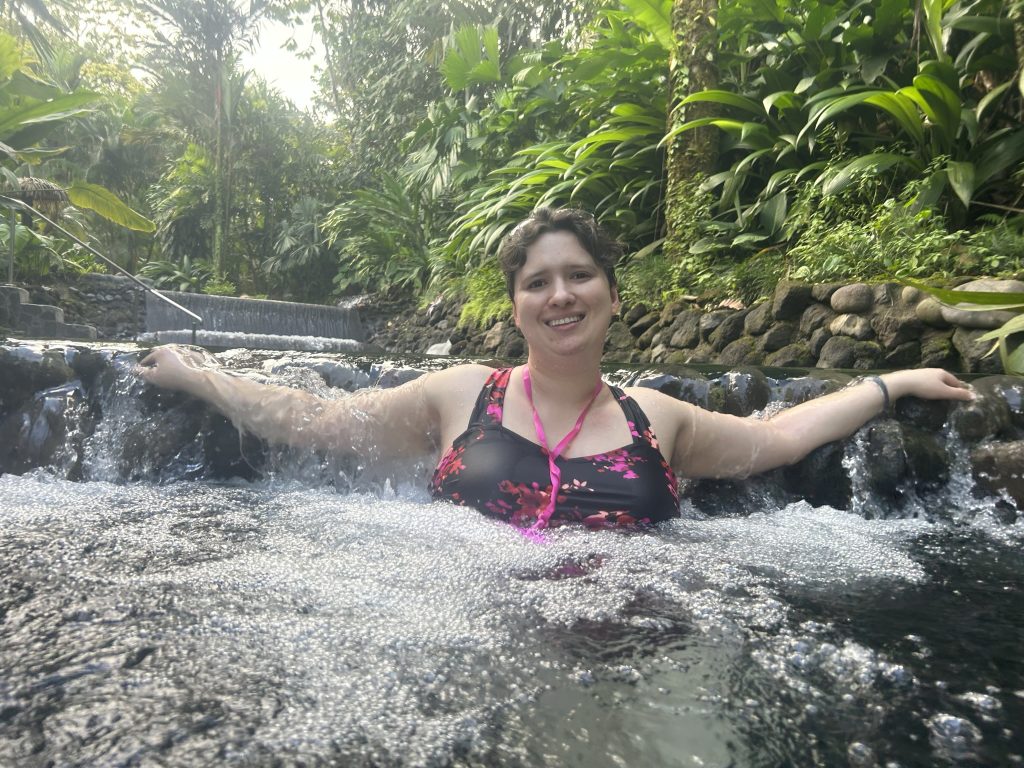

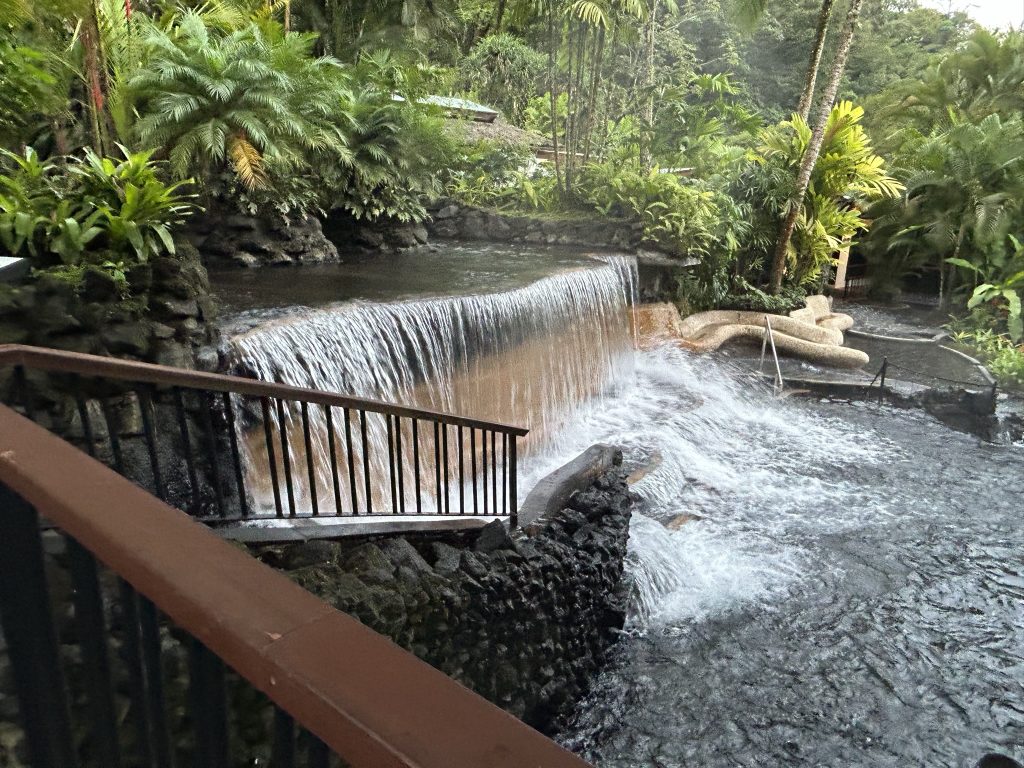

Night Tour
Our first tour of the trip (booked with Arenal Oasis Night Hike Tour by Pacific Trade Winds) is a night tour in the rainforest. Promptly at the appointed time and just as dusk is falling, a van pulls up in front of the Tabacón and in we pile. Upon hearing that the tour is the first of our Costa Rica vacation, our friendly guide, Luis, grins and says he’d better be good because he is setting the bar.
We pick up six more people and about twenty minutes later pull into the parking lot next to the pathways leading through the jungle. We are told to slather on the bug spray only in the parking lot so as not to harm the animals. This is the first of many such directives we are to hear in Costa Rica aimed at ensuring the well-being of the wildlife. Costa Rica takes its stewardship of the environment seriously, which I find heartening.
Exploring the Jungle at Night
Equipped with a flashlight and reeking of bug spray, we set off into the dark pathways. Seconds later, we stop as Luis set up his massive telescope and we all marvel at a sloth and her baby high in the trees.
From there the tour goes from strength to strength. Luis shows us a great many frogs and bugs and keeps up a fascinating commentary about what we are seeing. He shows us a bullet ant and tells us it has a bite so painful it lasts for 24 hours. I step well back.
A highlight is seeing these two little guys having a cuddle on a branch.
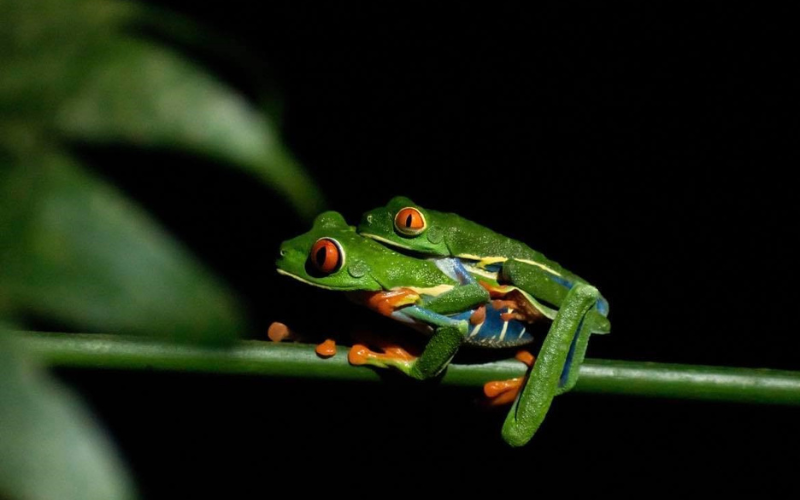

I ask Luis about venomous snakes and he informs me that the deadly fer de lance bites about 600 people a year, and of those about three to five die. Costa Rica has developed the anti-venom, and if people can access it in time, they will live. However, people who live in remote locations can’t always get it fast enough; hence, the death toll.
Checking out a Snake
With that cheerful thought to sustain me, I watch, fascinated, as Luis shines a light on Costa Rica’s seventh most venomous snake as it slithers alongside the path. I even get video.
Luis assures us that the snake will not bother us so long as we don’t bother him. Even so, I’m glad I’m wearing sturdy running shoes. One of the women in the group is wearing open-toed sandals. She doesn’t appear to be the least bit concerned, which is either very brave or very foolish.
We walk, stop, talk, and look for about two hours—and it is just marvelous! I’ve always wanted to explore a jungle at night (with a guide, lights, and the assurance that no wee beastie will kill me) and now I finally have.
I highly, highly recommend taking a jungle walk–or even two or three–during your time in Costa Rica.
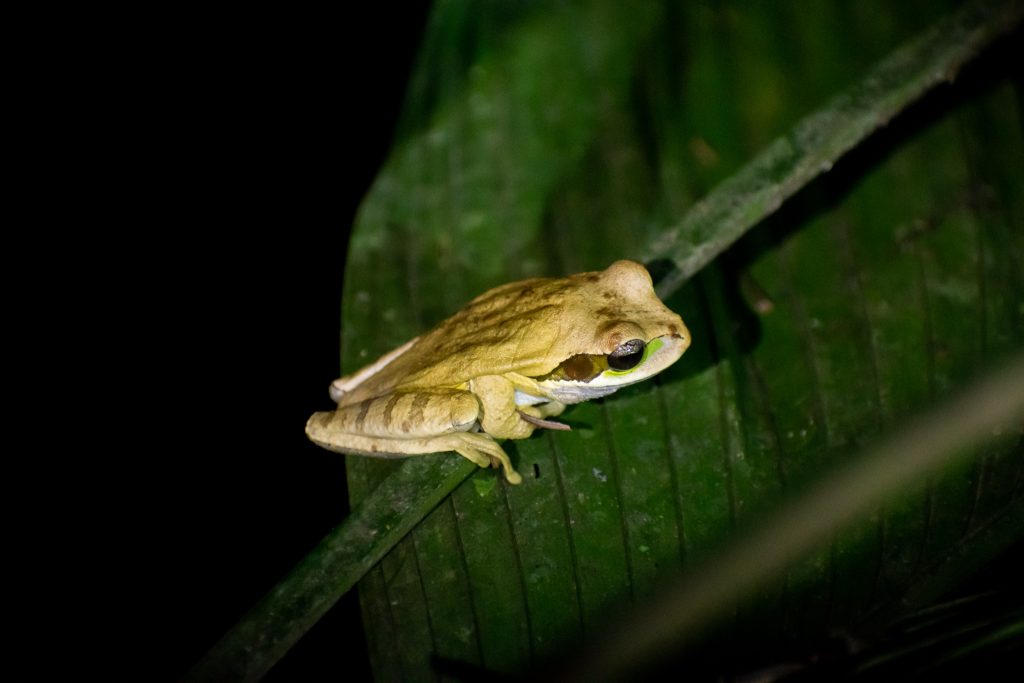

Tabacón Hot Springs at Night
We arrive back at Tabacón around 7:30 pm in time to enjoy dinner at one of the resort’s three restaurants, this one overlooking the hot springs. The prices are eye-wateringly high, but the food is good and afterwards, we spend another hour wandering around the hot springs in the dark. They stay open until 10 pm. And yes, it’s as awesome as it looks!
Strolling along deserted paths in the warm evening air with only the sound of rushing water competing with the constant hum of crickets is a memory I’ll cherish.
Day 3: Proyecto Asis Wildlife Rescue Center
We opt to spend our first full day in La Fortuna at the Proyecto Asis Wildlife Rescue Center because we want to support an organization that helps animals rather than exploits them. Proyecto Asis fits the bill. It’s a wildlife refuge, not a zoo or wildlife park—both places to avoid in Costa Rica since some do not have the animals’ best interests at heart.
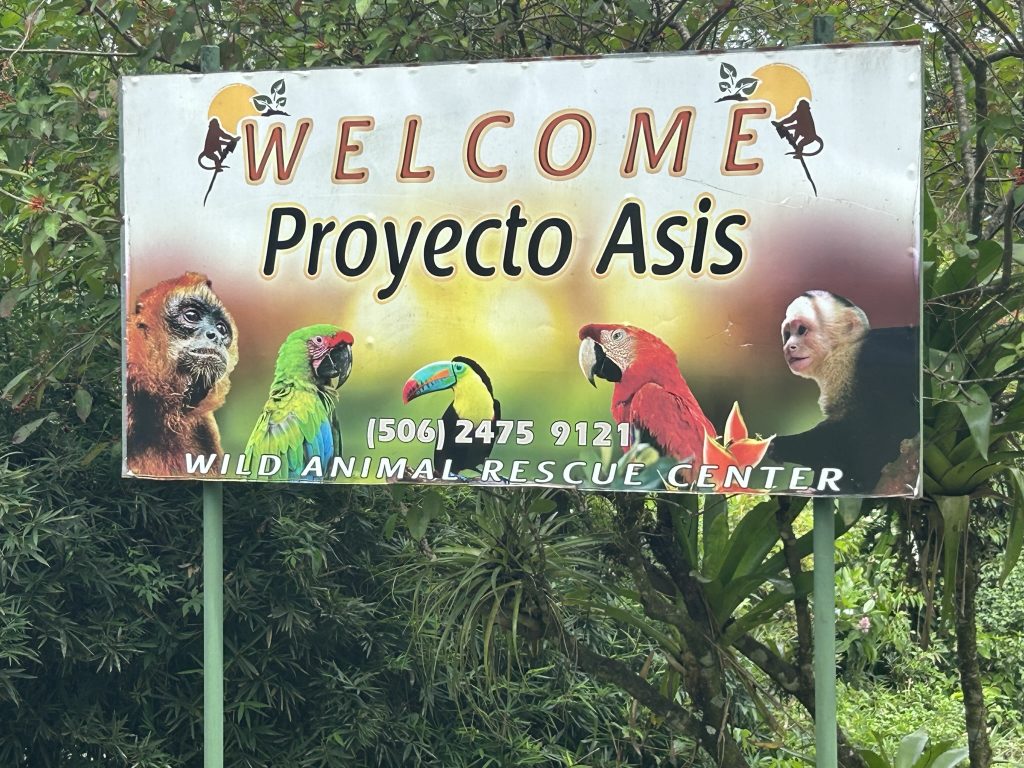

The Proyecto Asis has an excellent reputation and numerous 5-star reviews. Located about 45 minutes from La Fortuna in a beautiful area of farms and forests, the refuge was established in 2002 and serves as an animal rescue center, Spanish school, and volunteer center.
We have signed up for a full day of experiences that include a sloth walk in the morning, a long and informative visit to the wildlife refuge in the afternoon and then an hour of volunteering with the animals.
Our day at Proyecto Asis is a highlight of the entire two weeks in Costa Rica (and that’s saying something).
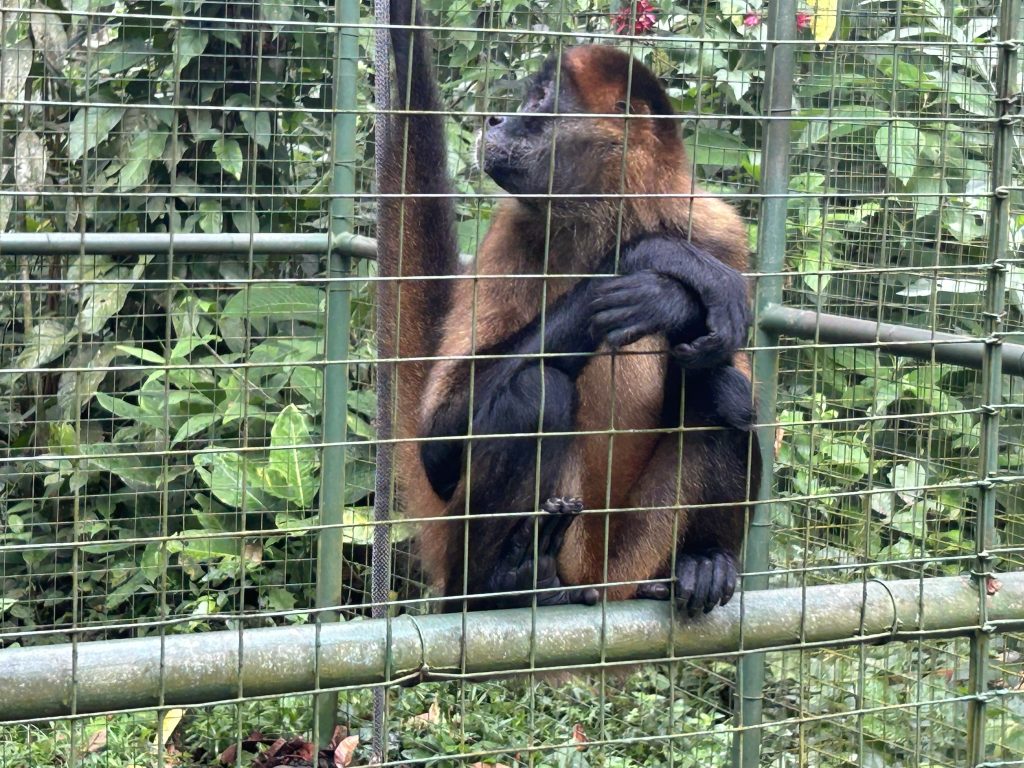

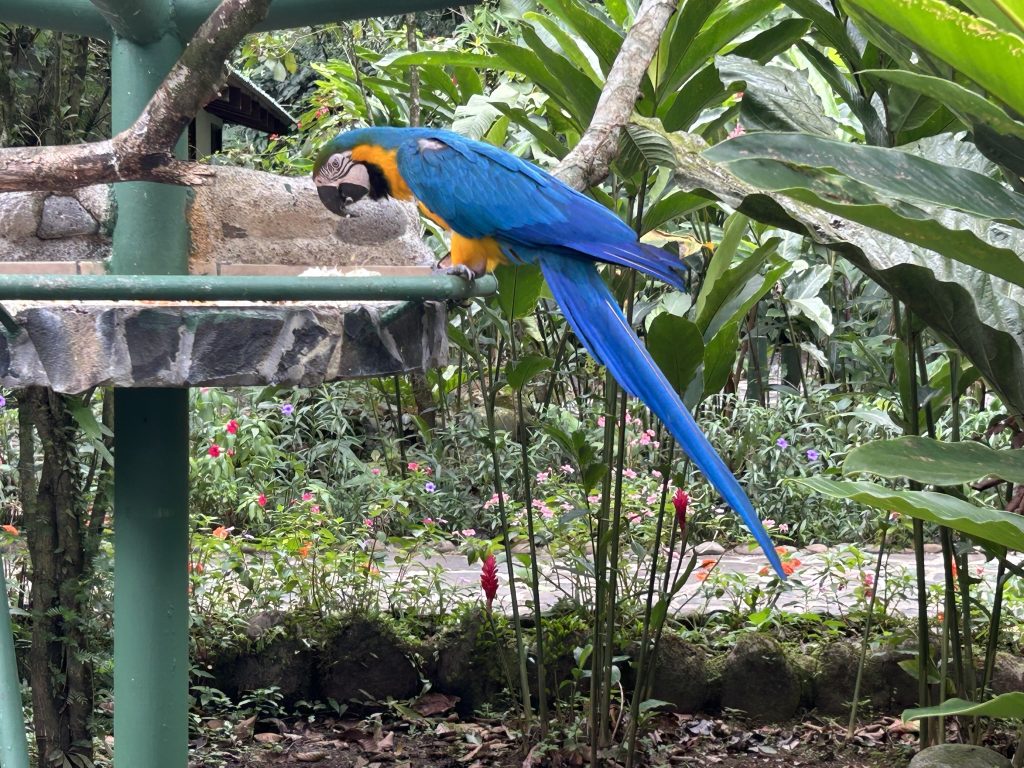

TOP TIP: The Proyecto Asis deserves a jungle full of kudos and support. If you are traveling to the La Fortuna area, make a point of spending the day there.
Evening in La Fortuna
After our fabulous day at Proyecto Asis, we are picked up and taken to La Fortuna where we wander around the tacky souvenir stores and spend time in the lovely municipal gardens, admiring the flowers. While there, a man approaches us, speaking Spanish. I immediately go into stranger danger mode and don’t make eye contact. I wasn’t born yesterday, after all.
The man keeps talking to me and pointing up, saying toucan, toucan. I realize that he just wants us to check out the toucan that has flown into a tree. Several other people–both tourists and locals–are also looking up. I smile and say gracias. He waves as he goes on his way.
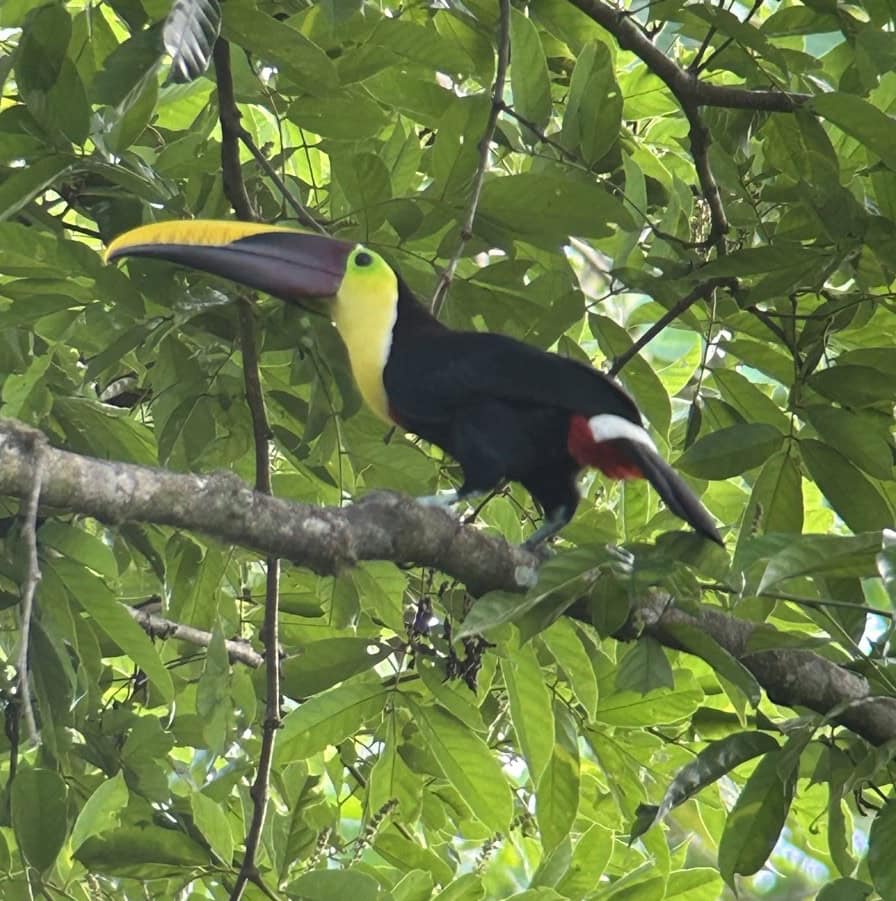

Throughout our time in Costa Rica, we often encounter local people who point out wildlife. I get the impression that people in Costa Rica are immensely proud of their country and enjoy sharing its beauties with visitors.
After our toucan encounter, we have dinner at a popular chicken restaurant. The food is pretty good and certainly the price is right—about $30 for two large meals and two cocktails. Can’t complain at those prices.
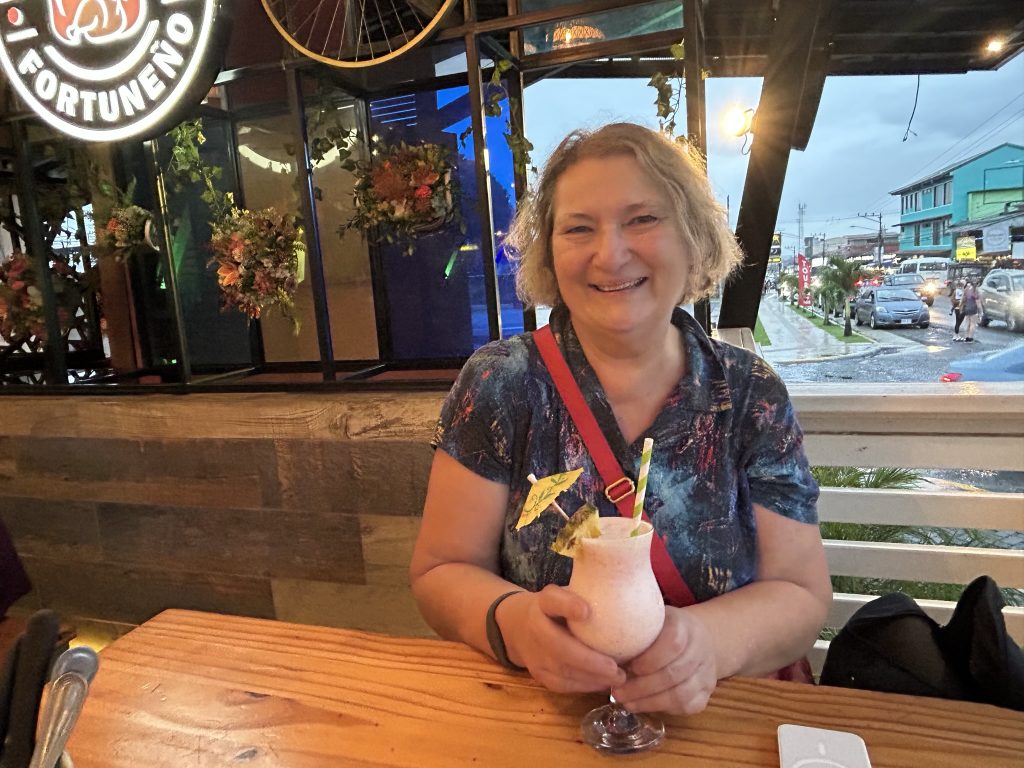

Taking an Uber in La Fortuna
After much discussion, we decide to risk taking an Uber back to Tabacón. Apparently, Ubers are not legal in Costa Rica, and we’ve read that taking them can be risky. On the other hand, we don’t see any taxis cruising the main drag, and our Uber app tells us that an Uber is five minutes away and will take us home for about $6. We decide to risk it.
We are still here to tell the tale. Taking an Uber in La Fortuna was easy, quick, and cheap. Go for it!
Once back at Tabacón, we spend another hour splashing around the hot springs before falling into bed for a well-deserved sleep.
Day 4: Whitewater Rafting
Ever since I was 16, I’ve wanted to go whitewater rafting. Finally, I am about to get the chance in Costa Rica. We’ve signed up for a full-day whitewater rafting trip on the River Bosa with Wave Expeditions. As we soon discover, the company has the whitewater rafting experience down to a fine art. They are an extremely well run and friendly operation, and I highly recommend them.
The bus picks us up at 9:50 and, after trundling around several other hotels to pick up more rafters, heads for the River Bosa, about 40 minutes away. Once there, we are kitted out with helmets, life jackets, and paddles; given a safety briefing; and then loaded into the raft that will be our home for the next two hours.
On the River Bosa
Julia is given the front row along with another woman about her age. Seated in the middle row is a man with his 80-year-old father (I am glad not to be the oldest person!), I am at the right side of the back row with our guide seated just behind me. Being so close to the guide is reassuring!
We wade into the river and moments later our guide pushes us and, while paddling, teaches us our two strokes – Paddle Forward, Paddle Backward and two actions: Lean In, Straighten Up!
Riding the Rapids
Seconds later, we hit our first rapids! Yowza!! I paddle furiously as instructed and experience the thrill of bouncing down the rapids. The water is cool but not unpleasant. At the back, I don’t get as drenched as Julia does up front.
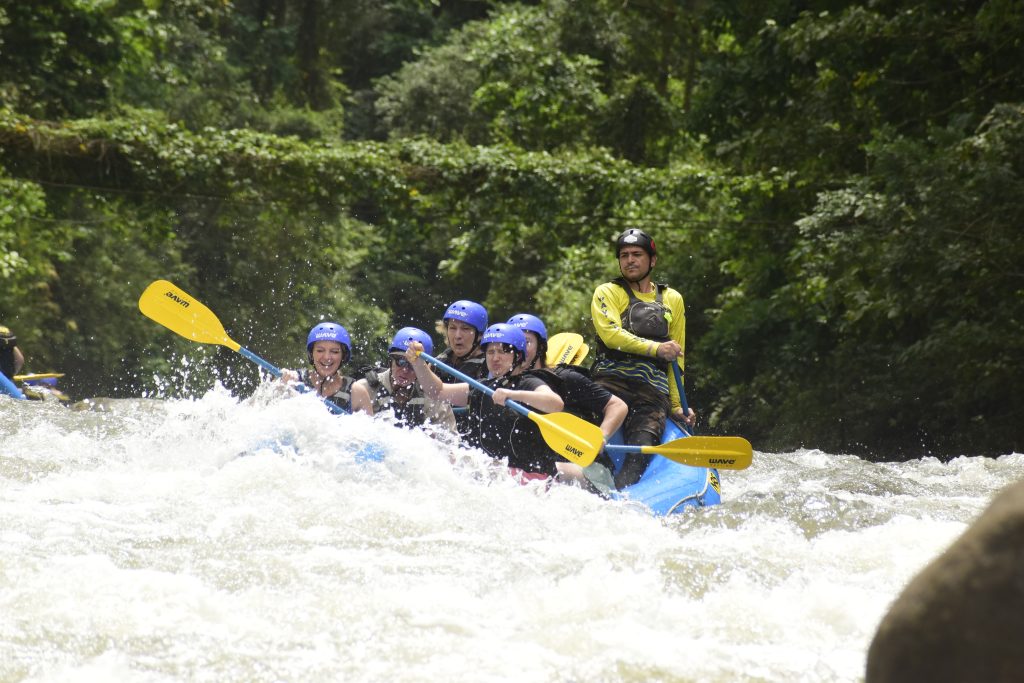

For the next hour, we ride the rapids, paddling and stopping, paddling and stopping on command. When the rapids peter out, we relax and float down the spectacular jungle river. It’s like being on the African Queen. Crickets buzz in the air and the equatorial sun feels deliciously warm on my skin. I’d forgotten sunscreen but fortunately, I don’t get burnt. Unfortunately, Julia does.
The Joys of Whitewater Rafting
The rafting is not for the faint of heart. It is strenuous, wet, and to be honest, kind of painful. I’ve wedged my feet so tightly under the edge of the inflatable seat in front of me that by the end of the trip, I’ve lost all feeling. But I don’t care. I’ve loved every minute of it—the adrenalin rush, the paddling with muscles screaming, and then the restful drifting with time to gaze at the trees, the sparkling water, and the hard blue sky.
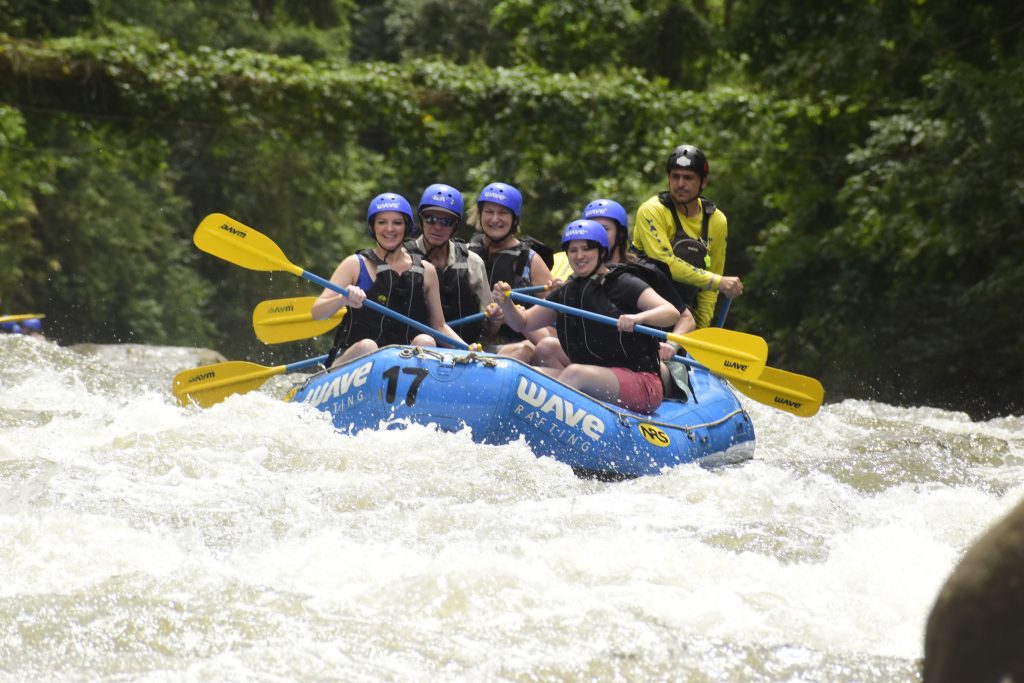

Spotting Wildlife on the River
We spot a baby sloth in one tree and many large birds – mostly herons and egrets. What a beautiful country! Rafting down the river makes me feel so connected with nature. All I need to think about are my arms holding the paddle and my foot jammed under the seat ahead to prevent me from falling in.
Along the shoreline, the trees form a soaring wall of green in a myriad of textures and shades. The rainforest is thick and impenetrable and teaming with wildlife. Nature is winning here, as it should. I feel small out on the river as I surrender to its current pulling us downstream.
Getting a Good Work-out
My muscles respond to the paddling with gratifying power, making me glad I persevered over the winter with strength training and of course, Nia. I am determined not to be the person who drags down the group! That honor belongs to the man in front of me. At 80, he is to be admired for braving the river, but the trip doesn’t go well for him. Violent jolts and shudders play havoc with his two artificial knees and twice he loses his paddle. I feel sorry for him, but also wonder why he was allowed on the trip. The age limit is 65, which means I’m pushing it at 66. But 80? Anyway, he survives, although at times I wonder if there is any provision for pulling out someone who gets injured en route. I rather doubt it. I certainly don’t see any roads near the river, apart from the one time we float under a bridge.
Julia Gets an Unwelcome Jolt
Just before our one stop, we hit an especially violent rapid. Julia wrenches her neck and spends the next twenty minutes in acute pain. I have visions of her languishing for the rest of the vacation in traction, but fortunately, we pull into a pebbly beach for a break, giving her a bit of time for stretching and rest while the hard-working guides serve us fresh watermelon and pineapple.
Back in the raft and with my foot no longer numb and sore, I feel energized and proud of myself! We paddle for another twenty minutes or so to the end of the tour.
At our last rapid, I feel but don’t see our guide seated behind me jump high off the raft. The company has photographers along the shore to capture the moment, with the photos then made available for sale.
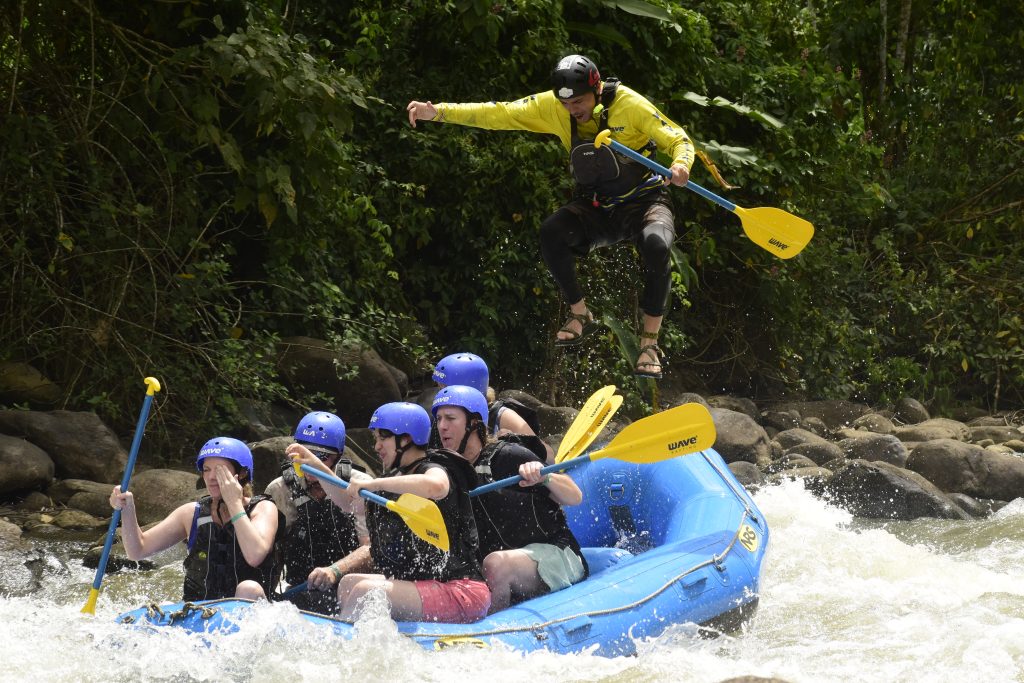

I clamber out of the raft and into dry clothes, happy at my accomplishment, although Julia’s neck is still not great. After another 30-minute drive, we enjoy an excellent lunch of typical Costa Rican food at a local farm. The place is set up to serve a buffet lunch to tour groups and then afterwards demonstrate how to extract sugar syrup from sugar cane. I’m not a big fan of these group things, but it is well done and helps the local economy, and I wouldn’t have seen it otherwise.
Relaxing in Shangri la
In the evening, Julia takes her sore neck to the massage table at the Tabacon, and I find a comfy palapa up in the guests-only Shangri la section of the hot springs. As darkness falls and steam from the hot springs envelops the area, I spend a glorious, womb-like hour, sipping a rum drink, writing on my laptop, and listening to the sound of rushing water all around me.
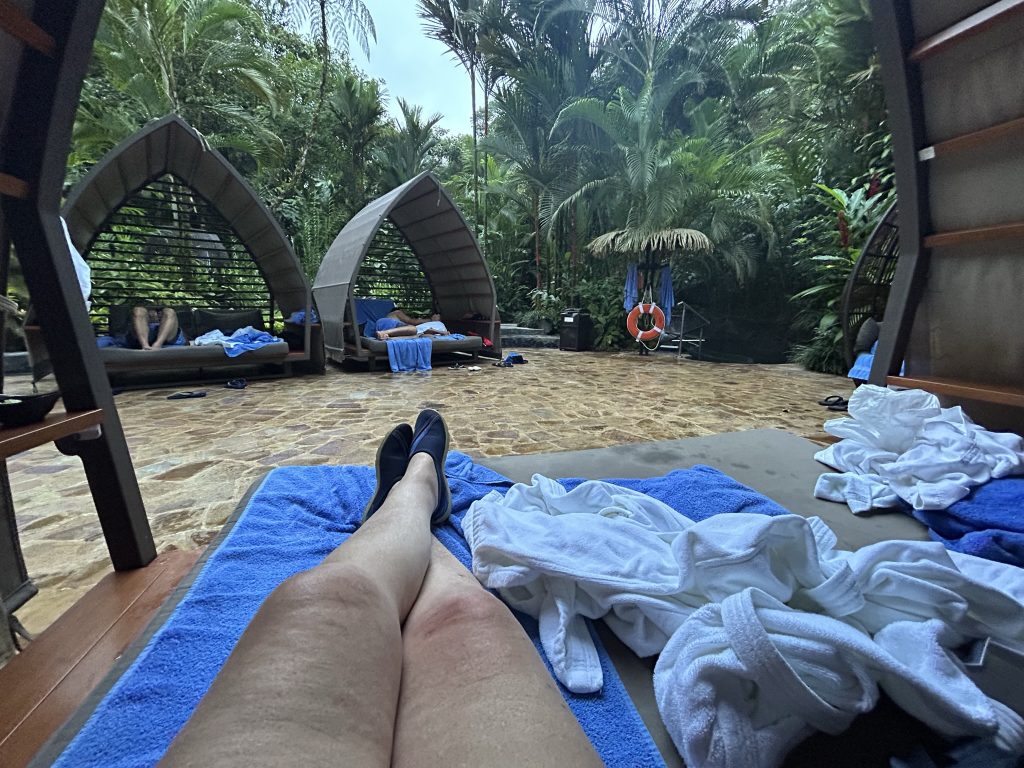

Day 5: Drive from La Fortuna to Monteverde
We rise to pouring rain and cool temperatures. The rain glistens and bounces off the lush foliage nourishing the riot of massive plants outside our room. At one point, about twenty coati scamper past as we walk down to breakfast under massive umbrellas provided by the resort.
Getting the Van to Monteverde
At the required time, we trundle our luggage to the reception area. The turnaround is clogged with the ubiquitous white vans that crisscross the country carrying tourists, including us–twice so far. We expect to be pick up by the same type of van and so don’t pay any attention to the massive, old-fashioned school bus trying to fight its way past the guard and into the holding area.
I idly watch as the guard shakes his head while consulting his clipboard. The bus must be picking up a large group, which puzzles me since there are only a few other couples waiting.
A white van pulls up and we walk confidently towards it. Another couple darts past us and boards. Oh well, there will be another soon. We have all morning.
We Get a Surprise
Meanwhile, the guard at the gate waves the school bus forward. Much to the obvious irritation of the ten other vans and small buses and cars in the cramped turnaround, the school bus now needs to reverse to navigate the turnaround so that the driver can pull up in front of the hotel. I wonder at the antiquity of the bus. It looks out of place next to the sleek new vans. Finally, the doors accordion open and a young man jumps out.
“Cram?”
Oh.
The massive bus is for us. Only us. How embarrassing. We scurry on and lie low while the driver spends another ten minutes shunting forward and back to get the monster out of the turnaround without denting the other cars. He deserves a medal.
But this huge bus just to transport us? Well, we’d booked private transfers, and this is the result. Feeling terribly guilty at the extravagance, I realize there is nothing I can do but settle in for what turns out to be a short and bumpy ride to a muddy track leading to the edge of a lake. The bus hovers at the top and I want to tell the driver that no worries, we are happy to get out and walk down.
But no, he is an ambitious guy. He executes a perfect twenty-point turn to maneuver the bus around so its back is to the water and then reverses down the muddy slope that is steep enough to make me fear for the efficacy of his brakes. But my fears are unfounded.
Sailing Across Arenal Lake
The bus grinds to a halt, out we jump and moments later we and our luggage are handed into a boat that probably seats at least 40 people. Except there are not 40 people. There is only us—two people, one captain, and a lake in the rain.
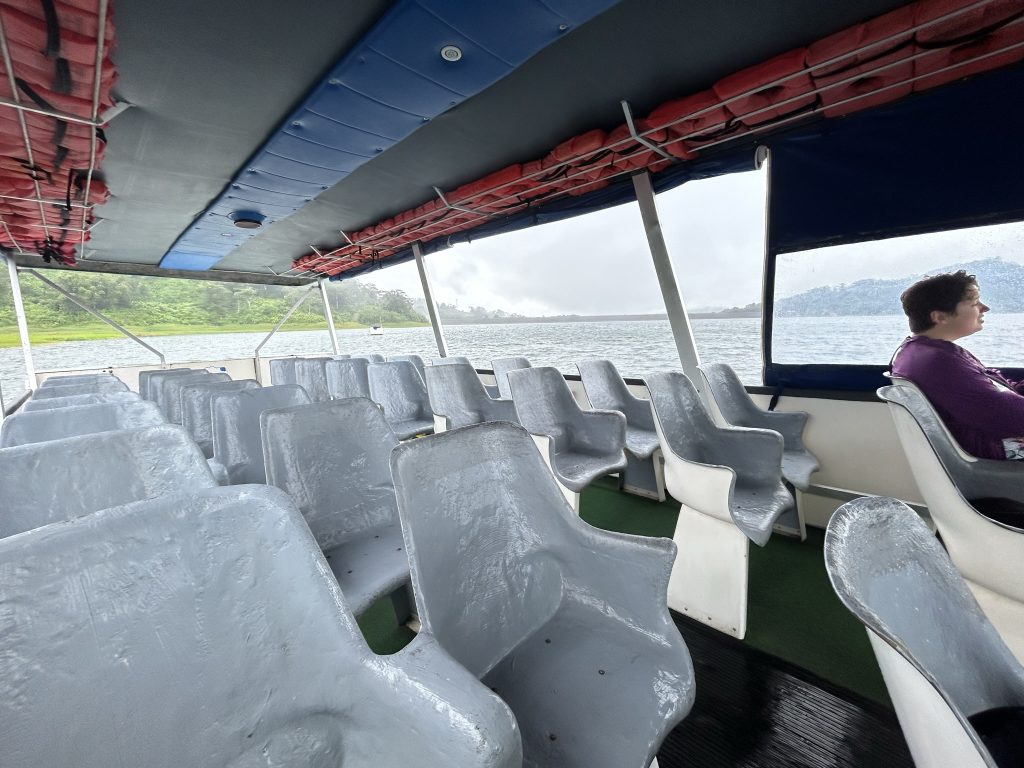

The boat captain doesn’t appear to mind. We take off for the 30-minute ride. On a clear day, the views of the Arenal volcano would be amazing. But even in the misty rain, there is still charm. I snap pictures and enjoy the warm, wet breeze.
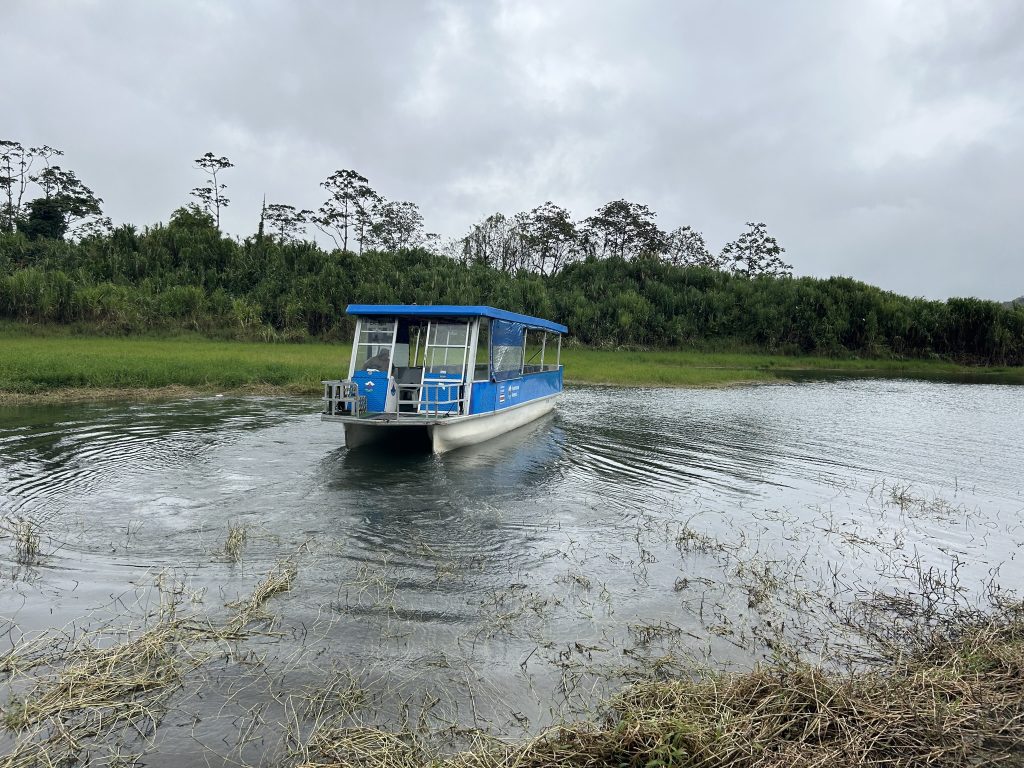

On the other side, we are met by the third and final driver engaged to get us to Monteverde.
Good-bye to the Lake
Before setting off, we need change to tip our boat captain. I don’t think he necessarily expects a tip, but I have no idea how much he gets paid, and I feel guilty that he had to take an hour out of his day to transport two chicas across the lake. There doesn’t appear to be anyone waiting for him to take back across, so he’ll be returning empty. I ask the bus driver if he can change a 20,000-colón note and he obliges by giving me US dollars, which is not what I mean. I just want to break the bill! Anyway, I end up with 20,000 colóns worth of US dollars so I give our boat driver $5. He is delighted!
And now for phase 3.
En route to Monteverde
We hop into the van, thankfully one of the regular 7-seater types, and minutes later we are bumping up a dirt track that switch-backs up a mountainside.
I hadn’t realized that the Monteverde Cloud Forest would be, by definition, in the clouds as in not at sea level. The drive of about 40 kilometers takes two hours of bumping and swerving around potholes, crossing narrow bridges, and navigating hairpin turns.
As the toucan flies, Monteverde is quite close to Arenal. But we are not toucans and the track we are being driven up would be deemed unfit for vehicles back home.
At first, we see little, apart from the thick red mud of the road and the dense green of the undergrowth. But as we gain elevation, the rain clears and the views over the rainforest are breathtaking. When I’m not marveling at the view, I am marveling at the skill of our driver. He is only about 20, but no pothole nor sharp turn fazes him. He just keeps trundling up and up and up.
Arrival at Santa Elena in Monteverde
Monteverde is a cloud forest, which differentiates it from the rainforest on the slopes of Arenal from whence we’ve just come. The cloud forest is, by definition, in the clouds, so rain and misty conditions are the norm.
We are fortunate that high winds have kept the mists at bay. During our two nights, we experience several sudden rain squalls, but they blow away quickly, leaving behind vivid rainbows.
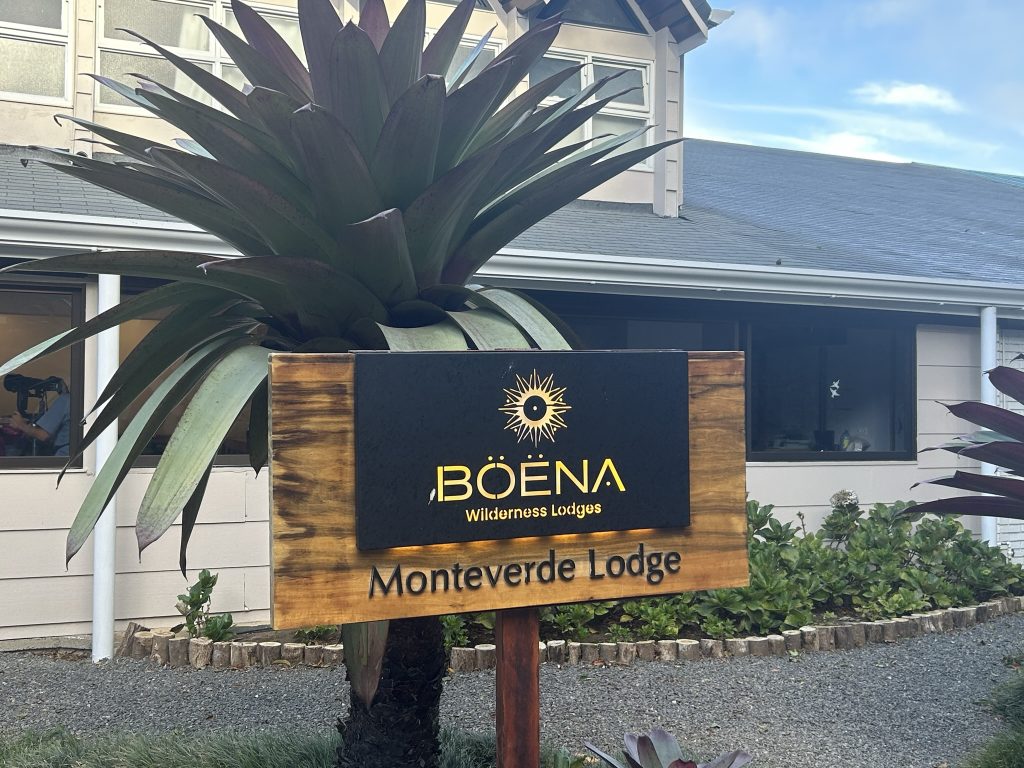

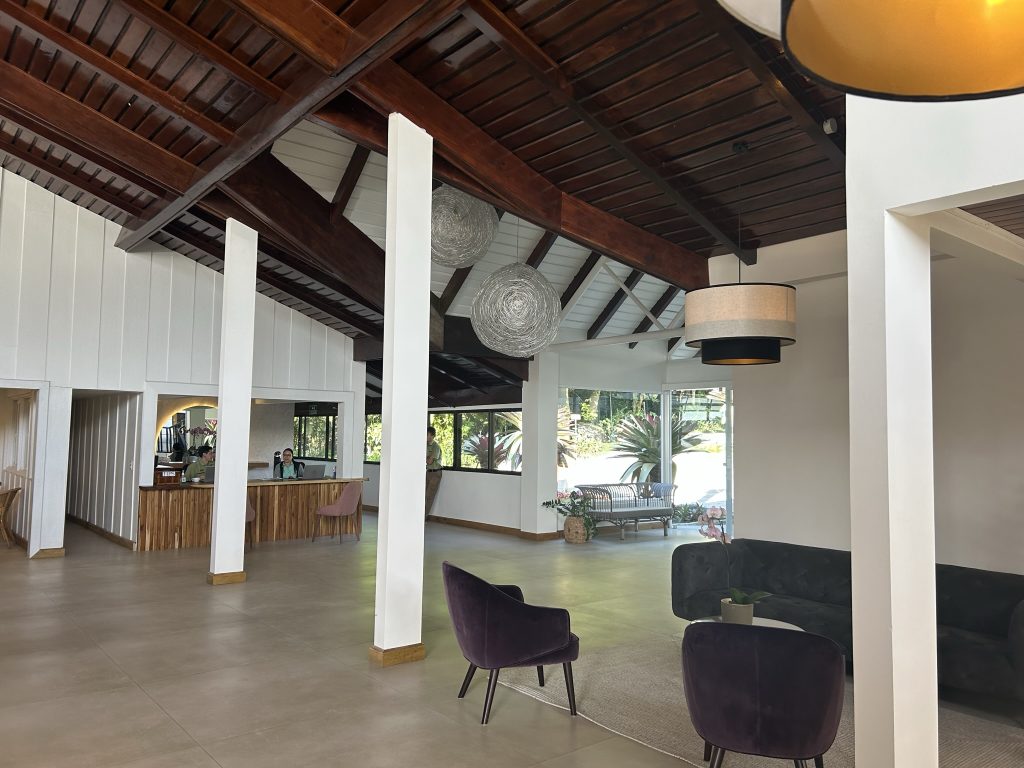

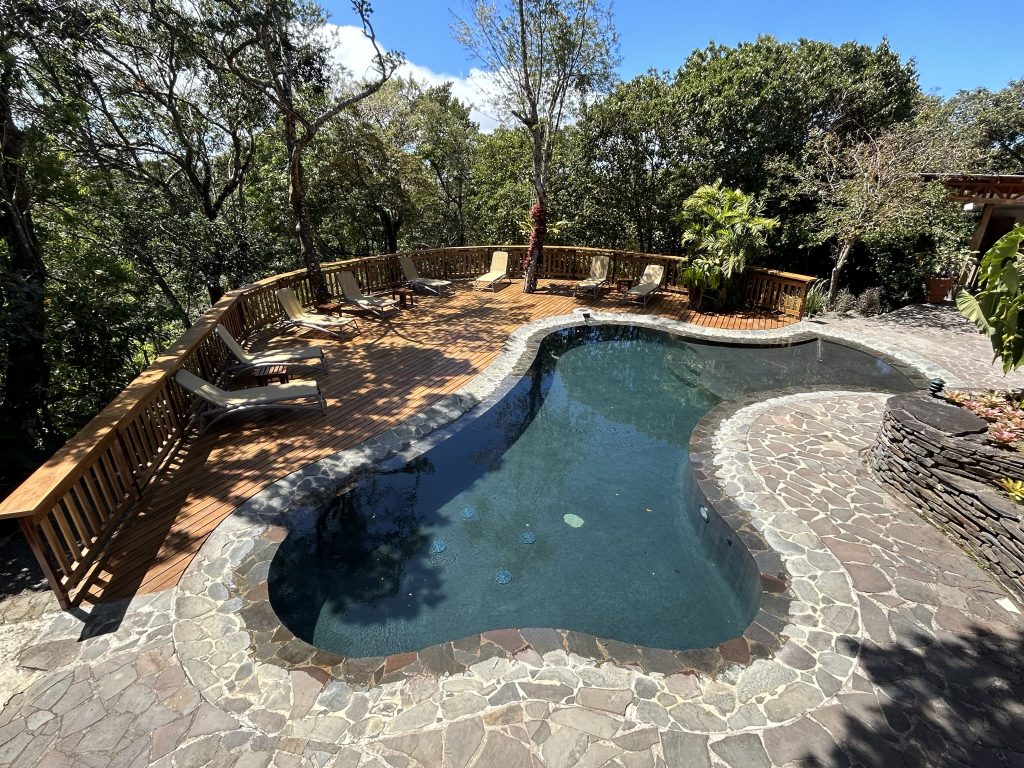

The hotel is located close to Santa Elena, the tiny town that is the main hub in Monteverde (which is the name of the area, not the town). After getting settled, we start walking into town in search of lunch. Still acclimatized to the tropical warmth of Arenal (even in the rain), we wear light dresses. Big mistake! Within seconds, my hat blows off and the wind tears at my skin. The next time we venture out, we wear hoodies, pants, and rain jackets.
Checking out Santa Elena
We brave the wind and 16-degree C. temp and stroll down a steep hill to the town. Lunch is a tasty Casado with breaded fish. Casado means marriage and is a bringing together of Costa Rica’s typical foods—rice and beans (of course), a fresh tomato salad, fried and caramelized plantains (my personal fave), various other veggies, and the star of the show—beef, pork, chicken, or fish either breaded or grilled.
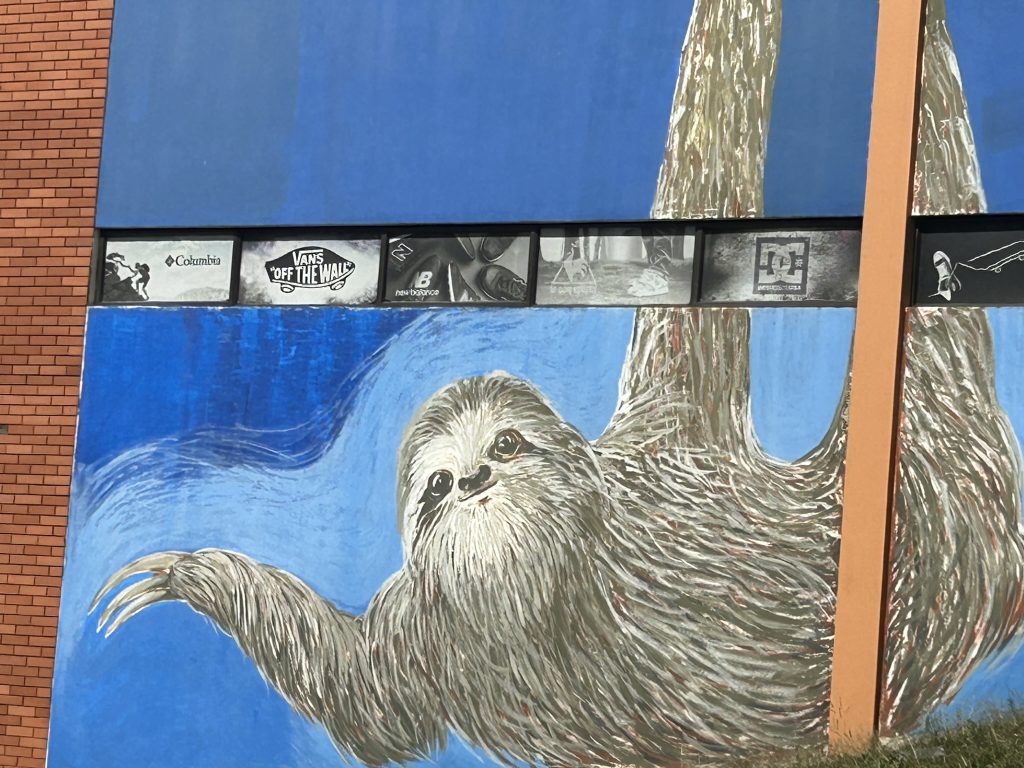

After lunch, we cruise the large souvenir store because we are huge suckers for souvenir stores. The prices are considerably less than in Arenal so I pick up a ball cap emblazoned with Pura Vida, another pound of coffee for Gregg, more chocolate (OMG, to die for), a wooden bowl thing (just because I like it) and my favorite, a mobile of brightly-painted wooden toucans. I’d seen one in Arenal that I liked that cost $30 USD. This one costs $18 and is much nicer.
Enjoying Monteverde Lodge and Gardens
We head back to the hotel with our purchases, and I enjoy a wee nap in the sunshine streaming in through the terrace doors, accompanied by the sound of the seriously babbling brook that flows directly in front of our terrace.
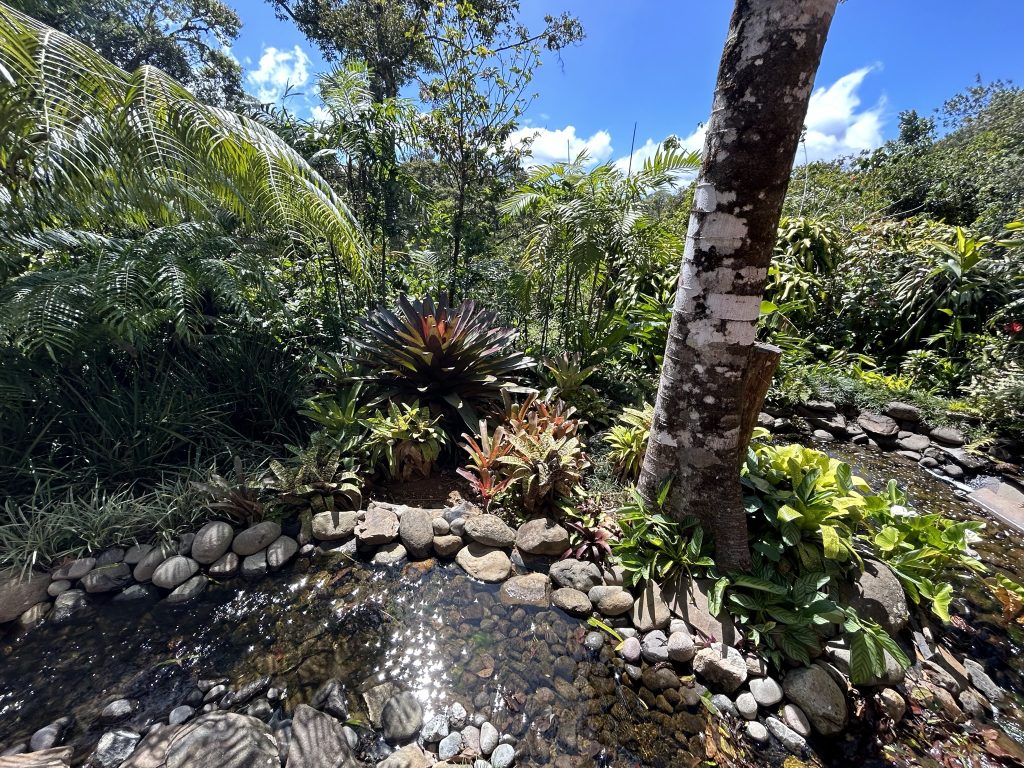

We then wander around the property looking for monkeys and birds and taking pictures before having dinner at the hotel. The food is good but not fabulous, considering the cost. But service, as it is everywhere in Costa Rica, is impeccable—friendly, helpful, and genuine.
Day 6: Cura Cancha Wildlife Reserve in Monteverde
The next morning, we are up bright and early for our walk in the cloud forest. Pacific Trade Winds has chosen a tour of the Cura Cancha wildlife reserve, which is supposed to be a bit less crowded than the Monteverde Cloud Forest reserve, although it doesn’t look empty of tour groups to me.
Our wonderful guide (all our guides in Costa Rica are first-rate) enthusiastically guides us for two hours through the cloud forest. Massive fiscus trees dominate the trails. We stop frequently to observe birds, which are the main event at Cura Cancha.
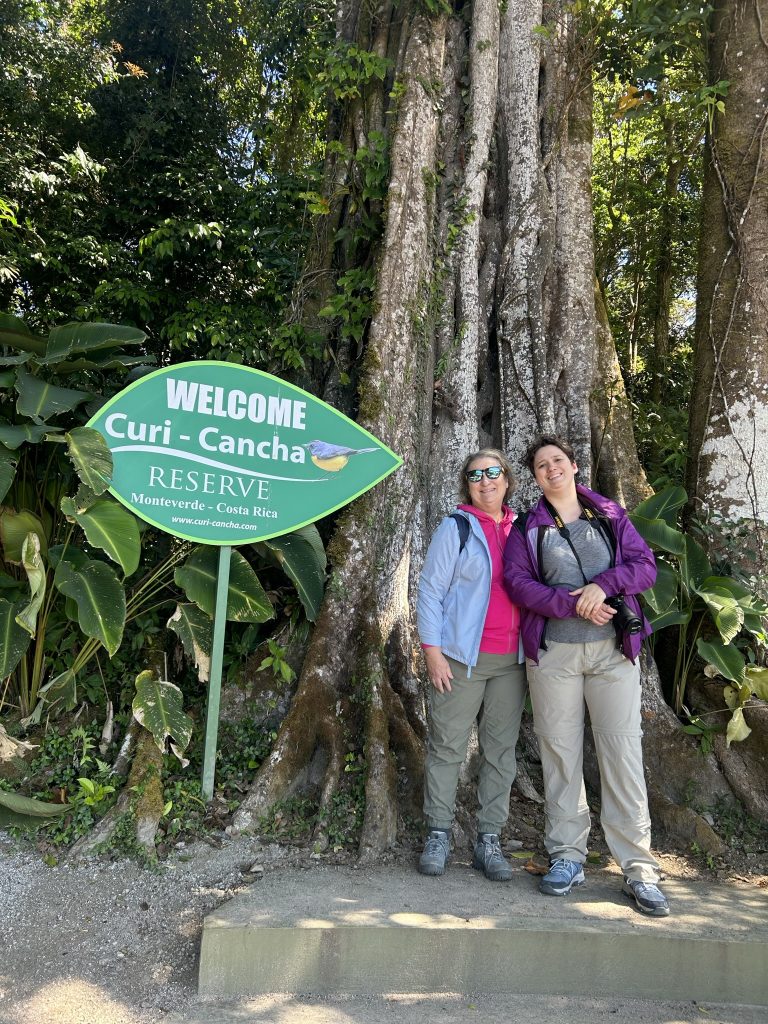

Spotting the Elusive Quetzal
At one point our guide, along with most of the other guides, converge in front of a large tree that allegedly houses a quetzal, the national bird of Costa Rica and exceedingly rare. This is a huge deal, apparently! Our guide is over the moon. He trains his massive scope on the quetzal who obligingly stays put for quite an impressive amount of time. It is a male, although how the guide knows, I don’t know.
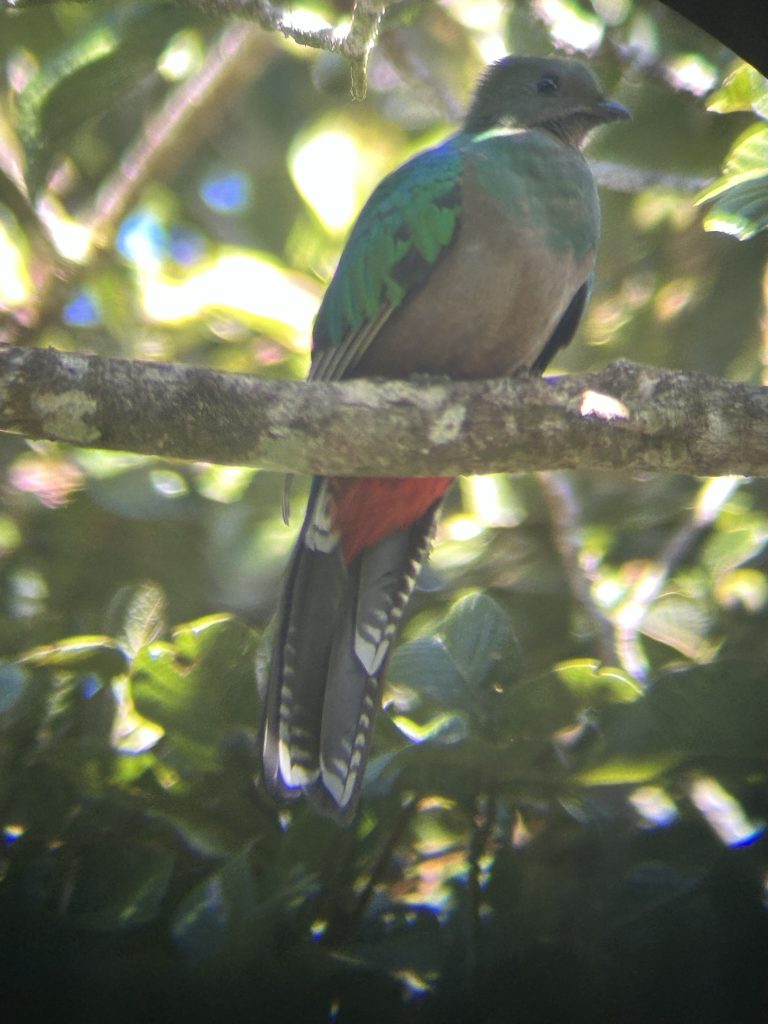

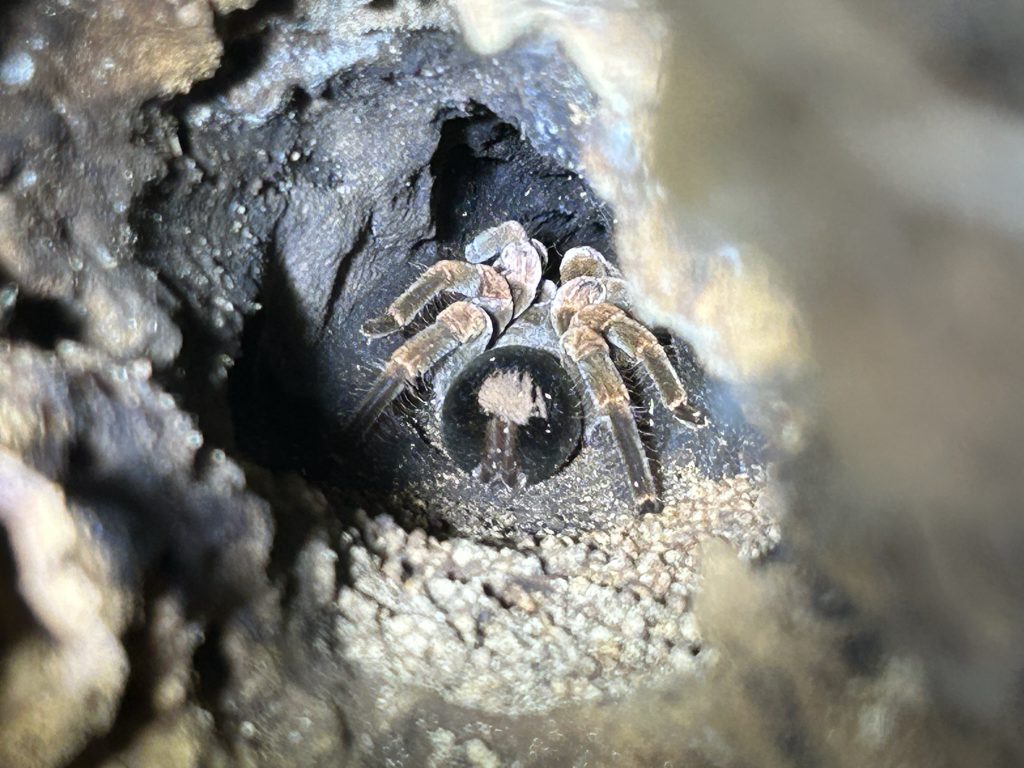

After we all recover from the excitement, our guide spies a second quetzal—a female. Apparently, the chance of seeing even one quetzal on a typical walk is about 5%. Seeing two is almost unheard of.
Spotting a Tarantula and Learning of Its Untimely Demise
We continue our walk, spotting plenty more birds and at one point stopping to peer into a large dark hole to check out a very large, very hairy, very striped tarantula. Julia is horrified. I get a picture. We learn that larvae lay their eggs inside a living tarantula and then, over the course of 25 days, slowly eat the beast from the inside out. The tarantula is sentient the whole time. I mean, I’m not a huge fan of tarantulas, but that’s a fate no beast deserves.
The walk is a gentle, enjoyable way to spend the morning. We learn a lot about the ecosystems, see plenty of birds, and enjoy the beauty and quiet of the cloud forest.
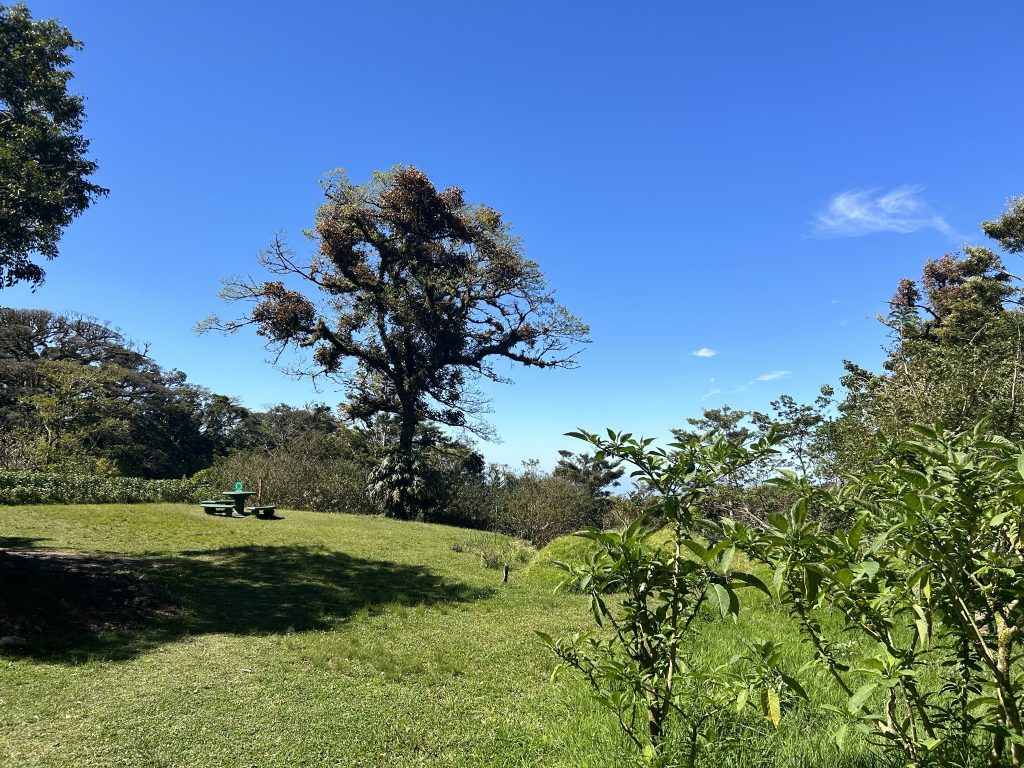

Afternoon and Evening in Monteverde
When we get back to the hotel, we cross the road outside our hotel to a shopping center where we enjoy one of our best meals so far. We make a reservation to return for dinner and then cruise several of the souvenir shops in the complex (of course).
We book another night tour at the hotel but alas, it is cancelled a few hours later because of high winds. Apparenty, walking in the cloud forest during high winds can be hazardous to one’s health.
Later in the evening, we return to find that our chosen restaurant is about to host several large tour groups. We opt for a different place nearby where, as it turns out, the food isn’t quite so good, but certainly okay, if not gourmet, and better value than the hotel restaurant. I’d rather spend $35 for okay than $80 for okay.
We just manage to stay up to 10 pm before we both succumb to sleep. Birdwatching is hard work!
Day 7: South to Manuel Antonio
We leave the Monteverde Lodge & Gardens at 10 am for Manuel Antonio on the Pacific coast and the start of the most tropical part of our Costa Rica sojourn.
Getting to Manuel Antonio from the Monteverde Cloud Forest is just as adventurous as our journey from Arenal. I can’t believe a bus can make it up the hills and over the numerous deep potholes. But our driver is phlegmatic. He jolts his way down the steep and narrow mountain road until we finally hit the lowlands and then it is smooth sailing to our hotel in Manuel Antonio.
Gawking at the Crocs
On our way, we stop at the famous crocodile bridge. Way below the bridge in the muddy river, dozens of huge crocodiles lazily drift. I can’t help wondering what would happen if anyone fell off the bridge. It wouldn’t be pretty.
We hop back in the van and keep heading south.
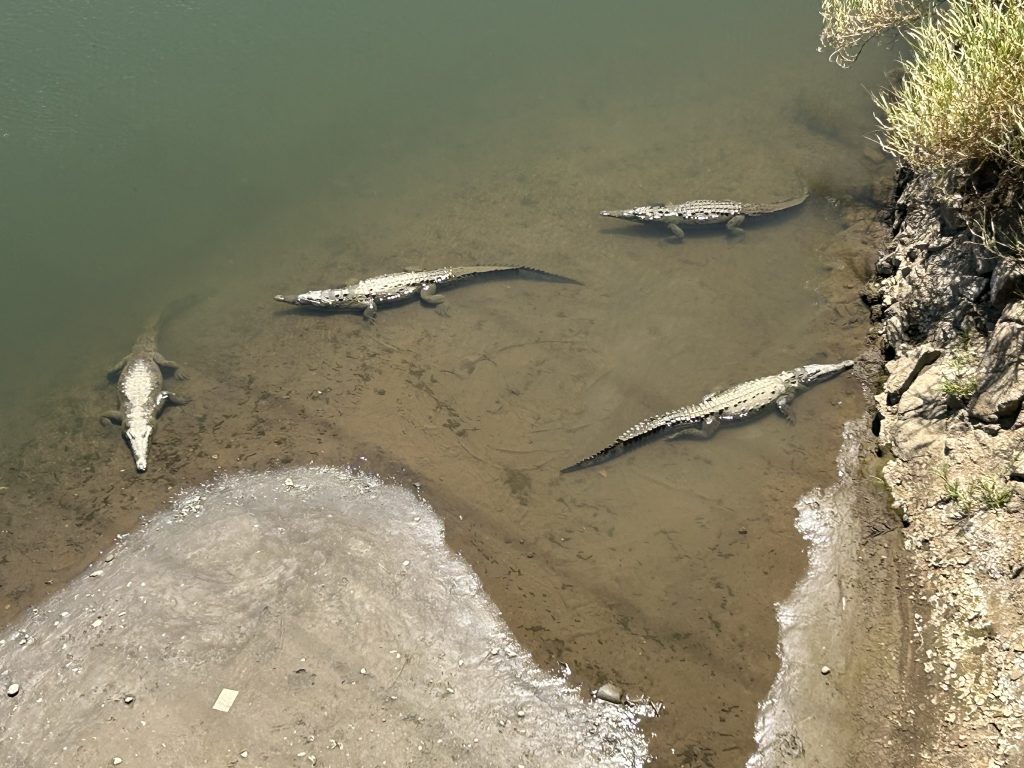

After three hours (including two stops), we pull up in front of Si Como No Hotel. Perched high on a hill between the small towns of Quepos and Manuel Antonio, the hotel has one of the most spectacular views of the Pacific Ocean in the area (or at least that’s what the hotel claims and it’s hard to dispute).
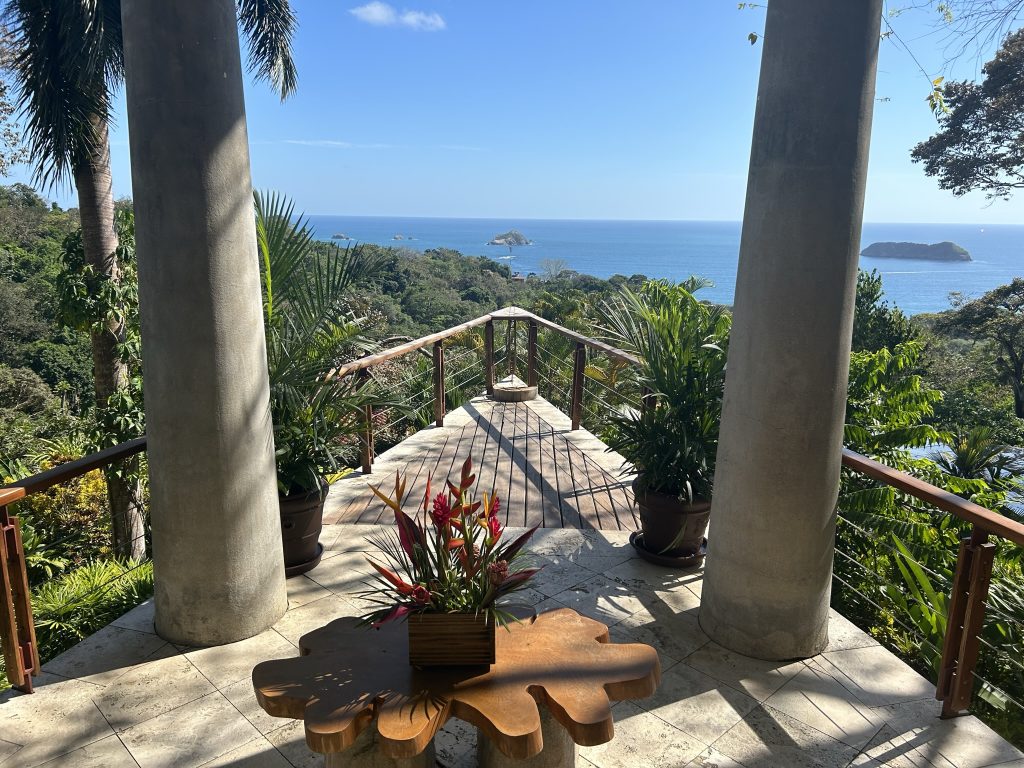

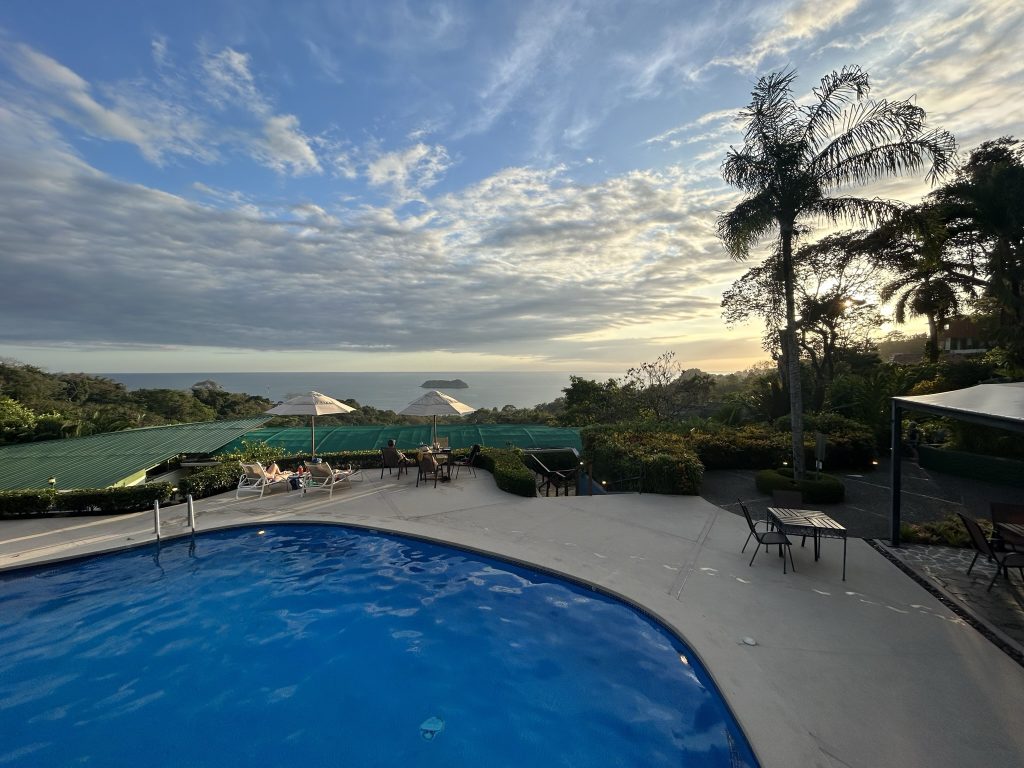

We settle into our spacious room overlooking the ocean. The hotel is a bit dated – lots of heavy wood – but as usual, the service is impeccable. The food, unfortunately, is mediocre at best so after a disappointing lunch, we decide that going forward we’ll eat at one of the restaurants about a five-minute walk down the road towards Quepos.
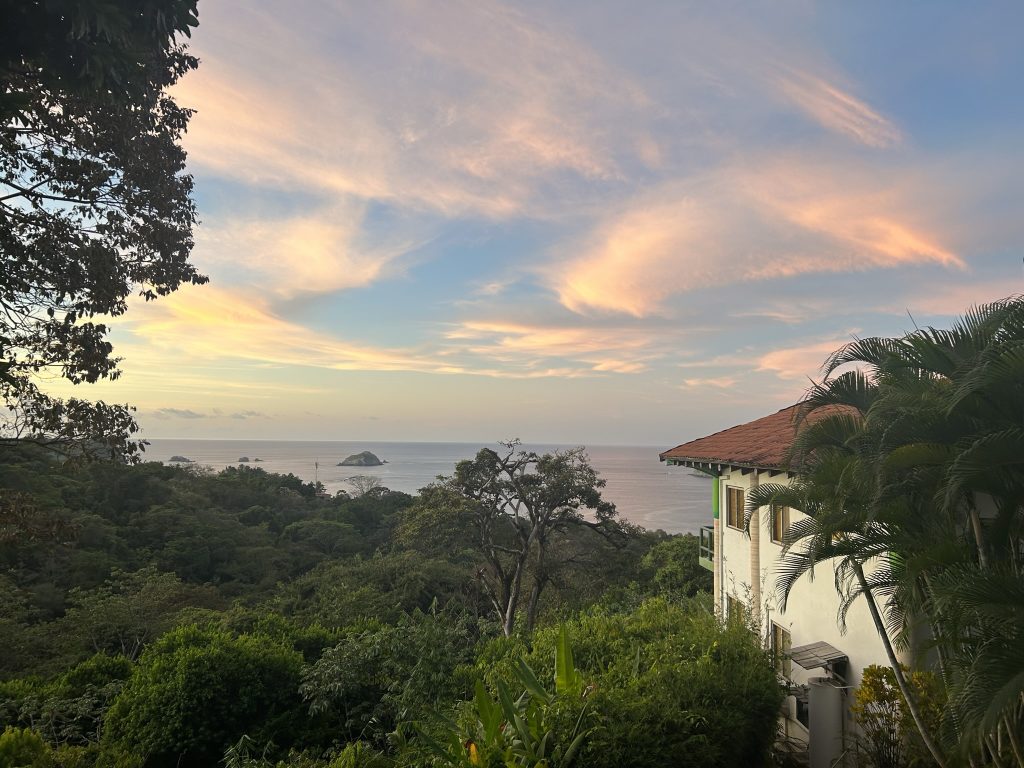

Hanging Out at Si Como No Resort
We find the adult pool and settle in for an afternoon of R & R with our two-for-one happy hour drinks. I satisfy my lifelong dream to order a drink at a swim-up bar. We perch on the ceramic stools and sip our cocktails (a bit watered down, but whatever—they’re two-for-one!).
Later, as we lounge in the pool, two scarlet macaws soar overhead. Seeing them flying free in the wild is a huge thrill. I’d seen plenty over the years in zoos and tropical gardens, their wings clipped so they couldn’t fly. But they are supposed to fly! Two by two, they streak across the blue tropical sky, their long tails streaming behind them, flashes of brilliant scarlet blinding in the sun. They move too fast for pictures, but it doesn’t matter. Just seeing them is a tonic.
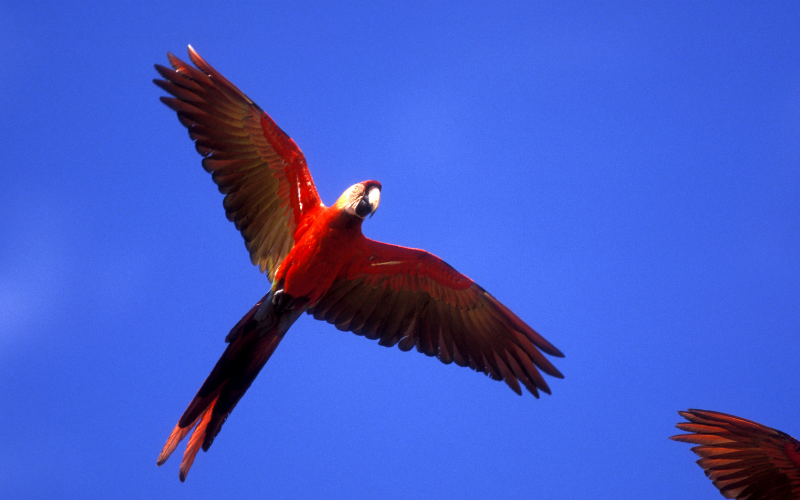

Later, the trees surrounding the pool come alive with swinging, bouncing, cheeky monkeys – white-faced capuchins. They are so much fun to watch. Several of the moms have babies on their backs. I am reminded of Carlos at the Proyecto Asis wildlife sanctuary near Arenal telling us how poachers kill the mamas to get the babies. How incredibly cruel.
Day 8: Manuel Antonio Park
The next morning, we are up at the crack of dawn. I go out onto our balcony and hear howler monkeys for the first time in my life. They really do sound like Tyrannosaurus rexes from Jurassic Park. The roaring sound echoes across the canopy, sending shivers down my spine. Later, in Corcovado National Park, I will hear lots of howler monkeys (and have the audio to prove it). But more on that later.
The plan for the day is to visit world famous Manuel Antonio National Park. It’s Costa Rica’s smallest national park but reputed to have a lot of wildlife in addition to some of the most beautiful beaches in the world.
Arrival at Manuel Antonio National Park
The bus arrives on time (the buses always arrive on time!) and we clamber on to take the last two seats. Ten minutes later, we descend the hill to Manuel Antonio. A strip of cheap souvenir stalls lines both sides of the street leading to the park entrance. We are directed to pick up a plastic bag containing two containers of fresh fruit (included in the price of the tour) on our way to the park entrance where rangers search our bags for other food.
The park is strict about what food visitors may bring in. Basically, the only things allowed are a small container of fresh fruit, a water bottle, and possibly a sandwich. No granola bars, no chips, and no pre-packaged foods, lest they get fed to the animals.
The crowds at 7:15 am are already alarming. Our guide inform us that this is the first day that the park capacity is being doubled from 1500 visitors per day to 3000. And because the park is going to be closed the next day, everyone and his sister has risen before dawn and come to the park—and all of them join groups ranging from five to 15 people centered around a guide with a large telescope on a tripod.
Manuel Antonio Park Walk
Our group from the bus is divided into three groups of about 15 people each. This is the largest group we’ve had yet for a wildlife tour, and it is too large. Most of these tours entail a short walk followed by the guide setting up the tripod, positioning the telescope and then inviting each person to peer through the lens at whatever animal he’s discovered. With ten people, the waits can get tedious; with 15, they are interminable.
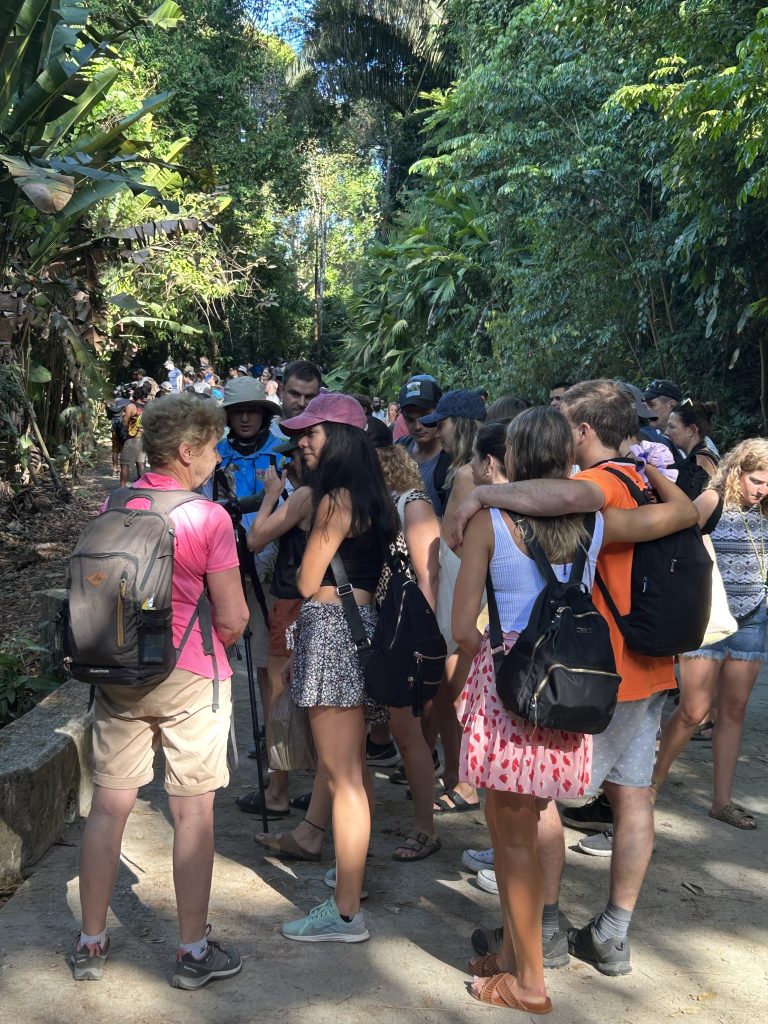

At several points during the two-hour tour, other groups surround us, the cacophony of raised voices drowning out any hope of hearing animals of the non-human variety. Any self-respecting animal has long gone into the hinterland, and I can’t say I blame them.
Animals in Manuel Antonio
The guide does his best, but the crowds are insane. We see a wren minding her nest, an iguana, a few small bats, a spider, a sleeping frog, and a sleepy sloth (mind you, they are all generally sleepy). That’s not a bad haul, but thanks to all the standing around and waiting, we are worn out by the time we make it to the beach.
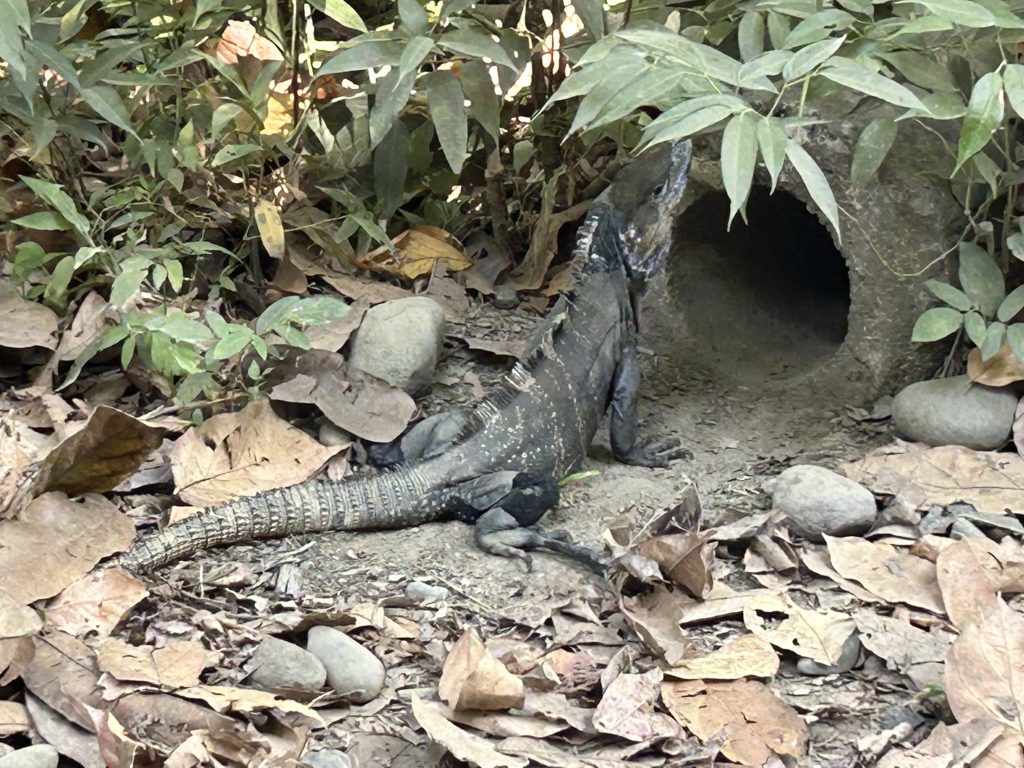

The Beach at Manuel Antonio
Fortunately, the beach makes up for the bordering-on-tedious walk. Its reputation as one of the world’s most beautiful beaches is well deserved.
We find a shady spot, put down our towels and minutes later are cavorting in the gentle waves. The beach is set within a wide bay with calm waters—very safe for swimming, which is not something that can be said about all beaches in the area.
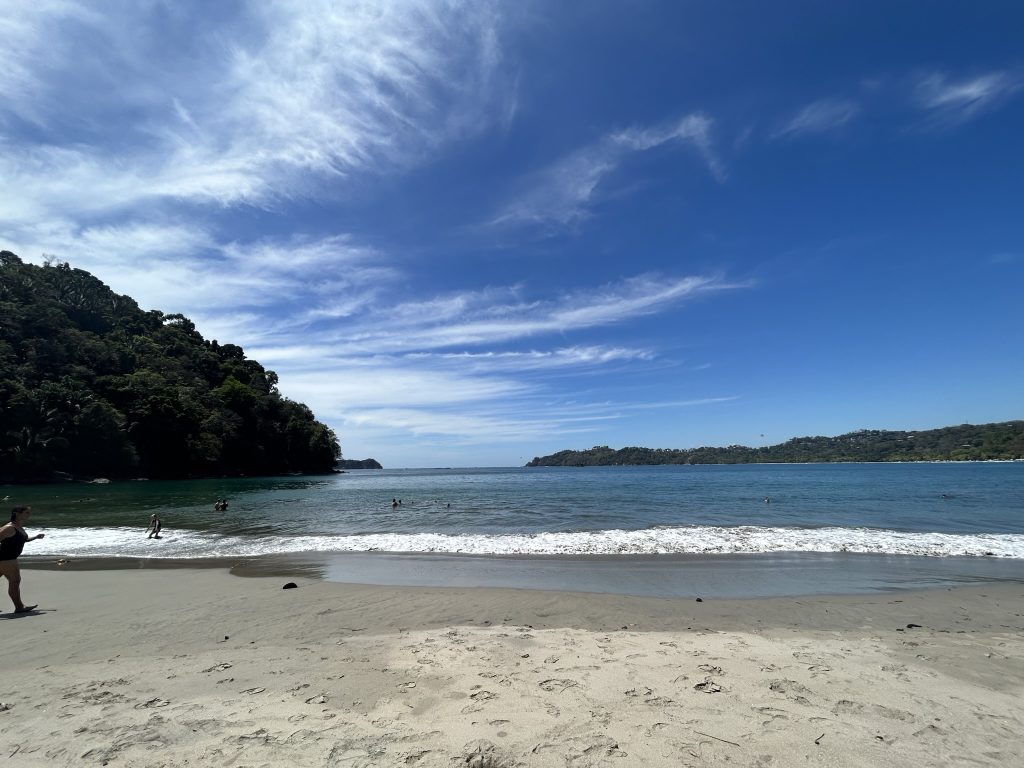

The ocean is bathwater warm and not at all refreshing. But it sluices away the sweat while the salt flushes out the bug bites. We stay for about two hours. The crowds are certainly larger than expected considering it’s a national park with limited attendance, but at least the beach is still pristine. Since concessions are not allowed and everyone must walk a fair distance to get there, the beach still feels remote and untouched.
Run-in with the Monkey Mafia
At one point, we settle under a tree and leave Julia’s backpack open. Seconds later, a card-carrying member of the Monkey Mafia (seriously, that’s what people in Costa Rica call them!) swings down from the trees and hops into Julia’s backpack. He plucks out a box of Kleenex that Julia had liberated from our hotel room, looks at it with disgust and then chucks it into the sand and swings away.
Sorry, Mr. Monkey.
We spend lots of time watching the monkeys swarm through the trees bordering the beach. They know humans have fruit and so wait for one of them to become careless. The park people must figure that the occasional piece of fruit lifted from a tourist won’t unduly upset the eco system since monkeys normally eat fruit. We see a lot of monkeys clutching hunks of pineapple and watermelon in their little fingers.
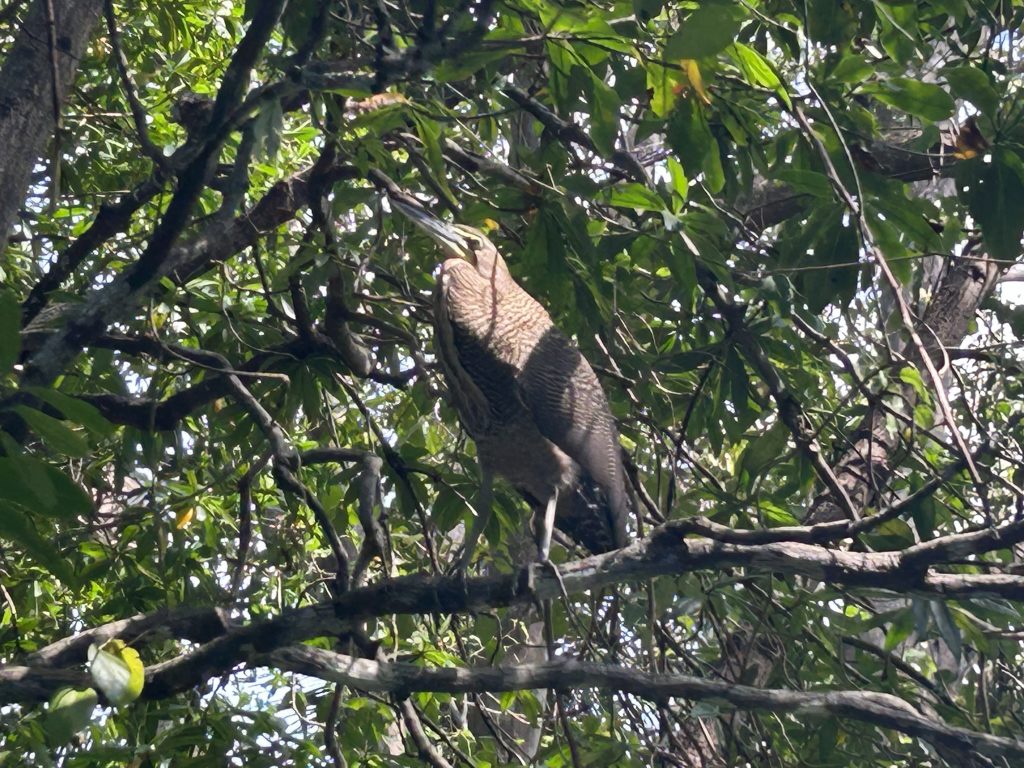

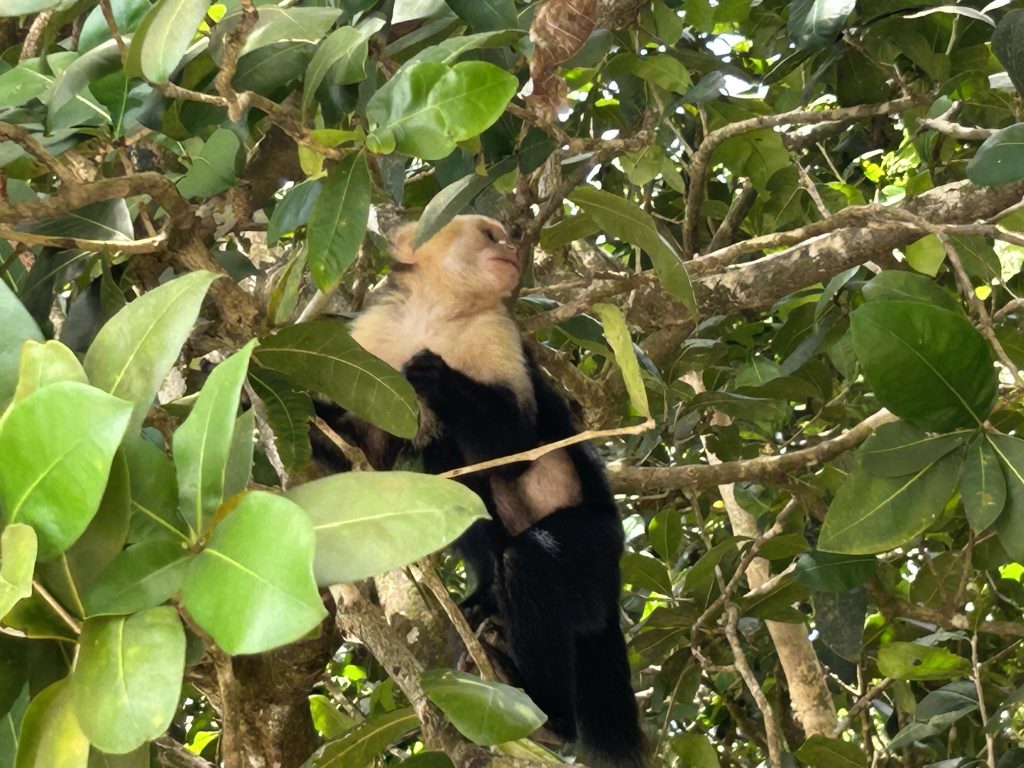

Leaving the Park
By one o’clock, we are done. We follow a narrow boardwalk back through the rainforest to the park entrance. Often, we are the only people on the boardwalk, a marked change from the hordes accompanying us along the main path earlier in the morning. Unfortunately, without a guide, we don’t see any animals. But we do enjoy the jungle solitude, particularly the constant buzzing and rustling sounds reminding us we are walking through an intensely alive ecosystem.
Once out of the park, we have lunch at a soda. While my Casado is excellent, Julia is served raw chicken which she sends back. She gets a cursory apology but not a comped meal. Oh well, you win some, you lose some.
We grab a taxi back up the hill and take a well-deserved nap after the exertions of the morning in 30-degree heat. By 4:30 pm, we are at the adult pool waiting for the two-for-one happy hour drink. The monkeys put on another show, we cool down in the pool, and all is well.
For dinner, we opt for pizza at a place down the road. It is excellent and a tasty change from Tico (Costa Rican) food, which, although hearty, does get a little monotonous.
Day 9: Manuel Antonio and the Mangrove Swamp
On our second full day in Manuel Antonio, we intend to do nothing in particular. But we quickly realize we don’t want to spend the day at the public beach where the swimming is said to be rather unsafe. Consulting with the friendly reception staff at Si Como No, we decide to take an afternoon tour of the mangrove swamp.
Good call! All my life, I’ve wanted to see a mangrove swamp. I’m not sure why. Maybe I watched too many episodes of The Everglades back in the 1960s or read more than my fair share of novels set in pirate times when people were forever getting themselves lost in mangrove swamps.
I remember reading that mangrove swamps are super hard to penetrate and brimming with all manner of creepy crawlies.
It is time to see for myself.
Touring the Mangrove Swamp
I am not disappointed! A mangrove swamp is a fearsome thing. I can’t imagine trying to walk through one—the impossibly tangled roots making each step a chore, the mud sucking you down, the wall of foliage. Even with a razor-sharp machete, progress would be agonizingly slow.
We are picked up and taken down the hill to Quepos where we check in at the office and then board another van for the 20-minute drive to a sleepy, muggy cluster of houses sliding into a river. Sightseeing boats and plenty of kayaks cluster around the soggy docks. Kayaking is an option, but we are feeling less than energetic. A nice, comfy boat will be just the ticket.
And it is!
Cruising Through the Swamp
We settle into a boat along with a couple from Toulouse, France, and our enthusiastic young guide. He and the driver of the boat spend the next two hours cruising us along the silent waterways lined on either side with thick mangrove swamps.
Every so often, we stop so the guide can show us an animal—an iguana, a sleeping frog, and even a silky anteater. That one gets the guide and driver excited, although I confess, I can’t see more than a blurry furball high in the tree. But apparently, it’s rare to see even that when it comes to silky anteaters. Who knew?
Eventually, we glide to where the waterway meets the breezy freshness of the ocean.
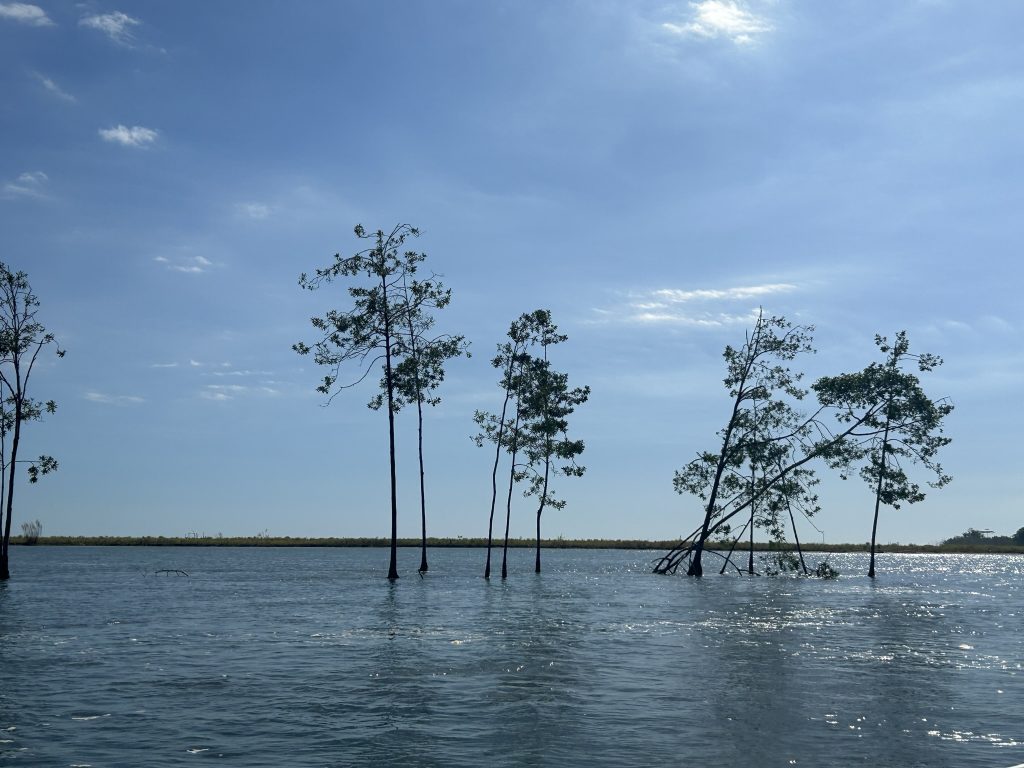

We turn back and are soon disembarking at the same tumble-down, heat-soaked swamp dock we started at. The houses are ramshackle and poor looking. I don’t think it would be a comfortable place to live.
Dark Side of Palm Oil
On the way back to Quepos, we pass hectares and hectares of forbidding looking date palm plantations stretching into murky darkness on either side of the road. Our guide tells us that working on the plantations is extremely dangerous. The massive fruit of the date palm from which the palm oil used in the cosmetics industry is extracted is extremely heavy. If a worker is under a palm tree when the fruit falls, he can be killed. The plantations also harbor all manner of deadly critters, notably fer de lances and scorpions. Injuries are common. Most of the workers who toil in these plantations come from Nicaragua. We pass a compound of houses where they live for “free” while they are working. It looks like a very hard and dangerous life, and inspires me to seek out products that are palm oil free.
Back in Quepos, we are served an early dinner of Casado. I order the fish; Julia orders the chicken. Tasty.
We arrive back at Si Como No and spend a quiet last evening resting up for our next adventure.
Day 10: En Route to Copa de Arbol Rainforest Resort
Our last adventure in Costa Rica is staying at an ecolodge on the Osa Peninsula. Everything I’ve read about Costa Rica and animals declares that the Osa Peninsula is the place to see the most animals.
Osa is home to 2.5% of the world’s biodiversity all crammed into one relatively small peninsula. The area teems with wildlife, and the tourism industry is quickly responding to the allure of this remote area. Several luxury eco-resorts now dot the peninsula’s coastline. Since one of the main attractions of the Osa Peninsula is its remoteness, most of the ecolodges are accessible only by boat.
To go there is to be immersed in the jungle and experience nature up close and personal. When we were planning our trip, we decided that we had to include the Osa on our itinerary (and we are glad we did).
Why Go to the Osa Peninsula
The wonderful Pacific Trade Winds responded to our request to visit the Osa Peninsula by suggesting The Copa de Arbol Rainforest Resort. It makes many of the top-ten lists of best ecolodges in the area and for good reason.
Expensive? Well, the Copa de Arbol Rainforest Resort is not cheap, but it is excellent value. The cost includes accommodation in a gorgeous little cabina so close to the ocean that the swooshing of the waves lulls us to sleep every night, three excellent meals a day, two day trips, transportation by boat from Sierpe to the resort and then from the resort to Drake Bay and from there a flight to San José, along with the most attentive, friendly, and sincere service I’ve ever experienced. There are almost as many staff as guests.
We begin our adventure by saying farewell to Si Como No and the expansive view over the ocean and hopping on a shuttle for the two-hour drive to Sierpe, one of the gateways to the Osa Peninsula. The area is so remote that driving into the peninsula is almost impossible, particularly during the rainy season.
Getting to Copa de Arbol
Our shuttle pulls up in front of a sleepy riverside café filled with people like us who are bound for one of the resorts on the Osa Peninsula. I feel like I’ve stepped into a gritty version of Disney’s Jungle Cruise. I have time to gulp a quick coffee (Costa Rican coffee is so good) before our captain ushers us (again, only us!) into a small launch that will take us down the Sierpe River and out into the Pacific Ocean to our destination at Copa De Arbol.
Two men transfer our luggage from the van into the small boat; we scramble aboard and, minutes later, our captain casts off and heads down the river. For the first 30 minutes, the view either side of the boat is of mangroves—the grey twisting roots so evocative of pirate movies of yore. Every so often a bird soars overhead. The breeze is cool, and we settle in to enjoy the ride.
The water gets a bit choppier as we near the mouth of the river. We are handed life jackets and told to hang on as we pass over the surf and into the ocean before hanging a left and going down the coast past little Drake Bay to our resort. The captain expertly navigates large swells and takes us up and over the surf and into calmer water.
Arrival at Copa de Arbol
Thirty minutes later we arrive at the beach in front of Copa de Arbol. I spy a few thatched roofs poking up among the greenery, the only indication that this stretch of jungle is inhabited. This is not the area for swanky highrises (thank goodness!). All the resorts are tucked into the foliage and designed to be a part of nature rather than dominate it. I’ve always liked the sound of an eco-resort and I am about to find out what one is really like.
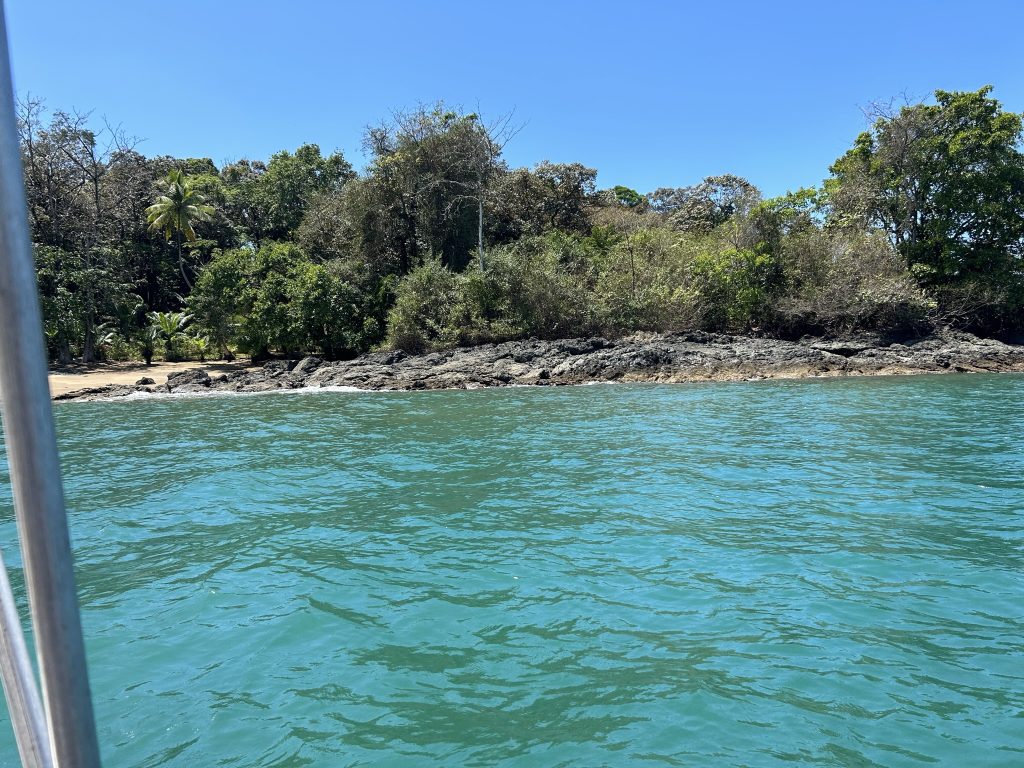

The boat reverses close to the sandy beach and we are invited to disembark. I have a momentary wobble as I stand at the stern and begin stepping down into the water. Four pairs of hands rushed to my aid to keep me upright. Feeling somewhat embarrassed, I jump into the warm water (the ocean here is incredibly warm) and slog to the beach.
We are Welcomed
Of course, I don’t need to spare a second of worry for our belongings. They are being hoisted onto strong shoulders and taken directly to our cabina.
We emerge from the water to find Lissbeth standing on the sand, waiting to greet us. I feel like I’ve stepped into an episode of Fantasy Island or perhaps White Lotus but without the dysfunctionality. Another person appears, bearing cold towels and a fruit drink. We assure her that the trip was fantastic and soon we are walking along an immaculately maintained gravel path toward the main building.
On the way, we stop at a freshwater hose conveniently set up to rinse sand off our feet. Lissbeth does a thorough job of cleaning us up and then escorts us to the breezy reception area. Check-in is quick and personal. They know exactly what tours we’ve signed up for (wildlife in the Corcovado and snorkeling at Cano Island plus one free day) and promise to keep us informed every step of the way.
Settling Into Cano #1
We stroll back toward the ocean to check out our home for the next four nights. Cano #1 is the closest cabina to the beach. If we are any closer, we’ll be sleeping with the fishies. The cabina is gorgeous—two beds, a large bathroom with rainfall shower, and a wide porch perfect for sitting on and writing. Hibiscus flowers are strewn everywhere—on the pristine white coverlets, in the shower, on the towels. Whenever new guests arrive, the staff must go out and gather the blossoms. I discover later that there is no shortage of hibiscus plants on the property. All wild.
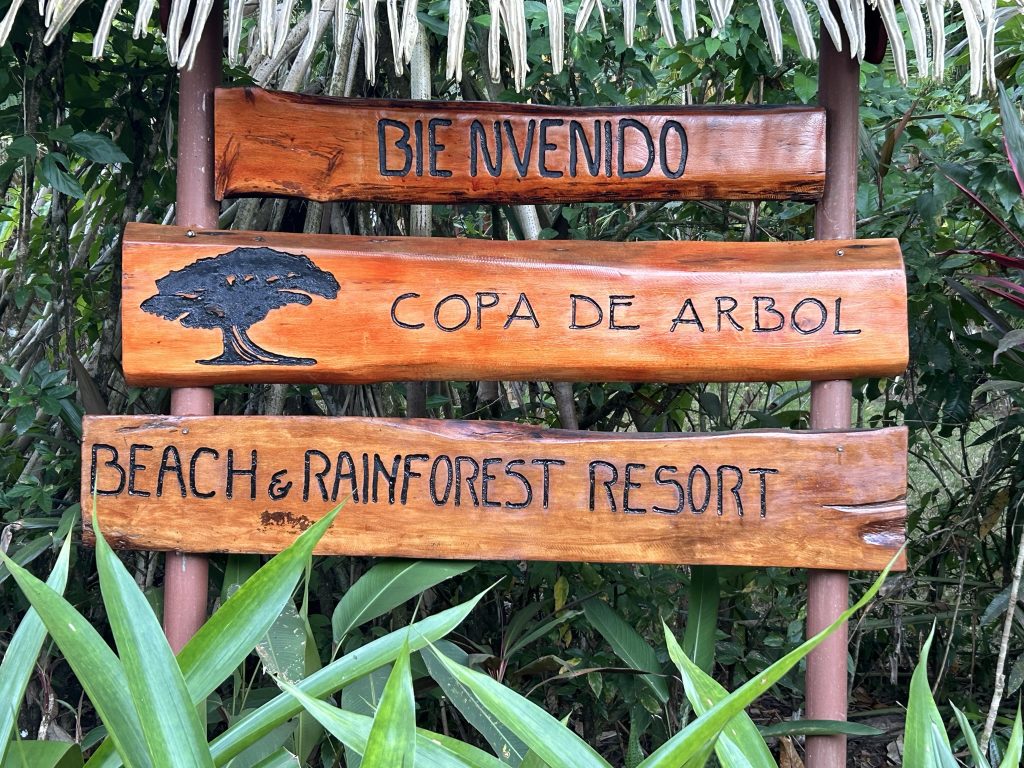

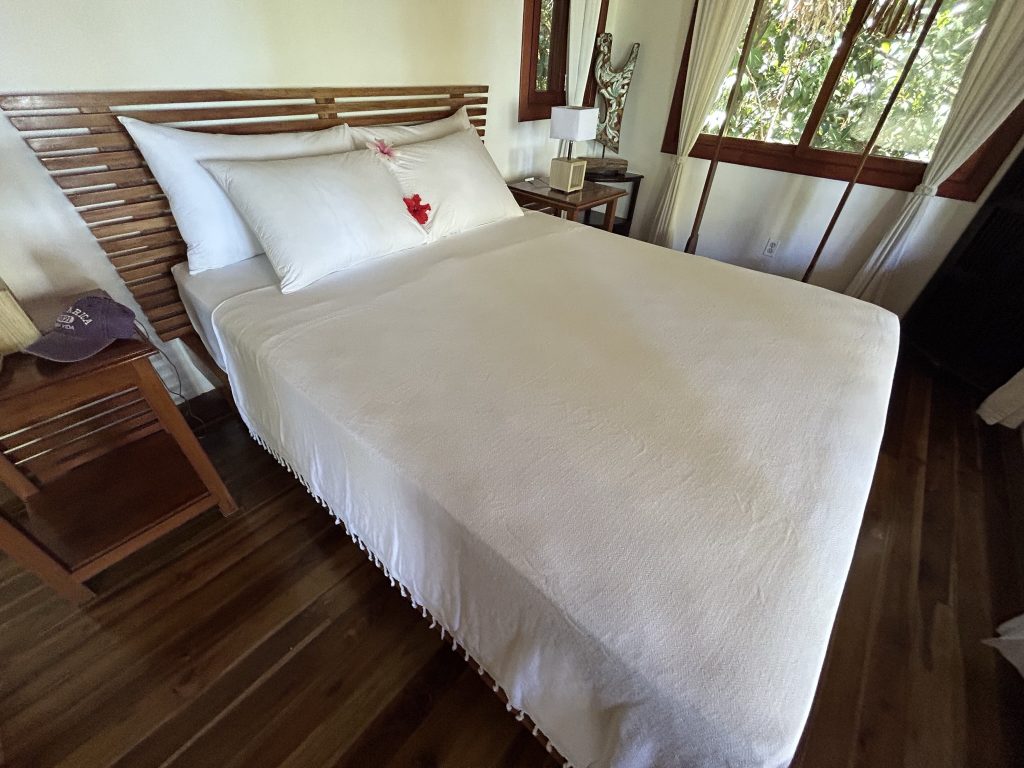

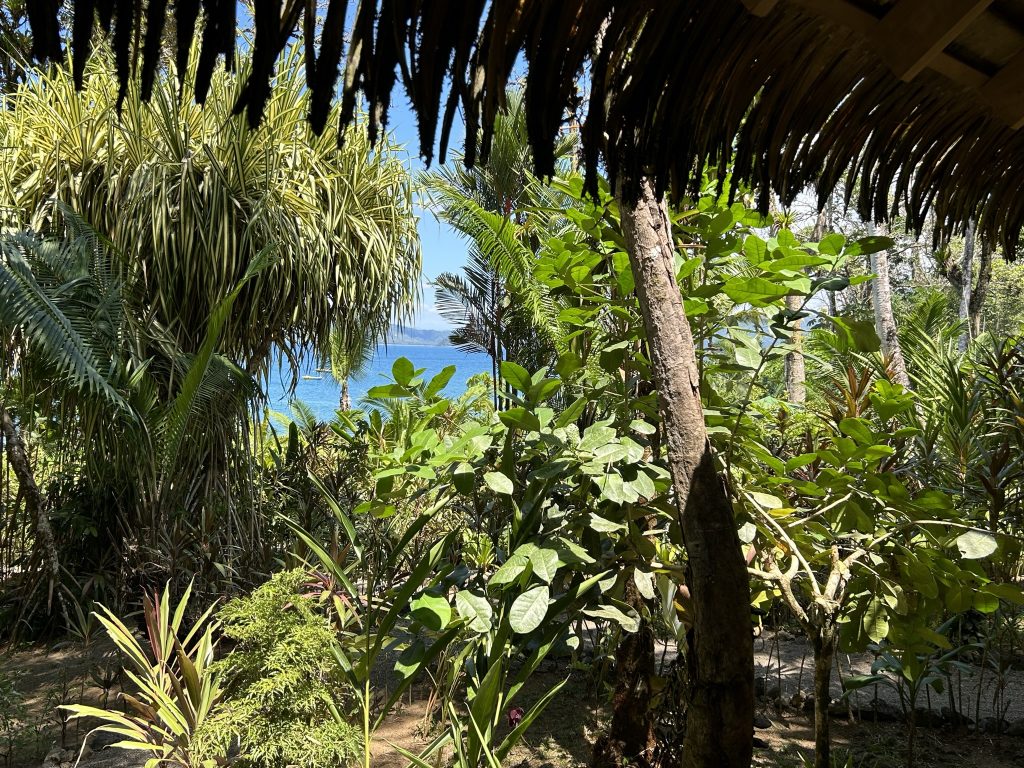

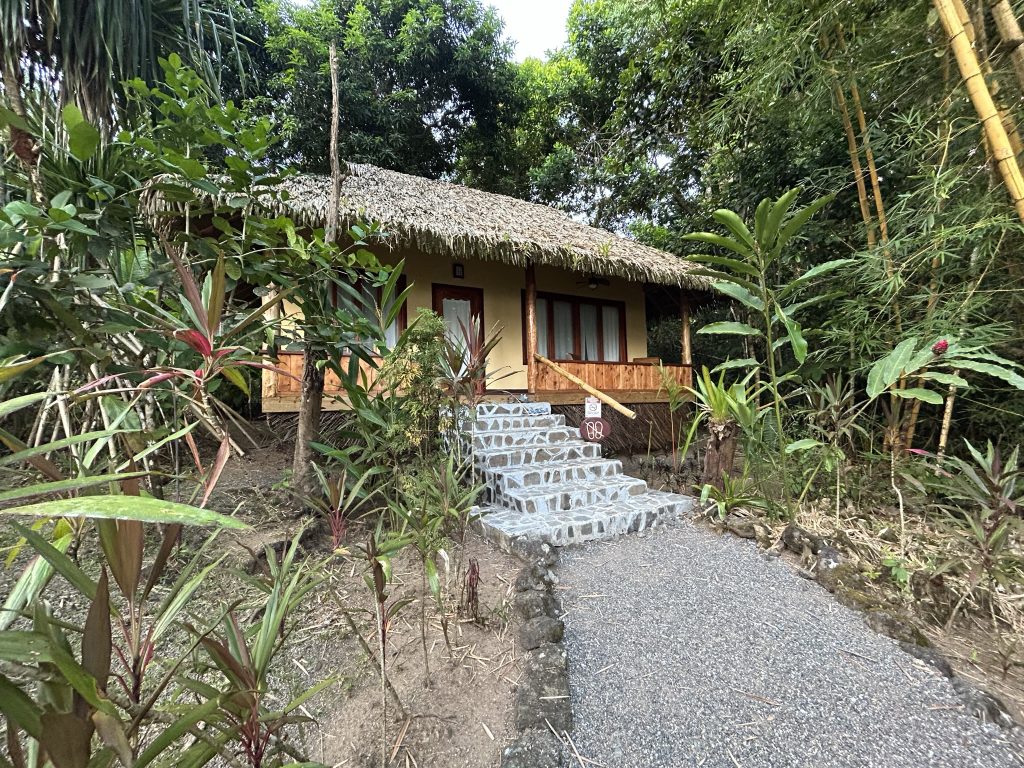

I snap pictures and videos, get my stuff unpacked, and then we walk back to the main building for lunch. As we had before entering our cabina, we remove our sandals before climbing the stairs to the breezy dining area. The requirement to remove shoes before entering any structure on the property is a smart one, to avoid excess sand build-up. And, as I am soon to discover, everything here is done efficiently and with superb attention to detail. I’ve never been in a place with such a customer-service orientation. With so few guests and such a high staff-to-guest ratio (it honestly feels like one-to-one when you factor in all the maintenance staff), nothing is too much trouble.
The resort has just nine cabinas and an equal number of tables in the dining area so every party has a view of the ocean.
First Lunch at Copa de Arbol
Our lunch is a delicious pasta with plump shrimp—very tasty and very fresh. It is the first of 12 excellent meals. Most of the meals we’ve had on our Costa Rica trip are hearty and tasty, but not particularly memorable. The breakfast buffets at the Tabacon Resort & Si Como No were mediocre and the breakfast at Monteverde Lodge was good but not great.
Copa de Arbol beats them all hands down, which is doubly remarkable considering every bit of food is brought in by boat and then prepared on site.
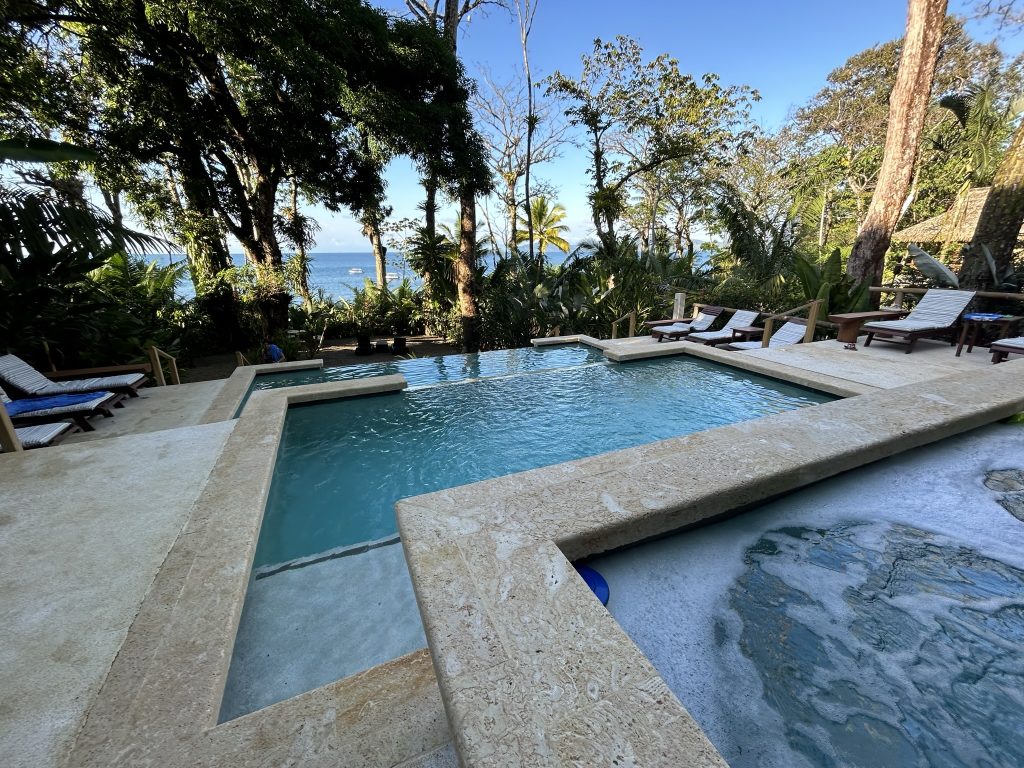

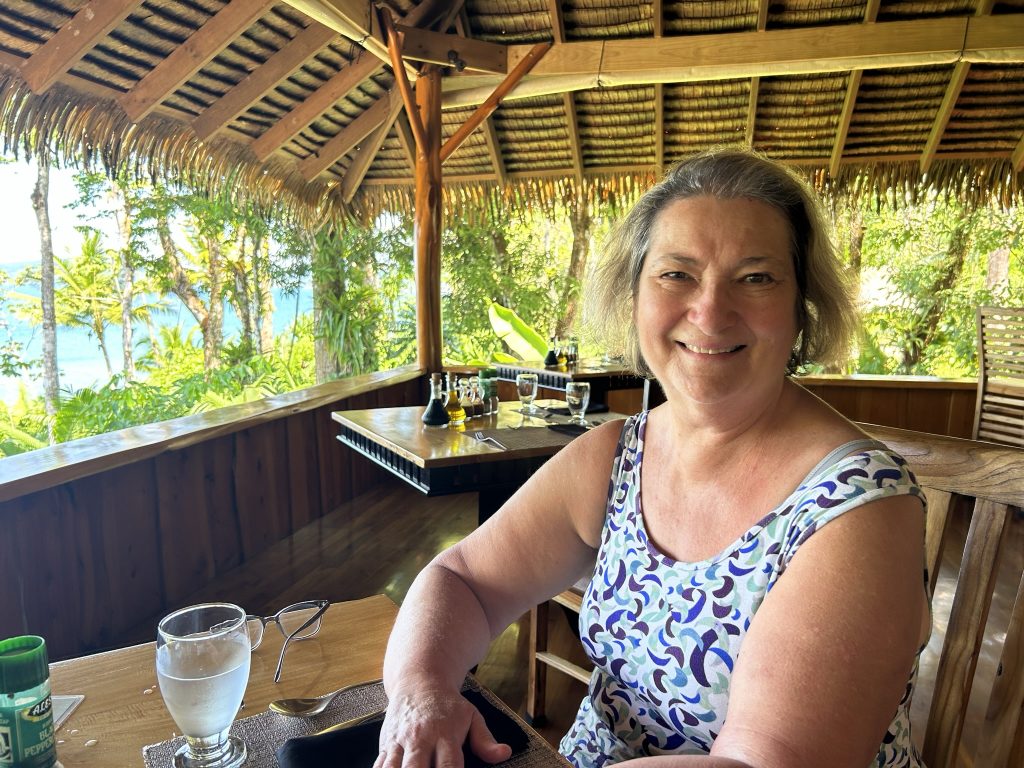

After lunch, we check out the beach but don’t swim. The beach is gorgeous but a bit rocky in places and too rough for my comfort. Fortunately, the three-tiered infinity pool surrounded by lush rainforest is a winner. During our four-night stay, we spend at least a few hours every afternoon at the pool. There are always more than enough padded lounge chairs and rarely more than three other people in the pool. Most of the time, we have the area to ourselves.
Happy Hour runs from 4 pm to 5 pm and involves optional imbibing of one of the two-for-one cocktails of the day. My favorite is the Pain Killer on Day 3! It is a good choice after a morning spent tramping through the jungle in 30-degree heat (mind you, I have adored every minute of it).
I don’t get the special on the last day because it contains gin (my least fave spirit!), and instead enjoy a creamy smooth rum and coconut concoction called a Drake Bay.
Exploring
Before dinner, we explore the path that passes in front of the resort and is the only land access to the resorts along this coast. The path extends from Drake Bay about an hour’s walk to the east and to the River Claro and the edge of the Corcovado National Park about an hour to the west.
We head west to enjoy a full view of the setting sun which is not quite visible from Copa de Arbol’s beach. The walk along the narrow path through the jungle is spectacular: ocean waves crashing on one side competing with the constant hum of cicadas buzzing in the trees, punctuated by bird calls and occasionally the roar of howler monkeys.
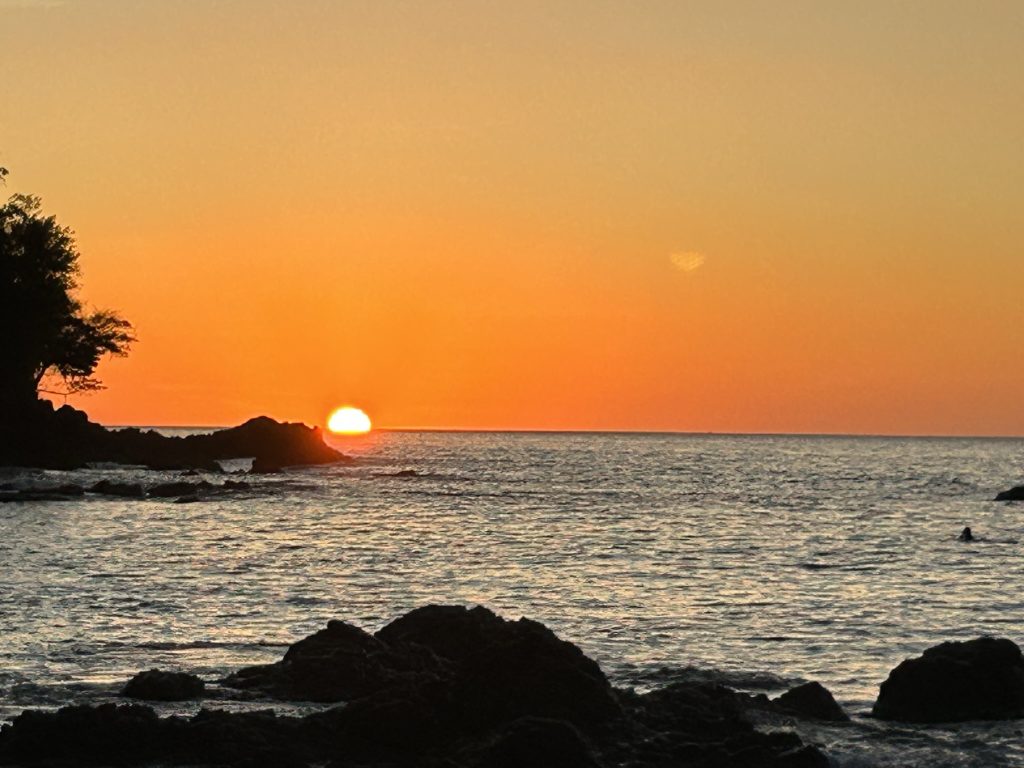

I have never realized just how noisy the jungle is. It never stops—a constant chittering that pulsates with life. You can’t help but be aware that you are in the middle of one of the planet’s most abundant biospheres. All the plant life is huge—massive ferns, palms soaring into the tropical blue sky, huge Ficus trees, other very large trees that look like oaks, with broad trunks and sturdy boughs, but are not. They look like trees in Avatar or the Swiss Family Robinson tree at Disneyland.
That evening, Julia enjoys a tenderloin steak, while I have a perfectly cooked slab of mahi mahi doused in an excellent sauce. Both are served with plenty of fresh vegetables followed by a lemon mousse for dessert.
Day 11: Free Day at Copa de Arbol
Our first full day at Copa de Arbol is supposed to be a hike in the Corcovado, but the resort reschedules it to the following day when more people will be joining us, which is fair. All the tours available through Copa de Arbol are with freelance guides hired to escort only guests of the resort. As a result, both tours we take—snorkeling to Cano Island and a hike in the Corcovado—consist of only six people: two couples from the US and us.
Such small group tours are perfect and more proof that staying at Copa de Arbol is excellent value. Pricy? Yes. But price isn’t the only measure of whether a place is worth staying at. This is a three-star resort in a six-star environment with first-rate customer service. The intimacy of the experience wins over any of the more luxurious resorts I’ve stayed in.
Hanging out at Copa de Arbol
Our first full day becomes our only true rest day on the entire 14-day Costa Rica adventure. It is well-timed! We need a day of good R & R, particularly because a work emergency has hit me the night before and I am obliged to get up super-early and spend the first three hours of my day in the restaurant downing copious cups of excellent Costa Rican coffee and working on my laptop. The staff are very tolerant! I finish by the time Julia comes to breakfast (excellent French toast).
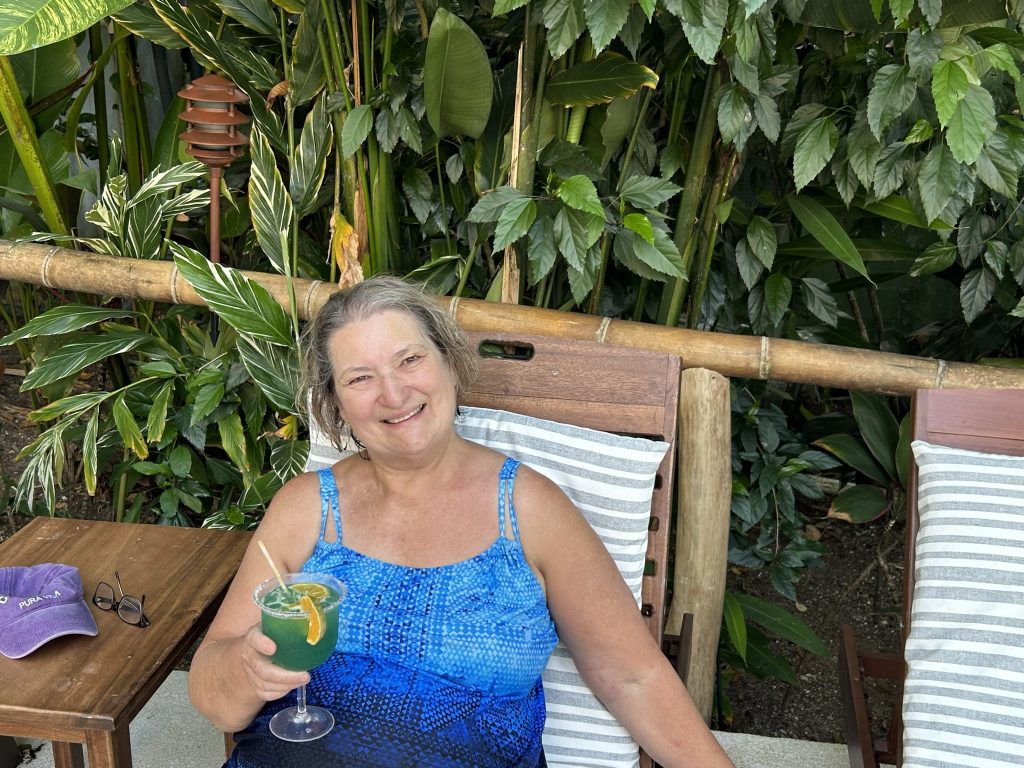

I then spend most of the rest of the day hanging out on the beach or at the pool, reading, occasionally writing my blog posts, and generally relaxing. Heavenly! I also treat myself to a massage with Joanna who comes by boat from Drake Bay. She sets up a massage table in our cabina and gets to work. The sound of the waves crashing outside, the constant working of her hands across my muscles, and the lingering scent of peppermint all conspire to lull me into a state of total relaxation.
Sunset Walk at Copa de Arbol
At sunset, we again stroll the coast path to view the sunset and then enjoy yet another gourmet dinner. I opt for sesame crusted Ahi tuna and it is excellent.
At every meal, we are asked to place our order for the meal to follow, at least for lunch and dinner and on one day for breakfast. So, at lunch, we are given the dinner choices (always two meat-based choices and one vegetarian) and at breakfast, we are given the lunch choices.
On our second night, we are asked to pre-order our breakfast because we’ll need to eat at 5:30 am to be ready to board the boat at 6 am for the journey to the Corcovado National Park and the start of our jungle hike.
Lights-out early followed by the usual restless night that precedes having to get up earlier than usual! I wake up and check my phone at least five times and finally beat the alarm and roll out of bed at 4:50 am. At exactly 5:30, we present ourselves in the dining area and find our pre-ordered breakfast ready and waiting—eggs Benedict with fresh avocado. Unfortunately, food at such an early hour is too much for me so I’m not able to do it justice!
Day 12: Corcovado National Park
At 6 am, we meet our guide, Isaac, and along with our four companions (a couple from Michigan and a couple from Tennessee who are traveling together), we are ushered aboard the waiting boat. As the sun rises over the Pacific, we are whisked along the coast at a brisk clip. The air is fresh and cool, the clouds pearlescent with the sunrise. On the one side is the open Pacific and on the other, dense jungle. Forty minutes later, we pull into a bay in front of the San Pedrillo ranger station at the Corcovado National Park.
Arrival at San Pedrillo Ranger Station
We splash off the boat and are provided with towels to dry our feet before pulling on socks and sturdy running shoes for the hike. One guy wears only thin sandals, but I wouldn’t take the risk. Snakes and other creepy crawlies freely slither the park.
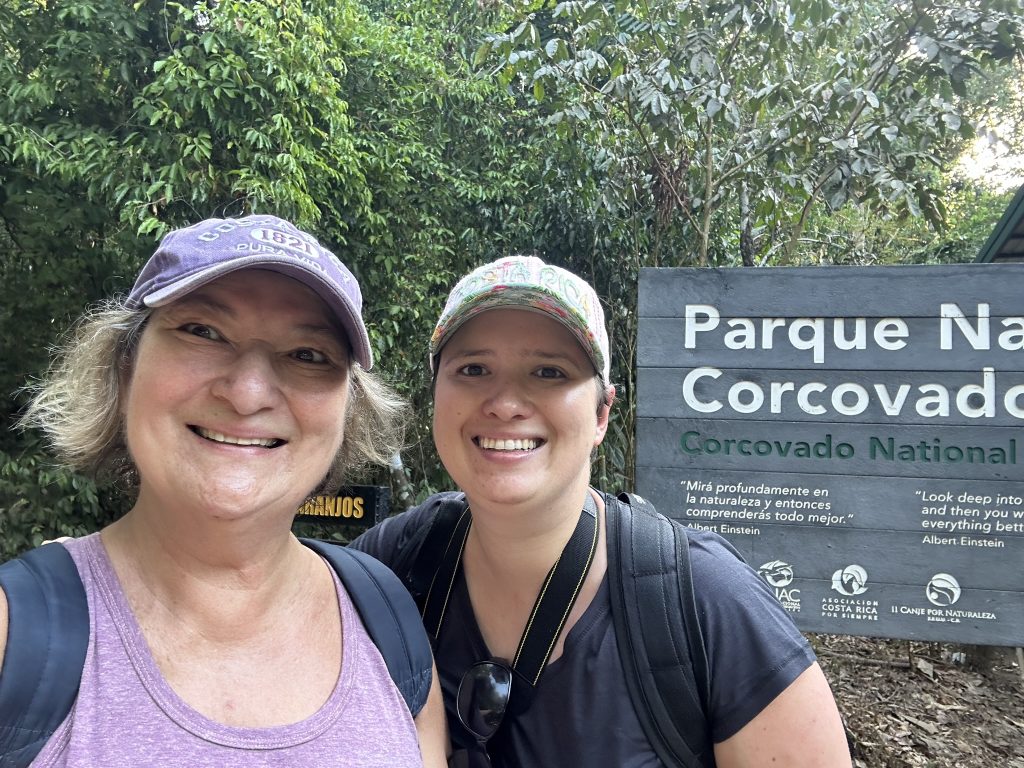

The San Pedrillo station is quite busy at 6:45 am as small groups from all over the area converge for their guided hikes. All hikes must be guided. Apparently, people do try to hike on their own, but disasters often befall them—snake bites, disorientation, heat stroke, etc. I wouldn’t even think of going into the area without a guide.
Hiking in the Corcovado
Isaac leads us in the opposite direction of where most of the other groups are headed and within minutes we are being swarmed by coatis. They are like raccoons, with the same bandit-like tendencies. They scurry across the path and up into trees and across branches. The whole forest shivers and shakes with their antics.
We are in a second-growth forest that was farmland back in the early 1970s when the National Park was created. Most of the 55,000 hectares of land in the huge park are primary forests, but the areas easily accessible to visitors are not. Much of the park is off-limits to visitors. Park rangers patrol the vast area and are on the lookout for poachers and even gold prospectors. Many of the species in the park are endangered; poachers still pose a real threat.
Howling with the Monkeys
After about 30 minutes, we change direction and are soon deep into howler monkey land. The roaring sound in the early morning comes from the monkeys marking their territory. Apparently, the sound of their howling changes depending on what they are doing. If they sense predators such as a puma or jaguar, their howling changes noticeably, something the guides are always listening for. Unfortunately, the chance of us spotting one of the big cats is virtually nil. Isaac tells us that he’s never seen one in the park, although they definitely exist.
In the video above, our guide Isaac takes us along a forest path. You can hear the howler monkeys. We see lots of monkeys—squirrel monkeys and spider monkeys mostly—but don’t actually see any howlers. However, I record lots of audio of them howling. We spot an anteater high in the trees and get some good pictures of it jumping from branch to branch. Apparently, we’re lucky to have spotted it.
We also see a sloth and a rather fine looking spider. Julia is not impressed by the spider.
In Search of a Tapir
Isaac leads us off the trail into an area signposted as off-limits. He is in search of a tapir, so we all follow dutifully. After a few twists and turns and talking with other guides we meet on the way, Isaac tells us to be very, very quiet and to follow him. We start down a narrow, root-tangled path. All of us are studiously maintaining radio silence, that is, until I trip on a root, fall on my knees and yelp in pain (and not a little embarrassment).
Oops! It will be my fault if we don’t get to see the tapir.
I apologize profusely (but in a whisper) and moments later I stop next to Isaac and see an actual, bona fide tapir resting in the mud. It is HUGE! I hadn’t expected it to be so large. I think I was envisioning a kind of large pig, but while a tapir has piggy tendencies it’s much bigger, with an elongated head and large, black body. It is related to both the rhino and the horse but is relatively harmless unless a human gets in the way of a mama tapir and her baby. The babies are striped black and white at birth and resemble watermelons. How cute is that?
Finding a Tapir
Our tapir is supposed to be sleeping, but I see one eye open. When I mention this to Isaac, he smiles and says that the tapir had been sleeping until someone made a noise. He means me, but is too polite to say it. I apologize again and take some pictures before ceding my position in the line to the next person.
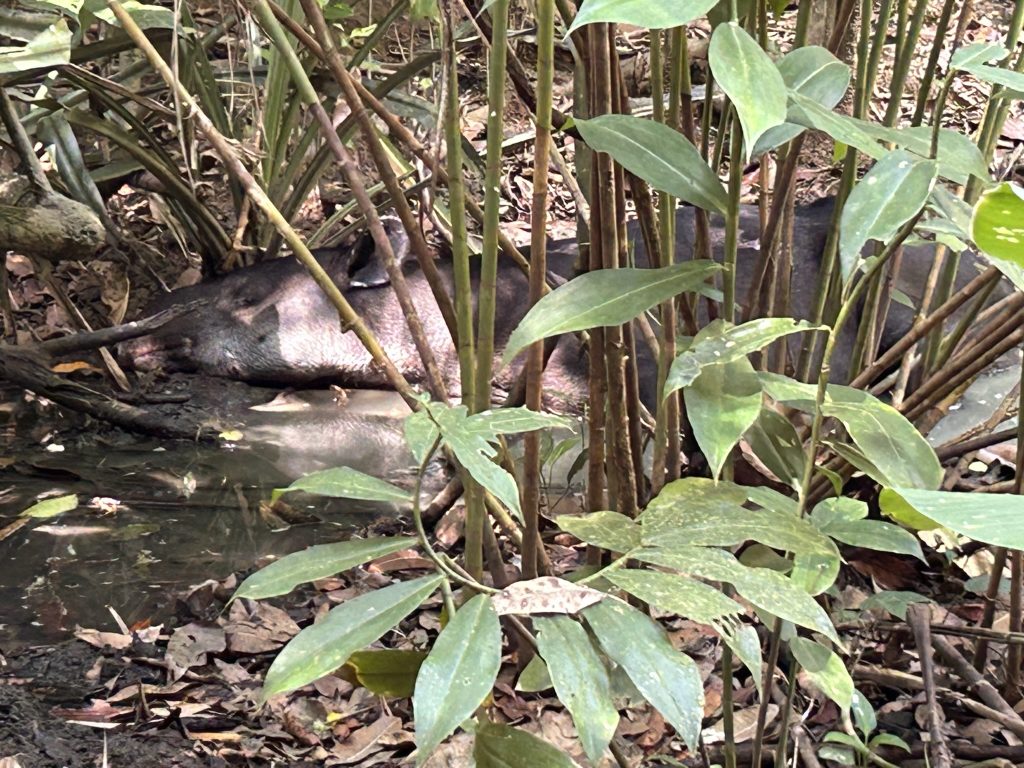

After seeing the tapir—a highlight and not that common—we trudge to the Sirena ranger station for a rest. We’ve been walking for about two hours in the steamy jungle.
Stop at Sirena Ranger Station
The temperature has risen steadily and by the time we arrive at the station, we are all very hot, very sweaty, and very in need of a cool drink. Fortunately, jars of fresh juice are for sale, along with coconut cookies and other pastries. We settle down in the shade to enjoy our juices and cookies and give our hot feet a rest.
People who overnight in the park stay at the station in dormitories kitted out with bunk beds swathed in mosquito netting. I peered into one of the dormitories and am glad we are staying in our spacious, air-conditioned cabina back at Copa de Arbol.
After the break, we trek back through the jungle to the beach where our boat is waiting. I am hot, sticky, and longing for a cold shower. We don’t see a lot of animals on the way back; the morning is too far gone and most of the animals are wisely responding to the increasing heat by having siesta. Smart animals.
Watching the Ants
I’m fascinated by the columns of ants we occasionally step across on our walk through the forest. Isaac stops to explain their organization. It’s amazing to watch them patiently trundle across the path, some laden with leaves, others standing by, presumably to direct.
Return to Copa de Arbol
The 40-minute boat ride back to Copa de Arbol refreshes us. Out on the water, the heat is not oppressive, thanks to the shade of the boat’s canopy and the breeze.
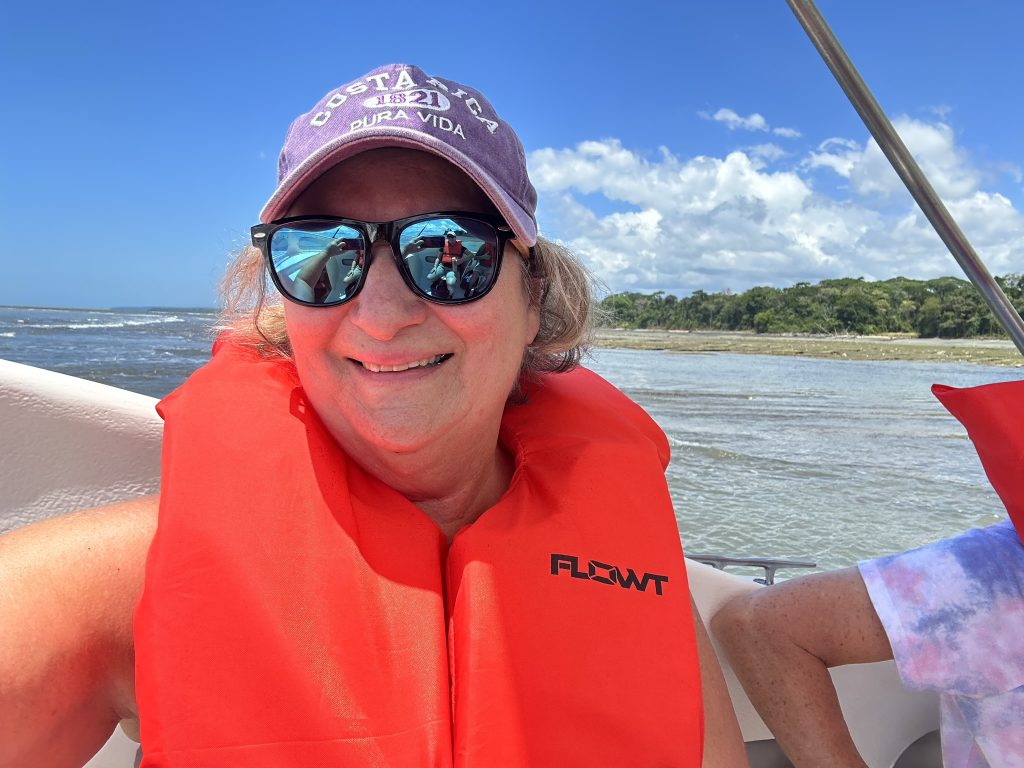

Minutes after we arrive back at Copa #1, Mario, one of the wait staff, arrives with two glasses of fresh celery and lime juice. The thoughtfulness of the staff here really is beyond anything I’ve ever experienced. We are two minutes from the dining hall and yet he takes the time to bring the cold juices to us knowing we’ve just arrived back from our Corcovado hike.
Did I mention that the staff call us by name? They take the trouble to learn our names on the first day and so always greet us as Carol and Julia. They know I like black coffee in the morning and that Julia doesn’t drink coffee, and they also know Julia doesn’t like fish and drinks less alcohol than her mother, and that both of us always say yes to dessert. The level of service is truly V.I.P., the kind you’d get in ultra-premium class on a cruise ship, but less unctuous, more genuine feeling. The staff works long hours in a remote location and yet they appear to enjoy their jobs. I hope that is the case.
On our third evening walk, we head east toward Drake Bay, away from the sunset but into new territory for us. We come across a troupe of monkeys cavorting in the trees and navigate a slightly rougher up-and-down trail. On another trip, I might consider walking into Drake Bay, but even at 5:30 in the evening, the air is heavy and hot.
Day 13: Snorkeling at Cano Island
Our third and final full day at the Copa de Arbol again starts early with a boat trip to Cano Island. We are with the same two couples from the day before and are heading off to snorkel and explore the island. Julia is nervous. She’s not much of a swimmer and is prone to seasickness. Fortunately, the air is fresh and the swells minimal. So far so good. Our cheerful guide (they are all cheerful!) points out leaping dolphins and various birds.
The boat stops within site of the island and presumably connects to a sea anchor. We prepare to snorkel.
Swimming with the Sea Turtles
Ten minutes later, we’re in the water and it’s magical. Massive sea turtles swim lazily beneath us, and the coral reef is swarming with fish. Our guide is in the water with us and points out notable sealife. I’m bobbing happily alone, the only sound the wheezing in and out of my breath in the snorkel. I love the solitude of snorkeling—I feel suspended in time with no past and no future, just me in my watery elements. I am a Pisces, after all!
But Julia is not. About ten minutes after we enter the water, I hear her cry out. She’s not a happy camper and, although happy to have seen the breast-stroking turtles, has had enough. The swells of what really is the open Pacific Ocean, albeit on a calm day, have been enough to turn her tummy. We signal for the guide who immediately swims with Julia back to the boat.
Julia Goes Ashore
The boat captain takes her to the beach on the island and I keep snorkeling. By the time the boat returns, my love affair with the watery deeps has faded somewhat and I’m happy to clamber back on the boat and head for dry land. I’ve never been particularly prone to seasickness (unlike Julia), but for some reason I need a good hour on the beach, lying flat on my back with eyes closed, to feel my equilibrium return. I think my snorkeling days are over. But that’s okay—I’m going out on a high note.
When I feel better, I climb with Julia up to the top of a rough path to see the view from the island. It’s pretty dang stunning.
On the way back to Copa de Arbol, the guide gives us each a Tupperware box full of fresh pineapple and watermelon, both welcome bites of deliciousness to chase away the saltwater taste.
We spend the afternoon lazing by the pool, enjoying our last day in this tropical paradise. I wish we didn’t have to leave, but our Costa Rica vacation is coming to an end.
Day 14: Drake Bay to San José
We enjoy our last breakfast at Copa de Arbol and say farewell to the waitstaff. I add a healthy gratuity to our final bill (mostly drinks since everything else was already paid for). The staff deserve every extra colón they can get. We board the boat for our last ride, this time to Drake Bay, which is only about ten minutes away.
From there, we are loaded into a van and taken over a bumpy road to the airstrip where we board a small plane for the short flight back to San José. The views from the plane of the Pacific Coast are magnificent.
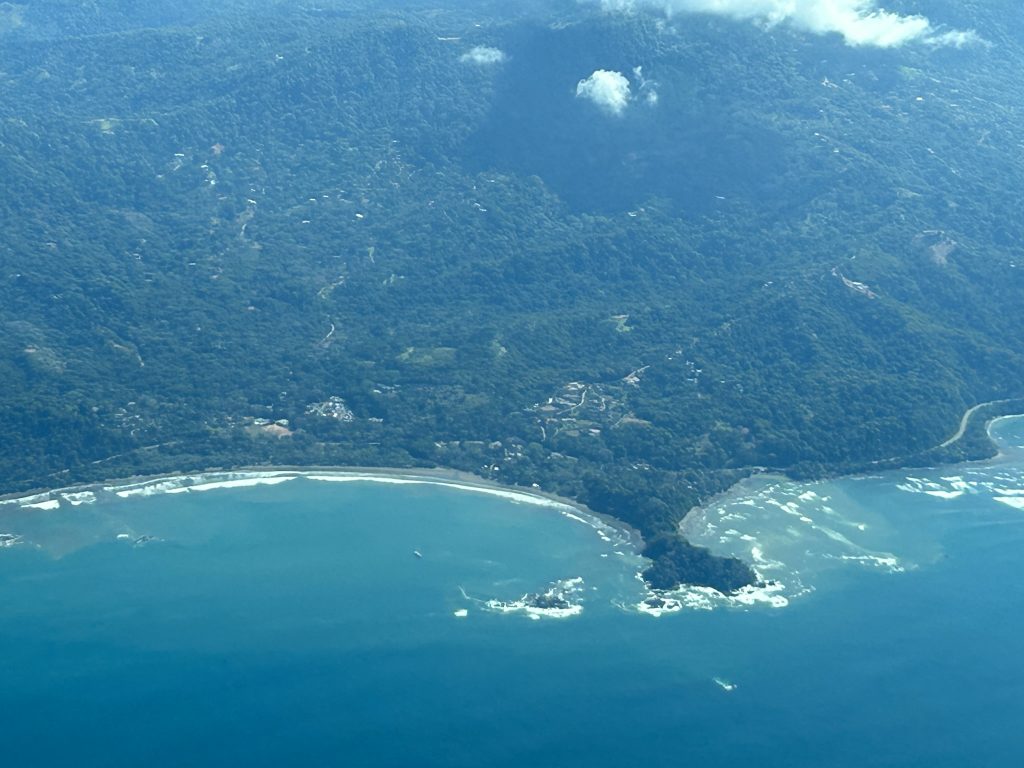

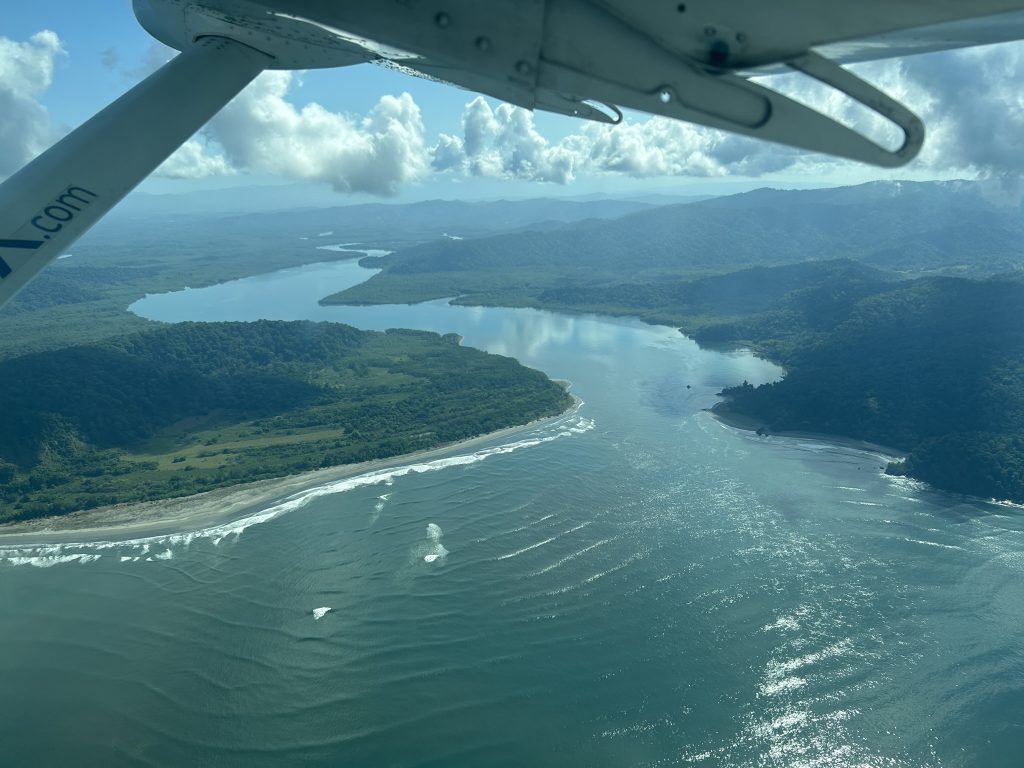

We check into the Gran Hotel Costa Rica, Curio Collection By Hilton, which is a very nice business hotel smack in the middle of San José. The city is not a particularly attractive one, and in my opinion worth only one night, if that. However, we do find three interesting things to do.
Visit to the National Museum
We walk about three blocks to the Museo Nacional de Costa Rica, aka the Costa Rica National Museum. Housed in a former barracks, the museum is an impressive place well worth a visit.
We enter through a beautiful glassed-in atrium aflutter with butterflies, and tour a large number of rooms chronicling the history of Costa Rica from pre-Columbian to the present. I know almost nothing about Costa Rican history even after two weeks in the country, so I thoroughly enjoy browsing the many very well curated and artfully presented displays.
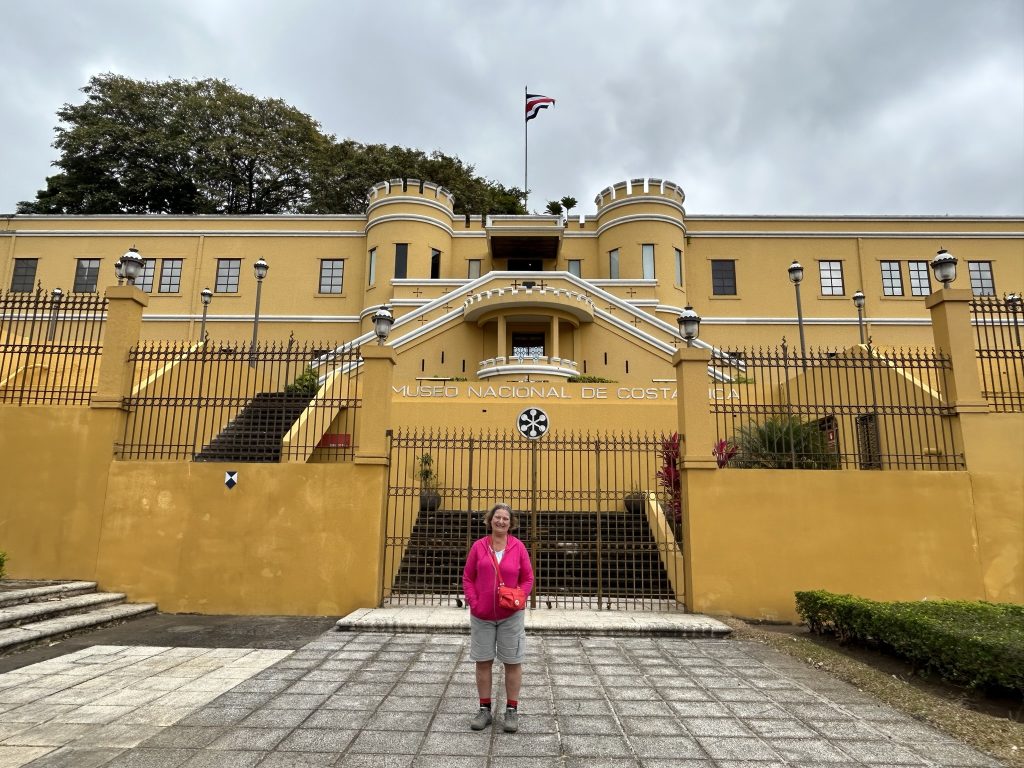

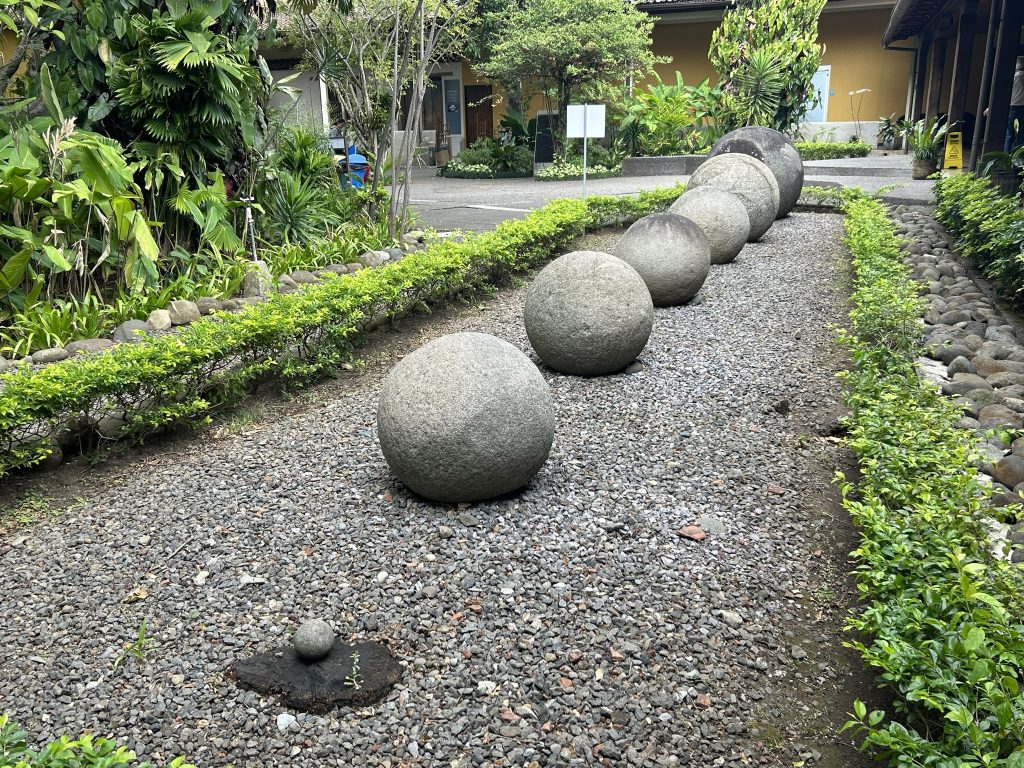

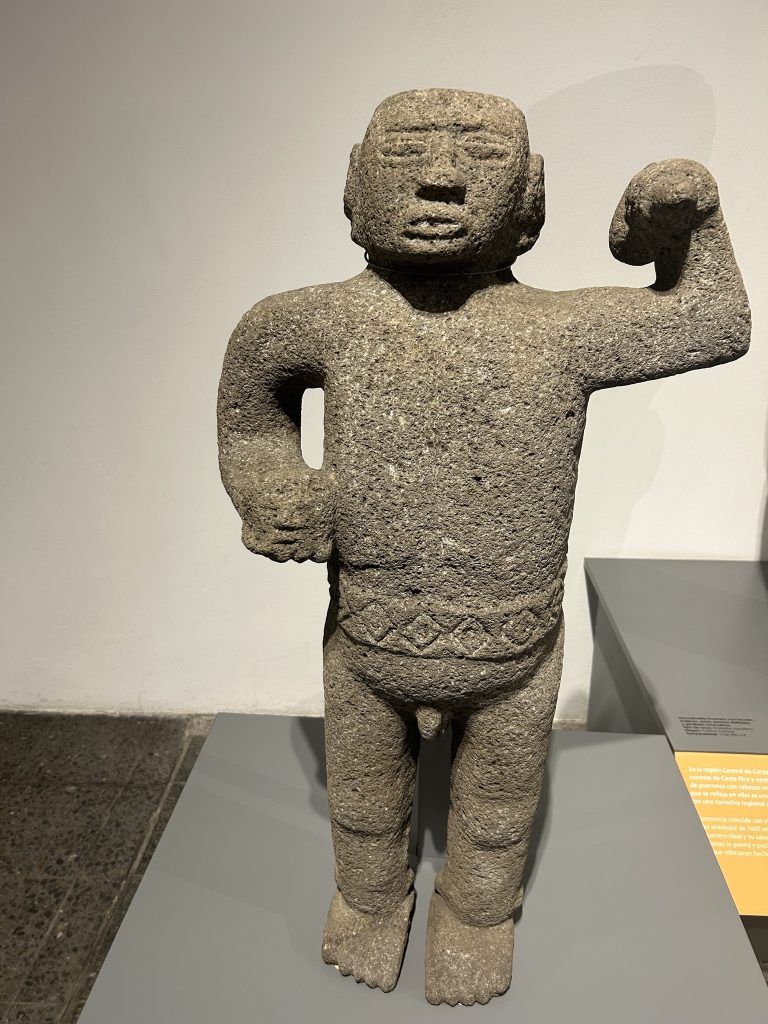

The captions are in both Spanish and English. I particularly enjoy the pre-Columbian and early contact displays, and then the rooms chronicling 20th-century Costa Rica, particularly information about why Costa Rica gave up its standing army after its revolution in 1949 and then in recent years decided to invest heavily in preserving the environment and promoting tourism.
We spend at least two hours enjoying the museum.
I want to visit the nearby Jade Museum and the pre-Columbian gold museum, but we have run out of steam. Also, we are in search of some last-minute souvenir shopping.
Buying Souvenirs
On the way back to the hotel, we stop by the large Central Market (Mercado Central). Souvenir stalls and hopeful-looking vendors jam pack the indoor space. But fellow buyers are thin on the ground. We feel guilty every time we go into one stall rather than its neighbor but eventually we have to make decisions. I buy several bars of Costa Rica chocolate to give as gifts, a colorfully embroidered bag, and a toucan fridge magnet. I’ve read in a guide book that vendors expect you to bargain, but I haven’t the heart. Business does not look particularly brisk and if I can afford to travel to Costa Rica for a two-week vacation, I can afford to pay a few extra colóns for my souvenirs.
Julia heads back to the hotel for a rest and I get a ticket to tour the National Theater, an ornate colonial building right across the street from the hotel and a major attraction in San José.
The National Theater
The National Theater of Costa Rica (aka Teatro Nacional de Costa Rica) is a must-see. A pair of hard-working guides hosts an excellent hour-long tour during which they sometimes appear in costume, enacting the glory days of the theater’s origins. Construction of the theater began in 1891 and was completed in 1897. Apparently, the President of Costa Rica, José Joaquín Rodríguez Zeledón, decided to place a tax on coffee to help pay for the theater which served a population of just 20,000.
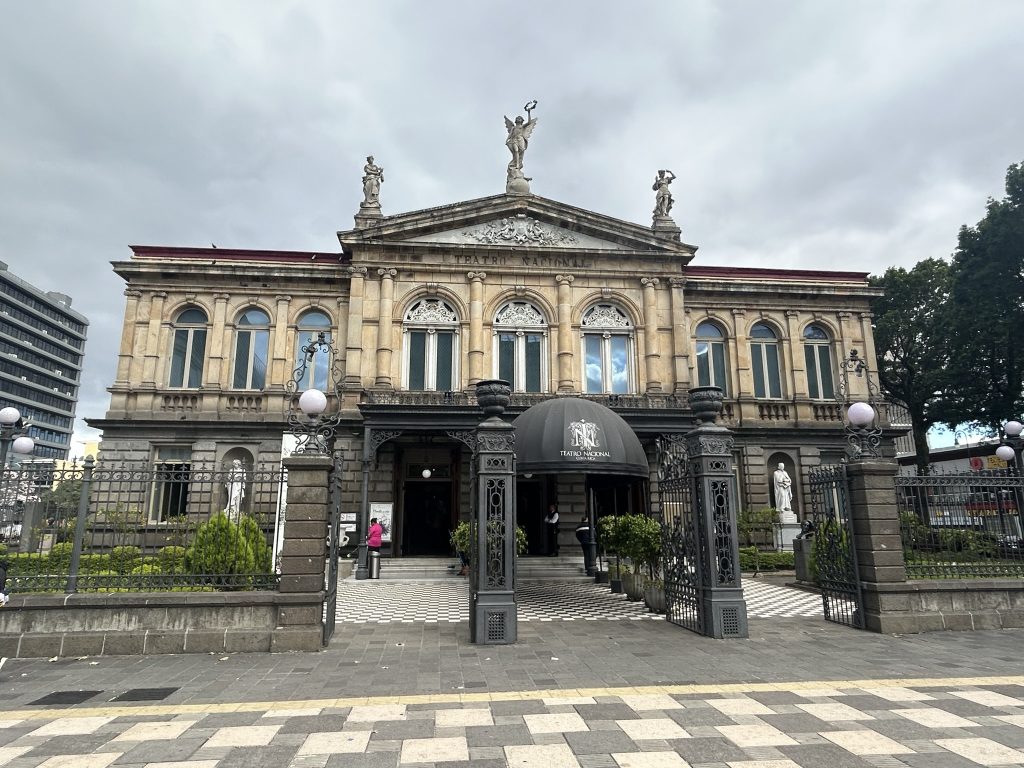

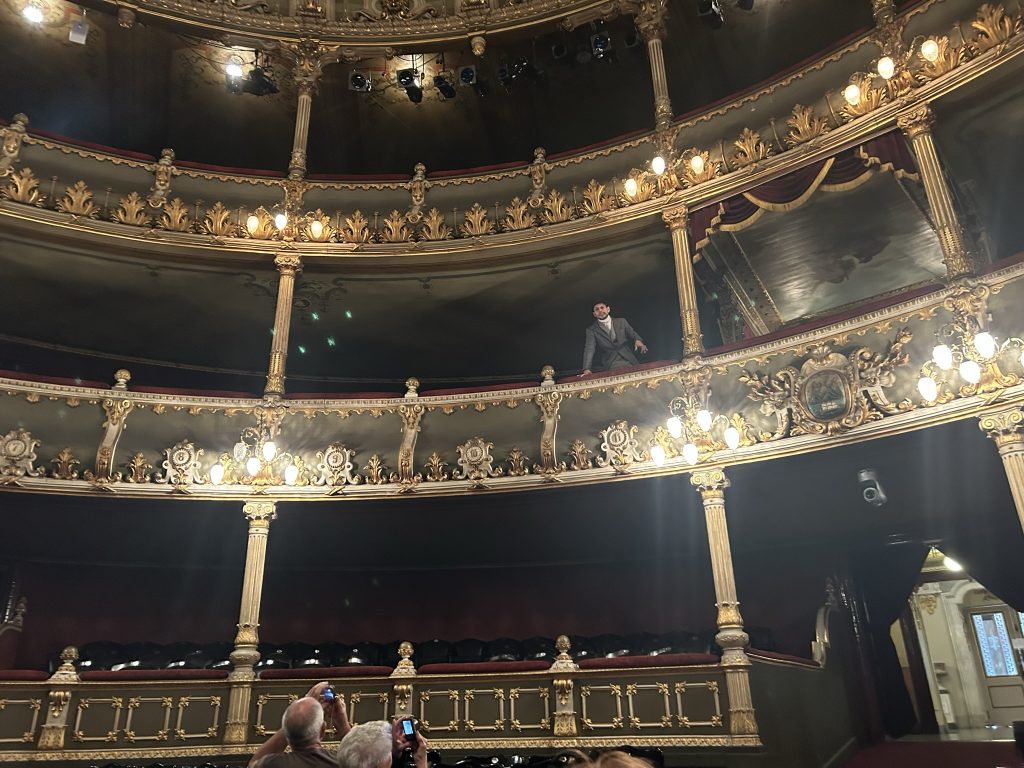

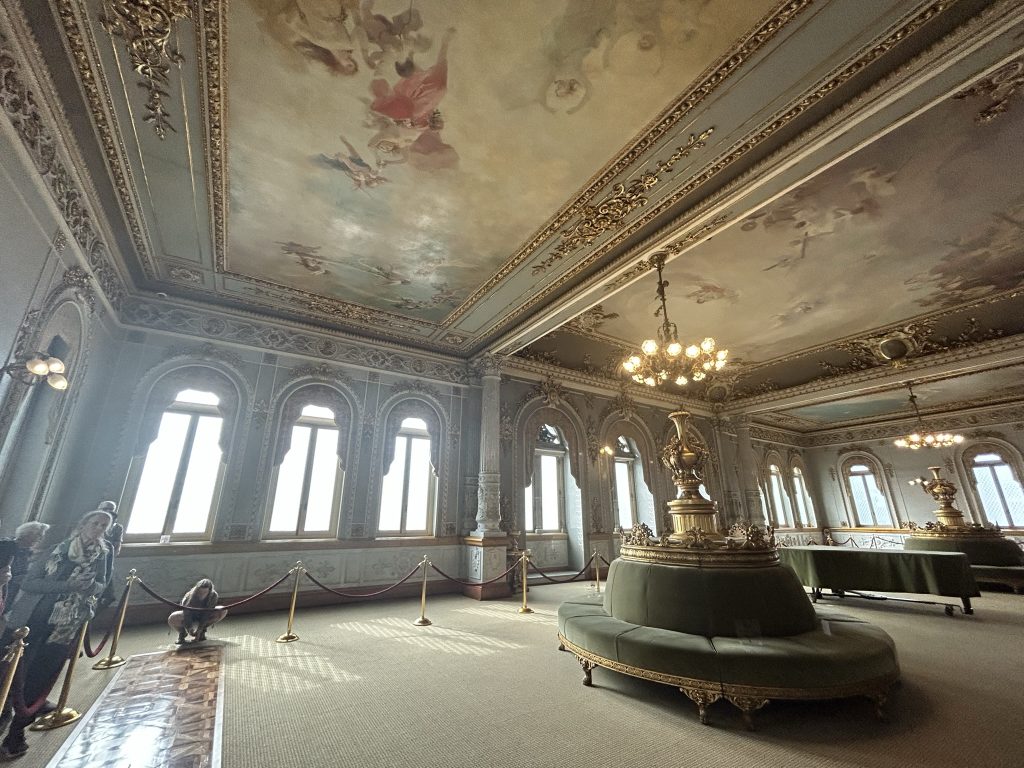

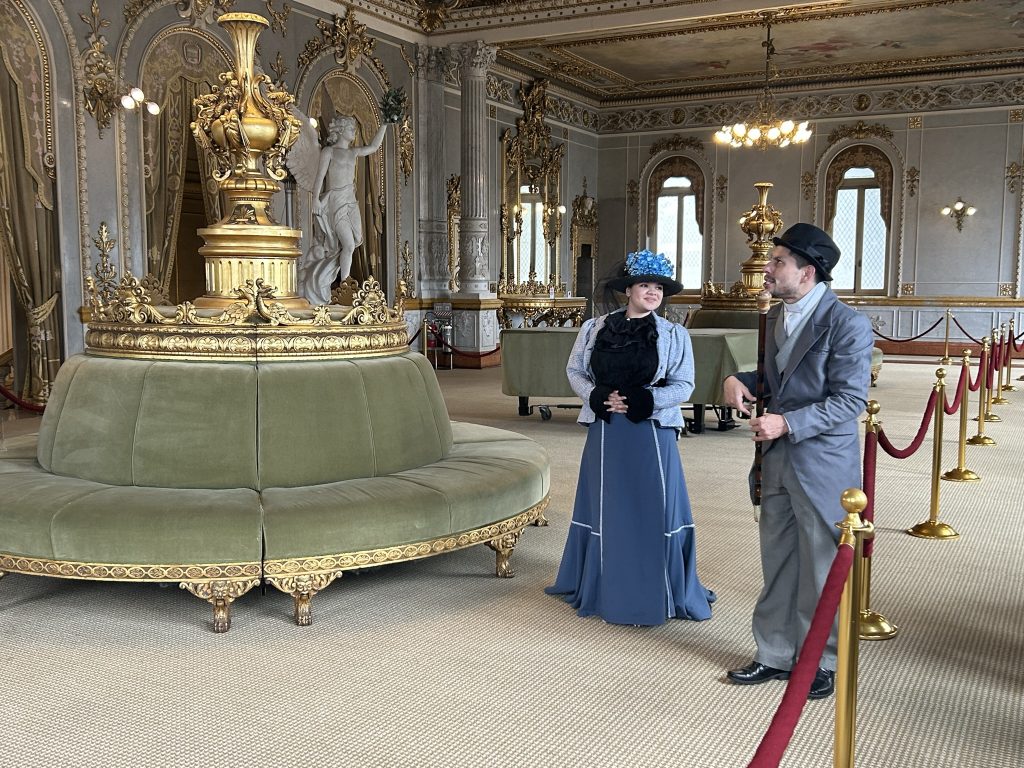

The theater is considered the finest historic building in San José. The interior has been lovingly maintained, with ornate stairwells, striking paintings, and beautiful furnishings.
Adiós to Costa Rica
We leave the next morning at the crack of dawn, spend a good hour checking out the much more expensive souvenir shops at the airport, and then board the plane for the five-hour flight to Toronto followed by another five-hour flight to Vancouver.
I can’t think of one negative thing to say about Costa Rica. It is a wonderful place to travel, and I definitely plan to return and stay longer to explore the Caribbean coast and more of the Osa Peninsula (my favorite of all the places we visited).
The landscape is achingly gorgeous, the animals exotic and easy to spot, the people friendly, and the tourism infrastructure very well-developed (albeit not cheap!).
Pura Vida!
